Plant Descriptions – Eucalyptus acaciiformis – Eucalyptus intertexta
Eucalyptus acaciiformis
Eucalyptus acmenoides
Eucalyptus agglomerata
Eucalyptus albens
Eucalyptus amplifolia
Eucalyptus angustissima
Eucalyptus apiculata
Eucalyptus argophloia
Eucalyptus badjensis
Eucalyptus baeurlenii
Eucalyptus baileyana
Eucalyptus baxteri
Eucalyptus benthamii
Eucalyptus biturbinata
Eucalyptus blakeleyi
Eucalyptus blaxlandii
Eucalyptus botryoides
Eucalyptus brassiana
Eucalyptus bridgesiana
Eucalyptus brunnea
Eucalyptus cadens
Eucalyptus caesia
Eucalyptus caliginosa
Eucalyptus camaldulensis
Eucalyptus cameronii
Eucalyptus campanulata
Eucalyptus canaliculata
Eucalyptus carnea
Eucalyptus cerasiformis
Eucalyptus cinerea
Eucalyptus cosmophylla
Eucalyptus crebra
Eucalyptus cyphellocarpa
Eucalyptus dawsonii
Eucalyptus deanei
Eucalyptus diversifolia
Eucalyptus dives
Eucalyptus dorrigoensis
Eucalyptus dunnii
Eucalyptus elaeophloia
Eucalyptus elata
Eucalyptus eugenioides
Eucalyptus exserta
Eucalyptus fibrosa
Eucalyptus fusiformis
Eucalyptus glaucina
Eucalyptus globoidea
Eucalyptus globulus subsp. bicostata
Eucalyptus globulus subsp. globulus
Eucalyptus goniantha
Eucalyptus grandis
Eucalyptus gregsoniana
Eucalyptus infera
Eucalyptus intertexta
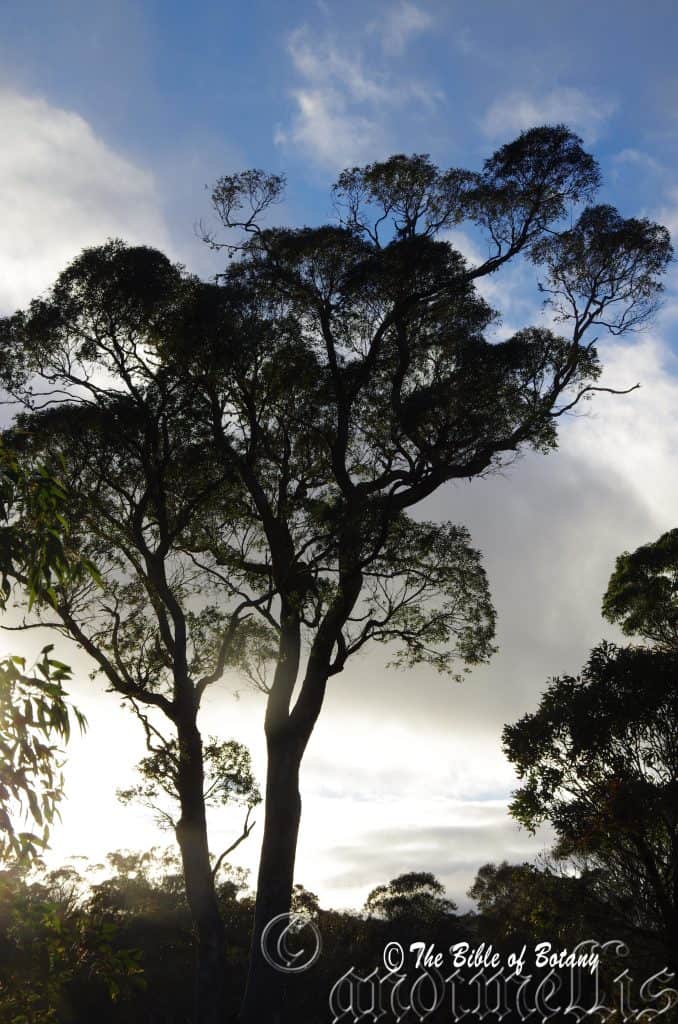

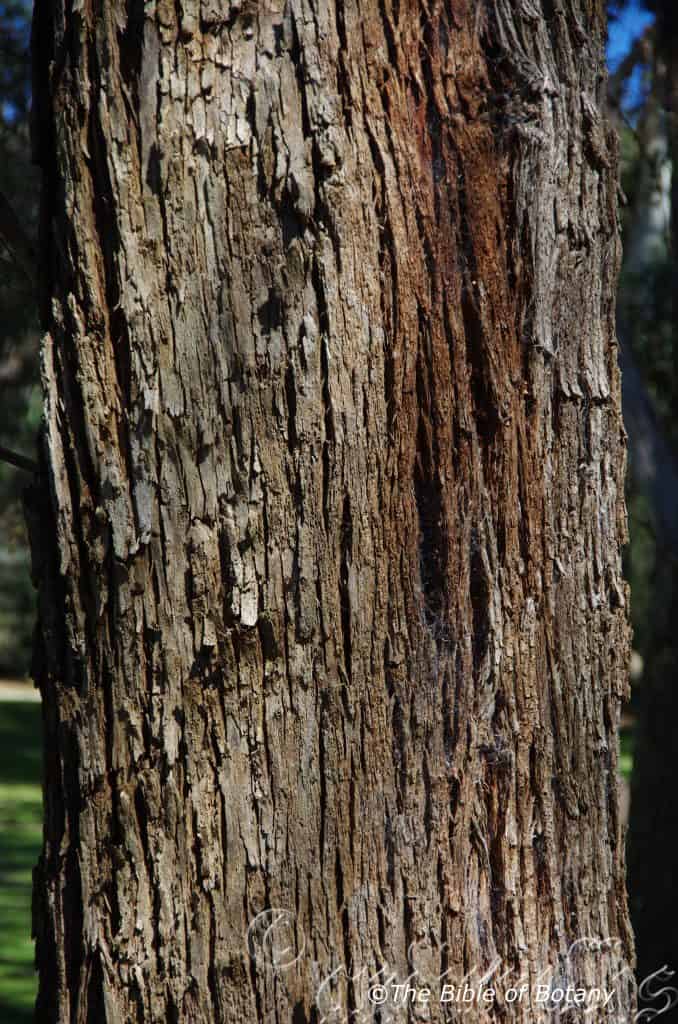


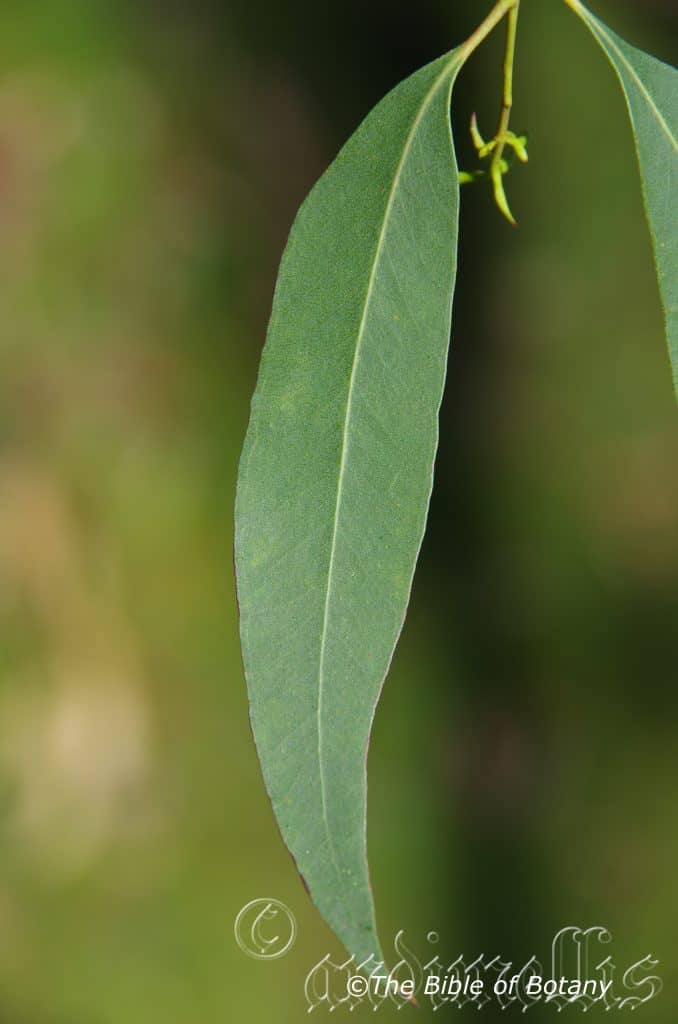
Eucalyptus acaciiformis
Classification:
Unranked: Eudicots
Clade: Rosids
Order: Myrtales
Family: Myrtaceae
Genus: From Eu, which is Greek a prefix for good or well and Kaluptos, which is Ancient Greek for to cover up. It refers to the stamens, which have a lid or cover over them in the bud stage prior to opening.
Specie: From ἀκακία, which is Ancient Greek or Acanthium, which is Latin for to have a sharp point and Forme which is Latin for to take the shape or form of. It refers to plants, which have a structure or organ usually the foliage, which is typically found on many Acacia specie.
Sub specie:
Common Name: Wattle Leaf Peppermint.
Distribution:
Eucalyptus acaciiformis is found south from eastern edge of Boonoo Boonoo National Park south of Stanthorpe in far north eastern New South Wales to Nowendoc in central New South Wales. It is found on the western side and western edges of the Great Dividing Range.
https://avh.ala.org.au/occurrences/search?taxa=Eucalyptus+acaciiformis#tab_mapView
Habitat Aspect Climate:
Eucalyptus acaciiformis prefers full sun. It is found on the highlands of the New England Tablelands on ridges and slopes. It is found in open schlerophyll forests and closed schlerophyll forests. The altitude ranges from 150 meters ASL to 850 meters ASL.
The temperature ranges from minus 5 degrees in August to 36 degrees in January.
The rainfall ranges from lows of 600mm to an average of 1000mm annually.
Soil Requirements:
Eucalyptus acaciiformis prefers poorer quality skeletal to shallow, white or grey fatty sandy loams close to the parent rock. The soils are derived from decomposed granite. The soils pH ranges from 5.5pH to 6pH. Non saline soils to moderately saline soils are tolerated as are salt laden winds.
Height & Spread:
Wild Plants: 12m to 20m by 5m to 8m.
Characteristics:
Eucalyptus acaciiformis is a long straight trunked tree which can branch close to its base. The rough pale grey to mid grey is persistent and stringy on the trunk to the larger branches. The bark on the branches is smooth, grey and is shed in short ribbons in spring.
Eucalyptus acaciiiformis’s juvenile and coppice leaves are initially opposite until the 5th or 6th leaf stage when they become alternate. The dull grey-green, disjunct juvenile leaves margins are entire to crenulate. The sessile leaves are elliptical and measure 20mm to 45mm in length by 5mm to 15mm in width.
The alternate, disjunct adult leaves are lanceolate and measure 50mm to 120mm in length by 10mm to 15mm in width. The terete petioles measure 1mm to 3mm in length. The bases are tapering while the apexes are narrow acute. The concolourous leaves are dull mid green to dull mid grey-green and glabrous. The margins are entire while the mid vein is slightly prominent on both laminas. The lateral veins are penniveined and are greater than 45 degrees to the main vein. The oil glands are islands between the veins or are in the axils of the lateral and auxiliary veins.
The inflorescences of Eucalyptus acaciiformis are born as umbellasters from the terminal. There are 7 individual white to cream flowers to an umbellaster. The peduncles and pedicels are terete and glabrous. The peduncles measure 2mm to 8mm in length while the pedicels measure 1mm to 3mm in length. The ovoid to shortly fusiform hypanthium are pale olive-yellow to deep creamy olive-yellow. The hypanthium measure 3mm to 5mm in length including the calyptra by 3mm to 5mm in diameter. The calyptras are hemispherical or conical with or without a rostrate and measure 1mm to 1.6mm in length. The bud scar is distinctly visible after releasing the conical
The inflexed or irregularly flexed stamens are white and measure 2mm to 3mm in length. The white to cream anthers are cuboidal to oblong. The white style measures 2mm to 3mm in length. The disc is pale green. The flowers appear in mid-August to January.
The fruits of Eucalyptus acaciiformis are hemispherical to flatten to campanulate capsules known as gum nuts. The resinous gum nuts measure 3mm to 5mm in length by 3mm to 5mm in diameter at the hypanthia. The disc is flat depressed with the 3 or at times 4 valves. The valves are level or slightly exserted to the rim of the hypanthia.
The deep brown, flattened seeds are ovoid to oblong and measure 1.2mm to 1.9mm in length while the trash is reddish-brown. The seeds are often lacunose with the dorsal surface pitted. The hilum is ventrally positioned.
Wildlife:
The flowers Eucalyptus acaciiformis are light nectar producers but are still are very attractive to most honeyeaters, lorikeets, flying foxes, possums and many insects.
Cultivation:
Eucalyptus acaciiformis is a small gum tree which is very suitable for small to large garden where a Eucalyptus for the garden or small parkland scene is required. It is ideal on poor sandy soils to heavy clays or steep slopes with skeletal soils that are well drained. It is fast growing so give good effects at an early age. In the garden good specimens grow from 8 meters to 12 meters in height by 6 meters to 9 meters in diameter when grown in the open.
Like all Eucalyptus leaf drop, dropping of small branches means continual lawn maintenance but then this means good quantities of leaf litter mulch.
Eucalyptus acaciiformis can give quick protection, habitat and safe corridors for many small birds and look particularly good when mixed with small mallee gums to create a bush garden.
Propagation:
Seeds: Sow into a seed raising mix. Cover the seeds with 2mm to 3mm of fine sand and place the trays in a warm sunny position. Keep the seeds moist but not wet. When the seedlings are 25mm to 50mm tall, prick them out and plant them into 50mm native tubes using a good organic mix.
Once the seedlings reach 200mm to 250mm in height plant them out into their permanent position. Mass plantings are best done in groups of 3 to 5 as a feature by planting them at 6 meter to 8 meter centers. For hedge rows or wind breaks they can be planted at 5 meter centers.
Fertilize using Seaweed, fish emulsion or organic chicken pellets soaked in water and apply the liquid on an alternate basis. Fertilize every two month until the trees are well established then every spring to ensure good growth and flowering.
Further Comments from Readers:
“Hi reader, it seems you use The Bible of Botany a lot. That’s great as we have great pleasure in bringing it to you! It’s a little awkward for us to ask, but our first aim is to purchase land approximately 1,600 hectares to link several parcels of N.P. into one at The Pinnacles NSW Australia, but we need your help. We’re not salespeople. We’re amateur botanists who have dedicated over 30 years to saving the environment in a practical way. We depend on donations to reach our goal. If you donate just $5, the price of your coffee this Sunday, We can help to keep the planet alive in a real way and continue to bring you regular updates and features on Australian plants all in one Botanical Bible. Any support is greatly appreciated. Thank you.”
In the spirit of reconciliation we acknowledge the Bundjalung, Gumbaynggirr and Yaegl and all aboriginal nations throughout Australia and their connections to land, sea and community. We pay our respect to their Elders past, present and future for the pleasures we have gained.
Eucalyptus acmenoides
Classification:
Unranked: Eudicots
Clade: Rosids
Order: Myrtales
Family: Myrtaceae
Genus: From Eu, which is Greek a prefix for good or well and Kaluptos, which is Ancient Greek for to cover up. It refers to the stamens, which have a lid or cover over them in the bud stage prior to opening.
Specie: From Acmenae, which is Ancient Greek for the beautiful nymph of Venus and Eîdos/Oides, which is Ancient Greek for alike or similar to. It refers to the plants, which resemble those of the Acmena genus.
Sub specie:
Common Name: White Mahogany.
Distribution:
Eucalyptus acmenoides is found south from in Mount Rose north west of Cooktown and west to White Mountain National Park in Queensland south to Port Jackson in central coastal New South Wales.
https://avh.ala.org.au/occurrences/search?taxa=Eucalyptus+acmenoides#tab_mapView
Habitat Aspect Climate:
Eucalyptus acmenoides prefers full sun but often start their lives in full shade. It is locally abundant in wet Eucalyptus forests and adjacent to moist tropical or subtropical rainforests. It is mainly found on and east of the Great Dividing Range. The altitude ranges from 15 meters ASL to 900 meters ASL.
The temperatures range from 3 degrees in July to 38 degrees in January.
The rainfall ranges from lows of 950mm to an average of 2800mm annually.
Soil Requirements:
Eucalyptus acmenoides prefers deep fertile loams to medium clays. The soils are derived from decomposed brown basalts or black basalts. The soils pH ranges from 5.5pH to 6pH. Non saline soils to moderately saline soils are tolerated as are salt laden winds.
Height & Spread:
Wild Plants: 20m to 50m by 10m to 15m.
Characteristics:
Eucalyptus acmenoides has along straight bole with the first branches appearing at around 50mm of the trees height on mature trees growing in the open. The rough grey to grey-brown or tan-brown is persistent and stringy on the trunk to the smaller branches. The stringy bark is flat and appressed to the trunk in a dissimilar fashion to most other stringy barks. The bark on the branchlets is smooth, silvery-grey and is shed in short ribbons in spring.
Eucalyptus acmenoides’s juvenile and coppice leaves are initially opposite until the 5th or 6th leaf stage when they become alternate. The bright glossy green, disjunct leaves margins are entire. The sessile leaves are broad lanceolate to ovate and measure 55mm to 145mm in length by 20mm to 70mm in width.
The alternate, disjunct adult leaves are lanceolate and measure 70mm to 130mm in length by 12mm to 35mm in width. The terete petioles measure 9mm to 17mm in length. The bases are oblique to tapering while the apexes narrow long tapering. The discolourous leaves are mid green, semi glossy to glossy and glabrous on the upper lamina awhile the lower lamina is much paler. The margins are entire while the mid vein is slightly prominent on both laminas. The lateral veins are penniveined and are greater than 45 degrees to the main vein. The intramarginal veins are parallel to the margin and just inside the margin to well remove from the margin. The oil glands are islands between the veins or are in the axils of the lateral and auxiliary veins.
The inflorescences of Eucalyptus acmenoidesare born as umbellasters from the terminal. There are 7 to 15 individual white to cream flowers to an umbellaster. The peduncles are angulated and glabrous while the pedicels are terete and glabrous. The peduncles measure 6mm to 19mm in length while the pedicels measure 2mm to 6mm in length. The ovoid to shortly fusiform hypanthium are pale yellow-green to deep creamy-yellow. The hypanthium measure 5mm to 7mm in length including the calyptra by 3mm to 4mm in diameter. The calyptras are hemispherical or conical with or without a rostrate and measure 1.5mm to 2.1mm in length. The bud scar is absent.
The inflexed or irregularly flexed stamens are white and measure 5.5mm to 7.5mm in length. The white to cream anthers are reniform to cordate. The anthers are versatile and dehisce by confluent slits. The white style measures 6mm to 8mm in length. The disc is pale green. The flowers appear in mid-August to January.
The fruits of Eucalyptus acmenoides are hemispherical to flatten to campanulate capsules known as gum nuts. The resinous gum nuts measure 3mm to 5mm in length by 3mm to 5mm in diameter at the hypanthia. The disc is flat or depressed with the 3 or at times 5 valves. The valves are level or slightly enclosed to the rim of the hypanthia.
The deep reddish-brown, flattened seeds are oblique to pyramidal and measure 1.2mm to 2.5mm in length while the trash is a paler reddish-brown and smaller. The hilum is terminally positioned.
Wildlife:
The flowers Eucalyptus acmenoides are light nectar producers but are still are very attractive to most honeyeaters, lorikeets, flying foxes, possums and many insects. The beetle Clerus splendidus are frequently seen around the blooms of this Eucalyptus acmenoides.
Cultivation:
acmenoides is a large gum tree which is very suitable for large gardens where a Eucalyptus is required. It is ideal on poor sandy soils to heavy clays on undulating slopes with skeletal soils that are well drained. It is fast growing so give good effects at an early age. In the garden good specimens grow from 18 meters to 24 meters in height by 7 meters to 12 meters in diameter when grown in the open.
Like all Eucalyptus leaf drop, dropping of small branches means continual lawn maintenance but then this means good quantities of leaf litter mulch.
Eucalyptus acmenoides can give quick protection, habitat and safe corridors for many small birds and look particularly good when mixed with small mallee gums to create a bush garden
Propagation:
Seeds: Sow into a seed raising mix. Cover the seeds with 2mm to 3mm of fine sand and place the trays in a warm sunny position. Keep the seeds moist but not wet. When the seedlings are 25mm to 50mm tall, prick them out and plant them into 50mm native tubes using a good organic mix.
Once the seedlings reach 200mm to 250mm in height plant them out into their permanent position. Mass plantings are best done in groups of 3 to 5 as a feature planting them at 6 meter to 8 meter centers. For hedge rows or wind breaks they can be planted at 5 meter centers.
Fertilize using Seaweed, fish emulsion or organic chicken pellets soaked in water and apply the liquid on an alternate basis. Fertilize every two month until the trees are well established then every spring to ensure good growth and flowering.
Further Comments from Readers:
“Hi reader, it seems you use The Bible of Botany a lot. That’s great as we have great pleasure in bringing it to you! It’s a little awkward for us to ask, but our first aim is to purchase land approximately 1,600 hectares to link several parcels of N.P. into one at The Pinnacles NSW Australia, but we need your help. We’re not salespeople. We’re amateur botanists who have dedicated over 30 years to saving the environment in a practical way. We depend on donations to reach our goal. If you donate just $5, the price of your coffee this Sunday, We can help to keep the planet alive in a real way and continue to bring you regular updates and features on Australian plants all in one Botanical Bible. Any support is greatly appreciated. Thank you.”
In the spirit of reconciliation we acknowledge the Bundjalung, Gumbaynggirr and Yaegl and all aboriginal nations throughout Australia and their connections to land, sea and community. We pay our respect to their Elders past, present and future for the pleasures we have gained.
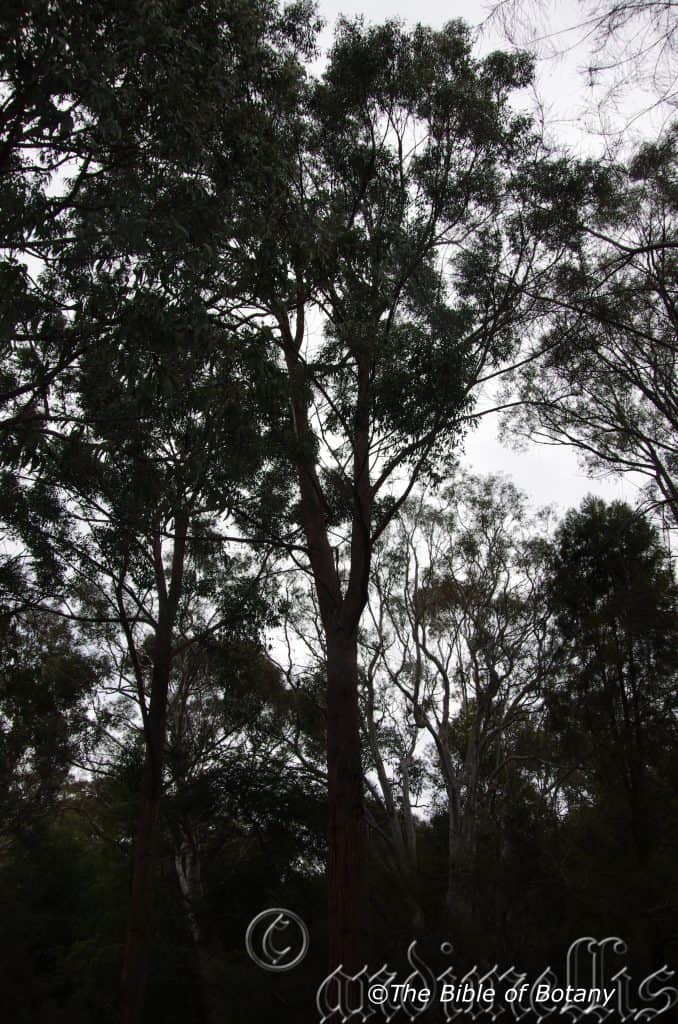

Eucalyptus agglomerata
Classification:
Unranked: Eudicots
Clade: Rosids
Order: Myrtales
Family: Myrtaceae
Genus: From Eu, which is Greek a prefix for good or well and Kaluptos, which is Ancient Greek for to cover up. It refers to the stamens, which have a lid or cover over them in the bud stage prior to opening.
Specie: From A, which is Greek/Latin for without or not having and Glomus, which is Latin for a ball of yarn. It refers to structures or organs, which are crowded together without adhering to each other.
Sub specie:
Common Name: Blue Leaf Stringybark.
Distribution:
Eucalyptus agglomerata is found from east of Tenterfield in far northern coastal New South Wales south to the Snowy River National Park in north western Victoria. There is a disjunct population near Tarralgon in southern Gippsland and Caratel Hoop in the Warrumbungles in New South Wales. It is mainly found on and east of the Great Dividing Range.
https://avh.ala.org.au/occurrences/search?taxa=Eucalyptus+agglomerata#tab_mapView
Habitat Aspect Climate:
Eucalyptus agglomerata prefers full sun. It grows in moist schlerophyll forests to wet schlerophyll forests on gentle slopes to hilly country. The altitude ranges from 5 meters ASL to 900 meters ASL.
The temperatures range from minus 4 degrees in July to 40 degrees in January.
The rainfall ranges from lows of 500mm to an average of 1600mm annually.
Soil Requirements:
Eucalyptus agglomerata prefer deeper better quality, fatty sandy loams to medium clays. The soils are derived from granite, sandstone, brown basalt and red basalt. The soils pH ranges from 5pH to 6pH. Non saline soils to moderately saline soils are tolerated as are salt laden winds.
Height & Spread:
Wild Plants: 25m to 40m by 12m to 15m.
Characteristics:
Eucalyptus agglomerata has along straight bole with the first branches appearing at around 40mm to 50mm of the trees height on mature trees growing in the open. The rough grey to grey-brown or red-brown bark is persistent and stringy on the trunk to the smaller branches. The stringy bark is flat and forms furrows on the trunk which is normal with most other stringy barks. The bark on the branchlets is smooth, silvery-grey and is shed in short ribbons in spring.
Eucalyptus agglomerata’s juvenile and coppice leaves are opposite discolourous and undulating for the first 6 or 7 pairs of leaves. The bright glossy green, disjunct leaves are initially scabrid, and covered in reddish–brown hispid hairs, on both laminas becoming scabrid with the reddish–brown hispid hairs on the margins and main vein and eventually becoming glabrous all over. The margins are entire. The sessile leaves are broad lanceolate to ovate and measure 35mm to 135mm in length by 20mm to 50mm in width.
The alternate, disjunct adult leaves are broad lanceolate and measure 70mm to 170mm in length by 13mm to 30mm in width. The terete petioles measure 8mm to 16mm in length. The bases are slightly oblique to tapering while the apexes are narrow long tapering. The concolourous or slightly discolourous leaves are mid green to grey-green with a bluish sheen, semi glossy to glossy and glabrous on the upper lamina while the lower lamina is slightly paler or the same colour. The margins are entire while the mid vein is slightly prominent on both laminas. The lateral veins are penniveined and are greater than 50 degrees to the main vein. The intramarginal veins are parallel to the margin and just inside the margin to well remove from the margin. The oil glands are islands between the veins.
The inflorescences of Eucalyptus agglomerata are born as umbellasters from the terminal. There are 7 to 15 individual white to cream flowers to an umbellaster. The peduncles are flattened or angular and glabrous while the pedicels are terete and glabrous. The peduncles measure 6mm to 13mm in length while the pedicels measure 0mm to 0.6mm in length. The ovoid to fusiform hypanthium are pale yellow-green to deep creamy-yellow and glabrous. The hypanthium measure 7mm to 9mm in length including the calyptra by 3mm to 3.5mm in diameter. The calyptras are conical to elongated without a rostrate and measure 4.2mm to 5.4mm in length. The bud scar is absent.
The irregularly flexed stamens are white to cream and measure 4.5mm to 5.2mm in length. The white to cream anthers are reniform to cordate. The versatile, dorsifixed anthers dehisce through confluent slits. The white style measures 4.5mm to 5.5mm in length. The disc is pale green. The flowers appear in mid-August to September.
The fruits of Eucalyptus agglomerata are hemispherical to flatten to distorted globose capsules known as gum nuts, bought about by crowding. The faintly resinous gum nuts measure 4.5mm to 6mm in length by 6mm to 10mm in diameter at the widest point. The disc is flat or slightly exserted with the 3 or 4 valves. The valves are level or slightly exserted to the rim of the hypanthia.
The deep reddish-brown, flattened seeds are oblique to pyramidal and measure 1.5mm to 2.5mm in length while the trash is smaller. The hilum is terminally positioned while the surfaces are shallowly, broadly pitted.
Wildlife:
The flowers Eucalyptus agglomerata are good nectar producers but are still are very attractive to most honeyeaters, lorikeets, flying foxes, possums and many insects.
Cultivation:
Eucalyptus agglomerata is a large gum tree which is very suitable for large gardens where a Eucalyptus is required. It is ideal on poor sandy soils to heavy clays on undulating slopes with skeletal soils that are well drained. It is fast growing so give good effects at an early age. In the garden good specimens grow from 18 meters to 24 meters in height by 7 meters to 10 meters in diameter when grown in the open.
Like all Eucalyptus leaf drop, dropping of small branches means continual lawn maintenance but then this means good quantities of leaf litter mulch.
Eucalyptus agglomerata can give quick protection, habitat and safe corridors for many small birds. They look particularly good when mixed with other Eucalyptus with varying types of bark.
Propagation:
Seeds: Sow into a seed raising mix. Cover the seeds with 2mm to 3mm of fine sand and place the trays in a warm sunny position. Keep the seeds moist but not wet. When the seedlings are 25mm to 50mm tall, prick them out and plant them into 50mm native tubes using a good organic mix.
Once the seedlings reach 200mm to 250mm in height plant them out into their permanent position. Mass plantings are best done in groups of 3 to 5 as a feature by planting them at 10 meter to 16 meter centers.
Fertilize using Seaweed, fish emulsion or organic chicken pellets soaked in water and apply the liquid on an alternate basis. Fertilize every two month until the trees are well established then every spring to ensure good growth and flowering.
Further Comments from Readers:
“Hi reader, it seems you use The Bible of Botany a lot. That’s great as we have great pleasure in bringing it to you! It’s a little awkward for us to ask, but our first aim is to purchase land approximately 1,600 hectares to link several parcels of N.P. into one at The Pinnacles NSW Australia, but we need your help. We’re not salespeople. We’re amateur botanists who have dedicated over 30 years to saving the environment in a practical way. We depend on donations to reach our goal. If you donate just $5, the price of your coffee this Sunday, We can help to keep the planet alive in a real way and continue to bring you regular updates and features on Australian plants all in one Botanical Bible. Any support is greatly appreciated. Thank you.”
In the spirit of reconciliation we acknowledge the Bundjalung, Gumbaynggirr and Yaegl and all aboriginal nations throughout Australia and their connections to land, sea and community. We pay our respect to their Elders past, present and future for the pleasures we have gained.




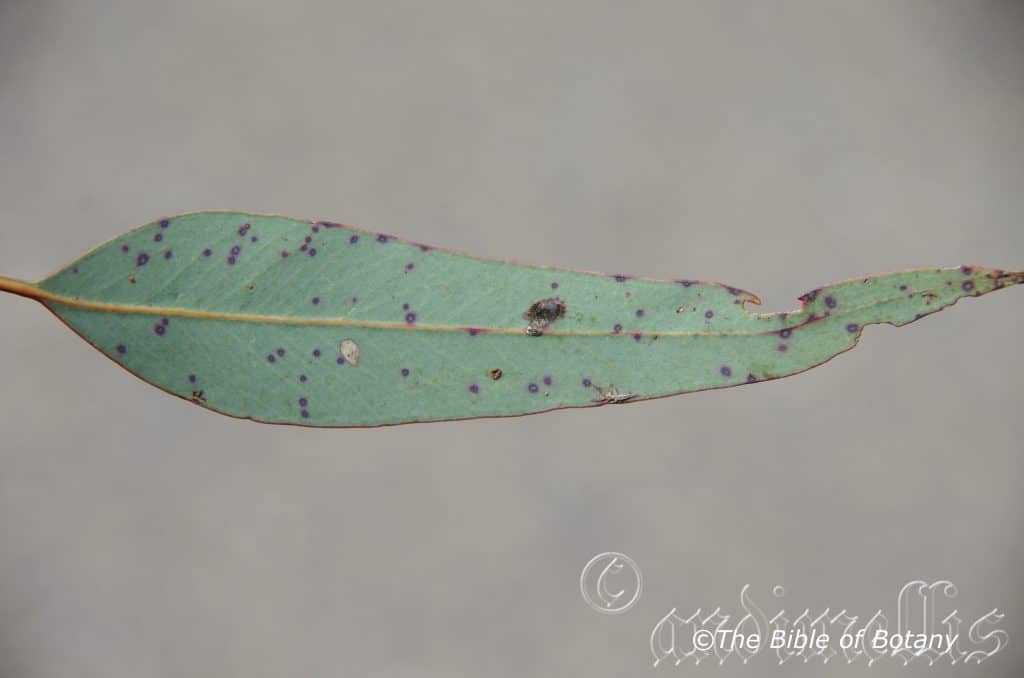

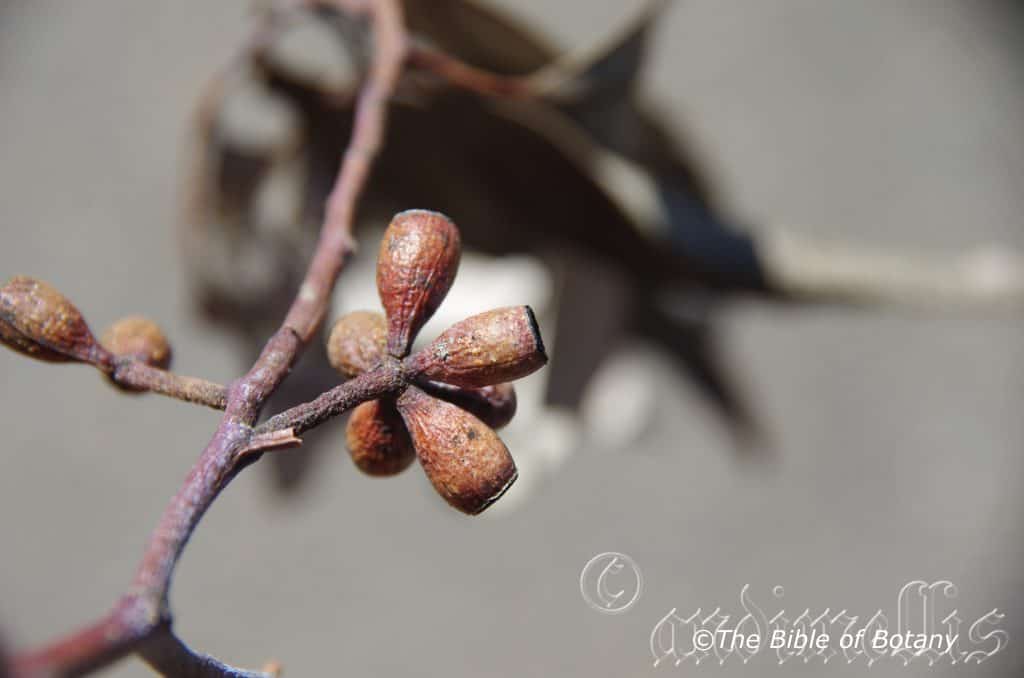

Eucalyptus albens
Classification:
Unranked: Eudicots
Clade: Rosids
Order: Myrtales
Family: Myrtaceae
Genus: From Eu, which is Greek a prefix for good or well and Kaluptos, which is Ancient Greek for to cover up. It refers to the stamens, which have a lid or cover over them in the bud stage prior to opening.
Specie: From Albēns, which is Latin for white. It usually refers to the flowers, which are snow white.
Sub specie:
Common Name: White Box.
Distribution:
Eucalyptus albens is found south from the Bunya Mountains in south eastern Queensland through New South Wales to Maryborough in central Victoria. It is mainly found on the Great Dividing Range and the Western Slopes with a large population in north eastern Gippsland.
There are several disjunct populations near Wayoong in south western Queensland, on the ridges above the junction of the Abercrombie River and Trunkey Creek, Mount Dundas in south western Victoria and an isolated population between Mount Brown Forest Reserve, Wongyarra and Howe.
https://avh.ala.org.au/occurrences/search?taxa=Eucalyptus+albens#tab_mapView
Habitat Aspect Climate:
Eucalyptus albens prefers full sun. It is often the dominant specie growing in moist schlerophyll woodlands, grassy plains, on gentle slopes to hilly country. The altitude ranges from 50 meters ASL to 450 meters ASL.
The temperatures range from minus 4 degrees in July to 42 degrees in January.
The rainfall ranges from lows of 350mm to an average of 850mm annually.
Soil Requirements: Eucalyptus albens prefer deeper better quality, sandy loams, and light fatty clays to medium clays. The soils are derived from granite, sandstone, brown basalt and red basalt. The soils pH ranges from 5pH to 6.5pH. Non saline soils to moderately saline soils are tolerated as are salt laden winds.
Height & Spread:
Wild Plants: 20m to 25m by 15m to 18m.
Characteristics:
Eucalyptus albens has a short straight bole with the first branches appearing at around 20mm to 40mm of the trees height on mature trees growing in the open. The persistent pale grey and white bark is patchy on the trunk and smaller branches. The fibrous to flaky box base is smooth above. The bark sheds in short ribbons along the branches.
Eucalyptus albens’s disjunct, glaucous juvenile leaves are ovate to orbicular.
The alternate, disjunct adult leaves are lanceolate or broad lanceolate and measure 85mm to 160mm in length by 20mm to 55mm in width. The narrowly flattened or angular petioles measure 8mm to 16mm in length. The tapering bases are often oblique while the apexes are narrow acute. The discolourous leaves are mid grey-green to glaucous dull and glabrous on the upper lamina while the lower lamina is slightly paler. The margins are entire while the mid vein is prominent on the lower laminas. The lateral veins are indistinct. The intramarginal veins are parallel to the margin and just inside the margin. The oil glands are islands between the veins.
The compound conflorescences of Eucalyptus albens are born as umbellasters from the terminal. There are 7 individual white to cream flowers to an umbellaster. The glaucous peduncles and the pedicels are terete and glabrous. The peduncles measure 10mm to 18mm in length while the pedicels measure 0mm to 5mm in length. The cylindrical or fusiform buds are strongly glaucous and glabrous. The hypanthium and calyptra measure 10mm to 18mm in length by 4mm to 7mm in diameter. The bud scar is absent. The calyptra is as long and as wide as hypanthium.
The irregularly flexed stamens are white or usually cream and measure 5mm to 8mm in length. All the stamens are fertile.
The cream to pascal orange style measures 7mm to 9mm in length. The disc is pale yellowish-green. The flowers appear in mid-August to September.
The fruits of Eucalyptus albens are cylindrical or urceolate capsules known as gum nuts. The gum nuts measure 6mm to 15mm in length by 5mm to 10mm in diameter. The disc is depressed with the 3 or 4 enclosed valves.
Wildlife:
The flowers Eucalyptus albens are good nectar producers and are still are very attractive to most honeyeaters, lorikeets, flying foxes, possums and many insects.
Cultivation:
Eucalyptus albens is a medium gum tree suitable for large gardens where a Eucalyptus is required. It is ideal on better quality, deep, sandy soils to medium clays on undulating slopes that are well drained. It is fast growing so gives a good effect at an early age. In the garden good specimens grow from 15 meters to 18 meters in height by 10 meters to 15 meters in diameter when grown in the open.
Like all Eucalyptus spp. leaf drop, dropping of small branches means continual lawn maintenance but then this means good quantities of leaf litter mulch.
Eucalyptus albens can give quick protection, habitat and safe corridors for many small birds. It is also suitable for wind breaks and shade for stock along fence lines and sporadic plantings throughout the station. It looks particularly good when mixed with other Eucalyptus with varying types of bark and growth habits.
Propagation:
Seeds: Sow into a seed raising mix. Cover the seeds with 2mm to 3mm of fine sand and place the trays in a warm sunny position. Keep the seeds moist but not wet. When the seedlings are 25mm to 50mm tall, prick them out and plant them into 50mm native tubes using a good organic mix.
Once the seedlings reach 200mm to 250mm in height plant them out into their permanent position. Mass plantings are best done in groups of 3 to 5 as a feature by planting them at 10 meter to 16 meter centers.
Fertilize using Seaweed, fish emulsion or organic chicken pellets soaked in water and apply the liquid on an alternate basis. Fertilize every two month until the trees are well established then every spring to ensure good growth and flowering.
Further Comments from Readers:
“Hi reader, it seems you use The Bible of Botany a lot. That’s great as we have great pleasure in bringing it to you! It’s a little awkward for us to ask, but our first aim is to purchase land approximately 1,600 hectares to link several parcels of N.P. into one at The Pinnacles NSW Australia, but we need your help. We’re not salespeople. We’re amateur botanists who have dedicated over 30 years to saving the environment in a practical way. We depend on donations to reach our goal. If you donate just $5, the price of your coffee this Sunday, We can help to keep the planet alive in a real way and continue to bring you regular updates and features on Australian plants all in one Botanical Bible. Any support is greatly appreciated. Thank you.”
In the spirit of reconciliation we acknowledge the Bundjalung, Gumbaynggirr and Yaegl and all aboriginal nations throughout Australia and their connections to land, sea and community. We pay our respect to their Elders past, present and future for the pleasures we have gained.
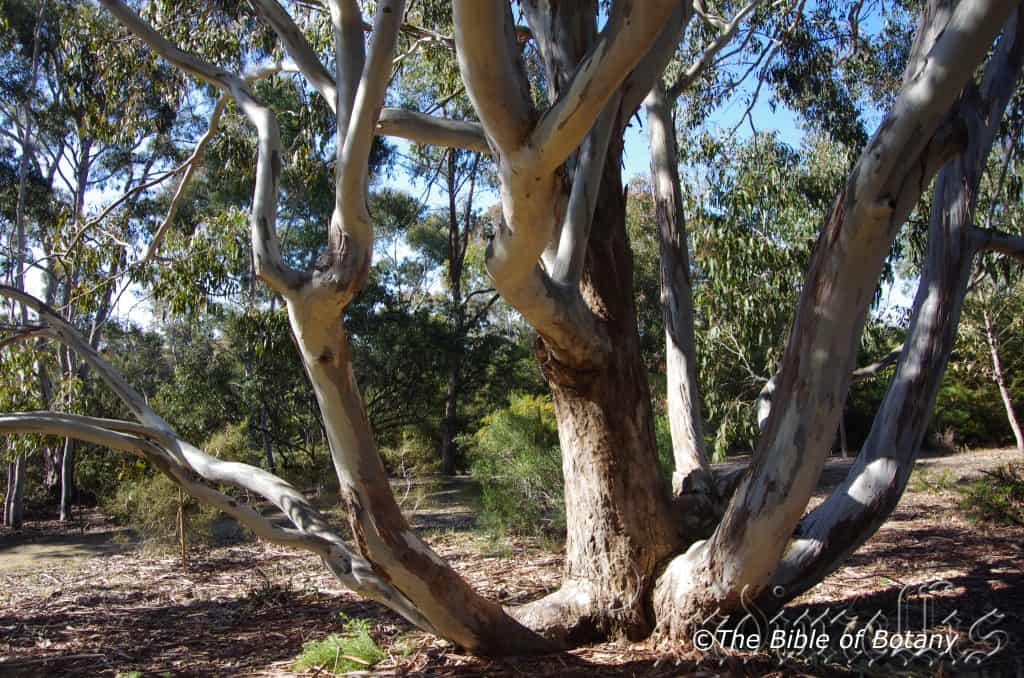


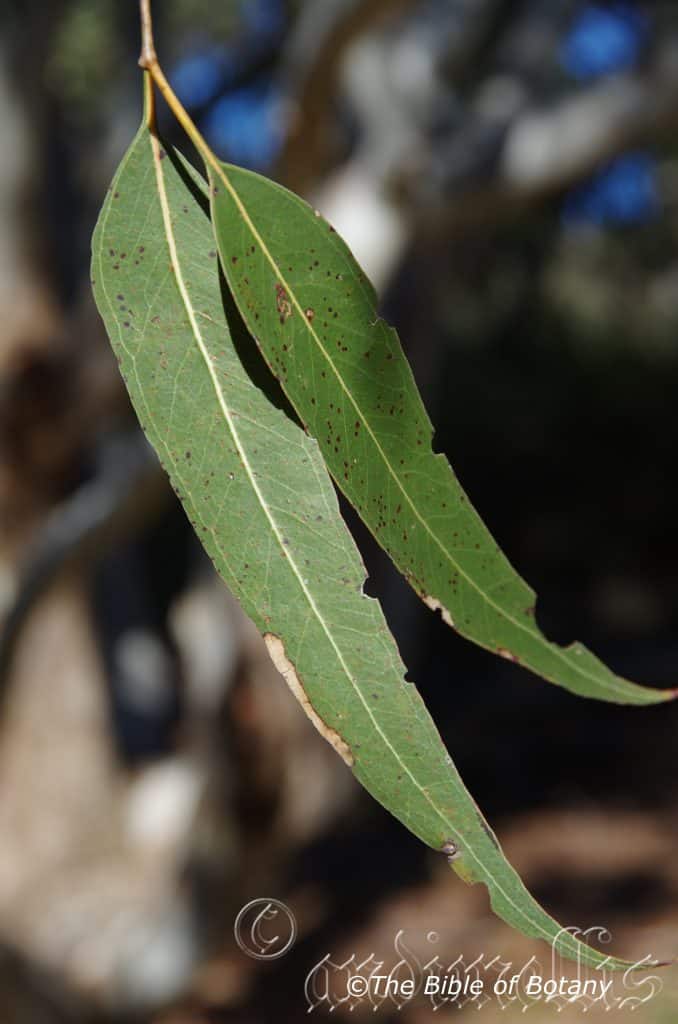
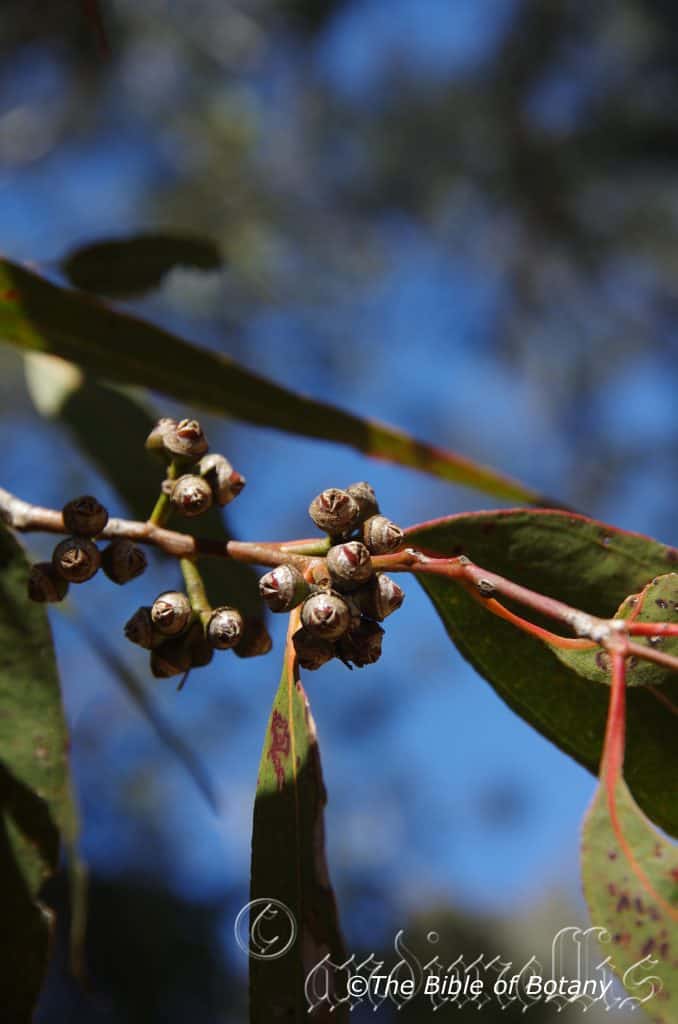

Eucalyptus amplifolia
Classification:
Unranked: Eudicots
Clade: Rosids
Order: Myrtales
Family: Myrtaceae
Genus: From Eu, which is Greek a prefix for good or well and Kaluptos, which is Ancient Greek for to cover up. It refers to the stamens, which have a lid or cover over them in the bud stage prior to opening.
Specie: From Amplum, which is Latin for ample, generous or plenty of and Folium, which is Latin for foliage. It refers to plants, which have a dense canopy.
Sub specie: Eucalyptus amplifolia subsp. amplifolia. From Amplum, which is Latin for ample, generous or plenty of and Folium, which is Latin for foliage. It refers to plants, which have a dense canopy.
Sub specie: Eucalyptus amplifolia subsp. sessiliflora From Sessilis, which is Latin for to sit on and Flōris, which is Latin for a flower or Flōs, which is the Roman Goddess for spring and flowers. It refers to the flowers not having a stalk.
Common Name: Cabbage Gum.
Distribution:
Eucalyptus amplifolia subsp. amplifolia is found south from Crows Nest in south eastern Queensland to Pambula and Eden in southern coastal New South Wales. There is an isolated population in Carnarvon Gorge in Queensland. It is mainly found on and east of the Great Dividing Range.
Eucalyptus amplifolia subsp. sessiliflora is found in a restricted area between Stanthorpe, Armidale and to Casino.
https://avh.ala.org.au/occurrences/search?taxa=Eucalyptus+amplifolia#tab_mapView
Habitat Aspect Climate:
Eucalyptus amplifolia prefers full sun. It grows in grassy open woodland and open forests usually on low sites, shallow depressions or along watercourses on alluvial flats. The altitude ranges from 50 meters ASL to 850 meters ASL.
The temperatures range minus 5 degrees in August to 40 degrees in January.
The rainfall ranges from lows of 700mm to an average of 1600mm annually.
Soil Requirements:
Eucalyptus amplifolia prefers deep, better sandy loams to medium silty clays. The soils are usually derived from alluvial deposits. The soils pH ranges from 5pH to 6pH. It does not tolerate water logged soils. Non saline soils to moderately saline soils are tolerated as are salt laden winds.
Height & Spread:
Wild Plants: 15m to 30m by 7m to 12m.
Characteristics:
Eucalyptus amplifolia has along straight bole with the first branches appearing at around 50mm to 60mm of the trees height on mature trees growing in the open. The rough pale grey, grey-brown, pale khaki or pale brown bark is persistent and glabrous on the trunk to the smallest branches. The smooth bark is decorticated in large plates or elongated ribbons in spring.
Eucalyptus amplifolia’s juvenile and coppice stems are angular with distinct wings in the corners. The leaves are initially opposite for the first 10 or 12 pairs of leaves before becoming disjunct. The dull grey-green to glossy green leaves are divaricate. The margins are entire or finely crenate. The sessile or petiolate leaves are ovate to orbicular or at times deltoid and measure 50mm to 220mm in length by 35mm to 180mm in width.
The alternate, disjunct adult leaves are broad lanceolate to lanceolate and falcate. They measure 75mm to 250mm in length by 16mm to 70mm in width. The terete petioles measure 10mm to 30mm in length. The bases are rounded to rounded-cuneate while the apexes are narrow long tapering. The concolourous leaves are mid grey-green with a bluish sheen, and glabrous. The margins are entire while the creamy yellow mid vein is slightly prominent on both laminas. The lateral veins are penniveined and are greater than 45 degrees to the main vein. The intramarginal veins are parallel to the margin and just inside the margin to well remove from the margin. The oil glands are islands between the veins.
The inflorescences of Eucalyptus amplifoliaare born as umbellasters from the leaf axils. There are 7 to 20 individual white to cream flowers to an umbellaster. The peduncles are flattened and glabrous while the pedicels are terete and glabrous. The narrow ovoidal hypanthium are pale yellow-green to deep creamy-yellow and glabrous. The hypanthium measure 3.5mm to 8mm by 3mm to 5mm in diameter. The calyptras are conical to elongated-acute and straight or slightly horn shaped without a rostrate and measure 5.5mm to 12mm in length. The bud scar is present on the hypanthia.
The peduncles on Eucalyptus amplifolia subsp. amplifolia measure 5mm to 18mm in length while the pedicels measure 4mm to 8mm in length.
The peduncles on Eucalyptus amplifolia subsp. sessiliflora measure 5mm to 18mm in length while the pedicels measure 0mm to 0.8mm in length.
The erect stamens are white to cream and measure 7mm to 15mm in length. The white to cream anthers are cuboidal to obloidal. The versatile, dorsifixed anthers dehisce through longitudinal slits. The white style measures 6mm to 13mm in length. The disc is pale green. The flowers appear in mid-November to January.
The fruits of Eucalyptus amplifolia are globose to ovoidal capsules known as gum nuts. The faintly resinous gum nuts measure 4mm to 6mm in length by 5mm to 8mm in diameter at the widest point. The disc is exserted with the 3 or 4 valves. The valves are exserted to the rim of the hypanthia.
The deep reddish-brown to deep brown almost black, flattened seeds are pyramidal to cuboidal and measure 0.7mm to 1.5mm in length while the trash is smaller. The hilum is terminally positioned while the surfaces are shallowly, broadly pitted.
Wildlife:
The flowers Eucalyptus amplifoliaare good nectar producers and are very attractive to most honeyeaters, lorikeets, flying foxes, possums and many insects.
Cultivation:
Eucalyptus amplifolia is a large gum tree which is very suitable for large gardens where a Eucalyptus specie is required. It is ideal on poor sandy soils to heavy clays on undulating slopes with skeletal soils that are well drained. It is fast growing so give good effects at an early age. In the garden good specimens grow from 12 meters to 16 meters in height by 7 meters to 9 meters in diameter when grown in the open.
Like all Eucalyptus specie leaf drop, dropping of small branches means continual lawn maintenance but then this means good quantities of leaf litter mulch.
Eucalyptus amplifolia can give quick protection, habitat and safe corridors for many small birds. It looks particularly good when mixed with other Eucalyptus with varying types of bark.
Propagation:
Seeds: Sow into a seed raising mix. Cover the seeds with 2mm to 3mm of fine sand and place the trays in a warm sunny position. Keep the seeds moist but not wet. When the seedlings are 25mm to 50mm tall, prick them out and plant them into 50mm native tubes using a good organic mix.
Once the seedlings reach 200mm to 250mm in height plant them out into their permanent position. Mass plantings are best done in groups of 3 to 5 as a feature by planting them at 10 meter to 15 meter centers.
Fertilize using Seaweed, fish emulsion or organic chicken pellets soaked in water and apply the liquid on an alternate basis. Fertilize every two month until the trees are well established then every spring to ensure good growth and flowering.
Further Comments from Readers:
“Hi reader, it seems you use The Bible of Botany a lot. That’s great as we have great pleasure in bringing it to you! It’s a little awkward for us to ask, but our first aim is to purchase land approximately 1,600 hectares to link several parcels of N.P. into one at The Pinnacles NSW Australia, but we need your help. We’re not salespeople. We’re amateur botanists who have dedicated over 30 years to saving the environment in a practical way. We depend on donations to reach our goal. If you donate just $5, the price of your coffee this Sunday, We can help to keep the planet alive in a real way and continue to bring you regular updates and features on Australian plants all in one Botanical Bible. Any support is greatly appreciated. Thank you.”
In the spirit of reconciliation we acknowledge the Bundjalung, Gumbaynggirr and Yaegl and all aboriginal nations throughout Australia and their connections to land, sea and community. We pay our respect to their Elders past, present and future for the pleasures we have gained.
Eucalyptus angustissima
Classification:
Unranked: Eudicots
Clade: Rosids
Order: Myrtales
Family: Myrtaceae
Genus: From Eu, which is Greek a prefix for good or well and Kaluptos, which is Ancient Greek for to cover up. It refers to the stamens, which have a lid or cover over them in the bud stage prior to opening.
Specie: From Angusta, which is Latin for narrow, and Issima, which is Latin for the superlative or very. It refers to species or sub species, which have the narrowest leaves in the genus.
Sub specie:
Common Name: Narrow Leaf Mallee.
Distribution:
Eucalyptus angustissima is found in 3 disjunct populations in south west Western Australia. There is a small population around Katanning a second in the vicinity of Ranesthorpe, Lake King and Lake Chinocup north of Esperance and the third is based on the Cape Arid Nation Park.
https://avh.ala.org.au/occurrences/search?taxa=Eucalyptus+angustissima#tab_mapView
Habitat Aspect Climate:
Eucalyptus angustissima prefers full sun. It grows adjacent to salt pans sandy flats and sand dunes close to the coast. The soils are usually derived from accumulated beach sands or windblown sands. The altitude ranges from 5 meters ASL to 100 meters ASL.
The temperature range 3 degrees in July to 40 degrees in January.
The rainfall ranges from lows of 300mm to an average of 700mm annually.
Soil Requirements:
Eucalyptus angustissima prefer white or grey skeletal sands close to the coast which make up the sand dunes and sandy plains behind the frontal dunes and sandy loams which surround salt pans in the area. The soils pH ranges from 6pH to 7.5pH. It does not tolerate water logged soils. Non saline soils to moderately saline soils are tolerated as are salt laden winds.
Height & Spread:
Wild Plants: 2m to 8m by 3m to 5m.
Characteristics:
Eucalyptus angustissima is a very short trunked tree with branches forming close to the ground and trunks forming from a subterranean lignotuber. The pale grey to pale brown mottled glabrous bark is decorticated on an annual basis. The new bark is white to orange. The bark is shed in short ribbons.
Eucalyptus angustissima’s Juvenile leaves are alternate, sessile dull and bluish green on the lower leaves while the upper leaves are a glossy green. They measure 45mm to 80mm in length by 30mm to 40mm in width.
The alternate slightly falcate broad linear leaves measure 55mm to 115mm in length and 1.5mm to 4mm wide. The leaves are sessile or with petioles to 2mm in length. The bases are tapering to narrow cuneate while the apexes are narrow acute. The concolourous leaves are mid green, semi glossy to dull. The margins are entire with the mid vein being slightly prominent on the both laminas. The lateral veins are penniveined and are less than 45 degrees to the main vein. The intramarginal veins are parallel to the margin and just inside the margin to well remove from the margin. The oil glands are at the junctions of the lateral and auxiliary veins.
The inflorescences of Eucalyptus angustissima are born as umbel asters containing 7 flowers from near the terminal. The flowers are white to cream born on a round pedicel measuring 1mm to 1.5mm in length. The peduncules measure 2mm to 4mm in length. The narrow ovoidal hypanthium are pale yellow-green to deep creamy-yellow and glabrous. The hypanthium measure 3.5mm to 4mm by 6mm to 7mm in diameter. The calyptras are conical to elongated-acute without a rostrate and measure 4.5mm to 5mm in length. The bud scar is present on the hypanthia.
The erect stamens are pastel cream and measure 7mm to 13mm in length. The white to cream anthers are oblong to reniform. The versatile, dorsifixed anthers dehisce through short lateral slits. The white style measures 6mm to 13mm in length. The disc is pale green. The flowers appear in mid-August to December or as late as January in favourable seasons.
The fruits of Eucalyptus angustissima are broad cupular to hemispherical or flattened globose capsules known as gum nuts. The gum nuts measure 3mm to 5mm in length by 5mm to 8mm in diameter at the widest point. The disc is depressed revealing 3 valves level with the hypanthia.
The flattened seeds are long ovoid and measure 1mm to 2.5mm in length.
Wildlife:
The flowers Eucalyptus angustissima are light nectar producers but are still are very attractive to most honeyeaters, lorikeets, flying foxes, possums and many insects.
Cultivation:
Eucalyptus angustissima is a medium size mallee which is very suitable for small gardeners looking for a Eucalyptus for the garden or to create a small parkland scene. It is ideal on sandy soils and sandy alluvial flats that are well drained. It is fast growing so give good effects at an early age. As a mallee it will naturally grow as wide as it is tall. In the garden good specimens grow from 4 meters to 6 meters in height by 4 meters to 5 meters in diameter. Cutting them back bi-annually to the ground once the lignotuber has formed, the plants will maintain a height of 3 meters to 4 meters in height.
It is particularly useful where salinity is a problem or near the coast where salt laden winds are a problem.
Like all Eucalyptus specie leaf drop, dropping of small branches means continual lawn maintenance but then this means good quantities of leaf litter mulch.
This mallee can give quick protection, habitat and safe corridors for many small birds and could be used in a large hedge row.
Eucalyptus angustissima can be used like many small Eucalyptus spp. to create that little bit of Australiana in the back yard.Often floral characteristics of a plant dictate our selection of plants for the garden. Remember that once a Eucalyptus spp.; or in fact any tree, reaches a reasonable size, its trunk or bark can are the most prominent features seen. Among the eucalypts there are many different types of barks which include some of our beautiful peppermint barks. Grouping, mallees as mallees or as single trunk trees can add immeasurably to the interest within a small space. Eucalyptus angustissima is one of those species whose multi stems and bark contrasts well with single stem species.
Small shrubs can be used to emphasize the open spaces surrounding a mallee or a small tree especially when mass plantings are done.
Eucalyptus angustissima can look great when placed in the corner against a fence to add privacy and remove the barrenness of the yard while giving extra depth.
Propagation:
Seeds: Sow into a seed raising mix. Cover the seeds with 2 to 3mm of fine sand and place the trays in a warm sunny position. Keep moist but not wet. When the seedlings are 25mm to 50mm tall, prick them out and plant them into 50mm native tubes using a good organic mix.
Once the seedlings reach 200mm to 250mm in height plant them out into their permanent position. Mass plantings are best done in groups of 3 to 5 as a feature by planting them at 4 meter centers. For hedge rows or wind breaks they can be planted at 3 meter centers.
Fertilize using Seaweed, fish emulsion or organic chicken pellets soaked in water and apply the liquid on an alternate basis. Fertilize every two month until the trees are well established then every spring to ensure good growth and flowering.
Further Comments from Readers:
“Hi reader, it seems you use The Bible of Botany a lot. That’s great as we have great pleasure in bringing it to you! It’s a little awkward for us to ask, but our first aim is to purchase land approximately 1,600 hectares to link several parcels of N.P. into one at The Pinnacles NSW Australia, but we need your help. We’re not salespeople. We’re amateur botanists who have dedicated over 30 years to saving the environment in a practical way. We depend on donations to reach our goal. If you donate just $5, the price of your coffee this Sunday, We can help to keep the planet alive in a real way and continue to bring you regular updates and features on Australian plants all in one Botanical Bible. Any support is greatly appreciated. Thank you.”
In the spirit of reconciliation we acknowledge the Bundjalung, Gumbaynggirr and Yaegl and all aboriginal nations throughout Australia and their connections to land, sea and community. We pay our respect to their Elders past, present and future for the pleasures we have gained.
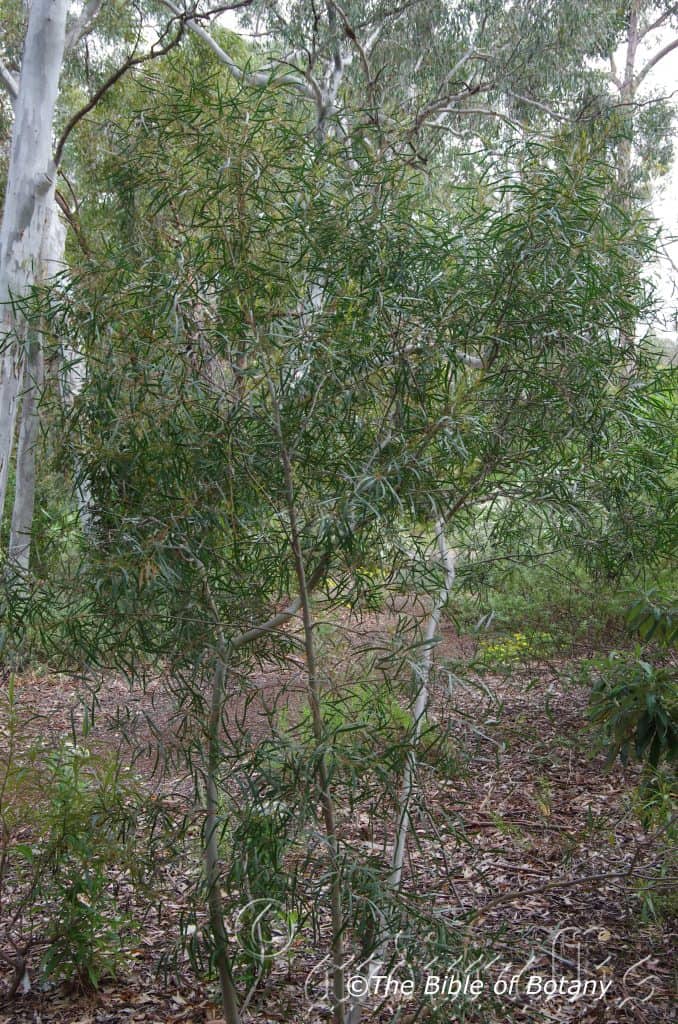
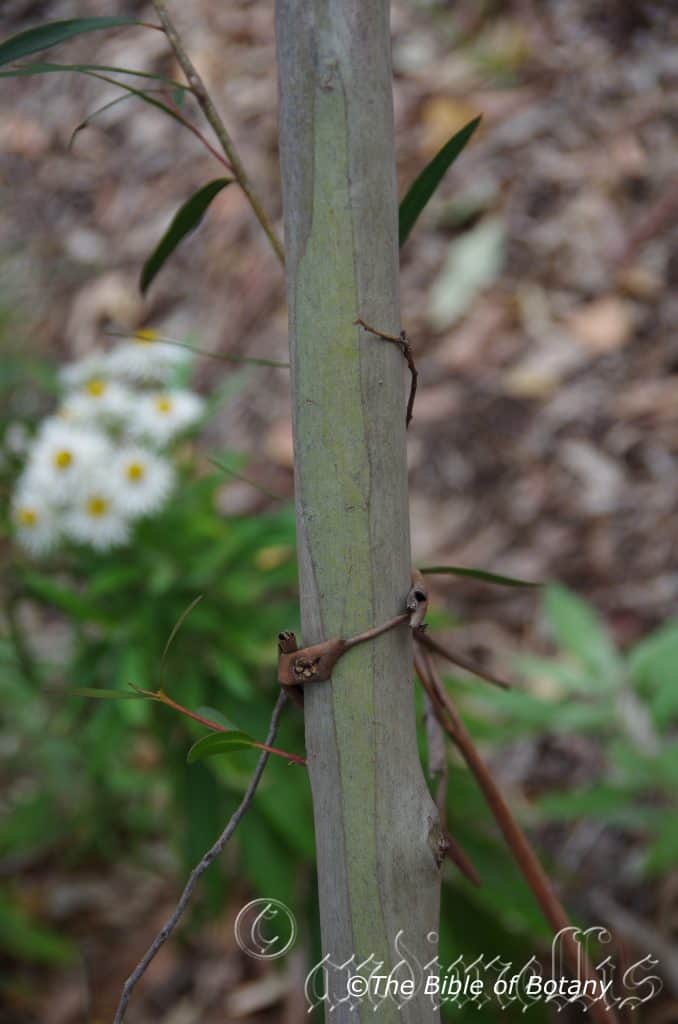
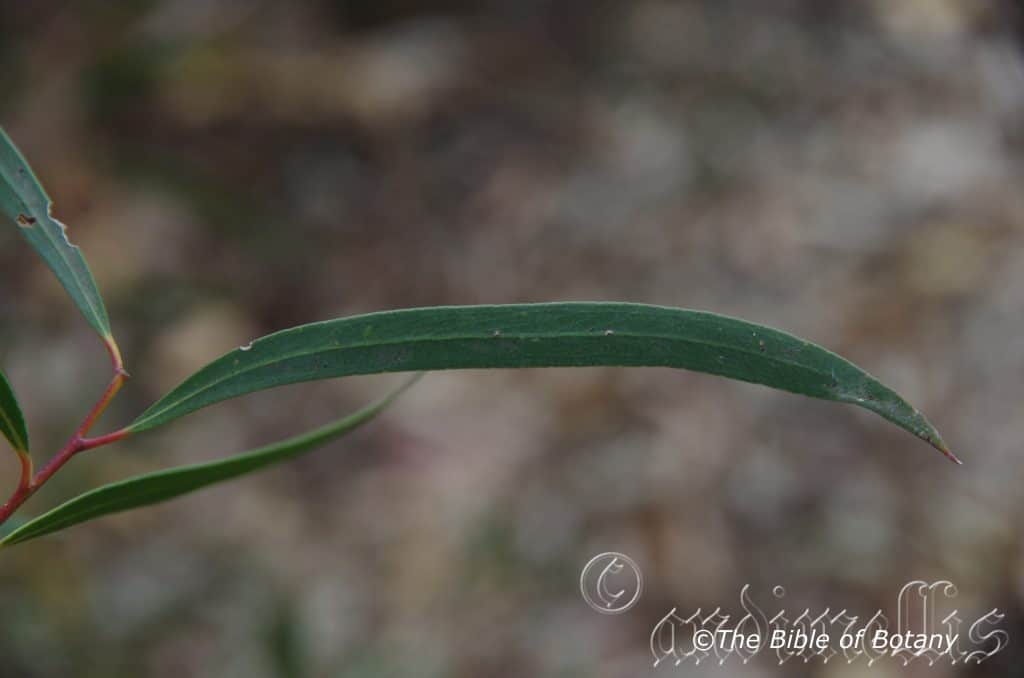

Eucalyptus apiculata
Classification:
Unranked: Eudicots
Clade: Rosids
Order: Myrtales
Family: Myrtaceae
Genus: From Eu, which is Greek a prefix for good or well and Kaluptos, which is Ancient Greek for to cover up. It refers to the stamens, which have a lid or cover over them in the bud stage prior to opening.
Specie: From Apical, which is Latin for at the summit, top, at the apex or at the highest or furthest point. It refers to the leaves and flowers, which form at the end of the trunk and stems.
Sub specie:
Common Name:
Distribution:
Eucalyptus apiculata is found in a restricted area between Dunn Swamp, 26 km ENE of Kandos and Berrima and south from Appin near the coast. It is mainly found on the Great Dividing Range to the coast in the southern part of its range.
https://avh.ala.org.au/occurrences/search?taxa=Eucalyptus+apiculata#tab_mapView
Habitat Aspect Climate:
Eucalyptus apiculata prefers full sun. It grows in grassy open woodland and dry schlerophyll forests on low sites, shallow depressions or along watercourses on alluvial flats. The altitude ranges from 600 meters ASL to 1200 meters ASL.
The temperatures range minus 4 degrees in August to 40 degrees in January.
The rainfall ranges from lows of 400mm to an average of 1600mm annually.
Soil Requirements:
Eucalyptus apiculata is a rare, small mallee type Eucalyptus which prefers well drained, poorer, sandy soils to sandy loams. The soils are usually skeletal sands derived from decomposed sandstone or podsolic in nature. The soils pH ranges from 5pH to 6pH. It does not tolerate water logged soils.Non saline soils to moderately saline soils are tolerated as are salt laden winds.
Height & Spread:
Wild Plants: 3m to 6m by 3m to 5m.
Characteristics:
Eucalyptus apiculata is a small mallee which forms a sub terrain lignotuber. The bark is smooth white, pale grey or green bark and is shed in long ribbons.
Eucalyptus apiculata’s disjunct juvenile and coppice leaves are opposite, sessile and amplexicaul. The narrow lanceolate, glossy green leaves measure 100mm to 160mm in length by 8mm to 20mm in width. The margins are entire.
The alternate, disjunct adult leaves are narrowly falcate, linear to narrow lanceolate. They measure 50mm to 110mm in length by 5mm to 8mm in width. The terete petioles measure 0mm to 11mm in length. The bases are tapering while the apexes are apiculate. The concolourous laminas are mid green and glabrous on the upper laminas. The margins are entire while the mid vein is slightly prominent on both laminas. The lateral vein’s venation are obscure and very acute, sparsely reticulate with the intramarginal vein being well removed from margin. The oil glands are islands between the veins.
The inflorescences of Eucalyptus apiculataare born as umbellasters from the leaf axils. There are 7 individual white to cream, clavate flowers to an umbellaster. The peduncles and pedicels are terete and glabrous. The peduncles measure 2mm to 5mm in length while the pedicels measure 2mm to 11mm in length. The clavate buds measure 6mm to 8mmin length by 3mm to 4mm in diameter. The scar is absent. The hemispherical calyptra, is shorter than and as wide as or wider than hypanthium and are sparsely covered in minute lepidote lumps.
The irregular flexed stamens are white to cream. The white to cream anthers are reniform to cordate. The dorsifixed versatile anthers dehisce by way of confluent slits. The white style arises from the pale green disc. The flowers appear from mid-August to January.
The fruits of Eucalyptus apiculataare urceolate to broad urceolate capsules known as gum nuts. The resinous gum nuts measure 6mm to 10mm in length by 6mm to 10mm in diameter at the widest point. The disc is descending with 3 or 4 fully enclosed valves.
The reddish-brown seeds are pyramidal or obliquely pyramidal, dorsal surface smooth, hilum terminal and measure 1mm to 1.8mm in length while the trash is smaller.
Wildlife:
The flowers Eucalyptus apiculata are average nectar producers and are very attractive to most honeyeaters, lorikeets, possums and many insects.
Cultivation:
Eucalyptus apiculata is a large gum tree which is very suitable for large gardens where a Eucalyptus is required. It is ideal on poor sandy soils to medium clays on undulating slopes or flats with skeletal or deep soils that are well drained. It is fast growing so give good effects at an early age. In the garden good specimens grow from 5 meters to 6 meters in height by 5 meters to 6 meters in diameter when grown in the open.
Eucalyptus apiculata can give quick protection, habitat and safe corridors for many small birds. It looks particularly good when mixed with other small to medium Eucalyptus spp. with varying types of barks and foliage.
Eucalyptus apiculata can be used like many small Eucalyptus spp. to create that little bit of Australiana in the back yard.Often floral characteristics of a plant dictate our selection of plants for the garden. Remember that once a Eucalyptus spp.; or in fact any tree, reaches a reasonable size, its trunk or bark can are the most prominent features seen. Among the eucalypts there are many different types of barks which include some of our beautiful peppermint barks. Grouping, mallees as mallees or as single trunk trees can add immeasurably to the interest within a small space. Eucalyptus apiculata is one of those species whose multi stems and bark contrasts well with single stem species.
Small shrubs can be used to emphasize the open spaces surrounding a mallee or a small tree especially when mass plantings are done.
Eucalyptus apiculata can look great when placed in the corner against a fence to add privacy and remove the barrenness of the yard while giving extra depth.
Propagation:
Seeds: Sow into a seed raising mix. Cover the seeds with 2mm to 3mm of fine sand and place the trays in a warm sunny position. Keep the seeds moist but not wet. When the seedlings roots reach the bottom of the trays they should be potted up immediately into 50mm native tubes using a good organic mix.
Once the seedlings roots reach the bottom of the tubes they should be planted out immediately into their permanent position. Mass plantings are best done in groups of 3 to 5 as a feature by planting them at 5 meter centers for a cluster look or 10 meter to 15 meter centers for an open park like scene.
The plants display some stress until established so should not be allowed to become too wet or dry out.
Fertilize using Seaweed, fish emulsion or organic chicken pellets soaked in water and apply the liquid on an alternate basis. Fertilize every two month until the trees are well established then every spring to ensure good growth and flowering.
Further Comments from Readers:
“Hi reader, it seems you use The Bible of Botany a lot. That’s great as we have great pleasure in bringing it to you! It’s a little awkward for us to ask, but our first aim is to purchase land approximately 1,600 hectares to link several parcels of N.P. into one at The Pinnacles NSW Australia, but we need your help. We’re not salespeople. We’re amateur botanists who have dedicated over 30 years to saving the environment in a practical way. We depend on donations to reach our goal. If you donate just $5, the price of your coffee this Sunday, We can help to keep the planet alive in a real way and continue to bring you regular updates and features on Australian plants all in one Botanical Bible. Any support is greatly appreciated. Thank you.”
In the spirit of reconciliation we acknowledge the Bundjalung, Gumbaynggirr and Yaegl and all aboriginal nations throughout Australia and their connections to land, sea and community. We pay our respect to their Elders past, present and future for the pleasures we have gained.
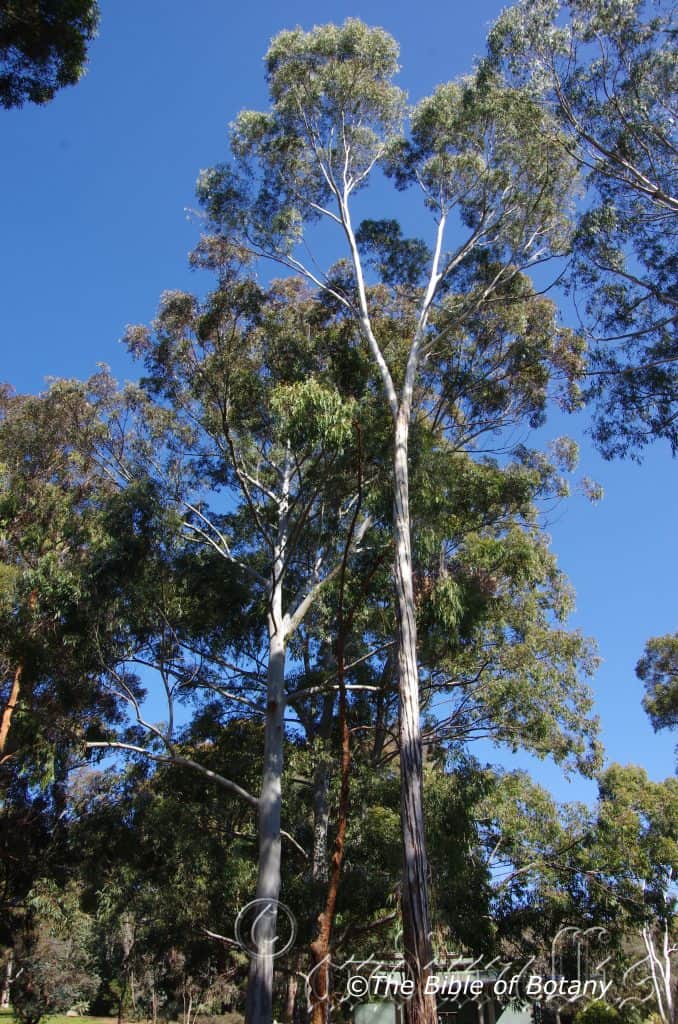

Eucalyptus argophloia
Classification:
Unranked: Eudicots
Clade: Rosids
Order: Myrtales
Family: Myrtaceae
Genus: From Eu, which is Greek a prefix for good or well and Kaluptos, which is Ancient Greek for to cover up. It refers to the stamens, which have a lid or cover over them in the bud stage prior to opening.
Specie: From Badja, which is Latinized for Big Badja Hill and Ana/Ensis, which is Latin for origin. It refers to where the first plants were discovered at Big Badja Hill north east of Cooma in southern New South Wales.
Sub specie:
Common Name:.
Distribution:
Eucalyptus argophloia is a locally common, rare tree, restricted to a small area around Chinchilla with 2 disjunct populations at Goondiwindi and Cunnamulla in south east Queensland. It is found on the western side of the Great Dividing Range.
https://avh.ala.org.au/occurrences/search?taxa=Eucalyptus+argophloia#tab_mapView
Habitat Aspect Climate:
Eucalyptus argophloia prefers full sun or partial shade. It grows in wet forests on east facing slopes. The altitude ranges from 500 meters ASL to 600 meters ASL.
The temperatures range minus 5 degrees in August to 36 degrees in January.
The rainfall ranges from lows of 600mm to an average of 800mm annually.
Soil Requirements:
Eucalyptus argophloia prefers better quality fertile loams to medium clays. It is found growing over Podsolic soils predominantly on very strongly limited conditions, such as Lithosols, with poor differentiation into horizons where stony or gravelly conditions are permeated. The soils are usually derived from decomposed granites meta-shales. The soils pH ranges from 4.5pH to 5.5pH. It does not tolerate water logged soils though soil moisture is consistent throughout the year.Non saline soils to moderately saline soils are tolerated.
Height & Spread:
Wild Plants: 20m to 30m by 8m to 10m.
Characteristics:
Eucalyptus argophloia bark is smooth throughout, grey or reddish-grey or pale brown over white to creamy-white or at times yellowish. The decorticating bark peels with thin flakes or strips often persisting on the lower trunk.
Juvenile growth and coppice or field seedlings to are green and measure 30mm in length. The square to terete in cross section stems are lime green. The opposite juvenile leaves to 6 nodes there after alternate are shortly petiolate. It is lanceolate to linear and measure 45mm to 90mm in length by 4mm to 14mm in width.
The alternate mature leaves’ petioles measure 5mm to 15mm in length. The narrowly lanceolate leaves are concolorous, glossy green, rarely dull grey-green to slightly glaucous and measure 65 to 140 mm in length by 7mm to 20mm in width. The base is tapering to the petiole, while the apex is acute. The margins are entire, while the lateral veins are somewhat irregularly spaced with a moderately to dense reticulation. The intramarginal vein is remote from margin and oil glands irregular in shape between the reticulation.
The axillary single inflorescence’s peduncles measure 5mm to 10mm in length. There are 7 per umbel with the pedicels measuring 1mm to 4mm in length. The globular to obovoid or ovoid buds measure 4mm to 6mm in length by 3mm to 4mm in diameter. The obtuse operculum breaks free as the first of the white, inflexed stamens emerge. The cuboid to globoid anthers are adnate or basifixed and dehisce by short lateral slits.
The long, straight, white style has a pin head stigma with 5 locules or rarely 4.
The pedicellate or subsessile fruits are hemispherical to cupular and measure 3mm to 5mm in length by 5mm to 7mm in diameter. The disc is descending vertically with the valves close to the rim.
The brown, flattened ovoid, seeds dorsal surface is shallowly reticulate and measure 0.8mm to 1mm in length.
Wildlife:
The flowers Eucalyptus argophloia are average nectar producers and are very attractive to most honeyeaters, lorikeets, possums and many insects.
Cultivation:
Eucalyptus argophloia is a large gum tree which is very suitable for large gardens where a Eucalyptus is required. It is ideal on better quality, cold loamy soils to medium clays on undulating to steep slopes that are well drained. It is fast growing so give good effects at an early age. In the garden good specimens grow from 30 meters to 35 meters in height by 15 meters to 20 meters in diameter when grown in the open.
Like all Eucalyptus spp. leaf drop, dropping of small branches means continual lawn maintenance but then this means good quantities of leaf litter mulch.
Eucalyptus argophloia can give quick protection, habitat and safe corridors for many small birds. It makes a good basis for wind rows and shelter trees on farms and sheep stations. It looks particularly good when mixed with other Eucalyptus with varying types of bark.
Propagation:
Seeds: Sow into a seed raising mix. Cover the seeds with 2mm to 3mm of fine sand and place the trays in a warm sunny position. Keep the seeds moist but not wet. When the seedlings are 25mm to 50mm tall, prick them out and plant them into 50mm native tubes using a good organic mix.
Once the seedlings reach 200mm to 250mm in height plant them out into their permanent position. Mass plantings are best done in groups of 3 to 5 as a feature by planting them at 10 meter to 15 meter centers.
Fertilize using Seaweed, fish emulsion or organic chicken pellets soaked in water and apply the liquid on an alternate basis. Fertilize every two month until the trees are well established then every spring to ensure good growth and flowering.
Further Comments from Readers:
“Hi reader, it seems you use The Bible of Botany a lot. That’s great as we have great pleasure in bringing it to you! It’s a little awkward for us to ask, but our first aim is to purchase land approximately 1,600 hectares to link several parcels of N.P. into one at The Pinnacles NSW Australia, but we need your help. We’re not salespeople. We’re amateur botanists who have dedicated over 30 years to saving the environment in a practical way. We depend on donations to reach our goal. If you donate just $5, the price of your coffee this Sunday, We can help to keep the planet alive in a real way and continue to bring you regular updates and features on Australian plants all in one Botanical Bible. Any support is greatly appreciated. Thank you.”
In the spirit of reconciliation we acknowledge the Bundjalung, Gumbaynggirr and Yaegl and all aboriginal nations throughout Australia and their connections to land, sea and community. We pay our respect to their Elders past, present and future for the pleasures we have gained.



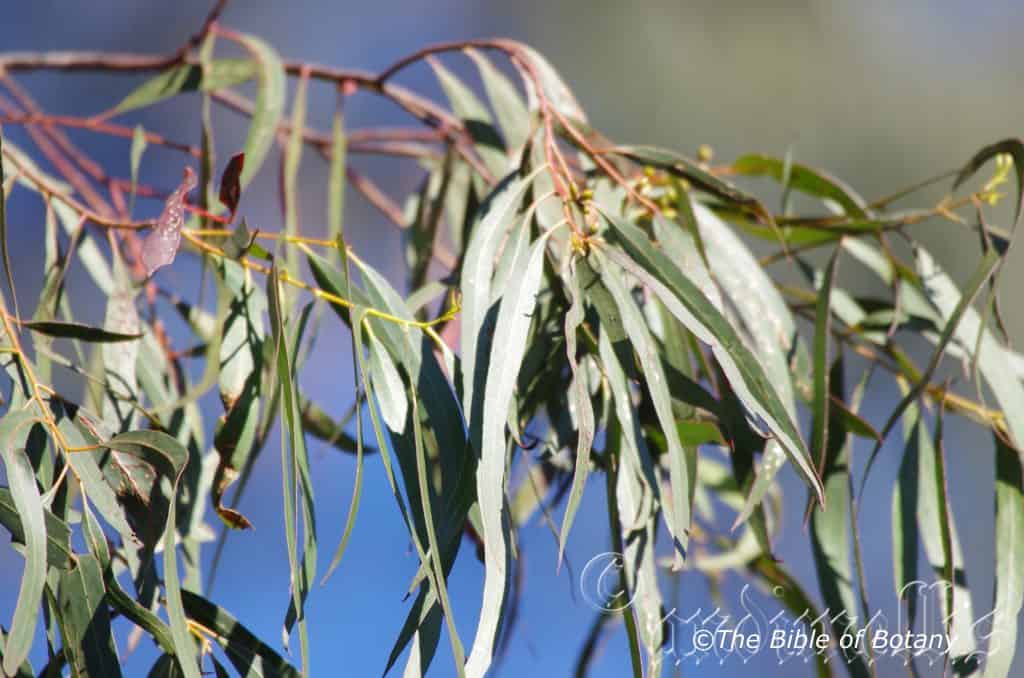
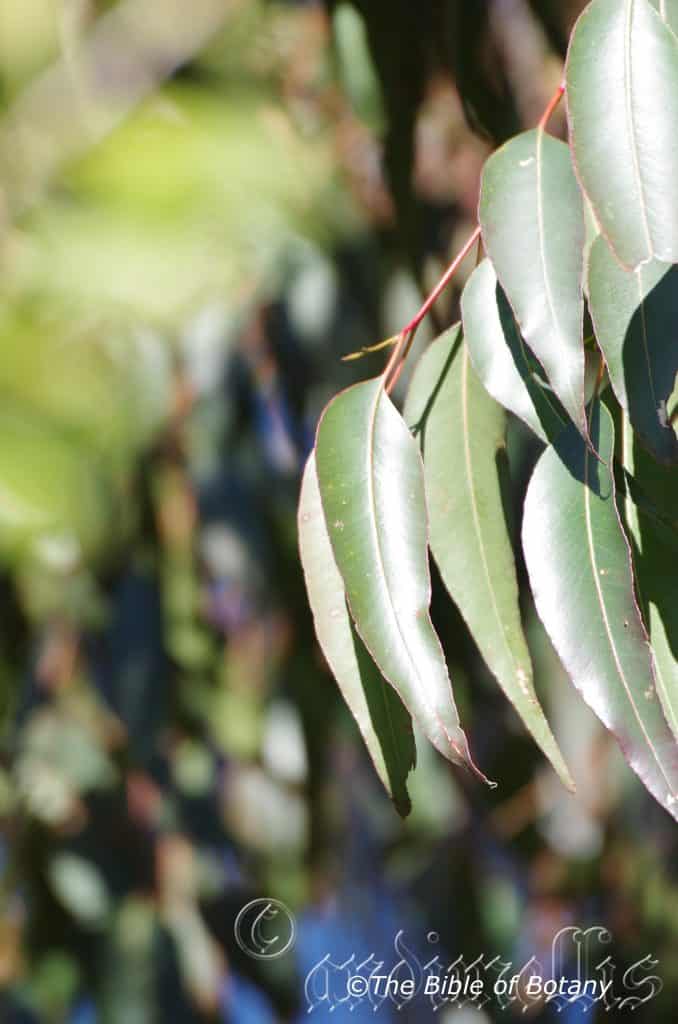

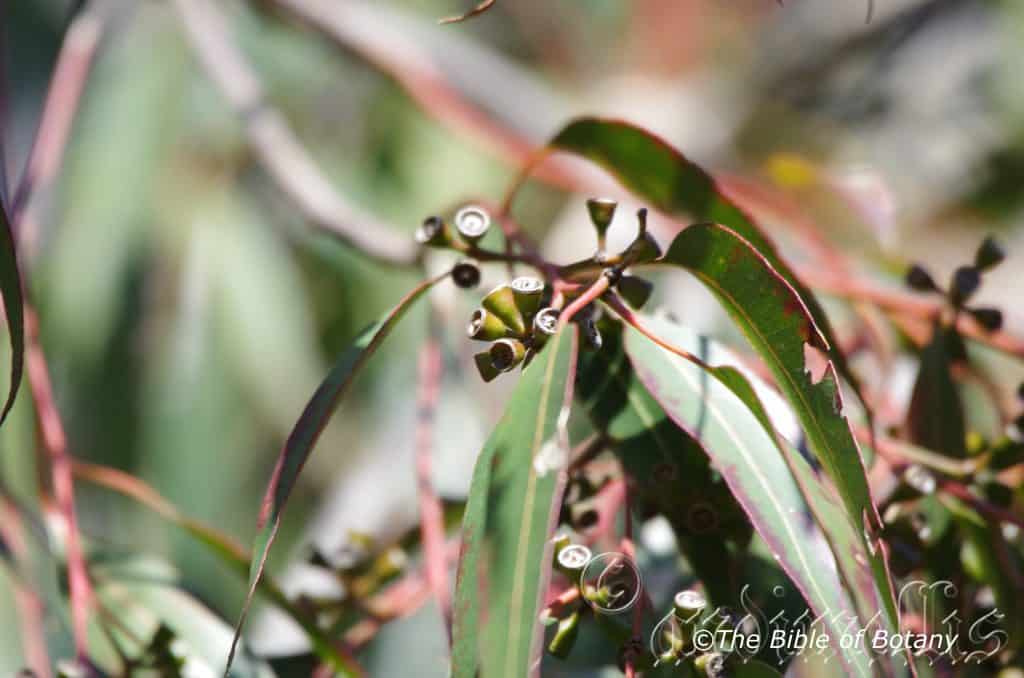
Eucalyptus badjensis
Classification:
Unranked: Eudicots
Clade: Rosids
Order: Myrtales
Family: Myrtaceae
Genus: From Eu, which is Greek a prefix for good or well and Kaluptos, which is Ancient Greek for to cover up. It refers to the stamens, which have a lid or cover over them in the bud stage prior to opening.
Specie: From Badja, which is Latinized for Big Badja Hill and Ana/Ensis, which is Latin for origin. It refers to where the first plants were discovered at Big Badja Hill north east of Cooma in southern New South Wales.
Sub specie:
Common Name: The Big Badja Gum.
Distribution:
Eucalyptus badjensis is locally common, rare tree, restricted to a small area between Big Badja Hill and Cathcart on the Great Dividing Range in the south eastern corner of New South Wales.
https://avh.ala.org.au/occurrences/search?taxa=Eucalyptus+badjensis#tab_mapView
Habitat Aspect Climate:
Eucalyptus badjensis prefers full sun or partial shade. It grows in wet forests on east facing slopes. The altitude ranges from 800 meters ASL to 1200 meters ASL.
The temperatures range minus 5 degrees in August to 36 degrees in January.
The rainfall ranges from lows of 800mm to an average of 1200mm annually.
Soil Requirements:
Eucalyptus badjensis prefers better quality fertile loams to medium clays. It is found growing over Podsolic soils predominantly on very strongly limited conditions, such as Lithosols, with poor differentiation into horizons where stony or gravelly conditions are permeated. The soils are usually derived from decomposed granites meta-shales. The soils pH ranges from 4.5pH to 5.5pH. It does not tolerate water logged soils though soil moisture is consistent throughout the year.Non saline soils to moderately saline soils are tolerated.
Height & Spread:
Wild Plants: 25m to 40m by 10m to 15m.
Characteristics:
Eucalyptus badjensis has along straight bole with the first branches appearing at around 80mm of the trees height on mature trees. The rough grey to grey-brown bark is shortly fibrous and persistent on the lower trunk. The rest of the trunk and branches are smooth, white, pale grey, pale grey-brown or greenish especially on the branchlets. The upper bark is shed in long ribbons.
Eucalyptus badjensis’s juvenile and coppice stems are terete. The opposite leaves are lanceolate with cordate bases and broad tapering apexes. The concolourous laminas are dull green while the margins are entire.
The alternate, disjunct adult leaves are slightly falcate to falcate and narrow lanceolate and measure 80mm to 210mm in length by 7mm to 15mm in width. The compressed petioles measure 12mm to 19mm in length. The bases are rounded to rounded-cuneate while the apexes are narrow long tapering. The concolourous laminas are pale to mid-green and glabrous. The margins are entire while the mid vein is very strongly prominent on the lower lamina and moderately to strongly prominent on the upper lamina. The lateral veins are very faintly visible if at all visible.
The inflorescences of Eucalyptus badjensis are born as umbellasters along the stems. There are 3 individual white to cream flowers to an umbellaster. The peduncles are terete to slightly flattened and glabrous while the pedicels are terete to angular and glabrous. The peduncles measure 2mm to 4.5mm in length while the pedicels are usually sessile or measure up to 0.5mm in length. The ovoidal to obovoidal hypanthium are mid yellowish-green and glabrous. The buds measure 3.5mm to 6mm by 2mm to 3.5mm in diameter. The calyptras are conical to semi orbicular often with a short rostrate tip and are shorter than and as wide as the hypanthium. A bud scar is present.
The stamens are white to cream and measure 4mm to 6mm in length. The white to cream, orbicular, basifixed anthers, dehisce and are versatile. The white style measures 6mm to 7mm in length. The disc is pale green. The flowers appear from mid-August to January.
The fruits of Eucalyptus badjensis are campanulate capsules known as gum nuts. The deep green gum nuts measure 3.5mm to 5.5mm in length by 3.5mm to 5.5mm in diameter at the widest point. The disc is flat, slightly inserted or slightly exserted with 4 exserted valves. The rim of the hypanthia extends past the body.
Wildlife:
The flowers Eucalyptus badjensis are average nectar producers and are very attractive to most honeyeaters, lorikeets, possums and many insects.
Cultivation:
Eucalyptus badjensis is a large gum tree which is very suitable for large gardens where a Eucalyptus is required. It is ideal on better quality, cold loamy soils to medium clays on undulating to steep slopes that are well drained. It is fast growing so give good effects at an early age. In the garden good specimens grow from 30 meters to 35 meters in height by 15 meters to 20 meters in diameter when grown in the open.
Like all Eucalyptus spp. leaf drop, dropping of small branches means continual lawn maintenance but then this means good quantities of leaf litter mulch.
Eucalyptus badjensis can give quick protection, habitat and safe corridors for many small birds. It makes a good basis for wind rows and shelter trees on farms and sheep stations. It looks particularly good when mixed with other Eucalyptus with varying types of bark.
Propagation:
Seeds: Sow into a seed raising mix. Cover the seeds with 2mm to 3mm of fine sand and place the trays in a warm sunny position. Keep the seeds moist but not wet. When the seedlings are 25mm to 50mm tall, prick them out and plant them into 50mm native tubes using a good organic mix.
Once the seedlings reach 200mm to 250mm in height plant them out into their permanent position. Mass plantings are best done in groups of 3 to 5 as a feature by planting them at 10 meter to 15 meter centers.
Fertilize using Seaweed, fish emulsion or organic chicken pellets soaked in water and apply the liquid on an alternate basis. Fertilize every two month until the trees are well established then every spring to ensure good growth and flowering.
Further Comments from Readers:
“Hi reader, it seems you use The Bible of Botany a lot. That’s great as we have great pleasure in bringing it to you! It’s a little awkward for us to ask, but our first aim is to purchase land approximately 1,600 hectares to link several parcels of N.P. into one at The Pinnacles NSW Australia, but we need your help. We’re not salespeople. We’re amateur botanists who have dedicated over 30 years to saving the environment in a practical way. We depend on donations to reach our goal. If you donate just $5, the price of your coffee this Sunday, We can help to keep the planet alive in a real way and continue to bring you regular updates and features on Australian plants all in one Botanical Bible. Any support is greatly appreciated. Thank you.”
In the spirit of reconciliation we acknowledge the Bundjalung, Gumbaynggirr and Yaegl and all aboriginal nations throughout Australia and their connections to land, sea and community. We pay our respect to their Elders past, present and future for the pleasures we have gained.



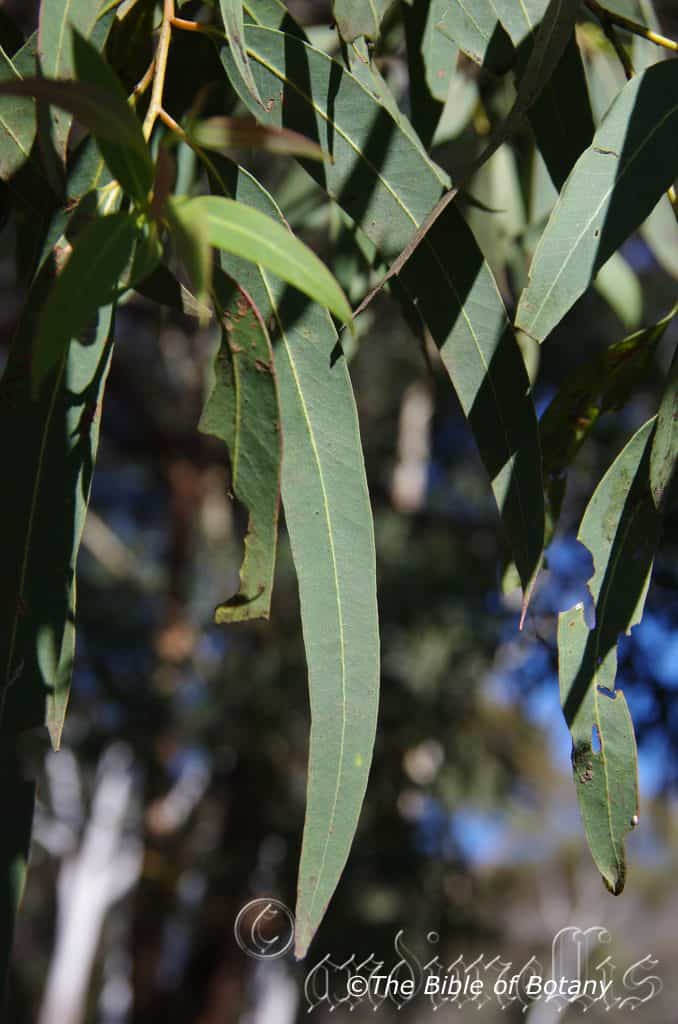

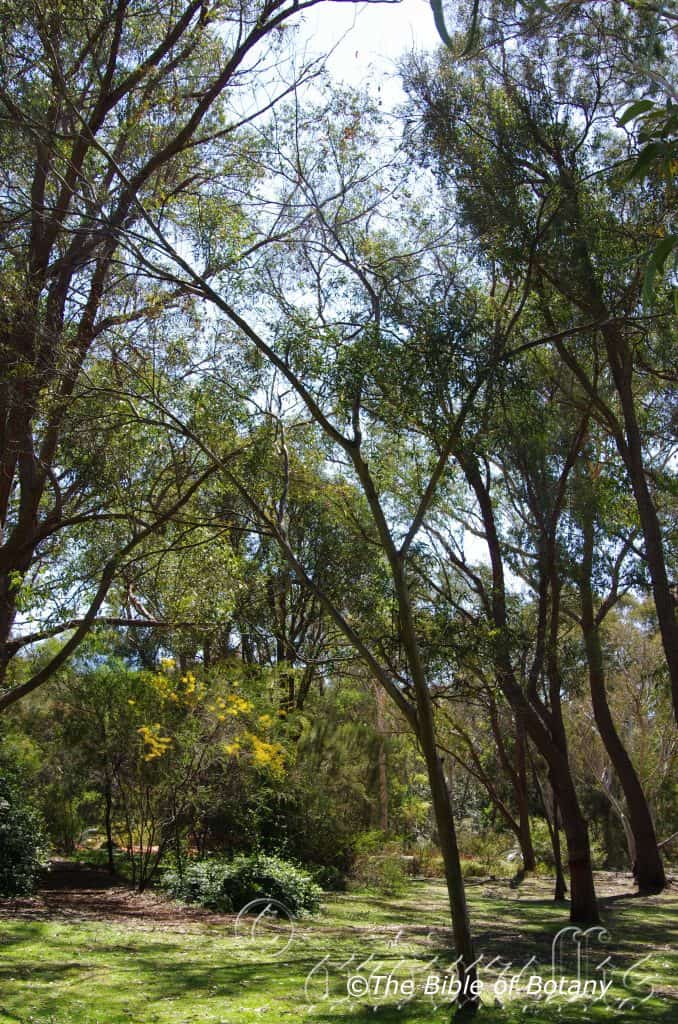
Eucalyptus baeuerlenii
Classification:
Unranked: Eudicots
Clade: Rosids
Order: Myrtales
Family: Myrtaceae
Genus: From Eu, which is Greek a prefix for good or well and Kaluptos, which is Ancient Greek for to cover up. It refers to the stamens, which have a lid or cover over them in the bud stage prior to opening.
Specie: Is named in honour of Wilhelm Baeurlen; 1840-1917, who was a plant collector for Ferdinand von Mueller and John Maiden and author of “Wildflowers of NSW.”
Sub specie:
Common Name:
Distribution:
Eucalyptus baeuerlenii is a locally common, rare tree, restricted to a small area between Wentworth Falls and the Budawang Range on the Great Dividing Range in central to the south eastern corner of New South Wales.
https://avh.ala.org.au/occurrences/search?taxa=Eucalyptus+baeuerlenii#tab_mapView
Habitat Aspect Climate:
Eucalyptus baeuerlenii prefers full sun or partial shade. It grows in wet forest or moist woodlands in sheltered sloping sites. The altitude ranges from 800 meters ASL to 1200 meters ASL.
The temperatures range minus 5 degrees in August to 36 degrees in January.
The rainfall ranges from lows of 800mm to an average of 1200mm annually.
Soil Requirements:
Eucalyptus baeuerlenii prefers average fertile loams to medium clays. It is found growing over Podsolic soils predominantly on very strongly limited conditions, such as Lithosols, with poor differentiation into horizons where stony or gravelly conditions are permeated. The soils are usually derived from decomposed granites meta-shales. The soils pH ranges from 4.5pH to 5.5pH. It does not tolerate water logged soils though soil moisture is consistent throughout the year.Non saline soils to moderately saline soils are tolerated.
Height & Spread:
Wild Plants: 8m to 15m by 6 m to 8m.
Characteristics:
Eucalyptus baeuerlenii is a small often multi trunk tree. The bark is smooth, grey, brown to coppery in colour or green. The bark is shed in long ribbons and is usually seen hanging from the forks of the branches.
Eucalyptus baeuerlenii’s juvenile and coppice stems are terete. The opposite leaves are broad lanceolate. The bases are rounded to slightly cordate while the apexes are broad acute to broad acuminate. The concolourous laminas are dull blue-green.
The alternate, disjunct adult leaves are lanceolate and measure 60mm to 90mm in length by 10mm to 25mm in width. The flattened to angulated petioles measure 4mm to 8mm in length. The bases are rounded while the apexes are narrow acute. The concolourous laminas are pale to mid-blue-green and glabrous. The margins are entire while the mid vein is slightly prominent on the lower lamina especially on the basal half. The lateral veins are very slightly prominent on the lower lamina and are faintly visible from the upper lamina.
The inflorescences of Eucalyptus baeuerleniiare born as umbellasters along the stems. There are 3 individual white to cream flowers to an umbellaster. The peduncles are narrowly flattened or angular and glabrous. The peduncles measure 1mm to 5mm in length while the pedicels are usually sessile. The slightly angulated hypanthium is ovoid or fusiform and is deep green and glabrous. The buds measure 7mm to 10mm by 4mm to 6mm in diameter. The calyptras are rostrate tip and are shorter than and much narrower than the hypanthium. A bud scar is present.
The white to cream stamens measure 5mm to 6mm in length. The white to cream, orbicular, basifixed anthers, dehisce and are versatile. The white style measures 2mm to 4mm in length. The disc is yellowish-green. The flowers appear from mid-August to January.
The fruits of Eucalyptus baeuerleniiare hemispherical to campanulate capsules known as gum nuts. The deep green gum nuts measure 6mm to 9mm in length by 6mm to 10mm in diameter at the widest point. The disc is inserted with 4 exserted valves. The rim of the hypanthia extends past the body.
Wildlife:
The flowers Eucalyptus baeuerlenii are average nectar producers and are very attractive to most honeyeaters, lorikeets, possums and many insects.
Cultivation:
Eucalyptus baeuerlenii is a large gum tree which is very suitable for small gardens where a Eucalyptus is required. It is ideal on better quality, cold loamy soils to medium clays on undulating to relatively steep slopes that are well drained. It is fast growing so gives a good effect at an early age. In the garden good specimens grow from 8 meters to 12 meters in height by 7 meters to 10 meters in diameter when grown in the open.
Like all Eucalyptus spp. leaf drop, dropping of small branches means continual lawn maintenance but then this means good quantities of leaf litter mulch.
Eucalyptus baeuerlenii can give quick protection, habitat and safe corridors for many small birds. It makes a good wind break on farms and sheep stations. It looks particularly good when mixed with other Eucalyptus with varying types of bark.
Eucalyptus baeuerlenii can be used like many small Eucalyptus spp. to create that little bit of Australiana in the back yard.Often floral characteristics of a plant dictate our selection of plants for the garden. Remember that once a Eucalyptus spp.; or in fact any tree, reaches a reasonable size, its trunk or bark can are the most prominent features seen. Among the eucalypts there are many different types of barks which include some of our beautiful peppermint barks. Grouping, mallees as mallees or as single trunk trees can add immeasurably to the interest within a small space. Eucalyptus baeuerlenii is one of those species whose multi stems and bark contrasts well with single stem species.
Small shrubs can be used to emphasize the open spaces surrounding a mallee or a small tree especially when mass plantings are done.
Eucalyptus baeuerlenii can look great when placed in the corner against a fence to add privacy and remove the barrenness of the yard while giving extra depth.
Propagation:
Seeds: Sow into a seed raising mix. Cover the seeds with 2mm to 3mm of fine sand and place the trays in a warm sunny position. Keep the seeds moist but not wet. When the seedlings are 25mm to 50mm tall, prick them out and plant them into 50mm native tubes using a good organic mix.
Once the seedlings reach 200mm to 250mm in height plant them out into their permanent position. Mass plantings are best done in groups of 3 to 5 as a feature by planting them at 10 meter to 15 meter centers.
Fertilize using Seaweed, fish emulsion or organic chicken pellets soaked in water and apply the liquid on an alternate basis. Fertilize every two month until the trees are well established then every spring to ensure good growth and flowering.
Further Comments from Readers:
“Hi reader, it seems you use The Bible of Botany a lot. That’s great as we have great pleasure in bringing it to you! It’s a little awkward for us to ask, but our first aim is to purchase land approximately 1,600 hectares to link several parcels of N.P. into one at The Pinnacles NSW Australia, but we need your help. We’re not salespeople. We’re amateur botanists who have dedicated over 30 years to saving the environment in a practical way. We depend on donations to reach our goal. If you donate just $5, the price of your coffee this Sunday, We can help to keep the planet alive in a real way and continue to bring you regular updates and features on Australian plants all in one Botanical Bible. Any support is greatly appreciated. Thank you.”
In the spirit of reconciliation we acknowledge the Bundjalung, Gumbaynggirr and Yaegl and all aboriginal nations throughout Australia and their connections to land, sea and community. We pay our respect to their Elders past, present and future for the pleasures we have gained.


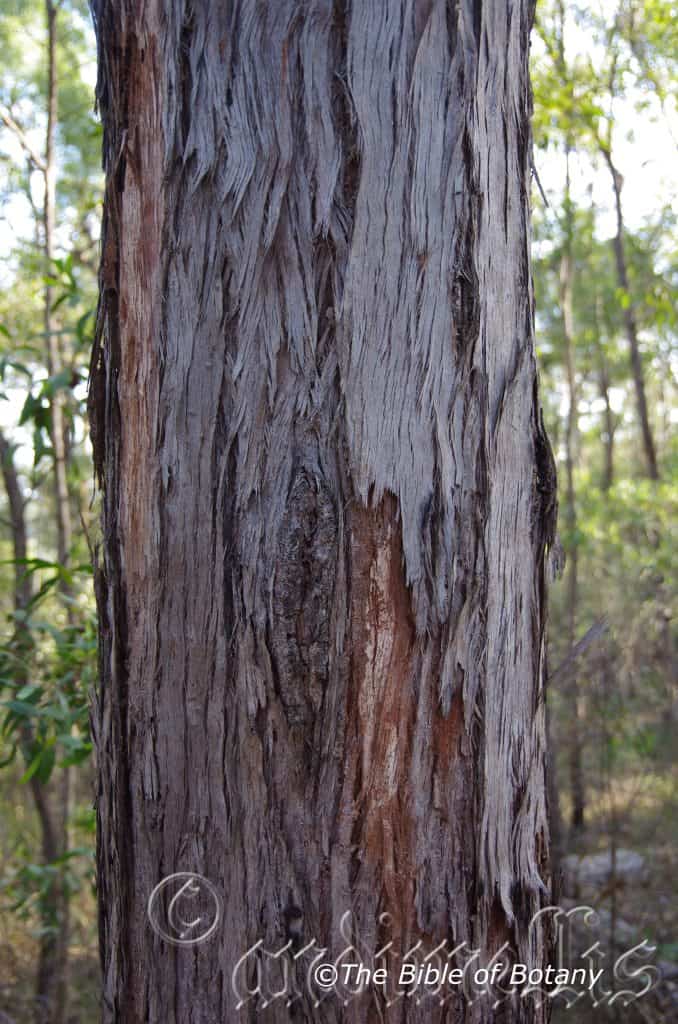
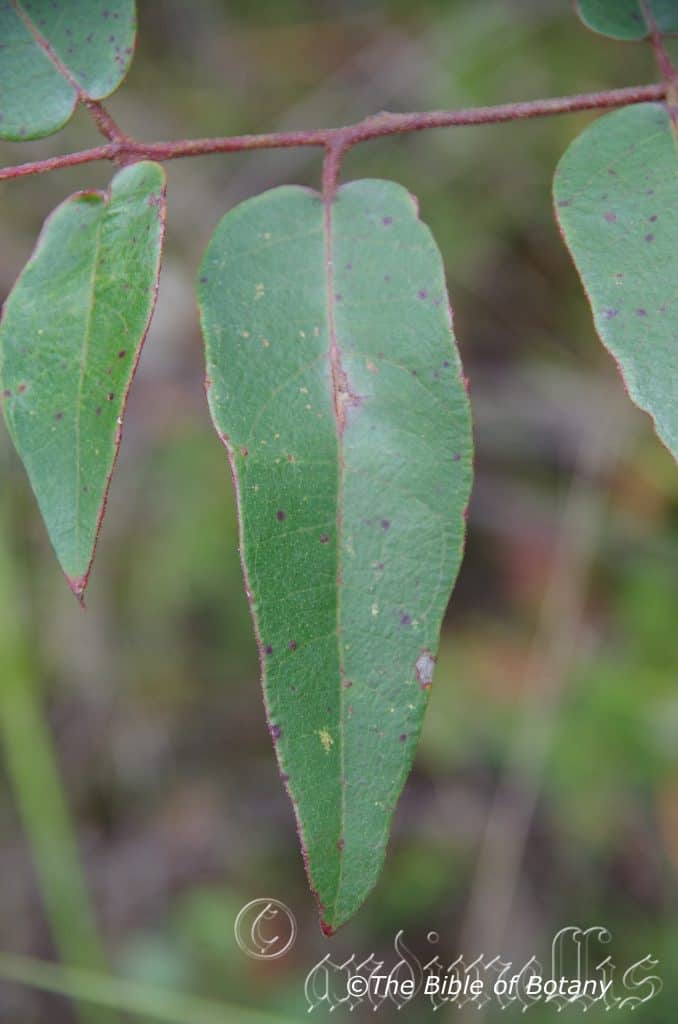
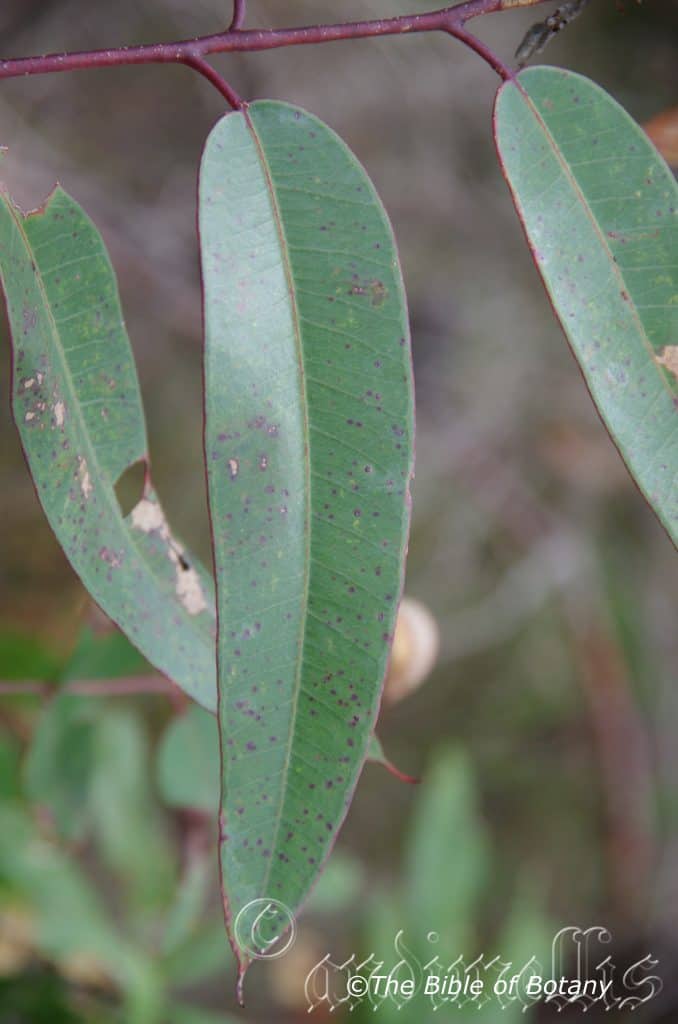



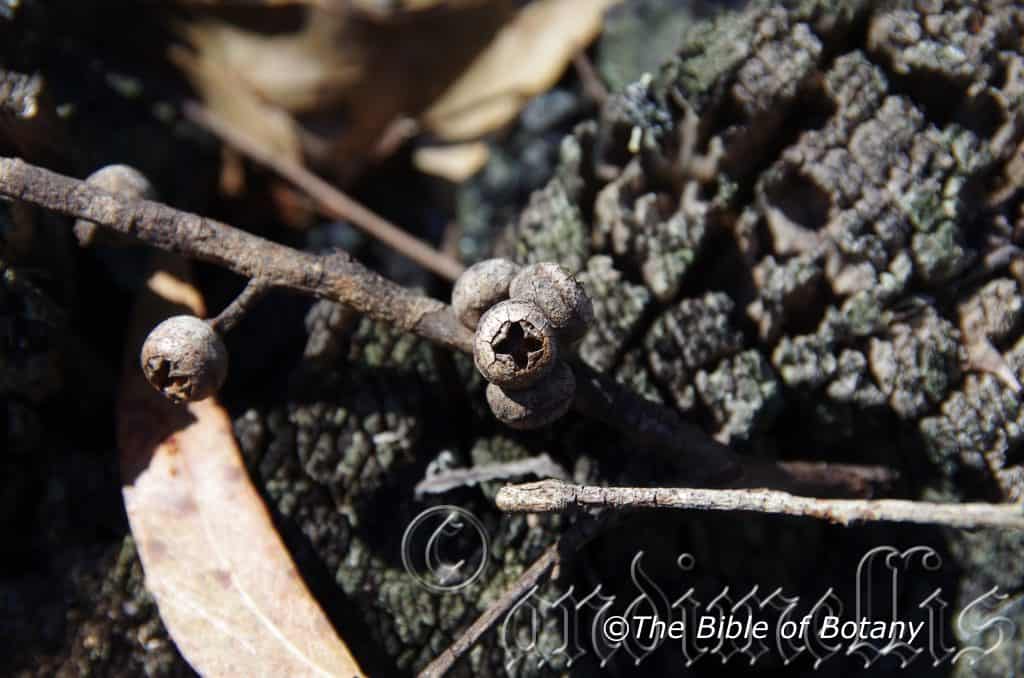
Eucalyptus baileyana
Classification:
Unranked: Eudicots
Clade: Rosids
Order: Myrtales
Family: Myrtaceae
Genus: From Eu, which is Greek a prefix for good or well and Kaluptos, which is Ancient Greek for to cover up. It refers to the stamens, which have a lid or cover over them in the bud stage prior to opening.
Specie: Is named in honour of Frederick Mason Bailey; 1827-1915, who was an English born Australian seed collector and curator of the Queensland Museum.
Sub specie:
Common Name: Bailey’s Stringybark.
Distribution:
Eucalyptus baileyana is found south from near the Blackdown Tablelands Nation Park in eastern central Queensland to Coffs Harbour in north eastern coastal New South Wales. There are 2 isolated populations; the first is at Eight Miles Plains near Etheridge and Dalrymple in south Kennedy in far north Queensland. It is mainly found on the western slopes in the north and east of the Great Dividing Range in the southern part of its range.
https://avh.ala.org.au/occurrences/search?taxa=Eucalyptus+baileyana#tab_mapView
Habitat Aspect Climate:
Eucalyptus baileyana prefers full sun. It grows in grassy open woodland and dry schlerophyll forests on low sites, shallow depressions or along watercourses on alluvial flats. The altitude ranges from 100 meters ASL to 400 meters ASL.
The temperatures range minus 2 degrees in August to 40 degrees in January.
The rainfall ranges from lows of 400mm to an average of 1600mm annually.
Soil Requirements:
Eucalyptus baileyana prefers poorer quality sandy soils to sandy loams. The soils are usually derived from decomposed sandstone or at times gritty meta-shales. The soils pH ranges from 5pH to 6pH. It does not tolerate water logged soils.Non saline soils to moderately saline soils are tolerated.
Height & Spread:
Wild Plants: 15m to 45m by 7m to 12m.
Characteristics:
Eucalyptus baileyana has along straight bole with the first branches appearing at around 40mm to 50mm of the trees height on mature trees growing in the open. The rough red-brown to deep red-brown or deep brown almost black bark is fibrous and persistent on the trunk to the larger branches. The short fibrous bark has a papery appearance.
Eucalyptus baileyana’s juvenile and coppice stems are angular and scabrous. The leaves are initially opposite to sub opposite for the first 10 or 12 pairs of leaves before becoming disjunct. The glossy deep green leaves are elliptical to broad lanceolate. The margins are entire or crenate and slightly undulating. The petioles measure 5mm to 10mm in length. The oblong to broad lanceolate leaves measure 40mm to 60mm in length by 18mm to 28mm in width. The bases are rounded while the apexes are obtuse.
The alternate, disjunct adult leaves are slightly falcate to falcate and narrow lanceolate. They measure 100mm to 140mm in length by 10mm to 25mm in width. The compressed petioles measure 12mm to 19mm in length. The bases are rounded to rounded-cuneate while the apexes are narrow long tapering. The discolourous laminas are mid grey-green with a bluish sheen, and glabrous on the upper laminas while the lower laminas are paler. The margins are entire while the mid vein is slightly prominent on both laminas. The lateral veins are penniveined and are slightly greater than 45 degrees to the main vein. The intramarginal veins are parallel and close to the margin a. The oil glands are islands between the veins.
The inflorescences of Eucalyptus baileyanaare born as umbellasters from the leaf axils. There are 7 to 11 individual white to cream flowers to an umbellaster. The peduncles are slightly flattened and glabrous while the pedicels are terete to angular and glabrous. The peduncles measure 20mm to 25mm in length while the pedicels measure 2mm to 11mm in length. The narrow ovoidal hypanthium are pale yellow-green to deep creamy-yellow and glabrous. The pyriform to clavate hypanthium measure 6mm to 8mm by 3mm to 4mm in diameter. The calyptras are hemispherical and straight with a short rostrate tip and measure 3mm to 4mm in length. The bud scar is absent.
The irregular flexed stamens are in 4 bundles, are white to cream and measure 9mm to 12mm in length. The white to cream anthers are oblong. The adnately, longitudinally anthers dehisce through longitudinal slits. The white style measures 6mm to 13mm in length. The disc is pale green. The flowers appear from mid-August to January.
The fruits of Eucalyptus baileyanaare urceolate capsules known as gum nuts. The resinous gum nuts measure 8mm to 14mm in length by 10mm to 15mm in diameter at the widest point. The disc is exserted with the 3 valves. The valves are exserted to the rim of the hypanthia.
The deep reddish-brown to deep brown almost black, flattened seeds are pyramidal to cuboidal and measure 0.7mm to 1.5mm in length while the trash is smaller. The hilum is terminally positioned while the surfaces are shallowly, broadly pitted.
Wildlife:
The flowers Eucalyptus baileyana are average nectar producers and are very attractive to most honeyeaters, lorikeets, possums and many insects.
Cultivation:
Eucalyptus baileyana is a large gum tree which is very suitable for large gardens where a Eucalyptus is required. It is ideal on poor sandy soils to heavy clays on undulating slopes with skeletal soils that are well drained. It is fast growing so give good effects at an early age. In the garden good specimens grow from 15 meters to 20 meters in height by 10 meters to 15 meters in diameter when grown in the open.
Like all Eucalyptus leaf drop, dropping of small branches means continual lawn maintenance but then this means good quantities of leaf litter mulch.
Eucalyptus baileyana can give quick protection, habitat and safe corridors for many small birds. It looks particularly good when mixed with other Eucalyptus with varying types of bark.
Propagation:
Seeds: Sow into a seed raising mix. Cover the seeds with 2mm to 3mm of fine sand and place the trays in a warm sunny position. Keep the seeds moist but not wet. When the seedlings are 25mm to 50mm tall, prick them out and plant them into 50mm native tubes using a good organic mix.
Once the seedlings reach 200mm to 250mm in height plant them out into their permanent position. Mass plantings are best done in groups of 3 to 5 as a feature by planting them at 10 meter to 15 meter centers.
Fertilize using Seaweed, fish emulsion or organic chicken pellets soaked in water and apply the liquid on an alternate basis. Fertilize every two month until the trees are well established then every spring to ensure good growth and flowering.
Further Comments from Readers:
“Hi reader, it seems you use The Bible of Botany a lot. That’s great as we have great pleasure in bringing it to you! It’s a little awkward for us to ask, but our first aim is to purchase land approximately 1,600 hectares to link several parcels of N.P. into one at The Pinnacles NSW Australia, but we need your help. We’re not salespeople. We’re amateur botanists who have dedicated over 30 years to saving the environment in a practical way. We depend on donations to reach our goal. If you donate just $5, the price of your coffee this Sunday, We can help to keep the planet alive in a real way and continue to bring you regular updates and features on Australian plants all in one Botanical Bible. Any support is greatly appreciated. Thank you.”
In the spirit of reconciliation we acknowledge the Bundjalung, Gumbaynggirr and Yaegl and all aboriginal nations throughout Australia and their connections to land, sea and community. We pay our respect to their Elders past, present and future for the pleasures we have gained.
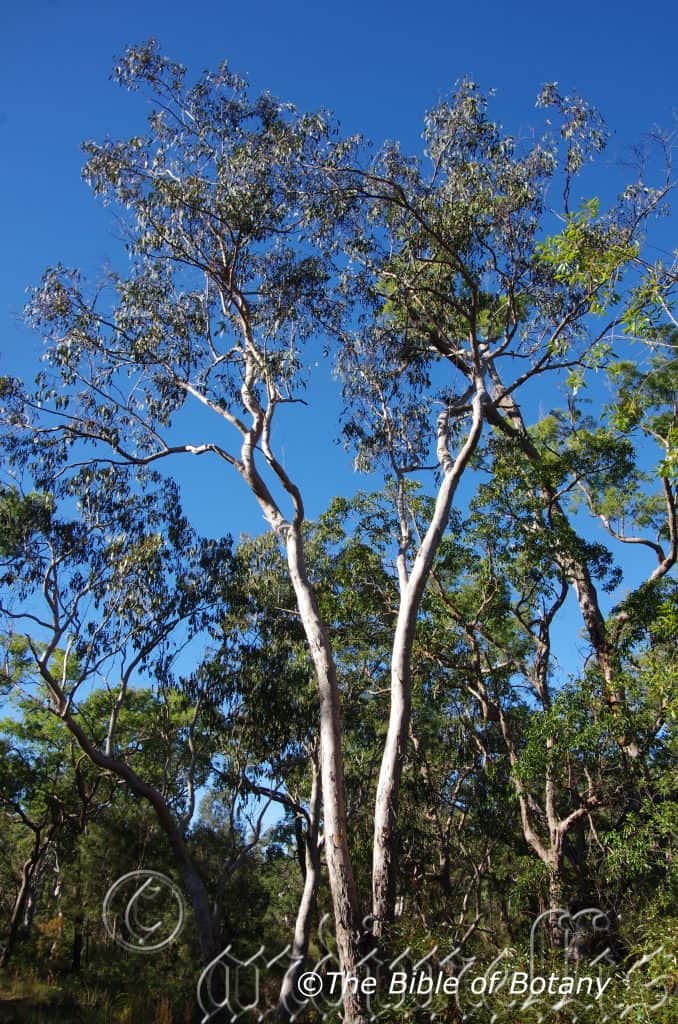
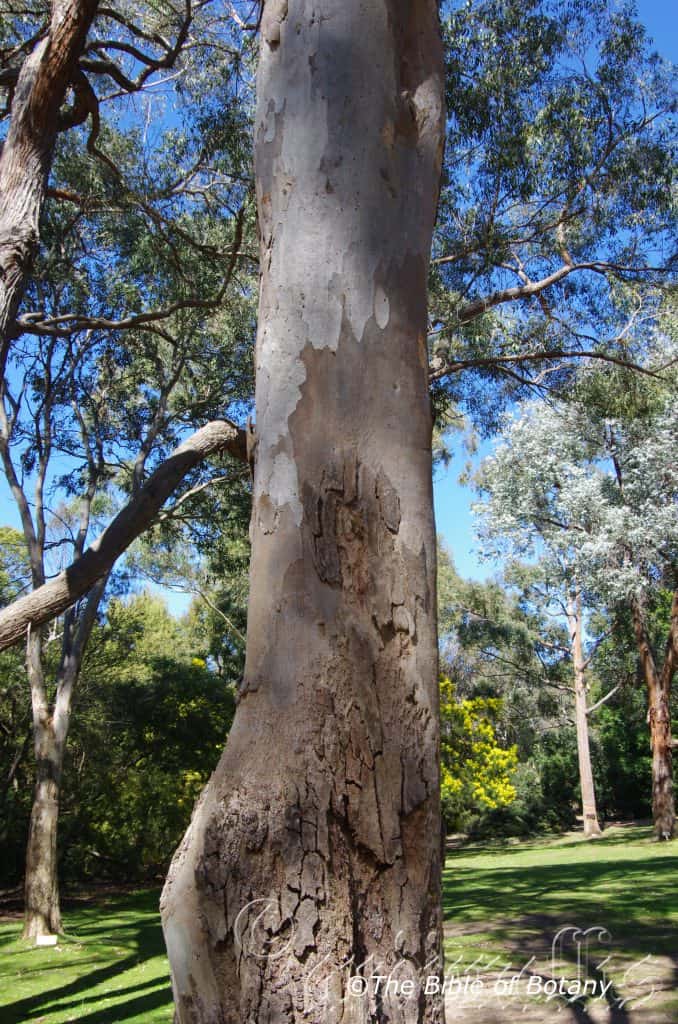
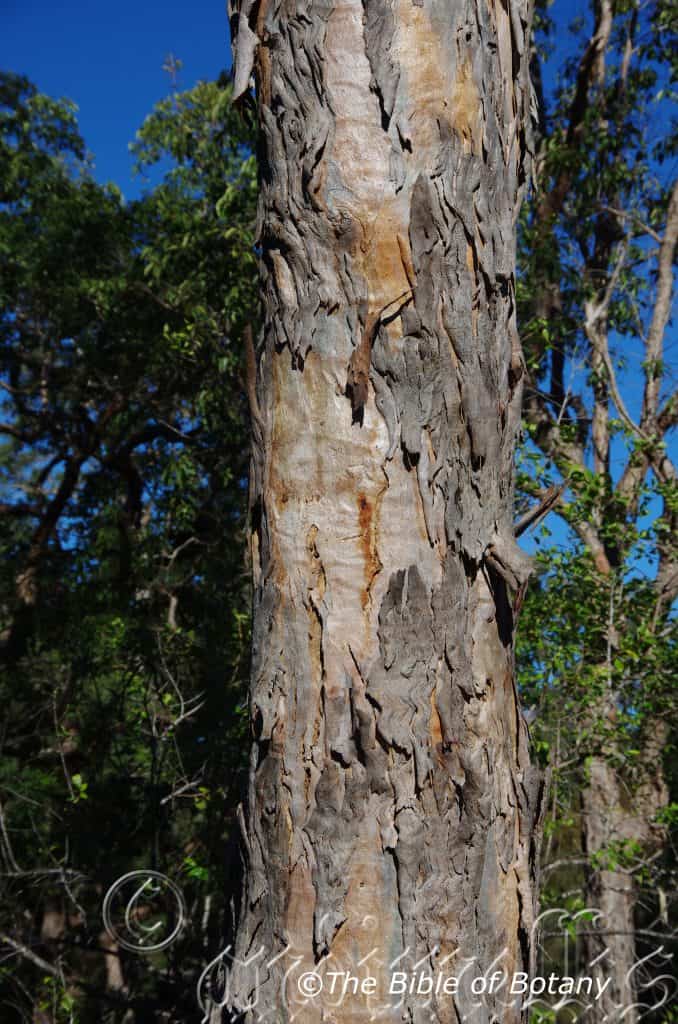


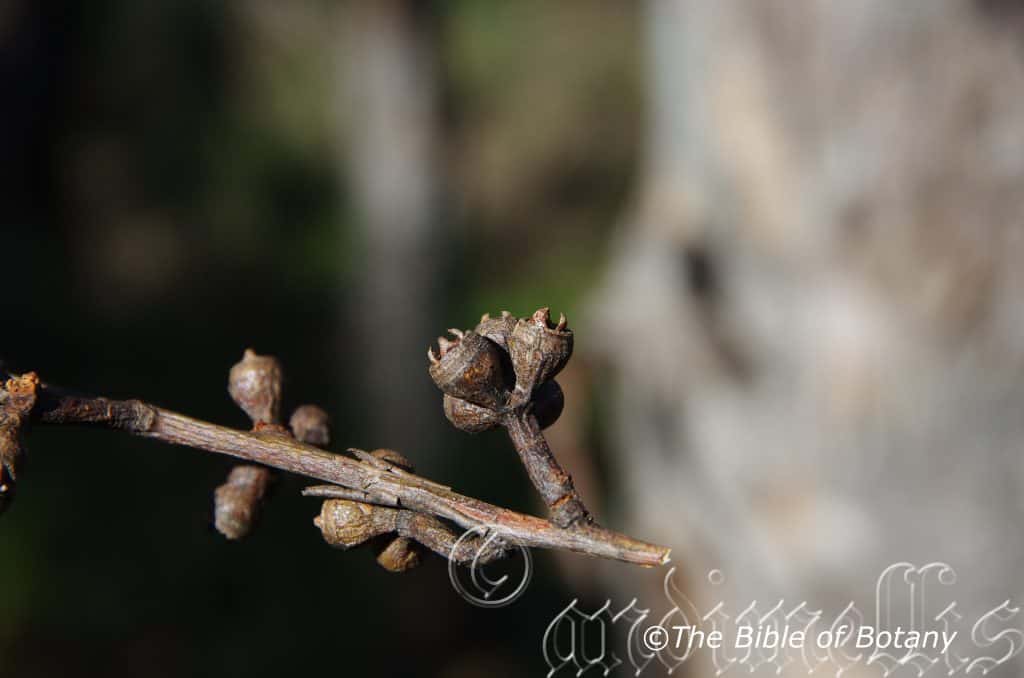
Eucalyptus bancroftii
Classification:
Unranked: Eudicots
Clade: Rosids
Order: Myrtales
Family: Myrtaceae
Genus: From Eu, which is Greek a prefix for good or well and Kaluptos, which is Ancient Greek for to cover up. It refers to the stamens, which have a lid or cover over them in the bud stage prior to opening.
Specie: Is named in honour of Thomas Lane Bancroft; 1860-1933, who was a Queensland physician and research biologist.
Sub specie:
Common Name: Orange Gum.
Distribution:
Eucalyptus bancroftii is found south from Bundaberg in southern coastal Queensland to Kew in central coastal New South Wales. It is mainly found on and east of the Great Dividing Range
https://avh.ala.org.au/occurrences/search?taxa=Eucalyptus+bancroftii#tab_mapView
Habitat Aspect Climate:
Eucalyptus bancroftii prefers full sun to light dappled shade in dry schlerophyll forests adjacent to swampy wet land. It is usually found growing on the marginal land between the swampy areas and the dry forest. The altitude ranges from 10 meters ASL to 800 meters ASL.
The temperature range minus 2 degrees in July to 40 degrees in January
The rainfall ranges from lows of 700mm to an average of 2000mm annually.
Soil Requirements:
Eucalyptus bancroftii prefers deep sandy loams, gravelly clays, and light silty clay loams to medium silty clays which are moisture retentive. The soils are derived from alluvial deposits. The soils pH ranges from 5pH to 6pH. It tolerates seasonal water logged soils and seasonal high water tables. Non saline soils to moderately saline soils are tolerated.
Height & Spread:
Wild Plants: 25m to 30m by 8m to 12m.
Characteristics:
Eucalyptus bancroftii is a long trunked tree with a bole to over half its height. The cream bark has pale grey patches. The decorticating bark is shed in large strips or plates to reveal a bright salmon to orange new bark. Young juvenile stems are red to orange-red.
Eucalyptus bancroftii’s opposite juvenile leaves are sessile or with short petioles to 2mm and dull grey-green. It is orbicular to ovate and measure 50mm to 80mm in length by 30mm to 50mm wide.
The alternate disjunct adult leaves of Eucalyptus bancroftii are lanceolate, to broad lanceolate straight or falcate and measure 80mm to 200mm in length and 15mm to 38mm in width. The petioles are slightly flattened and measure 10mm to 20mm in length. The bases are slightly oblique while the apexes are narrow acuminate. The concolourous thin laminas are blue-green, dull and glabrous. The margins are entire. The mid vein is prominent on both laminas. The lateral veins are penniveined and are at 45 degrees.
Inflorescences of Eucalyptus bancroftii are born as umbellasters from the terminals. There are 7 flowers in the umbellaster. The peduncules measure 5mm to 20mm in length while the terete pedicels measure 2mm to 5mm in length and are thin swelling to 3mm near the peduncules.
The buds are cylindrical with a narrow flattish conical calyptra, which is pale yellow and dull. They measure 10mm to 15mm in length by 4mm to 6mm in diameter. The bud scar is visible. The conical calyptra is elongated with an obtuse apex and measures 5mm to 10mm in length.
The inflexed stamens are white to creamy white with white anthers and measure 5mm to 8mm in length while the creamy style measures 4mm to 7mm in length. The disc is green. The flowers appear in late November to January.
The fruits of Eucalyptus bancroftii are flat conical capsules known as gum nuts. The gum nuts measure 7mm to 9mm in length by 8mm to 9mm in diameter at the hypanthia. The valves are exerted revealing the 4 narrow triangular valves. The flattened seeds are long ovoid and measure 1mm to 2.5mm in length and are distinctly darker than the chaff.
Wildlife:
The flowers Eucalyptus bancroftii are light nectar producers but are still are very attractive to most honeyeaters and lorikeets, native bees and beetles. I have seen Koalas in the trees at Capalaba and Redland Bay.
Cultivation:
Eucalyptus bancroftii is a small gum tree which is very suitable for medium size gardens where the gardener is looking for a Eucalyptus to create a small parkland scene in temperate and sub-tropical zones. It is ideal on sandy loams, sandy alluvial flats or heavier clays that have drainage problems. It is fast growing so give good effects at an early age. In the garden good specimens grow from 15 meters to 20 meters with a width of about 8 meters to 10 meters in diameter and a bushy crown. It is drought resistant once established. The trunk is a vivid orange to salmon orange so give a good contrast to iron barks, stringy bark trees or even other smooth barked Gum trees.
Like all Eucalyptus leaf drop, dropping of small branches means continual lawn maintenance but then this means good quantities of leaf litter mulch.
Propagation:
Seeds: Sow Eucalyptus bancroftii’s seed directly into a seed raising mix. Cover the seeds with 2mm to 3mm of fine sand and place the trays in a warm sunny position. Keep them moist, not wet to avoid damping off. When the seedlings are 25mm to 50 mm tall, prick them out and plant them into 50mm native tubes using a good organic mix.
Once the seedlings reach 200mm to 250mm in height plant them out into their permanent position. Mass plantings are best achieved by planting them at 8 meters to 12 meters depending on the natural rainfall of the property.
Fertilize using seaweed, fish emulsion or organic chicken pellets soaked in water on an alternate basis. Fertilize every two months until the plants are established then twice annually in early September or March to maintain health, vitality and better flowering.
Further Comments from Readers:
“Hi reader, it seems you use The Bible of Botany a lot. That’s great as we have great pleasure in bringing it to you! It’s a little awkward for us to ask, but our first aim is to purchase land approximately 1,600 hectares to link several parcels of N.P. into one at The Pinnacles NSW Australia, but we need your help. We’re not salespeople. We’re amateur botanists who have dedicated over 30 years to saving the environment in a practical way. We depend on donations to reach our goal. If you donate just $5, the price of your coffee this Sunday, We can help to keep the planet alive in a real way and continue to bring you regular updates and features on Australian plants all in one Botanical Bible. Any support is greatly appreciated. Thank you.”
In the spirit of reconciliation we acknowledge the Bundjalung, Gumbaynggirr and Yaegl and all aboriginal nations throughout Australia and their connections to land, sea and community. We pay our respect to their Elders past, present and future for the pleasures we have gained.
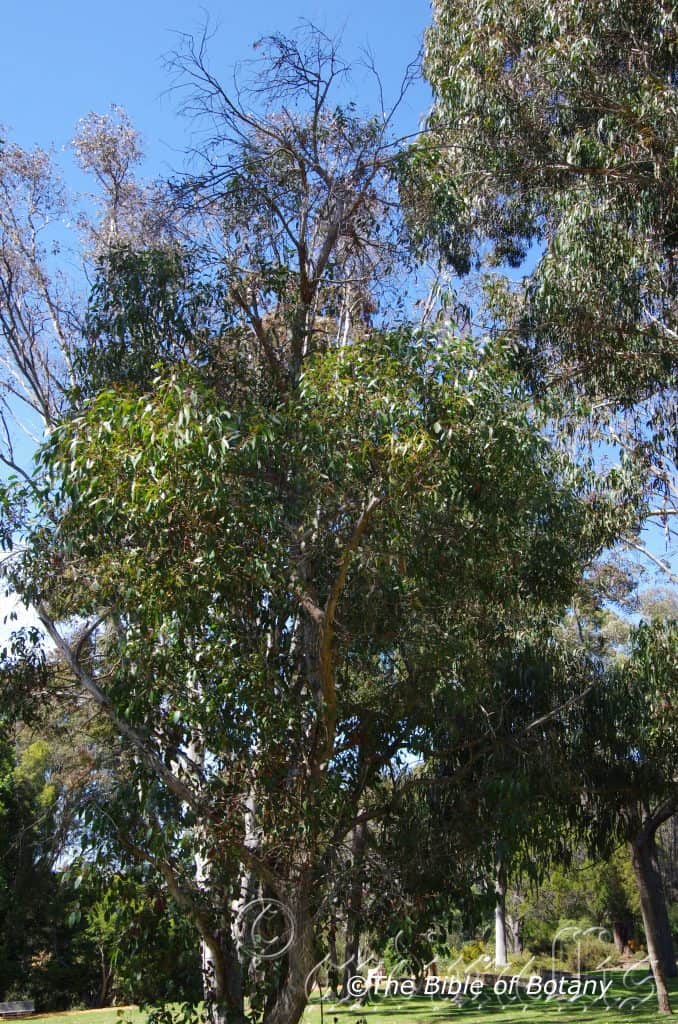

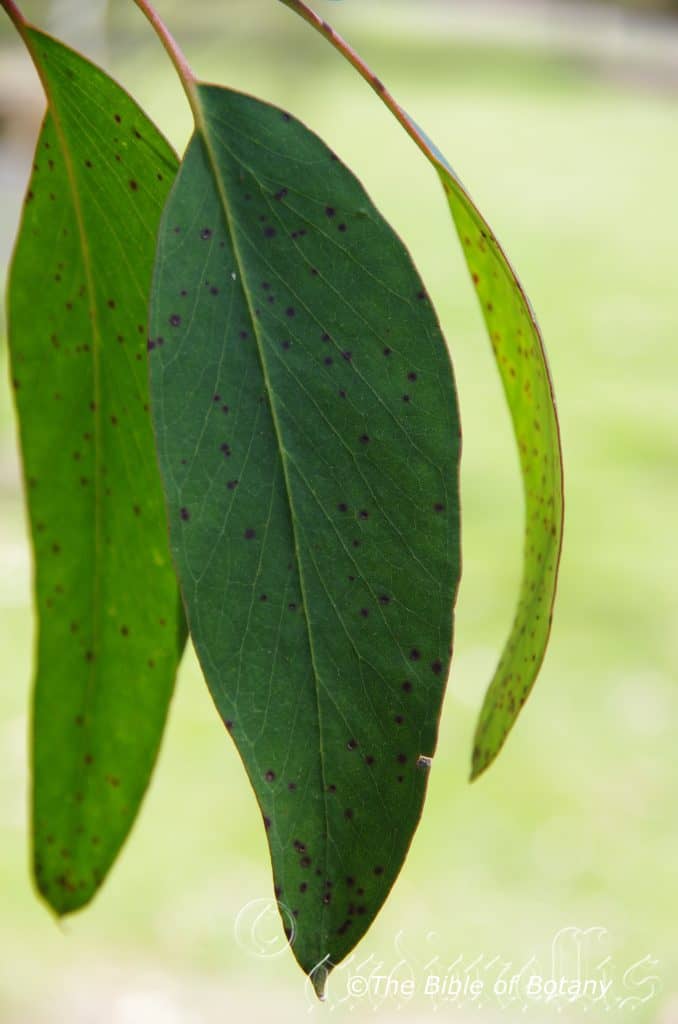
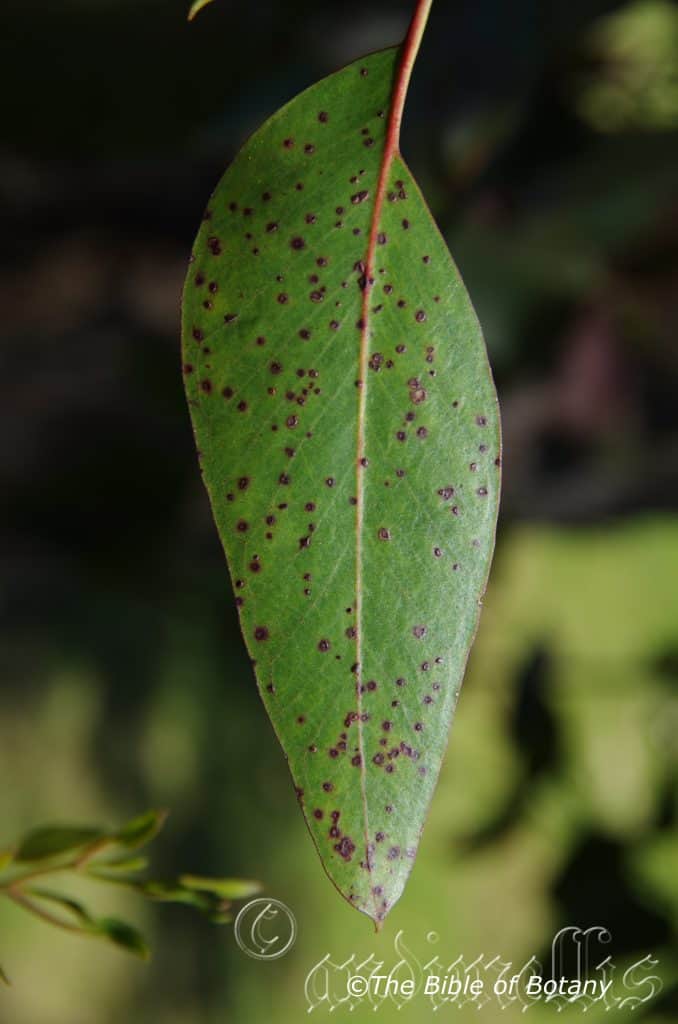

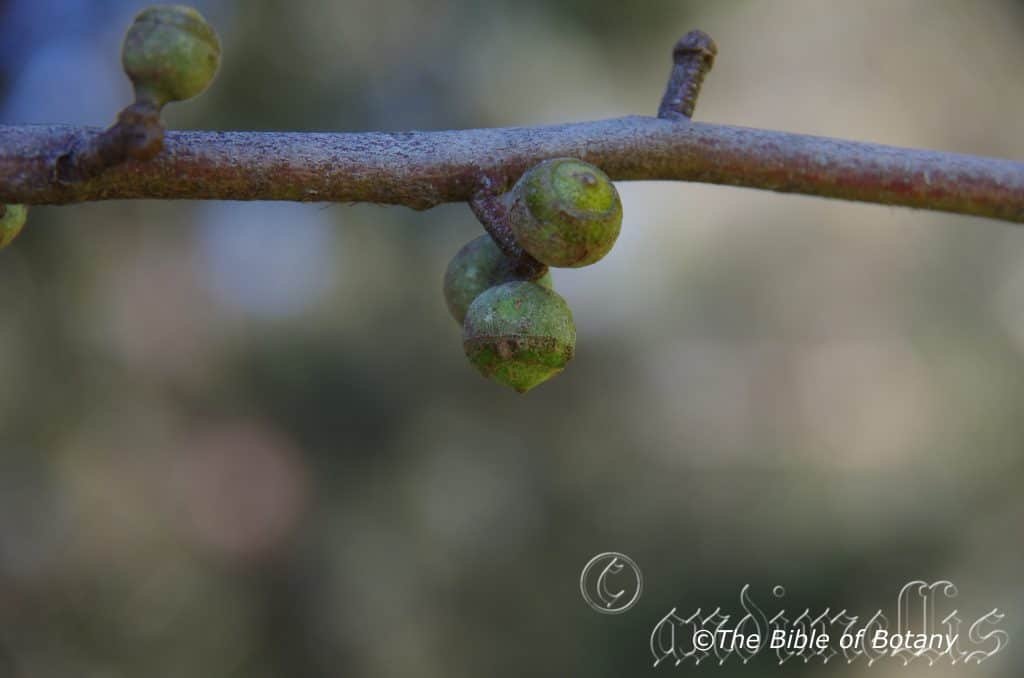
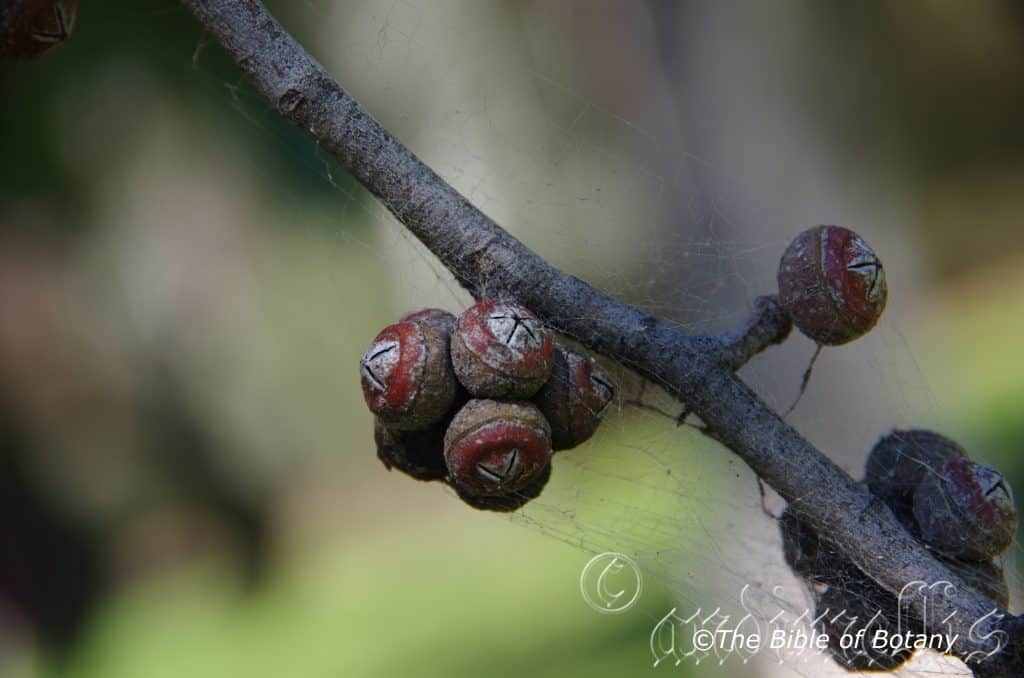

Eucalyptus baxteri
Classification:
Unranked: Eudicots
Clade: Rosids
Order: Myrtales
Family: Myrtaceae
Genus: From Eu, which is Greek a prefix for good or well and Kaluptos, which is Ancient Greek for to cover up. It refers to the stamens, which have a lid or cover over them in the bud stage prior to opening.
Specie: Is named in honour of Named for William Baxter; 17..-1836 who was a British gardener and plant collector and the first person sent professionally to collect seeds in Western Australia for commercial purposes.
Sub specie:
Common Name: Baxter’s Gum.
Distribution:
Eucalyptus baxteri is found from Bermagui in the south eastern corner of New South Wales south to the Croajingolong National Park in north eastern Victoria then west to near Mt. Kitchener in the Barossa Range in southern South Australia. It is also found on Kangaroo Island.
https://avh.ala.org.au/occurrences/search?taxa=Eucalyptus+baxteri#tab_mapView
Habitat Aspect Climate:
Eucalyptus baxteri prefers full sun or partial shade. It grows in wet forest or moist woodlands in sheltered sloping sites. The altitude ranges from 100 meters ASL to 950 meters ASL.
The temperatures range from minus 5 degrees in August to 36 degrees in January.
The rainfall ranges from lows of 800mm to an average of 1200mm annually.
Soil Requirements:
Eucalyptus baxteri prefers average fertile loams to medium clays. The soils are usually derived from decomposed granites or meta-shales. The soils pH ranges from 4.5pH to 5.5pH. It does not tolerate water logged soils though soil moisture is consistent throughout the year.Non saline soils to moderately saline soils are tolerated as are salt laden winds.
Height & Spread:
Wild Plants: 30m to 40m by 10m to 15m.
Characteristics:
Eucalyptus baxteri is a large single trunk tree. The persistent bark is stringy, grey-brown, and brown to red-brown.
Eucalyptus baxteri’s juvenile and coppice stems are terete. The disjunct leaves are broad lanceolate. The concolourous laminas are glossy green and covered in reddish hispid hairs.
The alternate, disjunct, oblique adult leaves are lanceolate to broad lanceolate and measure 65mm to 130mm in length by 15mm to 30mm in width. The terete petioles measure 6mm to 13mm in length. The bases are broad tapering and narrow tapering while the apexes are broad acute to bluntly acute. The concolourous laminas are mid glossy green and glabrous. The margins are entire while the mid vein is prominent on the lower lamina especially on the basal half. The lateral veins are clearly visible on the lower lamina and are faintly visible from the upper lamina.
The inflorescences of Eucalyptus baxteriare born as umbellasters along the stems. There are 7 to 11 individual white to cream flowers to an umbellaster. The peduncles are terete or angular and glabrous. The peduncles measure 3mm to 14mm in length while the pedicels are sessile to 4mm in length. The oblong-clavate to clavate buds measure 5mm to 8mm by 4mm to 5mm in diameter. The calyptras are hemispherical, shorter than and as wide as hypanthium. It is finely lepidote. A bud scar is absent.
The white to cream stamens measure 6mm to 9mm in length. The white to cream, orbicular to ovate, basifixed anthers, dehisce and are versatile. The white style measures 4mm to 6mm in length. The disc is yellowish-green. The flowers appear from mid-August to January.
The fruits of Eucalyptus baxteriare hemispherical capsules known as gum nuts. The mid green gum nuts measure 6mm to 11mm in length by 8mm to 16mm in diameter at the widest point. The disc is flat or slightly raised with usually 4 or at times 5 which are level or slightly exserted valves.
Wildlife:
The flowers Eucalyptus baxteri are average nectar producers but are very attractive to most honeyeaters, lorikeets, possums and insects.
Cultivation:
Eucalyptus baxteri is a large gum tree which is very suitable for larger gardens where a Eucalyptus is required. It is ideal on better quality, cold loamy soils to medium clays on undulating to relatively steep slopes that are well drained. It is fast growing so gives a good effect at an early age. In the garden good specimens grow from 30 meters to 35 meters in height by 20 meters to 30 meters in diameter when grown in the open.
Like all Eucalyptus spp. leaf drop, dropping of small branches means continual lawn maintenance but then this means good quantities of leaf litter mulch.
Eucalyptus baxteri can give quick protection, habitat and safe corridors for many small birds. It makes a good base tree for wind break or shelter trees on farms and sheep stations. It looks particularly good when mixed with other Eucalyptus with varying types of bark.
Propagation:
Seeds: Sow into a seed raising mix. Cover the seeds with 2mm to 3mm of fine sand and place the trays in a warm sunny position. Keep the seeds moist but not wet. When the seedlings are 25mm to 50mm tall, prick them out and plant them into 50mm native tubes using a good organic mix.
Once the seedlings reach 200mm to 250mm in height plant them out into their permanent position. Mass plantings are best done in groups of 3 to 5 as a feature by planting them at 10 meter to 15 meter centers.
Fertilize using Seaweed, fish emulsion or organic chicken pellets soaked in water and apply the liquid on an alternate basis. Fertilize every two month until the trees are well established then every spring to ensure good growth and flowering.
Further Comments from Readers:
“Hi reader, it seems you use The Bible of Botany a lot. That’s great as we have great pleasure in bringing it to you! It’s a little awkward for us to ask, but our first aim is to purchase land approximately 1,600 hectares to link several parcels of N.P. into one at The Pinnacles NSW Australia, but we need your help. We’re not salespeople. We’re amateur botanists who have dedicated over 30 years to saving the environment in a practical way. We depend on donations to reach our goal. If you donate just $5, the price of your coffee this Sunday, We can help to keep the planet alive in a real way and continue to bring you regular updates and features on Australian plants all in one Botanical Bible. Any support is greatly appreciated. Thank you.”
In the spirit of reconciliation we acknowledge the Bundjalung, Gumbaynggirr and Yaegl and all aboriginal nations throughout Australia and their connections to land, sea and community. We pay our respect to their Elders past, present and future for the pleasures we have gained.

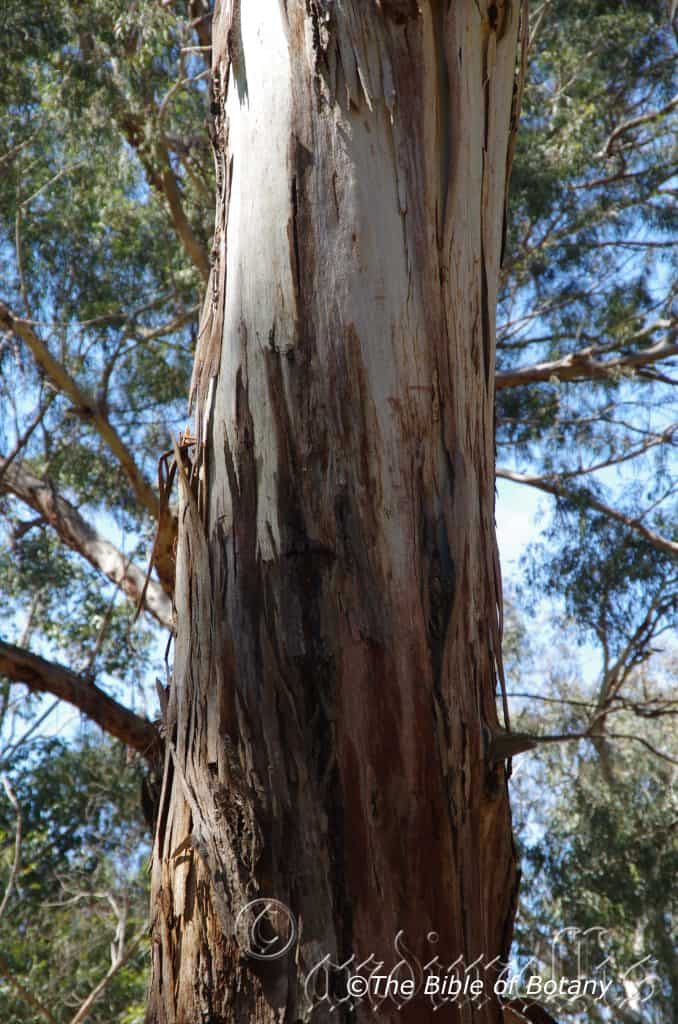
Eucalyptus benthamii
Classification:
Unranked: Eudicots
Clade: Rosids
Order: Myrtales
Family: Myrtaceae
Genus: From Eu, which is Greek a prefix for good or well and Kaluptos, which is Ancient Greek for to cover up. It refers to the stamens, which have a lid or cover over them in the bud stage prior to opening.
Specie: Is named in honour of George Bentham; 1800-1884, who was an English botanist who undertook the reclassification of seed plants into families.
Sub specie:
Common Name: Camden White Gum or Durrum by Ang (Local Aboriginal name for the tree).
Distribution:
Eucalyptus benthamii is a rare tree but locally common in a restricted area in the lower Nepean catchment area in central, coastal New South Wales.
https://avh.ala.org.au/occurrences/search?taxa=Eucalyptus+benthamii#tab_mapView
Habitat Aspect Climate:
Eucalyptus benthamii prefers full sun or partial shade. It grows along the valley floors in moist mixed forests. The altitude ranges from 70 meters ASL to 160 meters ASL.
The temperatures range from minus 1 degree in August to 38 degrees in January.
The rainfall ranges from lows of 1000mm to an average of 1600mm annually.
Soil Requirements:
Eucalyptus benthamii prefers average fertile sands to medium silts. The soils are usually derived from decomposed sandstones deposited as alluviums. The soils pH ranges from 4.5pH to 5.5pH. It does not tolerate water logged soils though soil moisture is consistent throughout the year.Non saline soils to moderately saline soils are tolerated.
Height & Spread:
Wild Plants:30m to 40m by 10m to 15m.
Characteristics:
Eucalyptus benthamii is a large single trunk tree. The persistent bark is smooth and white. The bark sheds in short ribbons and flakes often being entangled in the forks of the branches. The youngest branchlets are deep orange.
Eucalyptus benthamii’s juvenile and coppice stems are terete. The disjunct decussate leaves are broad elliptical to oblong-ovate. The concolourous laminas are dull grey-green to glaucous. The new growth is brilliant reddish purple.
The alternate, disjunct, semi falcate, lanceolate to broad lanceolate leaves measure 80mm to 120mm in length by 15mm to 22mm in width. The terete petioles measure 10mm to 20mm in length. The bases are tapering to the petiole while the apexes are narrowly acute. The concolourous laminas are mid dull olive-green and glabrous. The margins are entire while the mid vein is prominent on the lower lamina especially on the basal half. The lateral veins are clearly visible on the lower lamina and are faintly visible from the upper lamina.
The inflorescences of Eucalyptus benthamiiare born as umbellasters along the stems. There are 7 individual white to cream flowers to an umbellaster. The peduncles are terete, glabrous and measure 5mm to 6mm in length while the pedicels are sessile to 2mm in length. The ovoid to clavate buds are glabrous or at times glaucous and measure 3mm to 5mm by 2mm to 3.5mm in diameter. The hemispherical calyptras are shorter than and narrower than or as wide as the hypanthium. While a bud scar is present the calyptra does not shed cleanly.
The white to cream stamens measure 3mm to 5mm in length. The white to cream, orbicular to ovate, basifixed anthers, dehisce and are versatile. The white style measures 2mm to 4mm in length. The disc is yellowish-green. The flowers appear from mid-March to May.
The fruits of Eucalyptus benthamii are campanulate capsules known as gum nuts. The mid green gum nuts measure 4mm to 5mm in length by 4mm to 5mm in diameter at the widest point. The disc is flat or slightly raised with the 4 valves being level or slightly exserted.
Wildlife:
The flowers Eucalyptus benthamii are average nectar producers but are very attractive to most honeyeaters, lorikeets, possums, bats and many insects.
Cultivation:
Eucalyptus benthamii is a large gum tree which is very suitable for larger gardens where a Eucalyptus is required. It is ideal on better quality light silts to medium clays on undulating or flat surfaces. It is fast growing so gives a good effect at an early age. In the garden good specimens grow from 30 meters to 35 meters in height by 12 meters to 15 meters in diameter when grown in the open.
Like all Eucalyptus spp. leaf drop, dropping of small branches means continual lawn maintenance but then this means good quantities of leaf litter mulch.
Eucalyptus benthamii can give quick protection, habitat and safe corridors for many small birds. It makes a good timber plantation timber. It looks particularly good when mixed with other Eucalyptus with varying types of bark.
Propagation:
Seeds: Sow into a seed raising mix. Cover the seeds with 2mm to 3mm of fine sand and place the trays in a warm sunny position. Keep the seeds moist but not wet. When the seedlings are 25mm to 50mm tall, prick them out and plant them into 50mm native tubes using a good organic mix.
Once the seedlings reach 200mm to 250mm in height plant them out into their permanent position. Mass plantings are best done in groups of 3 to 5 as a feature by planting them at 10 meter to 15 meter centers.
Fertilize using Seaweed, fish emulsion or organic chicken pellets soaked in water and apply the liquid on an alternate basis. Fertilize every two month until the trees are well established then every spring to ensure good growth and flowering.
Further Comments from Readers:
“Hi reader, it seems you use The Bible of Botany a lot. That’s great as we have great pleasure in bringing it to you! It’s a little awkward for us to ask, but our first aim is to purchase land approximately 1,600 hectares to link several parcels of N.P. into one at The Pinnacles NSW Australia, but we need your help. We’re not salespeople. We’re amateur botanists who have dedicated over 30 years to saving the environment in a practical way. We depend on donations to reach our goal. If you donate just $5, the price of your coffee this Sunday, We can help to keep the planet alive in a real way and continue to bring you regular updates and features on Australian plants all in one Botanical Bible. Any support is greatly appreciated. Thank you.”
In the spirit of reconciliation we acknowledge the Bundjalung, Gumbaynggirr and Yaegl and all aboriginal nations throughout Australia and their connections to land, sea and community. We pay our respect to their Elders past, present and future for the pleasures we have gained.
Eucalyptus biturbinata
Classification:
Unranked: Eudicots
Clade: Rosids
Order: Myrtales
Family: Myrtaceae
Genus: From Eu, which is Greek a prefix for good or well and Kaluptos, which is Ancient Greek for to cover up. It refers to the stamens, which have a lid or cover over them in the bud stage prior to opening.
Specie: From Bi/Bis which are Ancient Greek and later Latin for two and Turbinatus, which is Latin for a child’s toy – a top. It refers to calyptras which are shaped like a spinning top and looking the same at the base and apex when in bud from the side.
Sub specie:
Common Name: Grey Gum.
Distribution:
Eucalyptus biturbinata is found south from near the Queensland, New South Wales border to Gloucester in central coastal New South Wales.
It is mainly found on and east of the Great Dividing Range.
https://avh.ala.org.au/occurrences/search?taxa=Eucalyptus+biturbinata#tab_mapView
Habitat Aspect Climate:
Eucalyptus biturbinata prefers full sun. It grows in moist to dry schlerophyll forest on deeper soils of average fertility on flats to sloping sites. The altitude ranges from 30 meters ASL to 750 meters ASL.
The temperatures range from minus 2 degrees in August to 40 degrees in January.
The rainfall ranges from lows of 800mm to an average of 1900mm annually.
Soil Requirements:
Eucalyptus biturbinata prefers average to better quality sandy soils to medium clays. The soils are usually derived from granite, brown basalt or black basalt. The soils pH ranges from 5pH to 6pH. It does not tolerate water logged soils. Non saline soils to moderately saline soils are tolerated as are salt laden winds.
Height & Spread:
Wild Plants: 15m to 30m by 7m to 12m.
Characteristics:
Eucalyptus biturbinata has along straight bole with the first branches appearing at around 50mm to 60mm of the trees height on mature trees growing in the open. The smooth off white to pale grey or cream bark is patchy and often covered in the claw marks of Koalas, possums or goannas. The decorticating bark is shed in large plates or flakes.
Eucalyptus biturbinata’s juvenile and coppice stems are terete and glabrous. The disjunct leaves are narrow lanceolate and glossy deep green. The margins are entire. The petioles measure 5mm to 10mm in length. The leaves measure 40mm to 60mm in length by 18mm to 28mm in width. The bases are rounded while the apexes are obtuse.
The alternate, disjunct adult leaves are lanceolate and slightly falcate. They measure 80mm to 120mm in length by 15mm to 30mm in width. The terete petioles measure 12mm to 20mm in length. The bases are slightly oblique and rounded while the apexes are acuminate to long tapering. The discolourous laminas are deep green, glossy and glabrous on the upper laminas while the lower laminas are paler. The margins are entire while the mid-vein is prominent on the upper lamina and slightly prominent on the lower lamina. The lateral veins are penniveined and are about 45 degrees. The intramarginal veins are parallel and close to the margin. The oil glands are islands between the veins.
The inflorescences of Eucalyptus biturbinata are born as umbellasters from the leaf axils. There are 7 to 11 individual white to cream flowers to an umbellaster. The peduncles are slightly flattened to angular and glabrous while the pedicels are terete and glabrous. The peduncles measure 10mm to 25mm in length while the pedicels measure 3mm to 7mm in length. The hypanthium are pale yellow-green to deep creamy-yellow and glabrous. The pyriform to clavate hypanthium measure 5mm to 6.5mm by 5mm to 7mm in diameter. The calyptras are conical and straight and measure 4mm to 6.5mm in length. The bud scar is present.
The stamens are white to cream and measure 9mm to 12mm in length. The white to cream anthers are oblong. The white style measures 6mm to 13mm in length. The disc is pale green. The flowers appear from December to March.
The fruits of Eucalyptus biturbinata are flattened conical or campanulate capsules known as gum nuts. The finely pitted to smooth gum nuts measure 7mm to 9mm in length by 6mm to 9mm in diameter at the lip of the hypanthium. The disc is exserted with the 4 exserted valves.
The deep reddish-brown to deep brown almost black, flattened seeds are pyramidal to cuboidal and measure 0.7mm to 1.5mm in length while the trash is smaller. The hilum is terminally positioned while the surfaces are shallowly, broadly pitted.
Wildlife:
The flowers Eucalyptus biturbinataare average nectar producers and are very attractive to most honeyeaters, lorikeets and flying foxes with many insects. It is a favoured koala and possum food tree.
Cultivation:
Eucalyptus biturbinata is a medium gum tree which is very suitable for medium to large gardens where a Eucalyptus is required or a koala or possum food tree is wanted. It is ideal on average sandy soils to medium clays on undulating slopes with skeletal soils that are well drained. It is fast growing so give good effects at an early age. In the garden good specimens grow from 15 meters to 20 meters in height by 10 meters to 15 meters in diameter when grown in the open.
Like all Eucalyptus leaf drop, dropping of small branches means continual lawn maintenance but then this means good quantities of leaf litter mulch.
Eucalyptus biturbinata can give quick protection, habitat and safe corridors for many small birds and animals. They look particularly good when mixed with other Eucalyptus with varying types of bark.
Propagation:
Seeds: Sow into a seed raising mix. Cover the seeds with 2mm to 3mm of fine sand and place the trays in a warm sunny position. Keep the seeds moist but not wet in order to avoid damping off. When the seedlings are 25mm to 50mm tall, prick them out and plant them into 50mm native tubes using a good organic mix.
Once the seedlings reach 200mm to 250mm in height plant them out into their permanent position. Mass plantings are best done in groups of 3 to 5 as a feature by planting them at 10 meter to 15 meter centers.
Fertilize using Seaweed, fish emulsion or organic chicken pellets soaked in water and apply the liquid on an alternate basis. Fertilize every two month until the trees are well established then every spring to ensure good growth and flowering.
Further Comments from Readers:
“Hi reader, it seems you use The Bible of Botany a lot. That’s great as we have great pleasure in bringing it to you! It’s a little awkward for us to ask, but our first aim is to purchase land approximately 1,600 hectares to link several parcels of N.P. into one at The Pinnacles NSW Australia, but we need your help. We’re not salespeople. We’re amateur botanists who have dedicated over 30 years to saving the environment in a practical way. We depend on donations to reach our goal. If you donate just $5, the price of your coffee this Sunday, We can help to keep the planet alive in a real way and continue to bring you regular updates and features on Australian plants all in one Botanical Bible. Any support is greatly appreciated. Thank you.”
In the spirit of reconciliation we acknowledge the Bundjalung, Gumbaynggirr and Yaegl and all aboriginal nations throughout Australia and their connections to land, sea and community. We pay our respect to their Elders past, present and future for the pleasures we have gained.





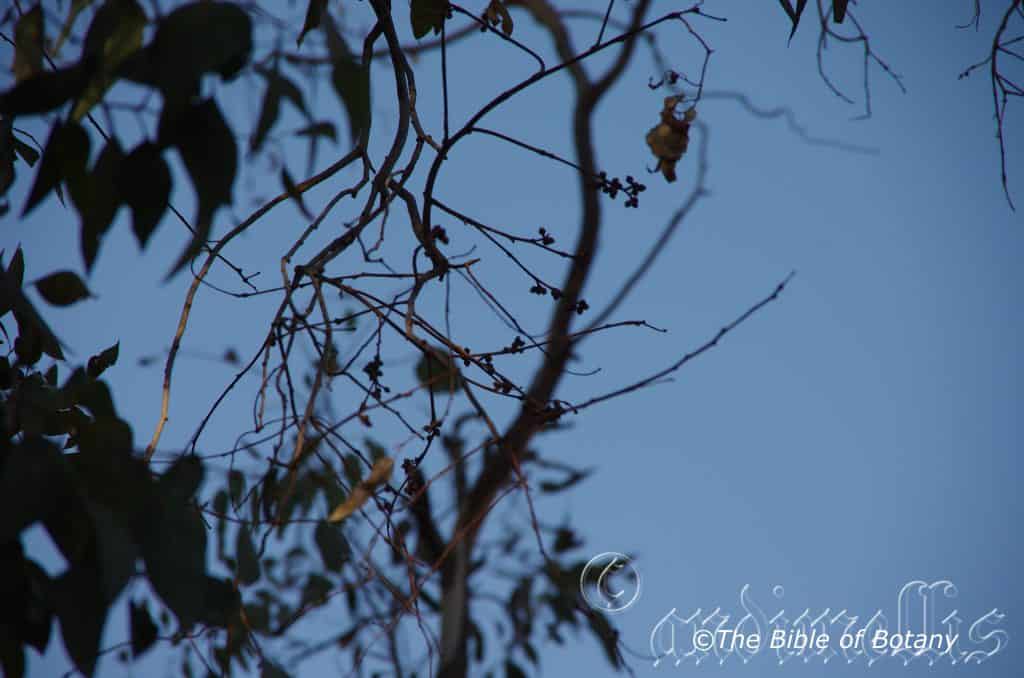
Eucalyptus blakeleyi
Classification:
Unranked: Eudicots
Clade: Rosids
Order: Myrtales
Family: Myrtaceae
Genus: From Eu, which is Greek a prefix for good or well and Kaluptos, which is Ancient Greek for to cover up. It refers to the stamens, which have a lid or cover over them in the bud stage prior to opening.
Specie: Is named in honour of William Faris Blakely; 1875–1941, who was an Australian, who was appointed to the staff of the Jenolans Caves and in 1900 transferred to the gardens staff at the Royal Botanic Gardens Sydney. In 1913 he joined the staff of the National Herbarium, initially as a botanical assistant but later as a botanist and remained in that position until his retirement in 1940. He was a co-worker in J.H.Maiden’s monumental revision of the genus Eucalyptus and in 1934 published A Key to the Eucalypts.
Sub specie:
Common Name:
Distribution:
Eucalyptus blakelyi is found south from Millmerran in south east Queensland to the Grampians in southern western Victoria. It is mainly found on the western slopes of The Great Dividing Range and on the range itself.
https://avh.ala.org.au/occurrences/search?taxa=Eucalyptus+blakelyi#tab_mapView
Habitat Aspect Climate:
Eucalyptus blakelyi prefers full sun or partial shade. It grows on slopes to ridge tops in moist or dry schlerophyll forests. The altitude ranges from 150 meters ASL to 1600 meters ASL.
The temperatures range from minus 6 degree in August to 36 degrees in January.
The rainfall ranges from lows of 800mm to an average of 1500mm annually.
Soil Requirements:
Eucalyptus blakelyi prefers moderately fertile sands to medium clays. The soils are usually derived from decomposed sandstones or granites. The soils pH ranges from 4.5pH to 5.5pH. It does not tolerate water logged soils though soil moisture is consistent throughout the year.Non saline soils to moderately saline soils are tolerated.
Height & Spread:
Wild Plants: 15m to 25m by 7m to 9m.
Characteristics:
Eucalyptus blakelyi is a large single trunk tree. The bark is smooth pale grey, cream and white with patches of yellow, pink, brown or orange throughout except for the base, which has some loose rough, deep grey bark.
Eucalyptus blakelyi’s juvenile ovate, blue-green leaves are 40mm to 100mm in length by 33mm to 70mm in width. The terete petioles measure 10mm to 25mm in length. The concolourous laminas are glossy to dull, deep green to blue-green and glabrous and measure 60mm to 200mm in length by 7mm to 45mm in width. The bases taper to the petiole, while the apexes are broadly acute with an apiculate tip. The margins are entire while the mid-vein is slightly prominent on both laminas especially on the basal half. The lateral veins are greater than 45° to midrib, moderately to densely reticulate, with the intramarginal vein parallel to and well removed from entire margins. The oil glands are usually positioned between the venations
The inflorescences of Eucalyptus blakeleyi are born as umbellasters along the stems. There are 11 individual white to cream flowers to an umbellaster. The peduncles are terete or angular, glabrous and measure 7mm to 14mm in length while the pedicels are sessile. The obovoidal or clavate buds are glabrous and measure 5mm to 8mm by 3mm to 5mm in diameter. The hemispherical to obtuse-conical calyptra is as long and as wide as the hypanthium. A bud scar is absent.
The white to cream stamens measure 5mm to 8mm in length. The white to cream, orbicular to ovate, basifixed anthers, dehisce and are versatile. The white style measures 2mm to 3mm in length. The disc is yellowish-green. The flowers appear from October to December.
The peduncles measure 5mm to 20mm in length, while the buds 7 to 12, individual buds’ pedicels measure 1mm to 7mm in length. The narrowly ovoid to fusiform buds are green to creamy or at times glaucous and measure 8mm to 14mm in length by 3mm to 6mm in diameter. A scar is present below the conical to horn shaped operculum that measures 5mm to 11mm in length.
The erect, white stamens have cream, cuboidal to oblong, versatile, dorsifixed anthers, which dehisc along longitudinal slits.
The long, white style has a blunt stigma blunt. There are 3 or 4 locules.
The fruits of Eucalyptus blakeleyi are hemispherical or truncate-globose capsules known as gum nuts. The pedicels measure 1mm to 7mm in length. The pale green to yellow-green gum nuts measure 2mm to 5mm in length by 4mm to 8mm in diameter at the widest point. The disc is raised with the 3 or 4 strongly exserted valves.
The black, brown or grey, pyramidal or cuboidal with a pitted dorsal surface seeds measure 0.5mm to 1.5mm in length.
Wildlife:
The flowers Eucalyptus blakelyi are average nectar producers but are still very attractive to most honeyeaters and lorikeets.
Cultivation:
Eucalyptus blakelyi is a large gum tree which is very suitable for larger gardens where a Eucalyptus is required. It is ideal on better quality light silts to medium clays on undulating or flat surfaces. It is fast growing so gives a good effect at an early age. In the garden good specimens grow from 20 meters to 25 meters in height by 20 meters to 25 meters in diameter when grown in the open.
Like all Eucalyptus spp. leaf drop, dropping of small branches means continual lawn maintenance but then this means good quantities of leaf litter mulch.
Eucalyptus blakelyi can give quick protection, habitat and safe corridors for many small birds. It makes a good timber plantation timber. It is suitable for wind breaks and for shelter trees on pastures and sheep stations. It looks particularly good when mixed with other Eucalyptus with varying types of bark.
Propagation:
Seeds: Sow into a seed raising mix. Cover the seeds with 2mm to 3mm of fine sand and place the trays in a warm sunny position. Keep the seeds moist but not wet. When the seedlings are 25mm to 50mm tall, prick them out and plant them into 50mm native tubes using a good organic mix.
Once the seedlings reach 200mm to 250mm in height plant them out into their permanent position. Mass plantings are best done in groups of 3 to 5 as a feature by planting them at 10 meter to 15 meter centers.
Fertilize using Seaweed, fish emulsion or organic chicken pellets soaked in water and apply the liquid on an alternate basis. Fertilize every two month until the trees are well established then every spring to ensure good growth and flowering.
Further Comments from Readers:
“Hi reader, it seems you use The Bible of Botany a lot. That’s great as we have great pleasure in bringing it to you! It’s a little awkward for us to ask, but our first aim is to purchase land approximately 1,600 hectares to link several parcels of N.P. into one at The Pinnacles NSW Australia, but we need your help. We’re not salespeople. We’re amateur botanists who have dedicated over 30 years to saving the environment in a practical way. We depend on donations to reach our goal. If you donate just $5, the price of your coffee this Sunday, We can help to keep the planet alive in a real way and continue to bring you regular updates and features on Australian plants all in one Botanical Bible. Any support is greatly appreciated. Thank you.”
In the spirit of reconciliation we acknowledge the Bundjalung, Gumbaynggirr and Yaegl and all aboriginal nations throughout Australia and their connections to land, sea and community. We pay our respect to their Elders past, present and future for the pleasures we have gained.



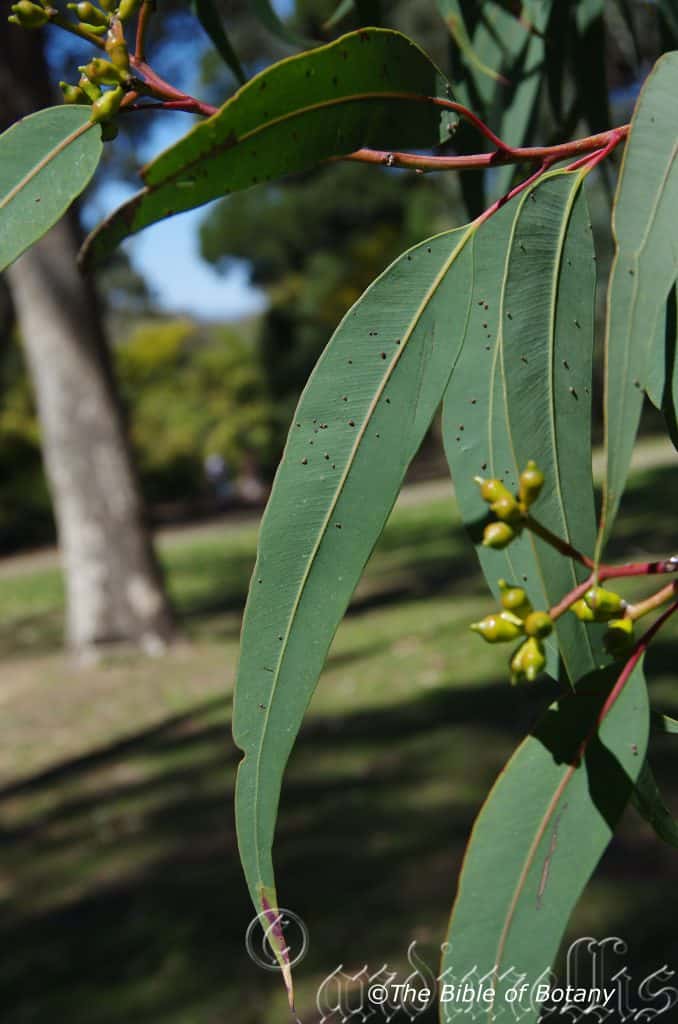
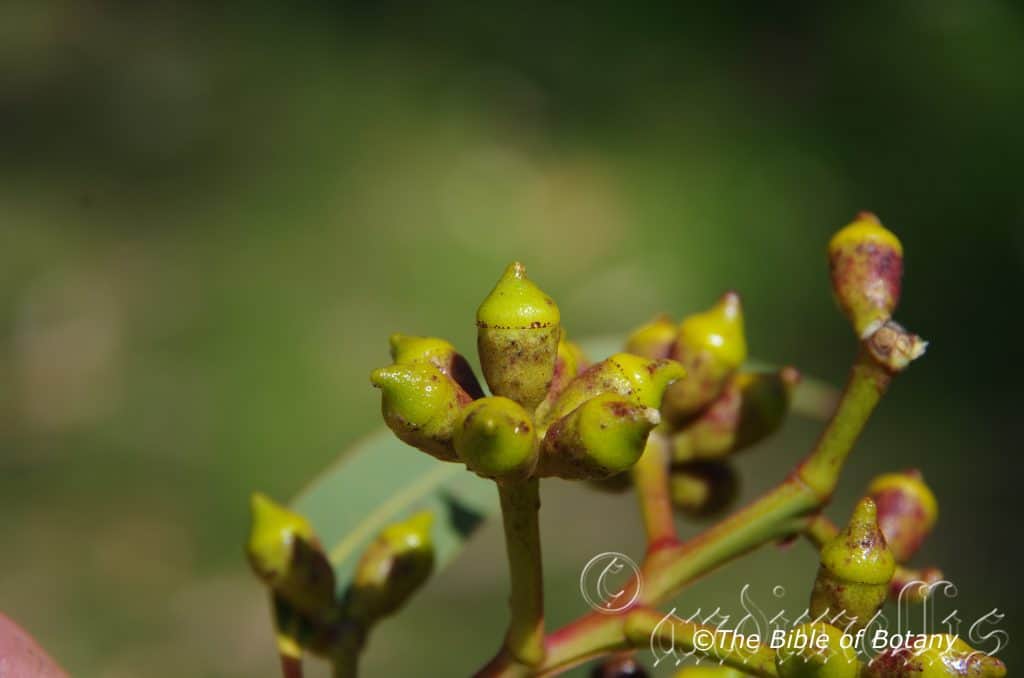

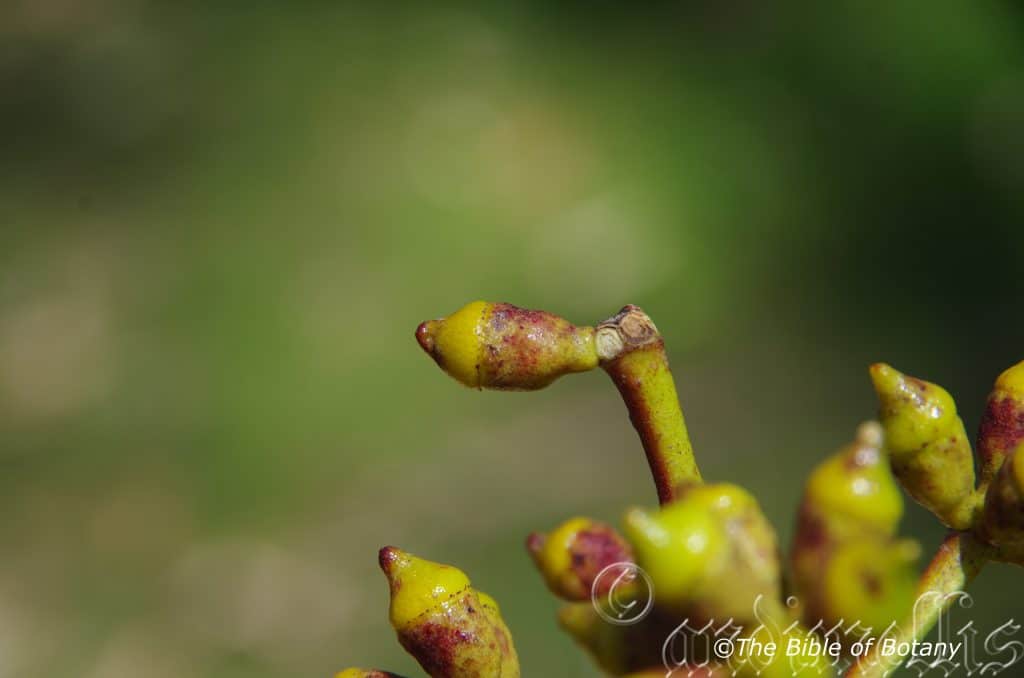
Eucalyptus blaxlandii
Classification:
Unranked: Eudicots
Clade: Rosids
Order: Myrtales
Family: Myrtaceae
Genus: From Eu, which is Greek a prefix for good or well and Kaluptos, which is Ancient Greek for to cover up. It refers to the stamens, which have a lid or cover over them in the bud stage prior to opening.
Specie: Is named in honour of Gregory Blaxland; 1778–1853, who was an English pioneer farmer and explorer in Australia who first found a successful dray route across the Blue Mountains.
Sub specie:
Common Name: Blaxland’s Stringybark.
Distribution:
Eucalyptus blaxlandii is found south from Cox’s Gap near Mount Kerrabee to Circus Peak in eastern New South Wales. There are two disjunct populations one near Mount Bajimba in north eastern New South Wales and the other on the coast on New South Wales Victorian border. It is mainly found on the western side of the Great Dividing Range in the north crossing to the eastern side in the south.
https://avh.ala.org.au/occurrences/search?taxa=Eucalyptus+blaxlandii#tab_mapView
Habitat Aspect Climate:
Eucalyptus blaxlandii prefers full sun or partial shade. It grows on slopes to ridge tops in moist or dry schlerophyll forests. The altitude ranges from 150 meters ASL to 1300 meters ASL.
The temperatures range from minus 6 degree in August to 36 degrees in January.
The rainfall ranges from lows of 800mm to an average of 1500mm annually.
Soil Requirements:
Eucalyptus blaxlandii prefers moderately fertile sands to medium clays. The soils are usually derived from decomposed sandstones or granites. The soils pH ranges from 4.5pH to 5.5pH. It does not tolerate water logged soils though soil moisture is consistent throughout the year.Non saline soils to moderately saline soils are tolerated.
Height & Spread:
Wild Plants: 20m to 30m by 9m to 12m.
Characteristics:
Eucalyptus blaxlandii is a large single trunk tree. The grey to red-brown, stringy bark is persistent on the trunk and larger branches or at times throughout. The smaller branches are grey smooth and shed in short ribbons. The youngest branchlets are deep maroon.
Eucalyptus blaxlandii’s juvenile and coppice stems are terete. The disjunct decussate leaves are broad elliptical to oblong-ovate. The concolourous laminas are glossy, deep green and moderately covered in reddish hispid hairs. The new growth is brilliant reddish purple.
The alternate, disjunct, semi falcate, broad lanceolate leaves are coriaceous and measure 70mm to 120mm in length by 15mm to 26mm in width. The terete petioles measure 10mm to 20mm in length. The strongly oblique bases taper on one side and are rounded on the other while the apexes are broad acute with an apiculate. The concolourous laminas are dull, deep green to deep sea-green and glabrous. The margins are entire while the mid-vein is prominent on both laminas especially on the basal half. The lateral veins are clearly visible on the laminas.
The inflorescences of Eucalyptus blaxlandiiare born as umbellasters along the stems. There are 11 individual white to cream flowers to an umbellaster. The peduncles are terete or angular, glabrous and measure 7mm to 14mm in length while the pedicels are sessile. The obovoidal or clavate buds are glabrous and measure 5mm to 8mm by 3mm to 5mm in diameter. The hemispherical to obtuse-conical calyptra is as long and as wide as the hypanthium. A bud scar is absent.
The white to cream stamens measure 5mm to 8mm in length. The white to cream, orbicular to ovate, basifixed anthers, dehisce and are versatile. The white style measures 2mm to 3mm in length. The disc is yellowish-green. The flowers appear from mid-March to May.
The fruits of Eucalyptus blaxlandii are depressed-globose capsules known as gum nuts. The pale green to yellow-green gum nuts measure 6mm to 8mm in length by 7mm to 13mm in diameter at the widest point. The disc is flat or slightly raised with the 4 or at times 5 valves being exserted.
Wildlife:
The flowers Eucalyptus blaxlandii are average nectar producers but are very attractive to most honeyeaters, lorikeets, possums, flying foxes and many insects.
Cultivation:
Eucalyptus blaxlandii is a large gum tree which is very suitable for larger gardens where a Eucalyptus is required. It is ideal on better quality light silts to medium clays on undulating or flat surfaces. It is fast growing so gives a good effect at an early age. In the garden good specimens grow from 20 meters to 25 meters in height by 20 meters to 25 meters in diameter when grown in the open.
Like all Eucalyptus spp. leaf drop, dropping of small branches means continual lawn maintenance but then this means good quantities of leaf litter mulch.
Eucalyptus blaxlandii can give quick protection, habitat and safe corridors for many small birds. It makes a good timber plantation timber. It is suitable for wind breaks and for shelter trees on pastures and sheep stations. It looks particularly good when mixed with other Eucalyptus with varying types of bark.
Propagation:
Seeds: Sow into a seed raising mix. Cover the seeds with 2mm to 3mm of fine sand and place the trays in a warm sunny position. Keep the seeds moist but not wet. When the seedlings are 25mm to 50mm tall, prick them out and plant them into 50mm native tubes using a good organic mix.
Once the seedlings reach 200mm to 250mm in height plant them out into their permanent position. Mass plantings are best done in groups of 3 to 5 as a feature by planting them at 10 meter to 15 meter centers.
Fertilize using Seaweed, fish emulsion or organic chicken pellets soaked in water and apply the liquid on an alternate basis. Fertilize every two month until the trees are well established then every spring to ensure good growth and flowering.
Further Comments from Readers:
“Hi reader, it seems you use The Bible of Botany a lot. That’s great as we have great pleasure in bringing it to you! It’s a little awkward for us to ask, but our first aim is to purchase land approximately 1,600 hectares to link several parcels of N.P. into one at The Pinnacles NSW Australia, but we need your help. We’re not salespeople. We’re amateur botanists who have dedicated over 30 years to saving the environment in a practical way. We depend on donations to reach our goal. If you donate just $5, the price of your coffee this Sunday, We can help to keep the planet alive in a real way and continue to bring you regular updates and features on Australian plants all in one Botanical Bible. Any support is greatly appreciated. Thank you.”
In the spirit of reconciliation we acknowledge the Bundjalung, Gumbaynggirr and Yaegl and all aboriginal nations throughout Australia and their connections to land, sea and community. We pay our respect to their Elders past, present and future for the pleasures we have gained.
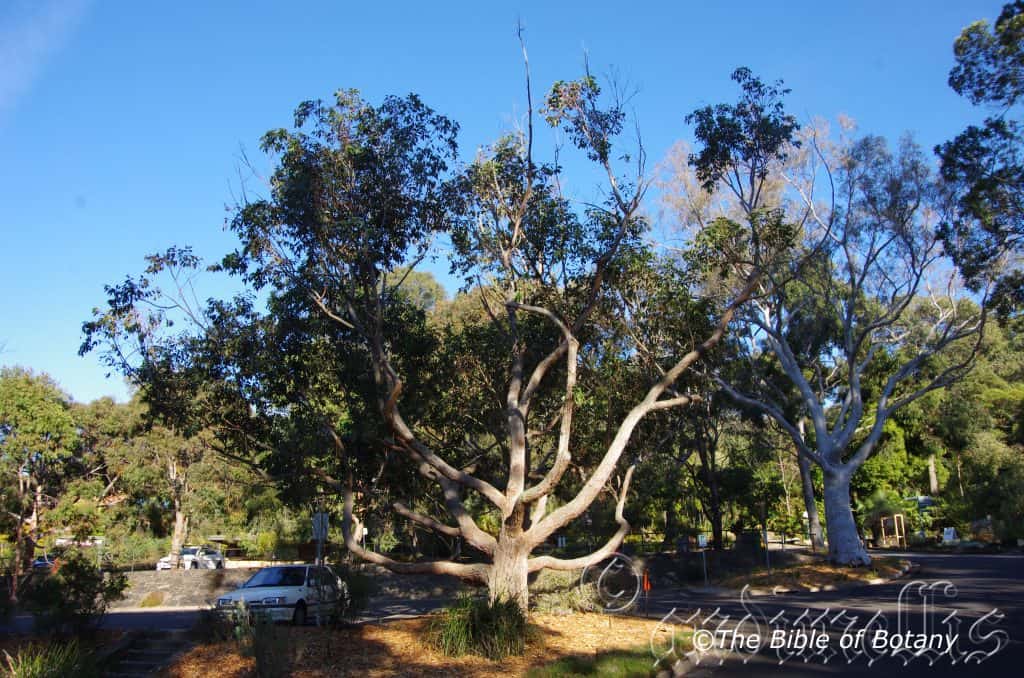
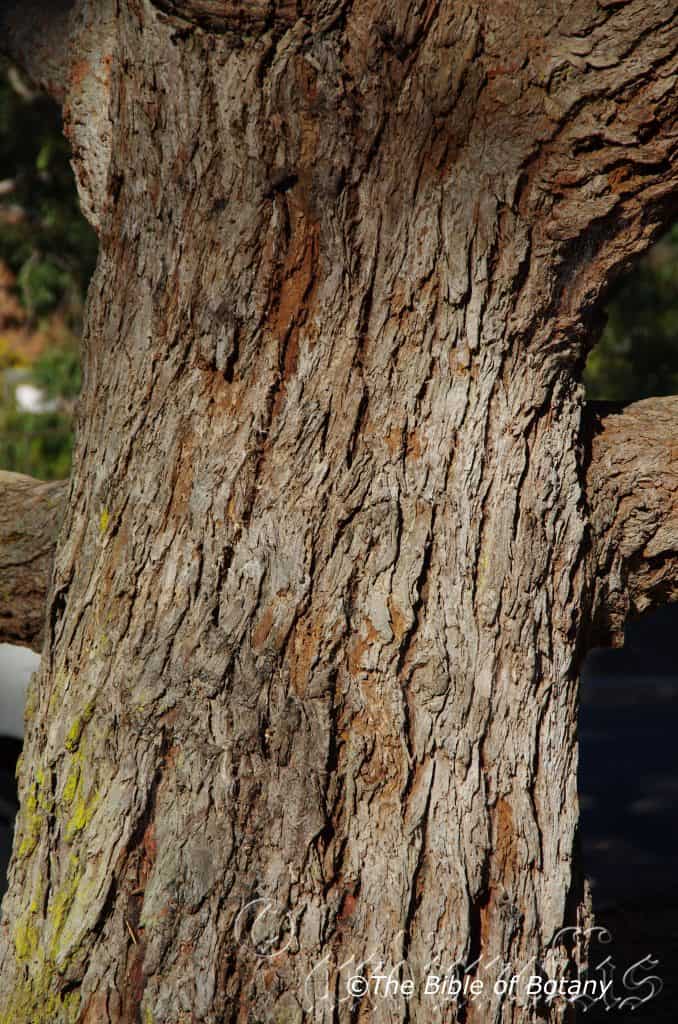
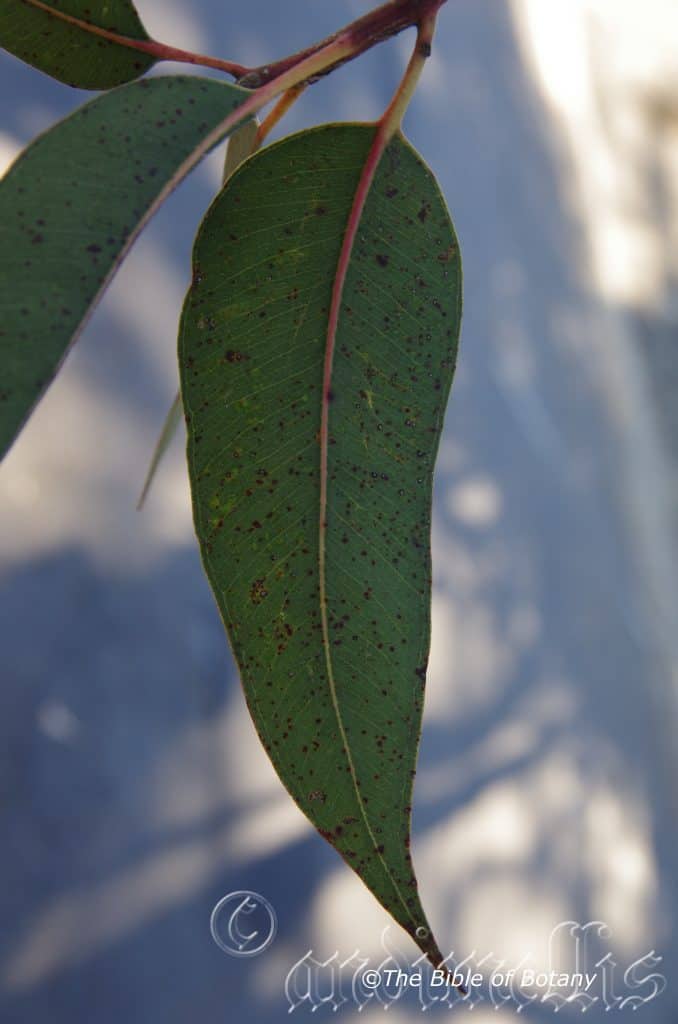
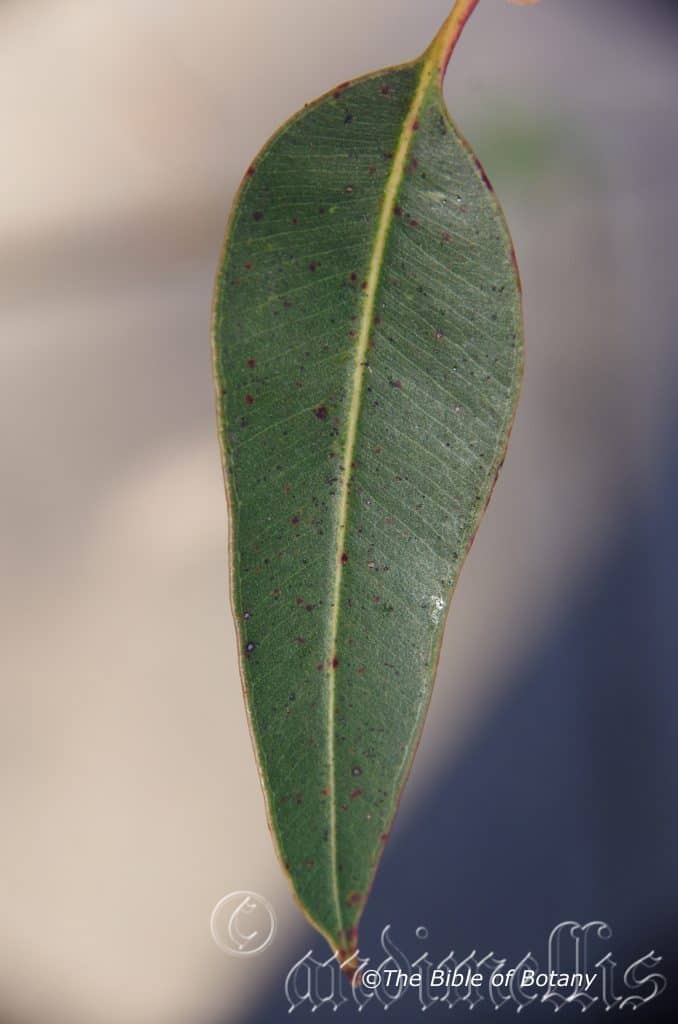
Eucalyptus botryoides
Classification:
Unranked: Eudicots
Clade: Rosids
Order: Myrtales
Family: Myrtaceae
Genus: From Eu, which is Greek a prefix for good or well and Kaluptos, which is Ancient Greek for to cover up. It refers to the stamens, which have a lid or cover over them in the bud stage prior to opening.
Specie: From Bótrus, which is Ancient Greek for a bunch of grapes and Eidḗs/oīdēs, which are Ancient Greek for alike or similar to. It refers to fruits which resemble a bunch of grapes.
Sub specie:
Common Name:
Distribution:
Eucalyptus botryoides is found south from Sandgate in coastal southern Queensland along the coast east of the Great dividing Range to Mount Gambia in south eastern South Australia.
There are 2 dijunct populations in north and south Tasmania and Bibra Lake to Waroona and one in Kordabup nature Reserve in far south west Western Australia. The Western Australian plants are escapees and are definitely sleeper species on the verge of breaking out and becoming a major pest.
https://avh.ala.org.au/occurrences/search?taxa=Eucalyptus+botyroides#tab_mapView
Habitat Aspect Climate:
Eucalyptus botryoides prefers full sun to light dappled shade. It grows on flat plains and gentle slopes. The altitude ranges from 50 meters ASL to 850 meters ASL.
The temperatures range minus 6 degrees in July to 42 degrees in January.
The rainfall ranges from lows of 700mm to an average of 1250mm annually.
Soil Requirements:
Eucalyptus botryoides prefer to grow on fine or course sand to sandy loams, which are moisture retentive. The soils are derived from decomposed sandstone, granite or accumulated peaty sands. The soils pH ranges from 5pH to 6pH. It does not tolerate water logged soils. Non saline soils to moderately saline soils are tolerated.
Height & Spread:
Wild Plants: 25m to 40m by 4m to 12m.
Characteristics:
Eucalyptus botryoides is a long trunked tree with a bole to over half its height. The Bark is rough, thick, grey or brown, elongated, fibrous, strips on the lower trunk and larger limbs and smooth, predominantly white, cream, or pale fawn on the upper smaller limbs.
Eucalyptus botryoides’s terete or square in cross-section stems are pinkish-red to deep maroon and glabrous. The juvenile subsessile, discolorous, opposite for a few pairs then becoming alternate are ovate becoming lanceolate and measure 65mm to 115mm in length by 24mm to 58mm in width. The alternate mature leaves’ petiole measure 15mm to 35mm in length. The broadly lanceolate to falcate leaves are discolorous being glossy, deep green on the upper lamina and much paler on the lower lamina and measure 100mm to 220mm in length by 20mm to 70mm in width. The bases taper to the petiole, while the apexes are narrow acute to long acute. The mid vein is prominent on both laminas, more so on the lower lamina and strongly penniveined, densely to very densely reticulate, with the intramarginal vein parallel to and just within margin to well removed from it. The oil glands intersectional or obscure.
Inflorescences of Eucalyptus botryoides are born as umbellasters containing 7, or 11 individual flowers from near the terminal leaf axils. The peduncules measure 8mm to 12mm in length while flower buds are sessile. The mature oblong to ovoid buds are green to yellow, smooth and measure 7mm to 14mm in length by 4mm to 6mm in diameter.
The hypanthium is usually slightly angled, scar present, while the conical to obtuse operculum splits to reveal the inflexed or irregularly flexed, creamy-white stamens measure 6mm to 8mm in length. The cuboid to oblong, versatile, dorsifixed cream anthers dehisce along longitudinal slits.
The creamy-white style long, blunt or tapered style measures 3mm to 4mm in length. There are 3 or 4 locules.
The sessile or subsessile, cylindrical to barrel shaped capsules measure 6mm to 13mm in length by 5mm to 9mm in diameter. The usually 3 or at times 4 valves are set near the rim and are level or enclosed.
The brown, pyramidal or cuboid, with weathered edged seeds measure 1mm to 2.2mm in length and are smooth or pitted.
Wildlife:
The flowers Eucalyptus botryoides is a medium nectar producer but is still very attractive to most honeyeaters and lorikeets, native bees and beetles.
Cultivation:
Eucalyptus botryoides is a large gum tree which is only suitable for large gardeners looking for a Eucalyptus to create a parkland scene in tropical and sub-tropical zones. It is ideal on sandy loams, sandy alluvial flats or heavier clays that are well drained or have seasonal water problems. It is fast growing so give good effects at an early age. In the garden good specimens grow from 8 meters to 10 meters in height by 5 meters to 6 meters in diameter with a bushy crown. It is drought resistant once established.
This tree will make a good substitute in smaller gardens for the common blackbutts.
Like all Eucalyptus leaf drop, dropping of small branches means continual lawn maintenance but then this means good quantities of leaf litter mulch.
Eucalyptus brassiana can be used like many small Eucalyptus spp. to create that little bit of Australiana in the back yard.Often floral characteristics of a plant dictate our selection of plants for the garden. Remember that once a Eucalyptus spp.; or in fact any tree, reaches a reasonable size, its trunk or bark can are the most prominent features seen. Among the Eucalypts there are many different types of barks which include some of our beautiful peppermint barks. Grouping, mallees as mallees or as single trunk trees can add immeasurably to the interest within a small space. Eucalyptus botryoides is one of those species whose multi stems and bark contrasts well with single stem species.
Small shrubs can be used to emphasize the open spaces surrounding a mallee or a small tree especially when mass plantings are done.
Eucalyptus botryoides can look great when placed in the corner against a fence to add privacy and remove the barrenness of the yard while giving extra depth.
Propagation:
Seeds: Sow Eucalyptus botryoides’s seed directly into a seed raising mix. Cover the seeds with 2 to 3mm of fine sand and place the trays in a warm sunny position. Keep moist but not wet to avoid damping off. When the seedlings are 25 to 50 mm tall, prick them out and plant them into 50mm native tubes using a good organic mix.
Once the seedlings reach 200 to 250mm in height plant them out into their permanent position. Mass plantings are best achieved planting them from 10 meters to 15 meters depending on the soil types.
Fertilize using seaweed, fish emulsion or organic chicken pellets soaked in water on an alternate basis. Fertilize every two months until the plants are established then twice annually in early September or March to maintain health, vitality and better flowering.
Further Comments from Readers:
“Hi reader, it seems you use The Bible of Botany a lot. That’s great as we have great pleasure in bringing it to you! It’s a little awkward for us to ask, but our first aim is to purchase land approximately 1,600 hectares to link several parcels of N.P. into one at The Pinnacles NSW Australia, but we need your help. We’re not salespeople. We’re amateur botanists who have dedicated over 30 years to saving the environment in a practical way. We depend on donations to reach our goal. If you donate just $5, the price of your coffee this Sunday, We can help to keep the planet alive in a real way and continue to bring you regular updates and features on Australian plants all in one Botanical Bible. Any support is greatly appreciated. Thank you.”
In the spirit of reconciliation we acknowledge the Bundjalung, Gumbaynggirr and Yaegl and all aboriginal nations throughout Australia and their connections to land, sea and community. We pay our respect to their Elders past, present and future for the pleasures we have gained.
Eucalyptus brassiana
Classification:
Unranked: Eudicots
Clade: Rosids
Order: Myrtales
Family: Myrtaceae
Genus: From Eu, which is Greek a prefix for good or well and Kaluptos, which is Ancient Greek for to cover up. It refers to the stamens, which have a lid or cover over them in the bud stage prior to opening.
Specie: Is named in honour of Leonard J. Brass; 1900-1971, who was an Australian botanical collector from New Guinee and northern Australian.
Sub specie:
Common Name: Cape York Ironbark.
Distribution:
Eucalyptus brassiana is found south from the Torres Straight Islands to the White Mountains National Park and west to Karumba on Cape York Peninsular.
https://avh.ala.org.au/occurrences/search?taxa=Eucalyptus+brassiana#tab_mapView
Habitat Aspect Climate:
Eucalyptus brassiana prefers full sun to light dappled shade. It grows on flat plains and gentle slopes. The altitude ranges from 50 meters ASL to 850 meters ASL.
The temperatures range 10 degrees in July to 40 degrees in January.
The rainfall ranges from lows of 1520mm to an average of 3200mm annually.
Soil Requirements:
Eucalyptus brassiana prefer to grow on sandy loams, sandy clays, and light gravelly clay loams to medium clays which are moisture retentive. The soils pH ranges from 5pH to 6pH. It does not tolerate water logged soils. Non saline soils to moderately saline soils are tolerated.
Height & Spread:
Wild Plants: 8m to 16m by 4m to 12m.
Characteristics:
Eucalyptus brassiana is a long trunked tree with a bole to over half its height. The grey to black bark is tessellated or fibrous and flaky on the lower 25mm of the trunk and is white to pale grey and glabrous on the remainder and larger branches. The bark is persistent on the upper section and decorticating on the lower section.
Eucalyptus brassiana’s juvenile leaves are opposite, sessile and dull grey-green. The orbicular to ovate leaves measure 40mm to 60mm in length by 30mm to 40mm in width.
The alternate, disjunct adult leaves are lanceolate to narrow lanceolate and falcate. They measure 80mm to 130mm in length and 13mm to 26mm in width. The petioles are slightly flattened or channelled and measure 8mm to 12mm in length. The bases are broad cuneate to cuneate-round and slightly oblique while the apexes are narrow acuminate to long tapering. The concolourous leaves are thin, dull, and pale blue-green. The margins are entire with the mid vein being slightly prominent on the lower lamina. The lateral veins are penniveined and are 35 degrees.
Inflorescences of Eucalyptus brassiana are born as umbellasters containing 3 to 7 flowers from near the terminal leaf axils. The peduncules measure 8mm to 12mm in length while terete or angular pedicels measure 4mm to 6mm with a thin swelling of 3mm near the peduncles.
The buds are ovoid-fusiforme with a conical calyptra, which is pale green tinged yellow and semi glossy. They measure 9mm to 13mm in length by 5mm to 7mm in diameter. The bud scar is not visible. The conical calyptra measures 5mm to 9mm long.
The white to cream stamens have white to creamy white anthers and measure 5mm to 8mm long while the pale creamy green style measures 5mm to 8mm in length. The flowers appear in mid-August to January.
The fruits ofEucalyptus brassiana are globose to ovoid capsules known as gum nuts. The gum nuts measure 3mm to 5mm in length by 3mm to 5mm in diameter at the hypanthia. The valves and discs are exerted revealing the 4 valves. The flattened seeds are linear cuboid and are distinctly darker than the chaff.
Wildlife:
The flowers Eucalyptus brassiana are light nectar producers but are still are very attractive to most honeyeaters and lorikeets, native bees and beetles.
Cultivation:
Eucalyptus brassiana is a smaller gum tree which is very suitable for small gardeners looking for a Eucalyptus to create a small parkland scene in tropical and sub-tropical zones. It is ideal on sandy loams, sandy alluvial flats or heavier clays that are well drained. It is fast growing so give good effects at an early age. In the garden good specimens grow from 8 meters to 10 meters in height by 5 meters to 6 meters in diameter with a bushy crown. It is drought resistant once established.
This tree will make a good substitute in smaller gardens for the common blackbutts.
Like all Eucalyptus leaf drop, dropping of small branches means continual lawn maintenance but then this means good quantities of leaf litter mulch.
Eucalyptus brassiana can be used like many small Eucalyptus spp. to create that little bit of Australiana in the back yard.Often floral characteristics of a plant dictate our selection of plants for the garden. Remember that once a Eucalyptus spp.; or in fact any tree, reaches a reasonable size, its trunk or bark can are the most prominent features seen. Among the eucalypts there are many different types of barks which include some of our beautiful peppermint barks. Grouping, mallees as mallees or as single trunk trees can add immeasurably to the interest within a small space. Eucalyptus brassiana is one of those species whose multi stems and bark contrasts well with single stem species.
Small shrubs can be used to emphasize the open spaces surrounding a mallee or a small tree especially when mass plantings are done.
Eucalyptus brassiana can look great when placed in the corner against a fence to add privacy and remove the barrenness of the yard while giving extra depth.
Propagation:
Seeds: Sow Eucalyptus brassiana’s seed directly into a seed raising mix. Cover the seeds with 2 to 3mm of fine sand and place the trays in a warm sunny position. Keep moist but not wet to avoid damping off. When the seedlings are 25 to 50 mm tall, prick them out and plant them into 50mm native tubes using a good organic mix.
Once the seedlings reach 200 to 250mm in height plant them out into their permanent position. Mass plantings are best achieved planting them from 10 meters to 15 meters depending on the soil types.
Fertilize using seaweed, fish emulsion or organic chicken pellets soaked in water on an alternate basis. Fertilize every two months until the plants are established then twice annually in early September or March to maintain health, vitality and better flowering.
Further Comments from Readers:
“Hi reader, it seems you use The Bible of Botany a lot. That’s great as we have great pleasure in bringing it to you! It’s a little awkward for us to ask, but our first aim is to purchase land approximately 1,600 hectares to link several parcels of N.P. into one at The Pinnacles NSW Australia, but we need your help. We’re not salespeople. We’re amateur botanists who have dedicated over 30 years to saving the environment in a practical way. We depend on donations to reach our goal. If you donate just $5, the price of your coffee this Sunday, We can help to keep the planet alive in a real way and continue to bring you regular updates and features on Australian plants all in one Botanical Bible. Any support is greatly appreciated. Thank you.”
In the spirit of reconciliation we acknowledge the Bundjalung, Gumbaynggirr and Yaegl and all aboriginal nations throughout Australia and their connections to land, sea and community. We pay our respect to their Elders past, present and future for the pleasures we have gained.


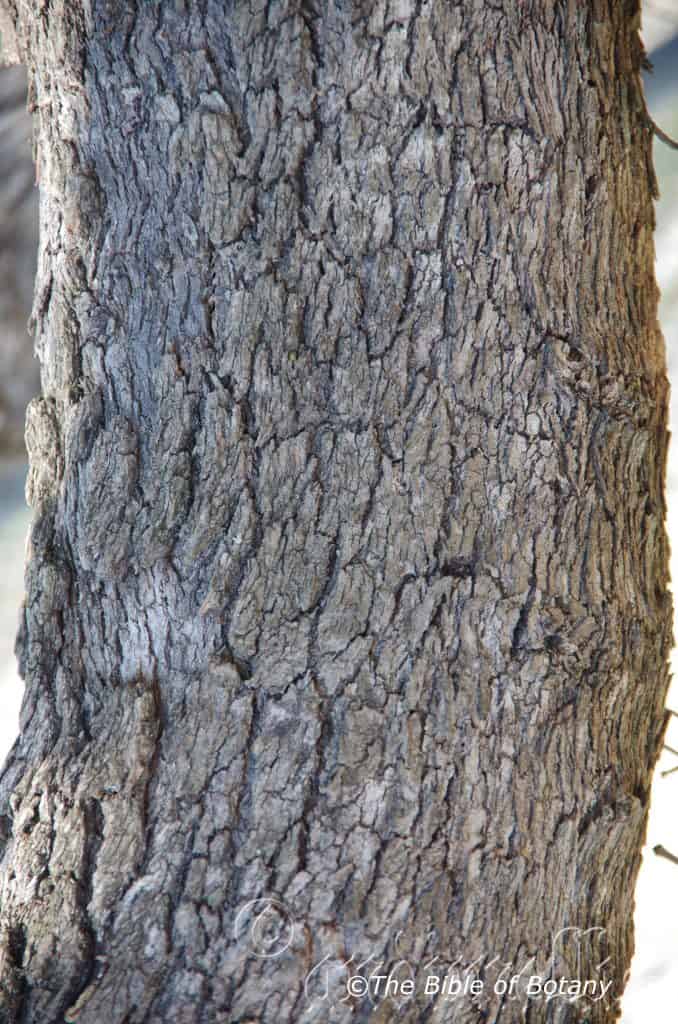
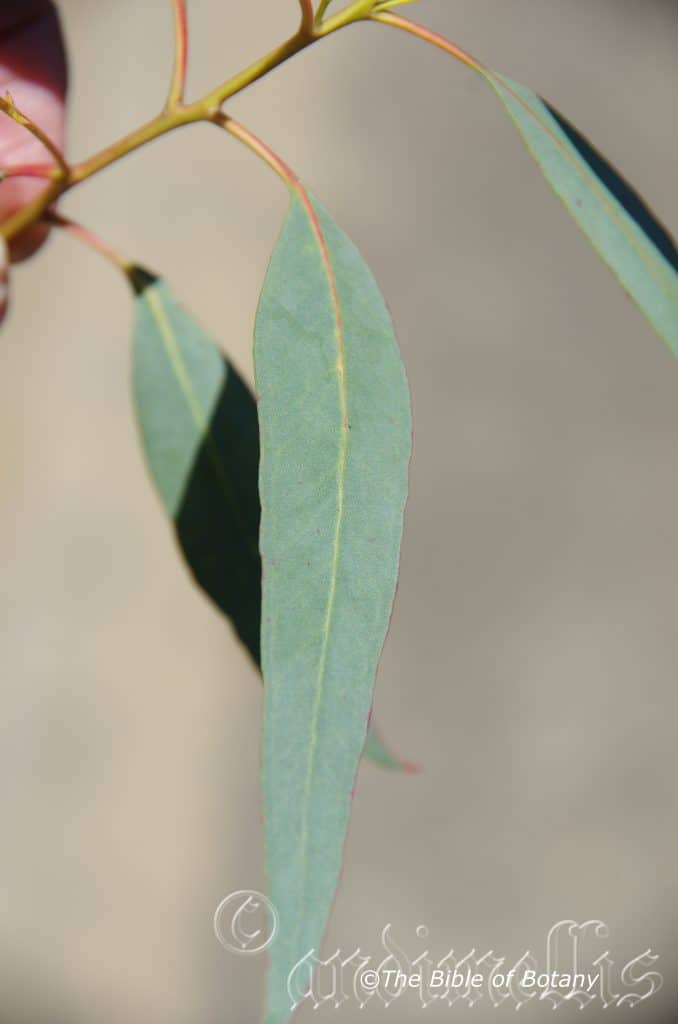
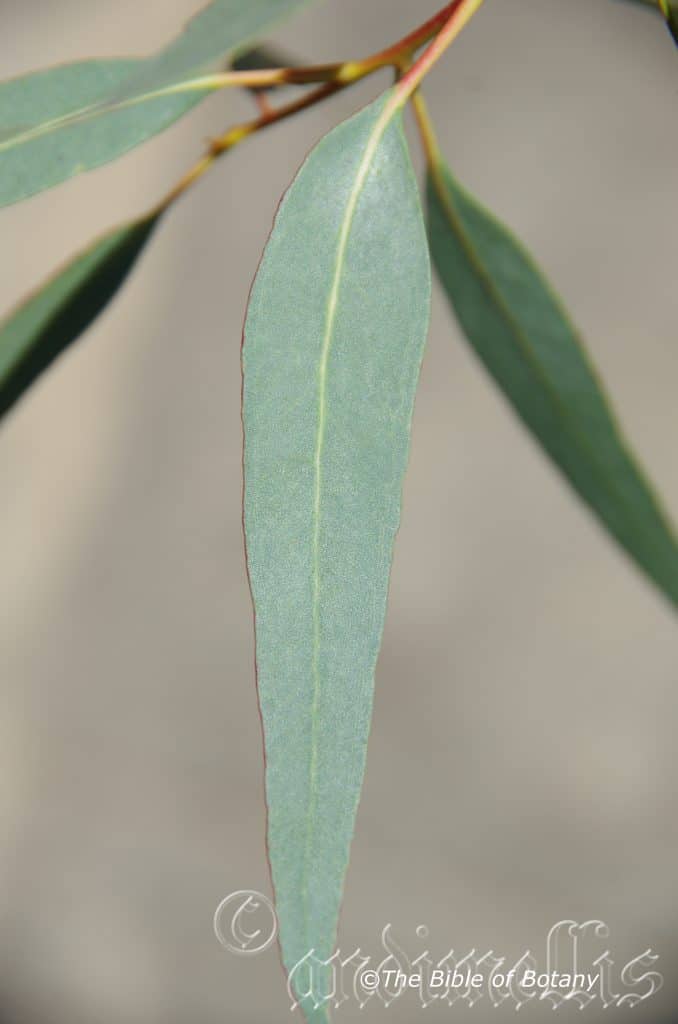
Eucalyptus bridgesiana
Classification:
Unranked: Eudicots
Clade: Rosids
Order: Myrtales
Family: Myrtaceae
Genus: From Eu, which is Greek a prefix for good or well and Kaluptos, which is Ancient Greek for to cover up. It refers to the stamens, which have a lid or cover over them in the bud stage prior to opening.
Specie: Is named in honour Frederick Bridges; 1840–1904, who was an education officer in New South Wales, with a career that spanned an important phase of development of education in New South Wales, which included the growth of a highly centralised system of educational administration under the control of a cabinet minister.
Sub specie:
Common Name: Apple Box.
Distribution:
Eucalyptus bridgesiana is found south from Swan Creek, east of Yangan township in south eastern Queensland to eastern Melbourne. It is mainly found on and east of the Great Dividing Range. There is an isolated population at Condamine in Queensland, and several disjunct populations including one near Stawell and Casterton in western Victoria. It is mainly found along the Great Dividing Range below the alpine regions.
https://avh.ala.org.au/occurrences/search?taxa=Eucalyptus+bridgesiana#tab_mapView
Habitat Aspect Climate:
Eucalyptus bridgesiana prefers full sun. It grows in drier schlerophyll forest usually on gentle slopes to steep mountainous slopes. The altitude ranges from 300 meters ASL to 1450 meters ASL.
The temperatures range from minus 5 degrees in August to 36degrees in January.
The rainfall ranges from lows of 500mm to an average of 1800mm annually.
Soil Requirements:
Eucalyptus bridgesiana prefer average to better quality sandy soils to medium clays. The soils are often deep alluviums. The soils are usually derived from granite, sandstone, brown basalt or black basalt. The soils pH ranges from 4.5pH to 6pH. It does not tolerate water logged soils.Non saline soils to moderately saline soils are tolerated.
Height & Spread:
Wild Plants: 10m to 25m by 7m to 15m.
Characteristics:
Eucalyptus bridgesiana has a short thick bole with the first branches appearing at around 30mm to 40mm of the trees height on mature trees. The persistent, grey with whitish patches bark is fibrous and flaky on the trunks to the larger branches. The smaller branches and branchlets are smooth and grey. The decorticating bark is shed in short ribbons.
Eucalyptus bridgesiana’s juvenile and coppice stems are terete and glabrous. The opposite leaves are orbicular to ovate and slowly become elongated and alternate. The concolourous laminas are glaucous blue. The margins are entire or crenulate. The petioles measure 0mm to 0.5mm in length. The bases are cordate. The leaves measure 30mm to 40mm in length by 35mm to 45mm in width.
The alternate, disjunct adult leaves are lanceolate and slightly falcate. They measure 120mm to 200mm in length by 15mm to 30mm in width. The terete petioles measure 16mm to 25mm in length. The bases are slightly asymmetrical to asymmetrical and cuneate while the apexes are bluntly narrowly acute to tapering. The concolourous laminas are mid green to mid-blue-green, semi glossy and glabrous. The margins are entire while the mid-vein is prominent on the upper lamina and slightly prominent on the lower lamina. The lateral veins are penniveined and are at about 60 degrees to the main vein. The intramarginal veins are parallel and close to the margin. The oil glands are islands between the veins.
The inflorescences of Eucalyptus bridgesiana are born as umbellasters from the leaf axils. There are 7 individual white to cream flowers to an umbellaster. The peduncles are terete to slightly angular and glabrous while the pedicels are terete and glabrous. The peduncles measure 7mm to 15mm in length while the pedicels measure 2mm to 5mm in length. The narrow oblong cupular hypanthium are pale yellow-green tinged orange and glabrous. The hypanthium measure 2.5mm to 4mm by 3mm to 4mm in diameter. The calyptras are conical with a small nipple or with or without a rostrate tip and measure 3.5mm to 5mm in length. The bud scar is absent.
The stamens are white to cream and measure 9mm to 12mm in length. The white to cream anthers are oblong. The white style measures 6mm to 13mm in length. The disc is pale green. The flowers appear from mid-August to October.
The fruits of Eucalyptus bridgesiana are usually cupular or at times conical capsules known as gum nuts. The finely pitted to smooth gum nuts measure 5mm to 7mm in length by 4mm to 7mm in diameter at the lip of the hypanthium. The disc is raised with the 3 exserted valves and 5 or 6 chambers.
The deep reddish-brown to deep brown almost black, flattened seeds are pyramidal to cuboidal and measure 0.7mm to 1.5mm in length while the trash is smaller.
Wildlife:
The flowers Eucalyptus bridgesiana is average to good nectar producers and is very attractive to most honeyeaters, lorikeets, flying foxes, possums and many insects.
Cultivation:
Eucalyptus bridgesiana is a medium gum tree which is very suitable for medium to large gardens where a Eucalyptus is required. It is ideal on poorer fatty sandy loams, average sandy soils to medium clays on undulating slopes with skeletal soils that are well drained in semi-arid regions of Australia. It is fast growing so give good effects at an early age. In the garden good specimens will grow from 15 meters to 20 meters in height by 15 meters to 25 meters in diameter when grown in the open.
Like all Eucalyptus leaf drop, dropping of small branches means continual lawn maintenance but then this means good quantities of leaf litter mulch and protection of other more sensitive plants growing below.
Eucalyptus bridgesiana can give quick protection, habitat and safe corridors for many small birds and animals. They look particularly good in a park scene when mixed with other Eucalyptus with varying types of bark.
Propagation:
Seeds: Sow Eucalyptus bridgesiana seeds into a seed raising mix. Cover the seeds with 2mm to 3mm of fine sand and place the trays in a warm sunny position. Keep the seeds moist but not wet in order to avoid damping off. When the seedlings are 25mm to 50mm tall, prick them out and plant them into 50mm native tubes using a good organic mix.
Once the seedlings reach 200mm to 250mm in height plant them out into their permanent position. Mass plantings are best done in groups of 3 to 5 as a feature by planting them at 15 meter to 30 meter centers.
Fertilize using Seaweed, fish emulsion or organic chicken pellets soaked in water and apply the liquid on an alternate basis. Fertilize every two month until the trees are well established then every spring to ensure good growth and flowering.
Further Comments from Readers:
“Hi reader, it seems you use The Bible of Botany a lot. That’s great as we have great pleasure in bringing it to you! It’s a little awkward for us to ask, but our first aim is to purchase land approximately 1,600 hectares to link several parcels of N.P. into one at The Pinnacles NSW Australia, but we need your help. We’re not salespeople. We’re amateur botanists who have dedicated over 30 years to saving the environment in a practical way. We depend on donations to reach our goal. If you donate just $5, the price of your coffee this Sunday, We can help to keep the planet alive in a real way and continue to bring you regular updates and features on Australian plants all in one Botanical Bible. Any support is greatly appreciated. Thank you.”
In the spirit of reconciliation we acknowledge the Bundjalung, Gumbaynggirr and Yaegl and all aboriginal nations throughout Australia and their connections to land, sea and community. We pay our respect to their Elders past, present and future for the pleasures we have gained.
Eucalyptus brunnea
Classification:
Unranked: Eudicots
Clade: Rosids
Order: Myrtales
Family: Myrtaceae
Genus: From Eu, which is Greek a prefix for good or well and Kaluptos, which is Ancient Greek for to cover up. It refers to the stamens, which have a lid or cover over them in the bud stage prior to opening.
Specie: From Braun/Brunnea, which is Latin for brown. It refers to structures or organs which are covered in brown hairs and thus have a brownish appearance.
Sub specie:
Common Name:
Distribution:
Eucalyptus brunnea is found south from the Queensland, New South Wales border to Tyringham in northern coastal New South Wales. It is mainly found on the Great Dividing Range.
https://avh.ala.org.au/occurrences/search?taxa=Eucalyptus+brunnea#tab_mapView
Habitat Aspect Climate:
Eucalyptus brunnea prefers full sun. It grows in medium to tall moist sclerophyll forest to dry sclerophyll forest, usually on hills and sloping sites from 300 meters ASL to 850 meters ASL.
The temperatures range from minus 2 degrees in August to 40 degrees in January.
The rainfall ranges from lows of 800mm to an average of 1900mm annually.
Soil Requirements:
Eucalyptus brunnea prefers better quality sandy soils to medium clays. The soils are usually derived from granite, brown basalt or black basalt. The soils pH ranges from 5pH to 6pH. It does not tolerate water logged soils.Non saline soils to moderately saline soils are tolerated.
Height & Spread:
Wild Plants: 20m to 35m by 8m to 15m.
Characteristics:
Eucalyptus brunnea has a long thick bole which is wide spreading at the base with the first branches appearing at around 50mm of the trees height on mature trees. The bark is persistent in a short stocking at the base of the trunk and is pale grey, fawnish with off white patches and flaky to glabrous on the trunks to the branchlets. The smaller branches are smooth white, cream, pale grey or fawn, smooth and glabrous. The decorticating bark is shed in short ribbons or plates from the trunk and larger branches.
Eucalyptus brunnea’s juvenile and coppice stems are terete and glabrous. The disjunct leaves are ovate and slowly become elongated. The concolourous laminas are deep green and glabrous. The margins are entire. The petioles measure 0mm to 0.5mm in length. The bases are cordate. The leaves measure 20mm to 30mm in length by 20mm to 30mm in width.
The alternate, disjunct adult leaves are lanceolate to broad lanceolate. The oblique bases are cuneate and falcate while the apexes are tapering or at times with an acute tip. They measure 80mm to 140mm in length by 20mm to 35mm in width. The terete petioles measure 16mm to 25mm in length. The discolourous laminas are deep green dull and glabrous. The margins are entire while the mid-vein is prominent on the upper lamina and slightly prominent on the lower lamina. The lateral veins are greater than 45 degrees to the main vein and are penniveined. The intramarginal veins are parallel and close to the margin. The oil glands are islands between the veins.
The inflorescences of Eucalyptus brunnea are born as umbellasters from the leaf axils. There are 7 individual white to cream flowers to an umbellaster. The peduncles are narrowly flattened terete to angular and glabrous while the pedicels are terete and glabrous. The peduncles measure 7mm to 14mm in length while the pedicels measure 2mm to 5mm in length. The buds are pyriform or clavate while the narrow oblong or narrow cupular hypanthium are pale yellow-green tinged orange and glabrous. The hypanthium measure 3mm to 4.2mm by 3mm to 5mm in diameter. The calyptras are hemispherical with a small apiculate tip and measure 2.5mm to 4mm in length. The bud scar is present.
The stamens are white to cream and measure 9mm to 12mm in length. The white to cream anthers are oblong. The white style measures 6mm to 13mm in length. The disc is pale green. The flowers appear from mid-November to January
The fruits of Eucalyptus brunnea are usually cylindrical or at times slightly campanulate capsules known as gum nuts. The finely pitted to smooth gum nuts measure 5mm to 7mm in length by 4mm to 6mm in diameter at the lip of the hypanthium. The 1mm to 2mm disc is depressed with the 3 or 4 exserted valves being erect or bent to 60 degrees.
The deep reddish-brown to deep brown almost black, flattened seeds are pyramidal to cuboidal and measure 0.7mm to 1.5mm in length while the trash is smaller.
Wildlife:
The flowers Eucalyptus brunnea are average nectar producers and are very attractive to most honeyeaters, lorikeets, flying foxes, possums and many insects.
Cultivation:
Eucalyptus brunnea is a medium gum tree which is very suitable for larger gardens where a Eucalyptus is required. It is ideal on poorer fatty sandy loams, average sandy soils to medium clays on undulating slopes with skeletal soils that are well drained in semi-arid regions of Australia. It is fast growing so give good effects at an early age. In the garden trees will grow from 15 meters to 25 meters in height by 12 meters to 18 meters in diameter when grown in the open.
Like all Eucalyptus leaf drop, dropping of small branches means continual lawn maintenance but then this means good quantities of leaf litter mulch and protection of other more sensitive plants growing below.
Eucalyptus brunnea can give quick protection, habitat and safe corridors for many small birds and animals. They look particularly good in a park scene when mixed with other Eucalyptus with varying types of bark.
Propagation:
Seeds: Sow Eucalyptus brunneaseeds into a seed raising mix. Cover the seeds with 2mm to 3mm of fine sand and place the trays in a warm sunny position. Keep the seeds moist but not wet in order to avoid damping off. When the seedlings are 25mm to 50mm tall, prick them out and plant them into 50mm native tubes using a good organic mix.
Once the seedlings reach 200mm to 250mm in height plant them out into their permanent position. Mass plantings are best done in groups of 3 to 5 as a feature by planting them at 15 meter to 30 meter centers.
Fertilize using Seaweed, fish emulsion or organic chicken pellets soaked in water and apply the liquid on an alternate basis. Fertilize every two month until the trees are well established then every spring to ensure good growth and flowering.
Further Comments from Readers:
“Hi reader, it seems you use The Bible of Botany a lot. That’s great as we have great pleasure in bringing it to you! It’s a little awkward for us to ask, but our first aim is to purchase land approximately 1,600 hectares to link several parcels of N.P. into one at The Pinnacles NSW Australia, but we need your help. We’re not salespeople. We’re amateur botanists who have dedicated over 30 years to saving the environment in a practical way. We depend on donations to reach our goal. If you donate just $5, the price of your coffee this Sunday, We can help to keep the planet alive in a real way and continue to bring you regular updates and features on Australian plants all in one Botanical Bible. Any support is greatly appreciated. Thank you.”
In the spirit of reconciliation we acknowledge the Bundjalung, Gumbaynggirr and Yaegl and all aboriginal nations throughout Australia and their connections to land, sea and community. We pay our respect to their Elders past, present and future for the pleasures we have gained.
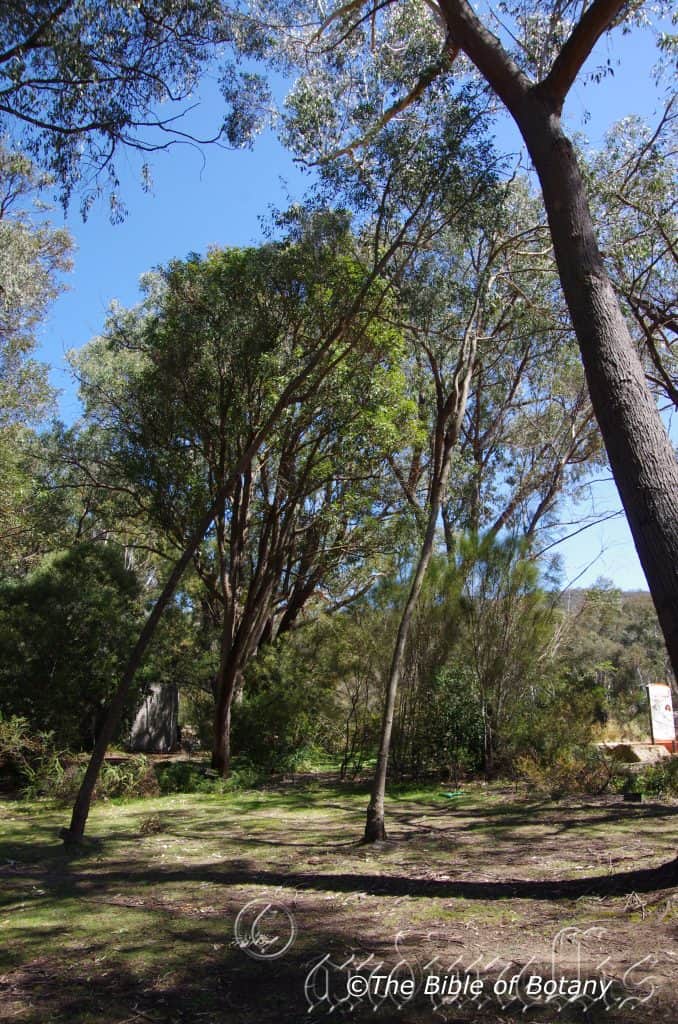



Eucalyptus cadens
Classification:
Unranked: Eudicots
Clade: Rosids
Order: Myrtales
Family: Myrtaceae
Genus: From Eu, which is Greek a prefix for good or well and Kaluptos, which is Ancient Greek for to cover up. It refers to the stamens, which have a lid or cover over them in the bud stage prior to opening.
Specie: From Cadens, which is Latin for falling down. It refers to plants, which appear to be falling over that is to have a strong leaning habit of growth.
Sub specie:
Common Name: Wangaratta Gum.
Distribution:
Eucalyptus cadens is restricted to two locations in Warby Range State Park and the Chilton Mount Pilot National Park in central northern Victorian.
https://avh.ala.org.au/occurrences/search?taxa=Eucalyptus+cadens#tab_mapView
Habitat Aspect Climate:
Eucalyptus cadens prefers full sun to light dappled shade. It grows in seasonally waterlogged situations that are permanently moist with perennial springs. It is found in conjunction with various Juncea sp. Baumea sp. and Carex sp. The altitude ranges from 200 meters ASL to 430 meters ASL.
The temperatures range from minus 3 degree in August to 35 degrees in January.
The mainly winter rainfall ranges from lows of 560mm to an average of 1400mm annually.
Soil Requirements:
Eucalyptus cadens prefers moderately fertile silts to medium clays. The soils are usually derived from decomposed sandstones or granites. The soils pH ranges from 4pH to 5pH. It tolerates seasonal water logged soils though soil moisture is consistent throughout the year.Non saline soils to moderately saline soils are tolerated.
Height & Spread:
Wild Plants: 10m to 25m by 10m to 20m.
Characteristics:
Eucalyptus cadens is a medium tree listed as vulnerable which has a single or more often is multi trunked. The rough, compact bark is present for the lower half of the trunk. The upper half of the trunk and larger branches are smooth and is decorticating in short to long ribbons. The smaller branches are green-grey and smooth. It develops a well formed lignotuber at the base of the trunk.
Eucalyptus cadens’s juvenile and coppice stems are terete and glaucous. The opposite disjunct, elliptic to ovate leaves measure 30mm to 55mm in length by 10mm to 20mm in width. The concolourous laminas are dull, greenish-grey and glaucous. The margins are entire to finely crenulate. The leaves are sessile.
The alternate, disjunct, narrow elliptic leaves measure 70mm to 150mm in length by 10mm to 20mm in width. The terete petioles measure 6mm to 12mm in length. The bases taper to the petiole while the apexes are bluntly acute. The concolourous laminas are dull, bluish-green and glabrous. The margins are entire to finely crenulate while the mid-vein is prominent on both laminas especially on the basal half. The lateral veins are barely visible on the laminas.
The inflorescences of Eucalyptus cadensare born as umbellasters along the stems. There are 7 individual white to cream flowers to an umbellaster. The peduncles are terete, glabrous and measure 4mm to 6mm in length while the pedicels are sessile to 1mm in length. The conical to fusiform buds are glabrous and measure 5mm to 8mm in length by 2.5mm to 3.5mm in diameter. The conical calyptra is as long and as wide as the hypanthium. A bud scar is absent.
The white stamens measure 3mm to 4mm in length. The white style measures 2mm to 3mm in length. The disc is yellowish-green. The flowers appear from mid-March to June.
The fruits of Eucalyptus cadens are broad urceolate capsules known as gum nuts. The pale green to yellow-green gum nuts measure 4mm to 5mm in length by 5mm to 6mm in diameter at the widest point. The disc is flat or slightly raised with the 3 or 4 valves being exserted.
Confusing Subspecies Varieties:
Eucalyptus cadens’s new growth is glaucous with the margins being entire to finely crenulate.
Eucalyptus aggregata’s new growth is glabrous with the margins being entire.
Wildlife:
The flowers Eucalyptus cadens are average nectar producers but are very attractive to most honeyeaters, lorikeets, flying foxes, possums and many insects.
Cultivation:
Eucalyptus cadens is a medium gum tree which is very suitable for larger gardens where a Eucalyptus is required if it wasn’t so particular in its needs. It is ideal on better quality light silts to medium clays on flat surfaces where drainage is a problem or soils have seasonal high water tables. It is fast growing so gives a great affect at an early age with its pronounced leanings. In the garden good specimens grow from 15 meters to 20 meters in height by 8 meters to 12 meters in diameter when grown in the open.
Like all Eucalyptus spp. leaf drop, dropping of small branches means continual lawn maintenance but then this means good quantities of leaf litter mulch.
Eucalyptus cadens can give quick protection, habitat and safe corridors for many small birds. It is suitable for wind breaks and for shelter trees on wet sandy pastures and sheep stations where soil compaction is not a problem. It looks particularly good when mixed with other Eucalyptus with varying types of bark.
Propagation:
Seeds: Sow into a seed raising mix. Cover the seeds with 2mm to 3mm of fine sand and place the trays in a warm sunny position. Keep the seeds moist but not wet. When the seedlings are 25mm to 50mm tall, prick them out and plant them into 50mm native tubes using a good organic mix.
Once the seedlings reach 200mm to 250mm in height plant them out into their permanent position. Mass plantings are best done in groups of 3 to 5 as a feature by planting them at 10 meter to 15 meter centers.
Fertilize using Seaweed, fish emulsion or organic chicken pellets soaked in water and apply the liquid on an alternate basis. Fertilize every two month until the trees are well established then every spring to ensure good growth and flowering.
Further Comments from Readers:
“Hi reader, it seems you use The Bible of Botany a lot. That’s great as we have great pleasure in bringing it to you! It’s a little awkward for us to ask, but our first aim is to purchase land approximately 1,600 hectares to link several parcels of N.P. into one at The Pinnacles NSW Australia, but we need your help. We’re not salespeople. We’re amateur botanists who have dedicated over 30 years to saving the environment in a practical way. We depend on donations to reach our goal. If you donate just $5, the price of your coffee this Sunday, We can help to keep the planet alive in a real way and continue to bring you regular updates and features on Australian plants all in one Botanical Bible. Any support is greatly appreciated. Thank you.”
In the spirit of reconciliation we acknowledge the Bundjalung, Gumbaynggirr and Yaegl and all aboriginal nations throughout Australia and their connections to land, sea and community. We pay our respect to their Elders past, present and future for the pleasures we have gained.
Eucalyptus caesia
Classification:
Unranked: Eudicots
Clade: Rosids
Order: Myrtales
Family: Myrtaceae
Genus: From Eu, which is Greek a prefix for good or well and Kaluptos, which is Ancient Greek for to cover up. It refers to the stamens, which have a lid or cover over them in the bud stage prior to opening.
Specie: Is named in honour of Frederico Cesi; 1585-1630, who was the first person to realize the importance of spore in fern reproduction.
Sub specie:
Common Name: Fuchsia Mallee.
Distribution:
Eucalyptus caesia is found east from Moorine Rock to near Kellerberin in the west and south to Lake Grace in south west Western Australia.
https://avh.ala.org.au/occurrences/search?taxa=Eucalyptus+caesia#tab_mapView
Habitat Aspect Climate:
Eucalyptus caesia prefers full sun to light dappled shade. It grows on rocky outcrops and ridges. The altitude ranges from 50 meters ASL to 850 meters ASL.
The temperatures range 3 degrees in July to 40 degrees in January.
The rainfall ranges from lows of 250mm to an average of 500mm annually.
Soil Requirements:
Eucalyptus caesia prefers sandy loams to light clays. The soils are derived from decomposed granite. The soils pH ranges 5.5pH to 6pH. It does not tolerate water logged soils. Non saline soils to moderately saline soils are tolerated.
Height & Spread:
Wild Plants: 2m to 14m by 4m to 9m.
Characteristics:
Eucalyptus caesia has a long thick bole which is wide spreading at the base with the first branches appearing at around 50mm of the trees height on mature trees or a mallee branching from near the ground. The pale grey, red-brown, red-pink, glaucous green or yellow trunk is scabrous. The red-brown, red-pink, glaucous green or yellow bark of the juvenile branchlets is resinous. The bark is decorticating in long curling longitudinal strips known as minni ritchi or minorichie. Branchlets are strongly glaucous, glabrous over a shining red base. They form a small lignotuber just beneath the ground.
Eucalyptus caesia‘s Juvenile leaves are opposite for the first two or three leaves then alternate. The petioles measure 15mm to 35mm long. It is cordate and measure 25mm to 80mm in length by 30mm to 60mm in width. The concolourous laminas are coriaceous and glossy green.
The alternate, disjunct adult leaves of Eucalyptus caesia are lanceolate to narrow lanceolate, slightly falcate and measure 80mm to 140mm in length and 15mm to 32mm in width. The petioles are deep red, slightly compressed and measure 15mm to 40mm in length. The bases are rounded-cuneate while the apexes taper to a point. The concolourous leaves are thin, dull, green to grey-green and glabrous. The margins are entire and thicker than the rest of the lamina. The mid vein is slightly prominent on both laminas. The lateral veins are penniveined and are at about 55 degrees to the main vein. The intramarginal vein is very close to the margin.
Inflorescences of Eucalyptus caesia are born as pendulous umbellasters from the upper leaf axils. There are 3 to 4 or rarely 2 individual white to deep red flowers to an umbellaster. The peduncles are narrowly flattened terete to angular and glabrous while the pedicels are terete and glabrous. The peduncles measure 15mm to 35mm in length while the pedicels measure 15mm to 22mm in length. The buds are ovoidal while the narrow campanulate to broad campanulate hypanthium are pruinose yellow-green, pruinose pink, pruinose red or pruinose purple and glabrous. The hypanthium measure 17mm to 30mm in length by 10mm to 20mm in diameter. The calyptras are campanulate with a small apiculate tip and measure 6.5mm to 12mm in length. The bud scar is absent or faintly visible.
The irregular, flexed stamens are carmine, red, orange or pink rarely pale creamy pink and measure 15mm to 23mm in length. The cream to yellow anthers are orbicular. The adnately, anthers dehisce through longitudinal slits. The white style measures 6mm to 13mm in length. The disc is pale green. The flowers appear from mid-May to September.
The fruits of Eucalyptus caesia are urceolate to broadly campanulate capsules known as gum nuts. The gum nuts measure 15mm to 25mm in length by 18mm to 23mm in diameter at the hypanthium. The valves are deeply inserted revealing the 8 valves.
The deep reddish-brown to deep brown almost black, flattened seeds are linear to cuboidal and measure 0.7mm to 1.5mm in length while the trash is smaller.
Wildlife:
The flowers Eucalyptus caesia are good nectar producers and are very attractive to most honeyeaters and lorikeets, native bees and beetles.
Cultivation:
Eucalyptus caesia is a smaller gum tree which is very suitable for small gardeners looking for a Eucalyptus to create a small bush scene or a small specimen tree for their gardens. It is ideal on sandy loams, sandy alluvial flats or light clays that are well drained. It is fast growing so give good effects at an early age. In the garden trees grow to 6 meters to 8 meters by 4 to 6 meters in diameter. It is drought resistant once established and can cope with moderate frosts. Very few gardeners grow this Eucalyptus as a mallee, but here they can be truly magnificent kept to 3 meters in height where they will spread out to 4 meters to 6 meters in diameter in the garden.
It has an open canopy so the flowers can be viewed to full affect.
This popular red flowering gum is too often planted singularly with gardeners not prepared to let their hair down and experiment. It has a lignotuber so it should be used. Try mass planting them as features of 2 or 3 or even 5 in a group using curves. Another method would be to plant 8 to 10 close together and after a few years leave 2 or 3 of them to grow as trees and prune the others in the clump back hard so it is forced to re shoot from the lignotuber. This will create an effect of various heights and better flowering in the following season. The trees left will take on a pendulous look while the others will grow rapidly upwards. Seed grown plants would also offer plants planted in mass a great variation in colour of the trunk and flowers to add to the interest. Try mixing them with other small Eucalyptus specie or Corymbia specie in semi-arid areas like Corymbia curtisii for an even stronger contrast in flowering and trunks.
Like all Eucalyptus leaf drop, dropping of small branches means continual lawn maintenance but then this means good quantities of leaf litter mulch in the garden bed. If the trees are clumped or used in a bush garden this is not a problem.
It can also be planted among a natural bush garden in temperate arid and semi-arid zones to add colour between May and September.
Propagation:
Seeds: Sow Eucalyptus caesia’s seed directly into a seed raising mix. Cover the seeds with 2mm to 3mm of fine sand and place the trays in a warm sunny position. Keep moist but not wet. When the seedlings are 25m to 50mm tall, prick them out and plant them into 50mm native tubes using a good organic mix.
Once the seedlings reach 200mm to 250mm in height plant them out into their permanent position. Mass plantings are best achieved by planting them at 4 meters to 5 meters where clumps are required or 6 meters to 7 meters where individuality is wanted in shape and the bark is used as a feature.
Fertilize using seaweed, fish emulsion or organic chicken pellets soaked in water on an alternate basis. Fertilize every two months until the plants are established then twice annually in early September or March to maintain health, vitality and better flowering.
Further Comments from Readers:
“Hi reader, it seems you use The Bible of Botany a lot. That’s great as we have great pleasure in bringing it to you! It’s a little awkward for us to ask, but our first aim is to purchase land approximately 1,600 hectares to link several parcels of N.P. into one at The Pinnacles NSW Australia, but we need your help. We’re not salespeople. We’re amateur botanists who have dedicated over 30 years to saving the environment in a practical way. We depend on donations to reach our goal. If you donate just $5, the price of your coffee this Sunday, We can help to keep the planet alive in a real way and continue to bring you regular updates and features on Australian plants all in one Botanical Bible. Any support is greatly appreciated. Thank you.”
In the spirit of reconciliation we acknowledge the Bundjalung, Gumbaynggirr and Yaegl and all aboriginal nations throughout Australia and their connections to land, sea and community. We pay our respect to their Elders past, present and future for the pleasures we have gained.
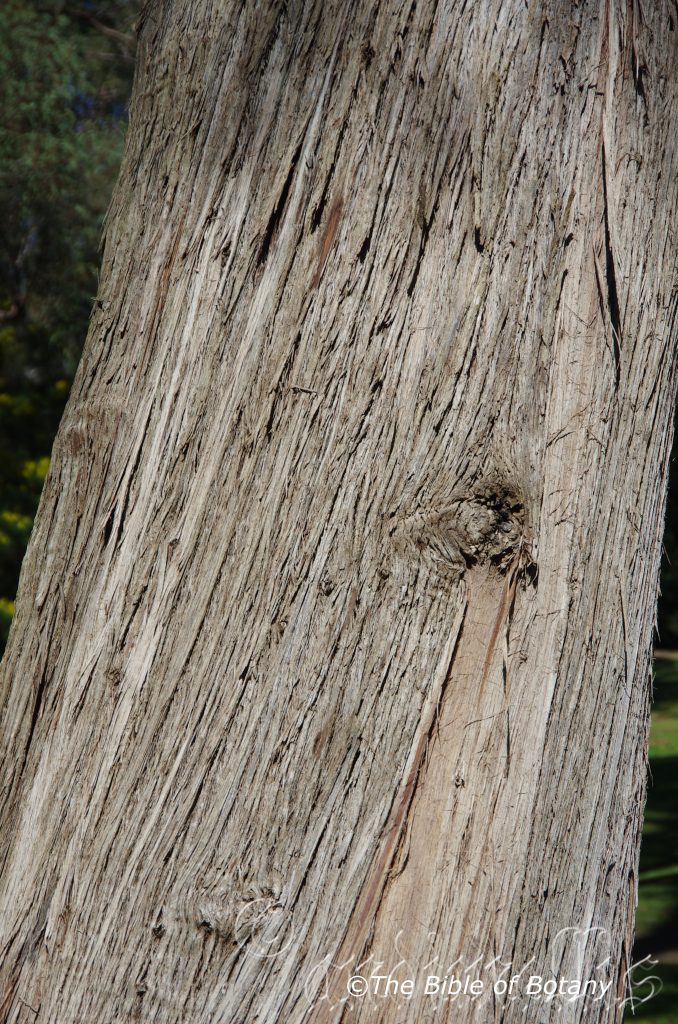
Eucalyptus caliginosa
Classification:
Unranked: Eudicots
Clade: Rosids
Order: Myrtales
Family: Myrtaceae
Genus: From Eu, which is Greek a prefix for good or well and Kaluptos, which is Ancient Greek for to cover up. It refers to the stamens, which have a lid or cover over them in the bud stage prior to opening.
Specie: From Caligo, which is Latin for shady, heavy atmosphere with fogs, orographic precipitation or dark. It refers to plants, which prefer higher altitude environments which are cool with daily fogs.
Sub specie:
Common Name: Broad leaf Stringybark.
Distribution:
Eucalyptus caliginosa is found south from the Main Range National Park in Queensland to Coolah Tops National Park in New South Wales. It is mainly found on the western side of the Great Dividing Range.
https://avh.ala.org.au/occurrences/search?taxa=Eucalyptus+caliginosa#tab_mapView
Habitat Aspect Climate:
Eucalyptus caliginosa prefer full sun. It is mainly found in medium to tall moist sclerophyll forest to dry sclerophyll forest, usually on gentle slopes to mountainous slopes. The altitude ranges from 400 meters ASL to 1100 meters ASL.
The temperatures range from minus 4 degrees in August to 40 degrees in January.
The rainfall ranges from lows of 600mm to an average of 1000mm annually however this may be added to by orographic precipitation as the trees favour areas where higher orographic lift is a common occurrence.
Soil Requirements:
Eucalyptus caliginosa prefers better quality sandy soils to medium clays. The soils are usually derived from granite, brown basalt or black basalt. The soils pH ranges from 5pH to 6pH. It does not tolerate water logged soils.Non saline soils to moderately saline soils are tolerated.
Height & Spread:
Wild Plants: 15m to 25m by 8m to 12m.
Characteristics:
Eucalyptus caliginosa has a long thick bole which is wide spreading at the base with the first branches appearing at 40mm to 50mm of the trees height on mature trees. The persistent bark is, usually red-brown or at times grey, fibrous, stringy and fissured longitudinally to small branches. The smaller branches are smooth pale grey or reddish fawn, smooth and glabrous. The small stems are reddish-orange and glabrous.
Eucalyptus caliginosa’s juvenile and coppice stems are terete and glabrous. The disjunct leaves are broad lanceolate. The concolourous laminas are deep green and covered in brown or red-brown hispid hairs. The margins are entire. The reddish orange petioles measure 0mm to 0.5mm in length. The bases are cordate. The leaves measure 20mm to 30mm in length by 20mm to 30mm in width.
The alternate, disjunct, adult leaves are nearly symmetrical or asymmetrical, lanceolate to broad lanceolate and falcate. They measure 100mm to 150mm in length by 20mm to 30mm in width. The terete petioles measure 13mm to 24mm in length. The oblique bases are cuneate or rounded often being cuneate on one side and rounded on the other while the apexes are shortly tapering or at times with an acute tip. The concolourous laminas are mid green, semi glossy and glabrous. The margins are entire while the mid-vein is slightly prominent on the lower lamina and slightly prominent on the lower lamina for less than half its length from the base. The lateral veins are greater than 50 degrees to the main vein and are penniveined. The intramarginal veins are parallel and close to the margin. The oil glands are islands between the veins.
The inflorescences of Eucalyptus caliginosaare born as umbellasters from the leaf axils. There are 7 to 11 individual white to cream flowers to an umbellaster. The deep reddish-orange peduncles are narrowly flattened or angular and glabrous while the deep reddish-orange pedicels are terete and glabrous. The peduncles measure 7mm to 15mm in length while the pedicels measure 2mm to 4mm in length. The buds are ovoidal to shortly fusiform while the narrow cupular hypanthium are pale yellow-green tinged orange and glabrous. The hypanthium measure 3mm to 4.2mm by 3mm to 5mm in diameter. The conical calyptras measure 2.5mm to 4mm in length. The bud scar is absent.
The stamens are white to cream and measure 9mm to 12mm in length. The white to cream anthers are oblong. The white style measures 6mm to 13mm in length. The disc is pale green. The flowers appear from mid-August to January.
The fruits of Eucalyptus caliginosa are cupular capsules known as gum nuts. The smooth gum nuts measure 6mm to 9mm in length by 4mm to 7.5mm in diameter at the widest point. The disc is flat or slightly raised with the 3 or 4 exserted valves being erect or bent to 60 degrees.
The deep reddish-brown to deep brown almost black, flattened seeds are oblong, reniform to cuboidal and measure 0.7mm to 1.5mm in length while the trash is smaller. The hilum is terminally positioned while the surfaces are shallowly pitted.
Wildlife:
The flowers Eucalyptus caliginosa are good nectar and pollen producers and are very attractive to most honeyeaters, lorikeets, native bees and native insects which in return attract insect eating birds.
Cultivation:
Eucalyptus caliginosa is a medium gum tree which is very suitable for larger gardens where a Eucalyptus is required. It is ideal on poorer fatty sandy loams, average sandy soils to medium clays on undulating slopes and plains with skeletal soils that are well drained in semi-arid regions of Australia. It is fast growing so give good effects at an early age. In the garden trees will grow from 12 meters to 18 meters in height by 10 meters to 15 meters in diameter when grown in the open.
Like all Eucalyptus leaf drop, dropping of small branches means continual lawn maintenance but then this means good quantities of leaf litter mulch and protection of other more sensitive plants growing below. They make good pasture trees as pastures will grow right up to the trunk without any detrimental effects.
Eucalyptus caliginosa can give quick protection, habitat and safe corridors for many small birds and animals. They look particularly good in a park scene when mixed with other Eucalyptus with varying types of bark.
Propagation:
Seeds: Sow Eucalyptus caliginosa seeds into a seed raising mix. Cover the seeds with 2mm to 3mm of fine sand and place the trays in a warm sunny position. Keep the seeds moist but not wet in order to avoid damping off. When the seedlings are 25mm to 50mm tall, prick them out and plant them into 50mm native tubes using a good organic mix.
Once the seedlings reach 200mm to 250mm in height plant them out into their permanent position. Mass plantings are best done in groups of 3 to 5 as a feature by planting them at 15 meter to 30 meter centers.
Fertilize using Seaweed, fish emulsion or organic chicken pellets soaked in water and apply the liquid on an alternate basis. Fertilize every two month until the trees are well established then every spring to ensure good growth and flowering.
Further Comments from Readers:
“Hi reader, it seems you use The Bible of Botany a lot. That’s great as we have great pleasure in bringing it to you! It’s a little awkward for us to ask, but our first aim is to purchase land approximately 1,600 hectares to link several parcels of N.P. into one at The Pinnacles NSW Australia, but we need your help. We’re not salespeople. We’re amateur botanists who have dedicated over 30 years to saving the environment in a practical way. We depend on donations to reach our goal. If you donate just $5, the price of your coffee this Sunday, We can help to keep the planet alive in a real way and continue to bring you regular updates and features on Australian plants all in one Botanical Bible. Any support is greatly appreciated. Thank you.”
In the spirit of reconciliation we acknowledge the Bundjalung, Gumbaynggirr and Yaegl and all aboriginal nations throughout Australia and their connections to land, sea and community. We pay our respect to their Elders past, present and future for the pleasures we have gained.


Eucalyptus camaldulensis
Classification:
Unranked: Eudicots
Clade: Rosids
Order: Myrtales
Family: Myrtaceae
Genus: From Eu, which is Greek a prefix for good or well and Kaluptos, which is Ancient Greek for to cover up. It refers to the stamens, which have a lid or cover over them in the bud stage prior to opening.
Specie: From Camalduli, which is Latin for the Italian district in Tuscany known as Camalduli where the first specimen of the Eucalyptus is believed to have been planted and Anum/Ensis, which is Latin for origin. It refers to the first cultivated specimens being grown at Canmaldui.
Sub specie:
Common Name: River Gum or River Red Gum.
Some of the aboriginal names include Carrickalinga and Yarraan.
Distribution:
Eucalyptus camaldulensis is found throughout mainland Australia south from Grafton Bay on Cape York Peninsular wherever permanent water is found except in the true deserts and an area in an arch about 500 kilometres inland around the Great Australian Bite.
There are 2 isolated populations in Tasmania near Cleveland Midlands and Bridgewater in eastern Tasmania.
https://avh.ala.org.au/occurrences/search?taxa=Eucalyptus+camaldulensis#tab_mapView
Habitat Aspect Climate:
Eucalyptus camaldulensis prefers full sun. It usually grows in grassy woodlands, mallee country or open forest, on large shallow depressions, adjacent to billabongs lakes or along rivers and permanent streams. The altitude ranges from 50 meters ASL to 650 meters ASL.
The temperatures range from minus 4 degrees in August to 37 degrees in January.
The rainfall ranges from lows of 150mm to an average of 2600mm annually.
Soil Requirements:
Eucalyptus camaldulensis prefers deep sandy loams, light silts to heavy silts. The soils are derived from most types of decomposed rocks laid down as alluvial deposits. The soils pH ranges from 5pH to 7pH. It tolerates water logged soils. Non saline soils to moderately saline soils are tolerated with a decline in health as the salinity increases in the lower range of moderate.
Height & Spread:
Wild Plants: 10m to 45m by 8m to 15m.
Characteristics:
Eucalyptus camaldulensis is a very short trunked tree which often branches just above the stocking or can have a long thin bole with the first branches appearing at 45mm to 50mm of the trees height on mature trees. The pale off white, pale grey to pale red-brown glabrous bark extends to the smaller branches. The bark is shed in short ribbons or flakes in spring from the trunk and larger branches. The smaller branches are smooth pale grey or reddish fawn, smooth and glabrous. The small stems are reddish-orange and glabrous.
EEucalyptus camaldulensis’s juvenile leaves are opposite to sub opposite slowly becoming alternate. The disjunct leaves are broad lanceolate to ovate. The concolourous laminas are dull grey-green and glabrous. The margins are entire. The dull reddish orange petioles measure 10mm to 20mm in length. The bases are rounded to slightly rounded-attenuate while apexes are acute. The leaves measure 30mm to 140mm in length by 25mm to 70mm in width.
The alternate, disjunct adult leaves are lanceolate to narrow lanceolate and falcate. They measure 80mm to 300mm in length by 10mm to 28mm in width. The terete petioles measure 13mm to 23mm in length. The oblique bases are cuneate to almost rounded often while the apexes are long tapering. The concolourous laminas are mid green to grey-green, dull and glabrous. The margins are entire while the mid-vein is slightly prominent on the lower lamina and slightly prominent on the lower lamina.
The inflorescences of Eucalyptus camaldulensis are born as umbellasters from the leaf axils. There are 7 to 11 individual white to cream flowers to an umbellaster. The deep reddish-orange peduncles and pedicels are terete and glabrous. The peduncles measure 7mm to 25mm in length while the pedicels measure 5mm to 12mm in length.
The buds are ovoidal while the narrow cupular hypanthium are pale yellow-green tinged orange and glabrous. The hypanthium measure 3mm to 5mm by 3mm to 6mm in diameter. The yellow-green or pink to orange-pink conical calyptras are hemispherical and have semi rostrate tip. They measure 3.5mm to 6.5mm in length. The bud scar is present.
The regular, erect to almost divaricate stamens are white to cream and measure 7mm to 8.5mm in length. The white to cream oblong anthers are dorsifixed and dehisce through longitudinal slits. The stocky, yellow style measures 3.5mm to 5mm in length. The disc is yellow while the flowers appear from mid-October to December but may be as early as late August and may be as late as early February.
The fruits of Eucalyptus camaldulensisare globose to ovoidal capsules known as gum nuts. The smooth gum nuts measure 5mm to 7mm in length by 5mm to 7.5mm in diameter at the widest point. The disc is raised with the 3 to 5 exserted valves being erect.
The tan to pale reddish-brown seeds are oblong-cuboidal to cuboidal and measure 0.7mm to 1.5mm in length while the trash is smaller and deeper in colour. The hilum is terminally positioned while the surfaces are shallowly pitted.
Wildlife:
The flowers Eucalyptus camaldulensis are prolific nectar producers and are very attractive to most honeyeaters, mistletoe birds and lorikeets while insectivorous birds are attracted to the large numbers of insects that are attracted to the trees for the nectar. Cockatoos also are attracted to the trees for the gum nuts as they commence ripening. Many birds like the rainbow lorikeet Trichoglossus moluccanus and mammals seek refuge in the hollows during the day or to breed like the brush tail possum Trichosurus vulpecula andthe ring tail possum Pseudocheirus peregrinus.
Cultivation:
Eucalyptus camaldulensis is a large spreading tree which is very suitable for large gardeners looking for a Eucalyptus for the garden or to create a large parkland scene on very wet ground. It is ideal on sandy soils and sandy alluvial flats that suffer periodic inundations for prolonged periods. It is fast growing so give good effects at an early age. In the garden trees will grow from 20 meters to 25 meters in height by 18 meters to 22 meters in diameter when grown in the open. A tree we had at Nana Glen bore its first flowers at 5 years of age but did not flower again until it was 8 years old despite growing rapidly throughout this period.
Like all Eucalyptus specie leaf drop, dropping of small branches means continual lawn maintenance but then this means good quantities of leaf litter mulch and protection of other more sensitive plants growing below. They make good pasture trees as pastures will grow right up to the trunk without any detrimental effects.
Eucalyptus camaldulensis can give quick protection, habitat and safe corridors for many small birds and animals. It is best used as a small park tree, placed in the background or planted centrally as a small feature tree in medium to larger gardens. Placed at the rear of a bush garden their striking display of flowers and honey scented flowers will draw your attention so that you will want to investigate further. Plants with small white, pink or lavender flowers and large leaves can be used in the midground while small white, pink or mauve flowering prostrate shrubs are best in the front to help high light the grey-green leaves. Whether it is in flower or not these trees will catch your attention because of the dense spreading canopy, willowy outer branches or when in flower the honey scent is magnificent.
Propagation:
Seeds: Sow seeds into a seed raising mix. Cover the seeds with 2mm to 3mm of fine sand and place the trays in a warm sunny position. Keep moist but not wet. When the seedlings are 25mm to 50mm tall, prick them out and plant them into 50mm native tubes using a good organic mix.
Once the seedlings reach 200mm to 250mm in height plant them out into their permanent position. Mass plantings are best done in groups of 3 to 5 as a feature by planting them at 20 meter to 30 meter centers.
Fertilize using Seaweed, fish emulsion or organic chicken pellets soaked in water and apply the liquid on an alternate basis. Fertilize every two month until the trees are well established then every spring to ensure good growth and flowering.
Further Comments from Readers:
“Hi reader, it seems you use The Bible of Botany a lot. That’s great as we have great pleasure in bringing it to you! It’s a little awkward for us to ask, but our first aim is to purchase land approximately 1,600 hectares to link several parcels of N.P. into one at The Pinnacles NSW Australia, but we need your help. We’re not salespeople. We’re amateur botanists who have dedicated over 30 years to saving the environment in a practical way. We depend on donations to reach our goal. If you donate just $5, the price of your coffee this Sunday, We can help to keep the planet alive in a real way and continue to bring you regular updates and features on Australian plants all in one Botanical Bible. Any support is greatly appreciated. Thank you.”
In the spirit of reconciliation we acknowledge the Bundjalung, Gumbaynggirr and Yaegl and all aboriginal nations throughout Australia and their connections to land, sea and community. We pay our respect to their Elders past, present and future for the pleasures we have gained.
Eucalyptus cameronii
Classification:
Unranked: Eudicots
Clade: Rosids
Order: Myrtales
Family: Myrtaceae
Genus: From Eu, which is Greek a prefix for good or well and Kaluptos, which is Ancient Greek for to cover up. It refers to the stamens, which have a lid or cover over them in the bud stage prior to opening.
Specie: Is named in honour of Rev. Archibald Peter Cameron; 1869–1945, who was a clergyman with his friend and parson-botanist, Rev. E.N. McKie made many collecting trips together in the New England area.
Sub specie:
Common Name: Diehard Stringybark.
Distribution:
Eucalyptus cameronii is found south from the Queensland, New South Wales border to Tyringham in northern coastal New South Wales. It is mainly found on the Great Dividing Range.
https://avh.ala.org.au/occurrences/search?taxa=Eucalyptus+cameronii#tab_mapView
Habitat Aspect Climate:
Eucalyptus cameronii prefer full sun. It grows in moist schlerophyll forest to dry schlerophyll forest. It is found on the Western Plains, Western Slopes and on escarpments on the eastern side of the Great Dividing Range. The altitude ranges from 5 meters ASL to 1400 meters ASL.
The temperatures range from minus 4 degrees in August to 37 degrees in January.
The rainfall ranges from lows of 800mm to an average of 1200mm annually.
Soil Requirements:
Eucalyptus cameronii prefer poorer quality, shallow, sandy loams to medium clays. The soils are usually derived from shales and granite or at times, brown basalt. The soils pH ranges from 4.5pH to 5.5pH. It does not tolerate water logged soils.Non saline soils to moderately saline soils are tolerated.
Height & Spread:
Wild Plants: 20m to 40m by 8m to 15m.
Characteristics:
Eucalyptus cameronii has a long thin bole with the first branches appearing at 45mm to 55mm of the trees height on mature trees. The persistent, rough, stringy grey or brown-grey bark extends to the smaller branches. The smaller branches are smooth pale grey or reddish fawn, smooth and glabrous. The small stems are reddish-orange and glabrous. The trees form a lignotuber
Eucalyptus cameronii’s juvenile leaves are opposite slowly becoming alternate arising from terete scabrid stems which are covered in white hispid hairs. The disjunct leaves are broad lanceolate. The bases are slightly oblique and rounded while the apexes are acute. The discolourous laminas are glossy grey-green and glabrous on the upper laminas while the lower laminas are much paler, or off white. The margins are entire with a few undulations. The mid vein and margins are scabrid or sparsely covered in white hispid hairs. The dull grey-green, reddish tinged petioles measure 10mm to 20mm in length. The leaves measure 25mm to 70mm in length by 10mm to 40mm in width.
The alternate, disjunct adult leaves are lanceolate to broad lanceolate and straight or slightly falcate. They measure 55mm to 130mm in length by 10mm to 26mm in width. The terete petioles measure 6mm to 16mm in length. The bases are rounded to cuneate-rounded while the apexes are acute. The discolourous laminas are mid green to grey-green, semi glossy to glossy and glabrous. The margins are entire while the mid-vein is slightly prominent on the lower lamina. The lateral veins are penniveined and are at 30 degrees to the main vein while the intramarginal veins are parallel to and well removed from margin. The oil glands are islands between the lateral veins and secondary veins.
The inflorescences of Eucalyptus cameroniiare born as umbellasters usually containing 7 to 11 flowers or at times more up to 15 from near the terminal. The creamy yellow peduncules are angular to flatten ovate and glabrous while the pedicels are terete and glabrous. The peduncules measure 5mm to 12mm in length while the pedicels measure 0mm to 0.3mm in length.
The buds are fusiform to obovoid hypanthium are pale yellow-green. The hypanthium measure 2.5mm to 3mm by 2mm to 2.5mm in diameter. The pale yellow-green cupular calyptras measure 2mm to 3mm in length. The bud scar is absent.
The irregularly flexed stamens are white and measure 4mm to 5mm in length. The white to cream versatile, reniform to cordate anthers are dorsifixed and dehisce through transversal slits. The stocky, white style measures 2.5mm to 3mm in length. The disc is yellow while the flowers appear in March.
The fruits of Eucalyptus cameronii are flattened globose or hemispherical capsules known as gum nuts. The resinous gum nuts measure 4mm to 5mm in length by 5mm to 7.5mm in diameter at the widest point. The disc is slightly depressed with the 3 or 4 slightly enclosed or slightly exserted valves being erect.
The tan to pale reddish-brown seeds are pyramidal or obliquely pyramidal and measure 1mm to 2.3mm in length while the trash is smaller and deeper in colour. The hilum is terminally positioned while the surfaces are very finely resinous.
Wildlife:
The flowers Eucalyptus cameronii are medium nectar producers and are still are very attractive to most honeyeaters, lorikeets, flying foxes, possums and many insects.
Cultivation:
Eucalyptus cameronii is a medium sized stringy bark which is very suitable for medium gardeners looking for a Eucalyptus for the garden or to create a small parkland scene. It is ideal on sandy soils and sandy alluvial flats that suffer periodic inundations for prolonged periods. It is fast growing so give good effects at an early age. In the garden trees will grow from 20 meters to 25 meters in height by 12 meters to 16 meters in diameter when grown in the open.
Like all Eucalyptus specie leaf drop, dropping of small branches means continual lawn maintenance but then this means good quantities of leaf litter mulch and protection of other more sensitive plants growing below. They make good pasture trees as pastures will grow right up to the trunk without any detrimental effects.
Eucalyptus cameronii can give quick protection, habitat and safe corridors for many small birds and animals. It is best used as a small park tree, placed in the background or planted centrally as a small feature tree in medium to larger gardens. Placed at the rear of a bush garden their striking display of flowers and honey scented flowers will draw your attention so that you will want to investigate further. Plants with small white, pink or lavender flowers and large leaves can be used in the midground while small white, pink or mauve flowering prostrate shrubs are best in the front to help high light the grey-green leaves. Whether it is in flower or not these trees will catch your attention because of the dense spreading canopy, willowy outer branches or when in flower the honey scent is magnificent.
A very unusual grove of Eucalyptus maidenii and Eucalyptus globulus (Probably sub specie bicostata) I saw in Yunnan China were the use of 14 trees either side in a grove planted alternatively just 3 meters apart on opposite sides of a 3 meter path. The trunks were about 400mm to 450mm in diameter. This gave an exceptionally strong contrast of straight trunks which has left an impression which will last a life time. I only wish I had taken a photograph at the time. Why do I mention this here? Because it was so powerful that I want to create a similar scene when I return to Australia and the use of Eucalyptus citriodora or Eucalyptus maculate with Eucalyptus cameronii could achieve a similar result in the tropics as the former two did in a temperate area in China.
Propagation:
Seeds: Sow its seeds into a seed raising mix. Cover the seeds with 2mm to 3mm of fine sand and place the trays in a warm sunny position. Keep moist but not wet. When the seedlings are 25mm to 50mm tall, prick them out and plant them into 50mm native tubes using a good organic mix.
Once the seedlings reach 200mm to 250mm in height plant them out into their permanent position. Mass plantings are best done in groups of 3 to 5 as a feature by planting them at 10 meter to 20 meter centers.
Fertilize using Seaweed, fish emulsion or organic chicken pellets soaked in water and apply the liquid on an alternate basis. Fertilize every two month until the trees are well established then every spring to ensure good growth and flowering.
Further Comments from Readers:
“Hi reader, it seems you use The Bible of Botany a lot. That’s great as we have great pleasure in bringing it to you! It’s a little awkward for us to ask, but our first aim is to purchase land approximately 1,600 hectares to link several parcels of N.P. into one at The Pinnacles NSW Australia, but we need your help. We’re not salespeople. We’re amateur botanists who have dedicated over 30 years to saving the environment in a practical way. We depend on donations to reach our goal. If you donate just $5, the price of your coffee this Sunday, We can help to keep the planet alive in a real way and continue to bring you regular updates and features on Australian plants all in one Botanical Bible. Any support is greatly appreciated. Thank you.”
In the spirit of reconciliation we acknowledge the Bundjalung, Gumbaynggirr and Yaegl and all aboriginal nations throughout Australia and their connections to land, sea and community. We pay our respect to their Elders past, present and future for the pleasures we have gained.


Eucalyptus campanulata
Classification:
Unranked: Eudicots
Clade: Rosids
Order: Myrtales
Family: Myrtaceae
Genus: From Eu, which is Greek a prefix for good or well and Kaluptos, which is Ancient Greek for to cover up. It refers to the stamens, which have a lid or cover over them in the bud stage prior to opening.
Specie: From Campanulata, which is Latin for a bell. It refers to flowers, or fruits which have a distinctive bell shape.
Sub specie:
Common Name: New England Blackbutt.
Distribution:
Eucalyptus campanulata is found south from Kroombit Tops National Park in Queensland to Mount Royal on the southern section of the Barrington Tops National Park in northern coastal New South Wales. There is an isolated population south of Eungella National Park west of Mackay. It is mainly found on and east of the Great Dividing Range.
https://avh.ala.org.au/occurrences/search?taxa=Eucalyptus+campanulata#tab_mapView
Habitat:
Aspect / Climate:
Eucalyptus campanulata prefers full sun. It grows in moist schlerophyll forest to dry schlerophyll forest. It is found on the Western Slopes and on escarpments on the eastern side of the Great Dividing Range. The altitude ranges from 100 meters ASL to 1350 meters ASL.
The temperatures range from minus 3 degrees in August to 40 degrees in January.
The rainfall ranges from lows of 600mm to an average of 1700mm annually.
Soil Requirements:
Eucalyptus campanulata prefers better quality sandy loams to medium clays. The soils are usually derived from granite or at times brown basalt or black basalt. The soils pH ranges from 5pH to 6.5pH. It does not tolerate water logged soils. Non saline soils to moderately saline soils are tolerated.
Height & Spread:
Wild Plants: 20m to 45m by 12m to 20m.
Characteristics:
Eucalyptus campanulata has a long thin bole with the first branches appearing at 45mm to 55mm of the trees height on mature trees. The persistent, rough, fibrous grey or brown-grey bark extends to the larger branches. The smaller branches are smooth pale grey or grey-brown, smooth and glabrous. The small stems are mid green tinged reddish-orange and glabrous. The decorticating bark from the branches is shed in long ribbons.
Eucalyptus campanulata’s alternate juvenile leaves are broad elliptical to ovate elliptical and falcate. The bases are oblique and rounded or rounded on side and cuneate-rounded on the other side while the apexes are tapering. The concolourous laminas are dull grey-green and glabrous. The margins are entire with a few undulations. The mid vein and margins are thickened. The dull grey-green, reddish tinged petioles measure 10mm to 16mm in length. The measure 70mm to 150mm in length by 40mm to 65mm in width.
The alternate, disjunct adult leaves are lanceolate to broad lanceolate and falcate. They measure 90mm to 180mm in length by 10mm to 26mm in width. The terete petioles measure 9mm to 16mm in length. The bases are cuneate while the apexes are tapering. The concolourous laminas are mid green to grey-green, semi glossy to glossy and glabrous. The margins are entire while the mid-vein is slightly prominent on the lower lamina. The lateral veins are penniveined and are at about 45 degrees to the main vein while the intramarginal veins are parallel to and well removed from margin. The oil glands are islands between the lateral veins and secondary veins.
The inflorescences of Eucalyptus campanulata are born as umbellasters containing 11 to 15 individual flowers from near the terminal. The red to deep red and at times tinged orange peduncules are terete or angular and glabrous while the yellow-green often tinged red to deep purple pedicels are terete and glabrous. The peduncules measure 10mm to 16mm in length while the pedicels measure 4mm to 6mm in length.
The clavate buds are pale yellow-green. The hypanthium measure 2.5mm to 5mm by 3mm to 4mm in diameter. The pale yellow-green cupular calyptras have an apiculate apex and measure 2mm to 4mm in length. The bud scar is absent.
The inflexed or irregularly flexed stamens are white and measure 4mm to 5.5mm in length. The stamens are often fertile or the outer most stamens are often sterile. The white to cream reniform to cordate anthers are versatile, dorsifixed and dehisce through transversal slits. The short, stocky, white style measures 2.5mm to 3mm in length. The disc is yellow while the flowers appear in March.
The fruits of Eucalyptus campanulataare cupular to campanulate capsules known as gum nuts. The resinous gum nuts measure 4mm to 7mm in length by 5mm to 7mm in diameter at the widest point. The disc is slightly depressed or level hypanthium rim. The 3 or 4 or rarely 5 slightly enclosed or slightly exserted valves being erect.
The deep tan to reddish-brown seeds are pyramidal or obliquely pyramidal and measure 1mm to 2.5mm in length while the trash is smaller and deeper in colour. The hilum is terminally positioned while the surfaces are very finely resinous and the dorsal surface is glabrous.
Wildlife:
The flowers Eucalyptus campanulata are moderate nectar producers and are still are very attractive to most honeyeaters, lorikeets, flying foxes, possums and many insects.
Cultivation:
Eucalyptus campanulata is a medium sized stringy bark which is very suitable for medium gardeners looking for a Eucalyptus for the garden or to create a small parkland scene. It is ideal on light clays to medium clays on gentle to medium slopes. It is fast growing so give good effects at an early age. In the garden the trees will grow from 15 meters to 20 meters in height by 10 meters to 14 meters in diameter when grown in the open.
Like all Eucalyptus specie leaf drop, dropping of small branches means continual lawn maintenance but then this means good quantities of leaf litter mulch and protection of other more sensitive plants growing below. They make good pasture trees as pastures will grow right up to the trunk without any detrimental effects.
It is best used adjacent to small areas of bush planted in small groups of 2 or 3, or as a standalone plant to create a harsher barren look with other arid plants. If it is surrounded by shorter plants with fine foliage and red flowers they will dominate at the center. Two plants can achieve the same scenario if planted in close proximity and still achieve the sparseness and harshness of the desert picture. Here a few annuals strategically scattered around would complete the picture. The plants planted out below should have a mixture of bold colours radiating out from the base of the trees so use pinks and mauves directly below and reds and whites further out and avoid yellows and pinks. Grevillea miniata has broad leaves and large enough flowers to dominate the scene when in flower and when not in flower the strong outline of Eucalyptus campanulata will give the contrast required for strength especially if those plants covering the ground have smaller leaves and the majority is bright pale green.
Propagation:
Seeds: Sow the seeds into a seed raising mix. Cover the seeds with 2mm to 3mm of fine sand and place the trays in a warm sunny position. Place the trays beneath 30mm shade cloth and keep moist but not wet. When the seedlings are 25mm to 50mm tall, prick them out and plant them into 50mm native tubes using a good organic mix.
Once the seedlings reach 200mm to 250mm in height plant them out into their permanent position. Mass plantings are best done in groups of 3 to 5 as a feature by planting them at 10 meter to 20 meter centers.
Fertilize using Seaweed, fish emulsion or organic chicken pellets soaked in water and apply the liquid on an alternate basis. Fertilize every two month until the trees are well established then every spring to ensure good growth and flowering.
Further Comments from Readers:
“Hi reader, it seems you use The Bible of Botany a lot. That’s great as we have great pleasure in bringing it to you! It’s a little awkward for us to ask, but our first aim is to purchase land approximately 1,600 hectares to link several parcels of N.P. into one at The Pinnacles NSW Australia, but we need your help. We’re not salespeople. We’re amateur botanists who have dedicated over 30 years to saving the environment in a practical way. We depend on donations to reach our goal. If you donate just $5, the price of your coffee this Sunday, We can help to keep the planet alive in a real way and continue to bring you regular updates and features on Australian plants all in one Botanical Bible. Any support is greatly appreciated. Thank you.”
In the spirit of reconciliation we acknowledge the Bundjalung, Gumbaynggirr and Yaegl and all aboriginal nations throughout Australia and their connections to land, sea and community. We pay our respect to their Elders past, present and future for the pleasures we have gained.
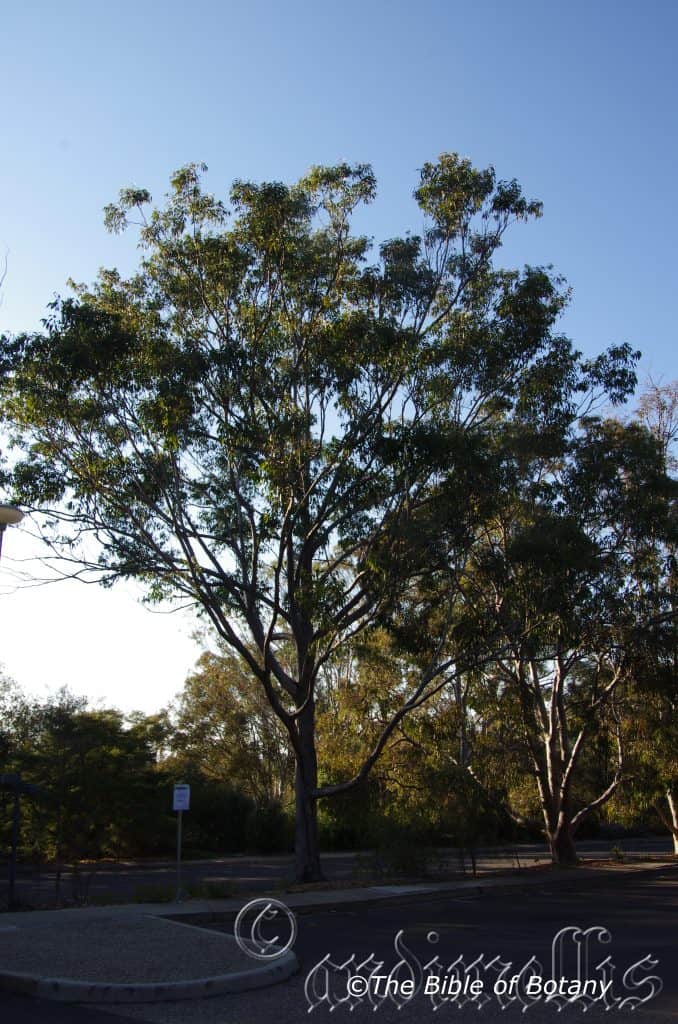
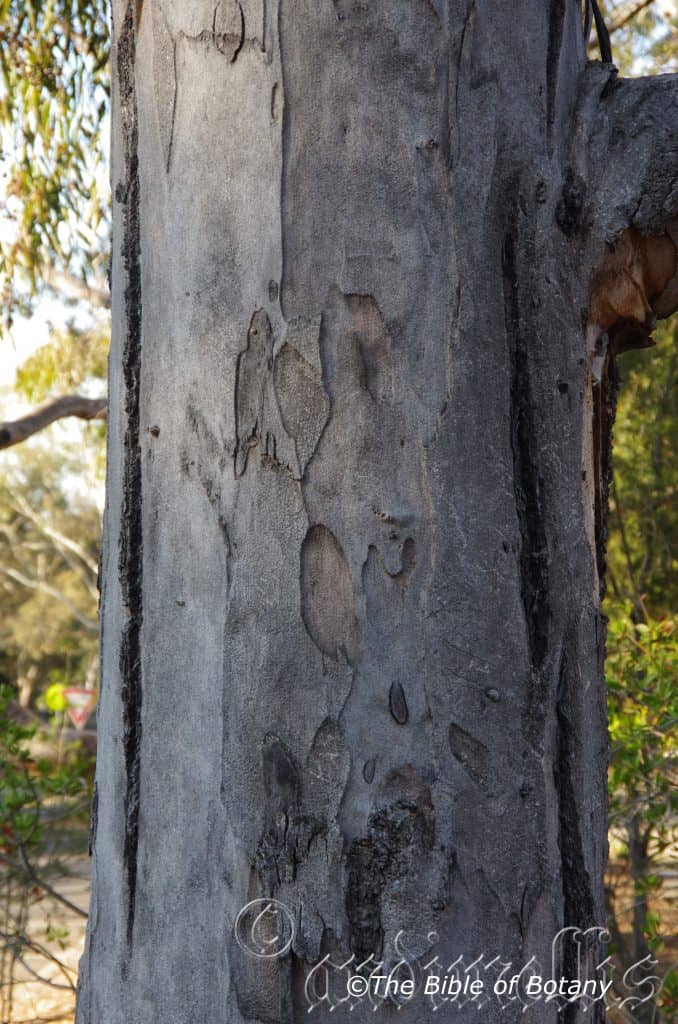
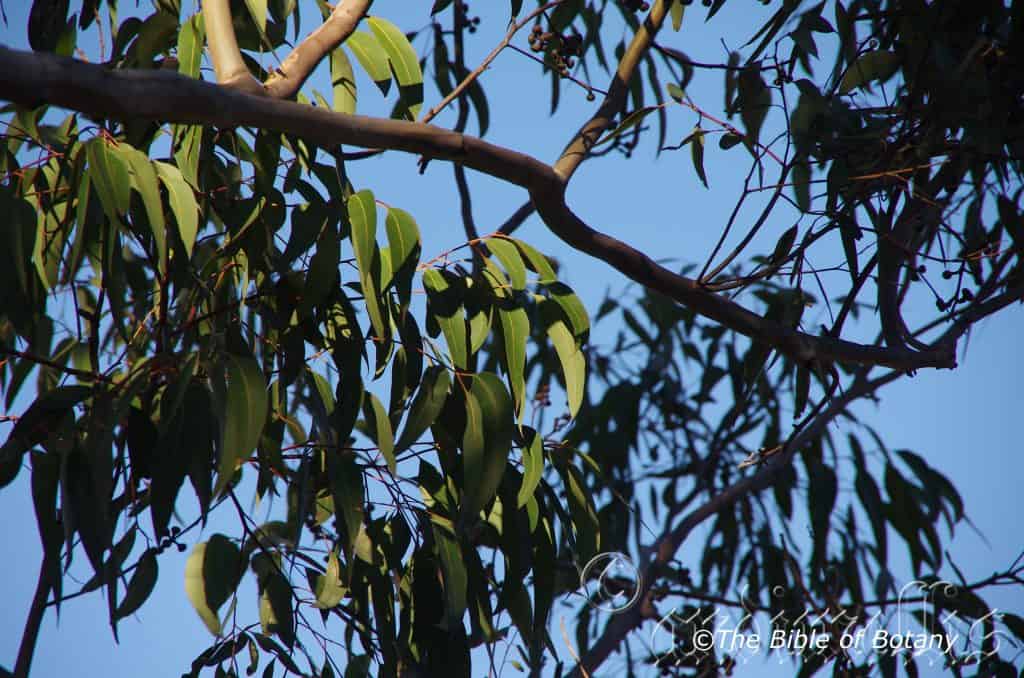
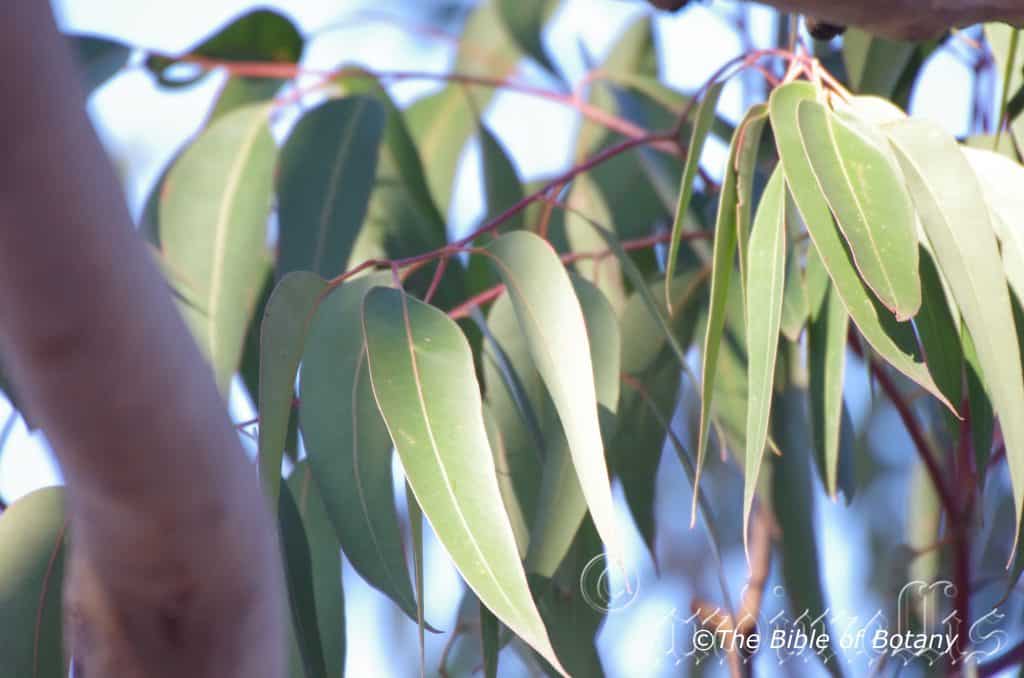

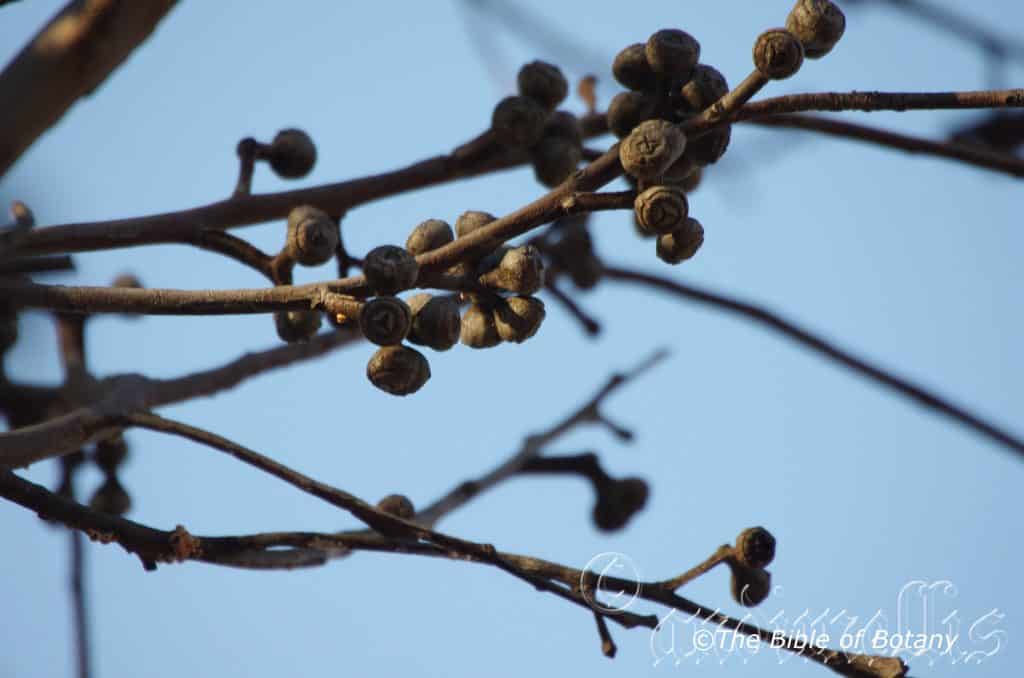
Eucalyptus canaliculata
Classification:
Unranked: Eudicots
Clade: Rosids
Order: Myrtales
Family: Myrtaceae
Genus: From Eu, which is Greek a prefix for good or well and Kaluptos, which is Ancient Greek for to cover up. It refers to the stamens, which have a lid or cover over them in the bud stage prior to opening.
Specie: From Kānna, which is Greek or Canāliculāta, which is Latin for a groove or water channel. It refers to fleshy leaves, branches or trunks which have a distinct longitudinal groove.
Sub specie:
Common Name:
Distribution:
Eucalyptus canaliculata is restricted to a small area bounded by Gloucester, Barrington Tops, Rouchel Brook on the western side of the Barrington Tops, Howe’s Valley, west of Newcastle and Buladelah State Forest.
https://avh.ala.org.au/occurrences/search?taxa=Eucalyptus+canaliculata#tab_mapView
Habitat Aspect Climate:
Eucalyptus canaliculata prefers full sun to light dappled shade. It grows in wet schlerophyll forests, moist mixed forests and in the transitional zones with rainforests. The altitude ranges from 80 meters ASL to 1000 meters ASL.
The temperatures range from minus 3 degree in August to 35 degrees in January.
The rainfall ranges from lows of 750mm to an average of 1800mm annually.
Soil Requirements:
Eucalyptus canaliculata prefers moderately fertile loams to medium clays. The soils are usually derived from decomposed sandstones or granites often mixed with red volcanic soils. The soils pH ranges from 5.5pH to 7pH. It does not tolerate water logged soils.Non saline soils to moderately saline soils are tolerated.
Height & Spread:
Wild Plants: 20m to 30m by 10m to 15m.
Characteristics:
Eucalyptus canaliculata is a large tree which has a single trunk. The bark is smooth, mottled, matte, white, grey or pink. The smaller branches are orange-grey or yellowish-green and glabrous. The bark decorticates in large plates or flakes.
Eucalyptus canaliculata‘s juvenile and coppice stems are terete and glaucous. The opposite disjunct, narrow-lanceolate leaves are concolourous, glossy, green and glabrous. The margins are entire.
The alternate, disjunct, lanceolate leaves measure 80mm to 150mm in length by 15mm to 30mm in width. The terete petioles measure 10mm to 18mm in length. The bases are tapering rounded while the apexes are narrowly acute. The discolourous laminas are dull, bluish-green to bright green and glabrous on the upper lamina and paler on the lower lamina. The margins are entire while the mid-vein is prominent on both laminas especially on the basal half. The lateral penniveins are visible on the both laminas.
The inflorescences of Eucalyptus canaliculata are born as umbellasters along the stems. There are 7 individual white to cream flowers to an umbellaster. The broadly flattened peduncles are glabrous and measure 10mm to 18mm in length while the terete pedicels are measure 4mm to 7mm in length. The ovoidal buds are greenish-yellow to yellow, glabrous and measure 7mm to 12mm in length by 2.5mm to 3.5mm in diameter. The conical calyptra is as long as and as wide as or narrower than the hypanthium. A bud scar is present.
The white stamens measure 4mm to 5mm in length. The creamy-yellow style measures 2mm to 3mm in length. The disc is creamy-yellow to yellow. The flowers appear from mid-January to February.
The fruits of Eucalyptus canaliculata are ribbed, hemispherical or turbinate capsules known as gum nuts. The greenish-yellow to grass-green gum nuts measure 6mm to 12mm in length by 6mm to 14mm in diameter at the widest point. The disc is raised with the 4 valves being exserted.
Wildlife:
The flowers Eucalyptus canaliculata are average nectar producers but are very attractive to most honeyeaters, lorikeets, flying foxes and many insects.
Cultivation:
Eucalyptus canaliculata is a medium gum tree which is very suitable for larger gardens where a Eucalyptus is required. It is fast growing so gives a great affect at an early age with its pronounced leanings. In the garden good specimens grow from 20 meters to 25 meters in height by 8 meters to 12 meters in diameter when grown in the open.
Like all Eucalyptus spp. leaf drop, dropping of small branches means continual lawn maintenance but then this means good quantities of leaf litter mulch.
Eucalyptus canaliculata can give quick protection, habitat and safe corridors for many small birds. It is suitable for wind breaks and for shelter trees on wet sandy pastures and sheep stations where soil compaction is not a problem. It looks particularly good when mixed with other Eucalyptus with varying types of bark.
Propagation:
Seeds: Sow into a seed raising mix. Cover the seeds with 2mm to 3mm of fine sand and place the trays in a warm sunny position. Keep the seeds moist but not wet. When the seedlings are 25mm to 50mm tall, prick them out and plant them into 50mm native tubes using a good organic mix.
Once the seedlings reach 200mm to 250mm in height plant them out into their permanent position. Mass plantings are best done in groups of 3 to 5 as a feature by planting them at 10 meter to 15 meter centers.
Fertilize using Seaweed, fish emulsion or organic chicken pellets soaked in water and apply the liquid on an alternate basis. Fertilize every two month until the trees are well established then every spring to ensure good growth and flowering.
Further Comments from Readers:
“Hi reader, it seems you use The Bible of Botany a lot. That’s great as we have great pleasure in bringing it to you! It’s a little awkward for us to ask, but our first aim is to purchase land approximately 1,600 hectares to link several parcels of N.P. into one at The Pinnacles NSW Australia, but we need your help. We’re not salespeople. We’re amateur botanists who have dedicated over 30 years to saving the environment in a practical way. We depend on donations to reach our goal. If you donate just $5, the price of your coffee this Sunday, We can help to keep the planet alive in a real way and continue to bring you regular updates and features on Australian plants all in one Botanical Bible. Any support is greatly appreciated. Thank you.”
In the spirit of reconciliation we acknowledge the Bundjalung, Gumbaynggirr and Yaegl and all aboriginal nations throughout Australia and their connections to land, sea and community. We pay our respect to their Elders past, present and future for the pleasures we have gained.

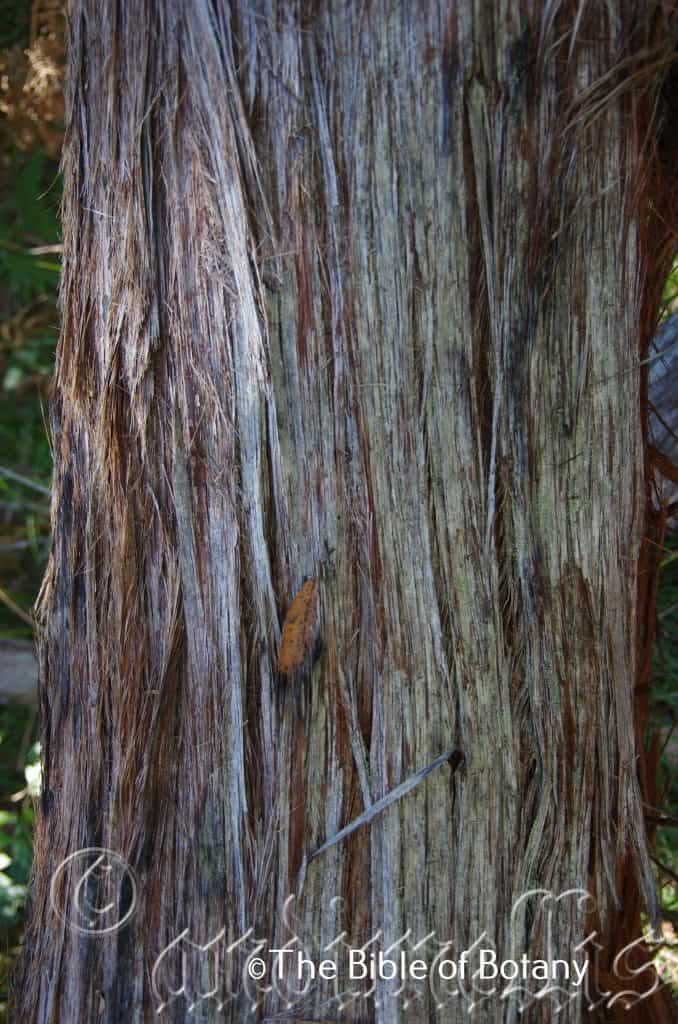
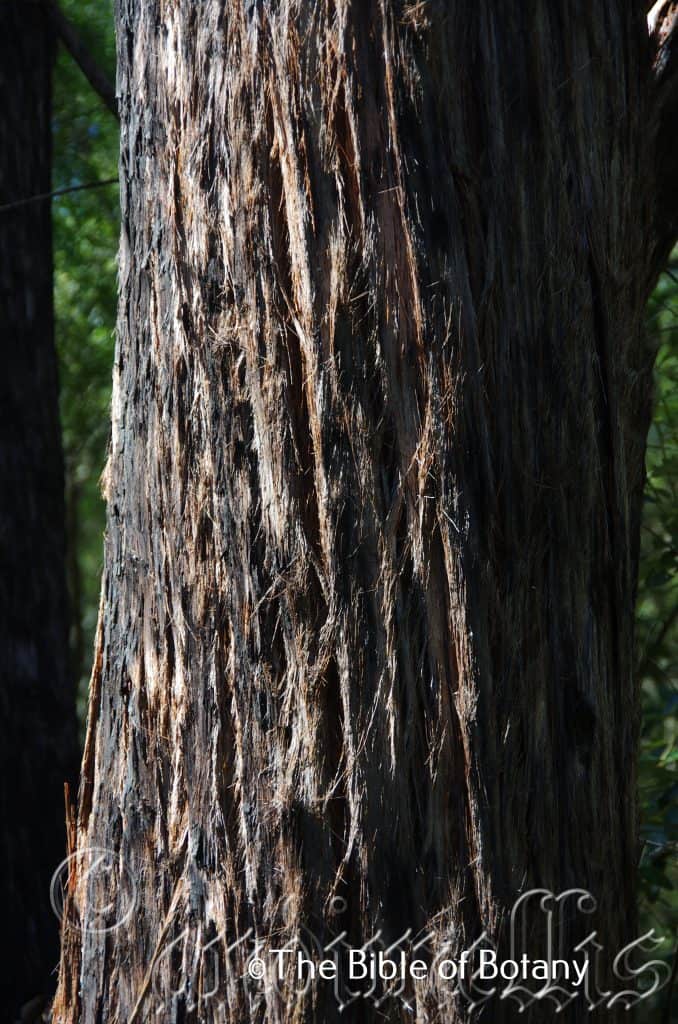


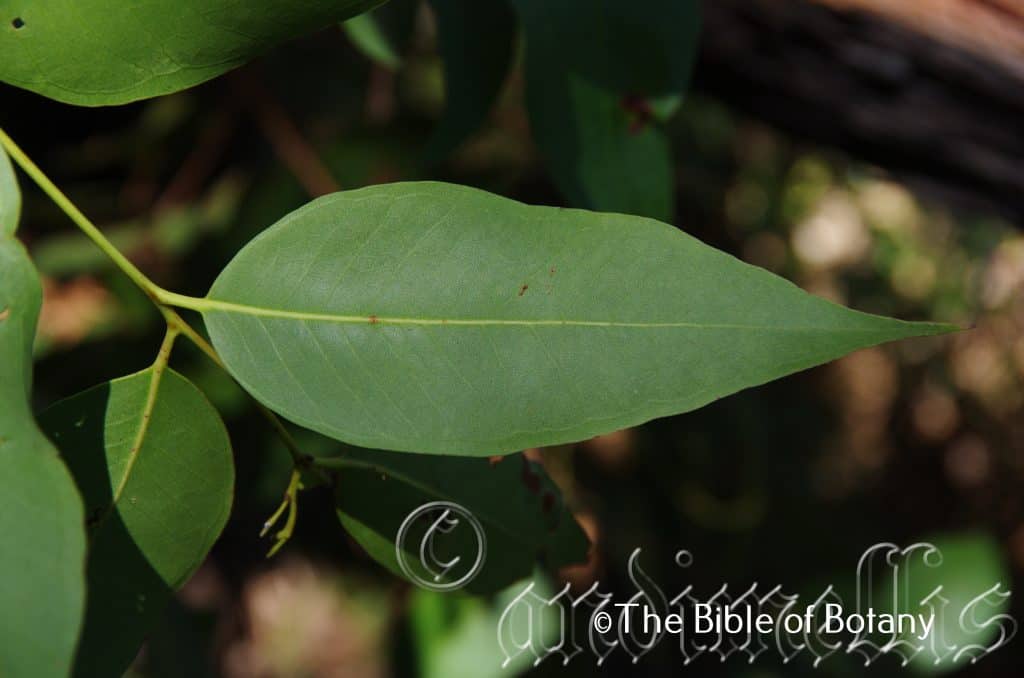


Eucalyptus carnea
Classification:
Unranked: Eudicots
Clade: Rosids
Order: Myrtales
Family: Myrtaceae
Genus: From Eu, which is Greek a prefix for good or well and Kaluptos, which is Ancient Greek for to cover up. It refers to the stamens, which have a lid or cover over them in the bud stage prior to opening.
Specie: From Carnea, which is Latin for flesh colour. It refers to flowers, which are flesh coloured.
Sub specie:
Common Name: Thick Leaf Mahogany.
Distribution:
Eucalyptus carnea is found south from Bundaberg in southern coastal Queensland to Sydney in central coastal New South Wales. It is mainly found on and east of the Great Dividing Range.
https://avh.ala.org.au/occurrences/search?taxa=Eucalyptus+carnea#tab_mapView
Habitat Aspect Climate:
Eucalyptus carnea prefer full sun to light dappled shade. It grows in drier schlerophyll forest on small plateaus and along flat valleys from the altitude ranges from 15 meters ASL to 1350 meters ASL.
The temperatures range from minus 2 degrees in August to 39 degrees in January.
The rainfall ranges from lows of 800mm to an average of 1600mm annually.
Soil Requirements:
Eucalyptus carnea prefers average quality gritty clays to medium clays or at times heavy clays. The soils are usually derived from shale and slate or at times granite fatty sandstone, metamorphic rocks, brown basalt or black basalt. The soils pH ranges from 4.5pH to 6pH. It does not tolerate water logged soils.Non saline soils to moderately saline soils are tolerated as are salt laden winds.
Height & Spread:
Wild Plants: 20m to 28m by 8m to 14m.
Characteristics:
Eucalyptus carnea has a long thin bole with the first branches appearing at 45mm to 55mm of the trees height on mature trees. The fibrous creamy tan, grey or brown-grey bark extends to the smaller branches. The smaller branches are smooth pale grey or grey-brown and glabrous. The small stems are mid green tinged reddish-brown to pale reddish-brown and glabrous. The bark is persistent throughout the tree.
Eucalyptus carnea’s disjunct alternate juvenile leaves are broad lanceolate and falcate. The mid vein and margins are thickened. The dull, reddish tinged, grey-green petioles measure 10mm to 16mm in length. The bases are asymmetrical and cuneate-rounded while the apexes are tapering. The concolourous laminas are dull grey-green and glabrous. The margins are entire with a few undulations. The measure 70mm to 150mm in length by 40mm to 65mm in width. The leaves are reddish-brown and glossy when they first appear.
The alternate, disjunct adult leaves are lanceolate to broad lanceolate and measure 60mm to 180mm in length and 15mm to 40mm in width. The bases are cuneate while the apexes are tapering. The slightly terete petioles are straight to twisted and measure 9mm to 20mm in length. The concolourous laminas are mid green to grey-green, dull and glabrous. The margins are entire and thickened. The mid vein is prominent on both laminas. The lateral veins are penniveined while the intramarginal veins are parallel to and run close to margin. The oil glands are islands between the lateral veins and secondary veins. The leaves are reddish-brown and glossy when they first appear.
The inflorescences of Eucalyptus carneaare born as umbellasters containing 7 to 11 flowers from near the terminal. The red to deep red and at times yellow-green tinged orange peduncules are narrowly flattened to angular and glabrous while the yellow-green often tinged red to deep purple pedicels are angular and glabrous. The peduncules measure 9mm to 25mm in length while the pedicels measure 3mm to 7mm in length.
The ovoid to fusiform buds are pale yellow-green. The hypanthium measure 3mm to 5.5mm by 3mm to 4mm in diameter. The pale yellow-green conical calyptras have an acute or blunt rostrate apex and measure 3mm to 4mm in length. The bud scar is absent.
The irregularly flexed, white, filaments measure 5mm to 6.5mm in length. The cream anthers are reniform to oblong, versatile, dorsifixed and dehisce through transversal slits. The short, stocky, creamy green style measures 2.5mm to 3mm in length. The disc is creamy green while the flowering period is very variable and appears to be based on local climatic conditions. They appear from September to March.
The fruits of Eucalyptus carnea are hemispherical, glabrous capsules known as gum nuts. The gum nuts measure 5mm to 8mm in length by 5mm to 9mm in diameter at the hypanthia. The domed disc is depressed at the edges and level with the hypanthia in the center. The 3 to 5 valves are level with the hypanthia. The flattened seeds are long ovoid and measure 1mm to 1.3mm in length.
Wildlife:
The flowers Eucalyptus carnea are light nectar producers but are still are very attractive to most honeyeaters, lorikeets, flying foxes, possums and many insects.
Cultivation:
Eucalyptus carnea is very suitable for medium gardeners looking for a Eucalyptus for the garden or to create a small parkland scene. It is ideal on light clays to heavy clays on gentle to medium slopes. It is fast growing so give good effects at an early age. In the garden the trees will usually grow from 15 meters to 18 meters in height by 10 meters to 14 meters in diameter when grown in the open.
Like all Eucalyptus specie leaf drop, dropping of small branches means continual lawn maintenance but then this means good quantities of leaf litter mulch and protection of other more sensitive plants growing below. They make good pasture trees as pastures will grow right up to the trunk without any detrimental effects.
It is best used adjacent to small areas of bush planted in small groups of 2 or 3, or as a standalone plant to create a harsher barren look with other arid plants. If it is surrounded by shorter plants with fine foliage they will dominate at the center. Two plants can achieve the same scenario if planted in close proximity and still achieve the sparseness and harshness of the desert picture. Here a few annuals strategically scattered around would complete the picture. The plants planted out below should have a mixture of bold colours radiating out from the base of the trees so use pinks and mauves directly below and reds and whites further out and avoid yellows and pinks. Grevillea miniata has broad leaves and large enough flowers to dominate the scene when in flower and when not in flower the strong outline of Eucalyptus campanulata will give the contrast required for strength especially if those plants covering the ground have smaller leaves and the majority is bright pale green.
Propagation:
Seeds: Sow Eucalyptus carnea into a seed raising mix. Cover the seeds with 2mm to 3mm of fine sand and place the trays in a warm sunny position. Keep moist but not wet. When the seedlings are 25mm to 50mm tall, prick them out and plant them into 50mm native tubes using a good organic mix.
Once the seedlings reach 200mm to 250mm in height plant them out into their permanent position. Mass plantings are best done in groups of 3 to 5 as a feature by planting them at 10 meter to 20 meter centers.
Fertilize using Seaweed, fish emulsion or organic chicken pellets soaked in water and apply the liquid on an alternate basis. Fertilize every two month until the trees are well established then every spring to ensure good growth and flowering.
Further Comments from Readers:
“Hi reader, it seems you use The Bible of Botany a lot. That’s great as we have great pleasure in bringing it to you! It’s a little awkward for us to ask, but our first aim is to purchase land approximately 1,600 hectares to link several parcels of N.P. into one at The Pinnacles NSW Australia, but we need your help. We’re not salespeople. We’re amateur botanists who have dedicated over 30 years to saving the environment in a practical way. We depend on donations to reach our goal. If you donate just $5, the price of your coffee this Sunday, We can help to keep the planet alive in a real way and continue to bring you regular updates and features on Australian plants all in one Botanical Bible. Any support is greatly appreciated. Thank you.”
In the spirit of reconciliation we acknowledge the Bundjalung, Gumbaynggirr and Yaegl and all aboriginal nations throughout Australia and their connections to land, sea and community. We pay our respect to their Elders past, present and future for the pleasures we have gained.
Eucalyptus cerasiformis
Classification:
Unranked: Eudicots
Clade: Rosids
Order: Myrtales
Family: Myrtaceae
Genus: From Eu, which is Greek a prefix for good or well and Kaluptos, which is Ancient Greek for to cover up. It refers to the stamens, which have a lid or cover over them in the bud stage prior to opening.
Specie: From Kerat/Keras, which is Ancient Greek for a horn, Cēra, which is Latin for waxy or Cerasi which is Latin for a cherry and Forme which is Latin for to take the shape or form of. It refers to operculum on the buds, which appear like little, waxy horns on cherries.
Sub specie:
Common Name: Fuchsia Mallee.
Distribution:
Eucalyptus cerasiformis is a rare species restricted to a small area between east of Hyden to Norseman in south west of Western Australia.
https://avh.ala.org.au/occurrences/search?taxa=Eucalyptus+cerasiformis#tab_mapView
Habitat Aspect Climate:
Eucalyptus cerasiformis prefers full sun to light dappled shade. It grows in open woodland as a small mallee. The altitude ranges from 230 meters ASL to 350 meters ASL.
The temperatures range from 3 degrees in July to 40 degrees in January.
The rainfall ranges from lows of 280mm to an average of 420mm annually.
Soil Requirements:
Eucalyptus cerasiformis prefer better quality red sandy loams to light sandy clays. The soils are usually derived from sandstones. The soils pH ranges from 6.5pH to 7pH. It does not tolerate water logged soils. Non saline soils to moderately saline soils are tolerated.
Height & Spread:
Wild Plants: 2m to 3.5m by 2m to 3m.
Characteristics:
Eucalyptus cerasiformis have long, thin multi stemmed trunks from an underground lignotuber with the first branches appearing at 55mm to 75mm of the trees height on mature trees. The glabrous, creamy grey mottled bark over lies a salmon pink bark and extends to the smaller branches. The smaller branches are smooth pale grey or grey-brown and glabrous. The small stems are mid olive-green tinged reddish-brown to yellow and glabrous. The bark is persistent throughout the tree.
Eucalyptus carnea’s opposite to sub opposite juvenile leaves are ovate or broad elliptical. The bases are asymmetrical and cuneate-rounded while the apexes are obtuse. The concolourous laminas are yellow-green, semi glossy and glabrous. The margins are entire with a few undulations. The mid vein and margins are thickened. The dull yellow-green, petioles measure 10mm to 16mm in length. The leaves measure 70mm to 150mm in length by 40mm to 65mm in width.
The alternate, disjunct adult leaves are lanceolate, broad lanceolate or narrow elliptical are straight to falcate and measure 60mm to 180mm in length and 15mm to 40mm in width. The olive–green to olive–yellow terete petioles are straight and measure 9mm to 20mm in length. The bases are cuneate while the apexes are tapering. The concolourous laminas are mid green to grey-green, dull and glabrous. The margins are entire. The laminas are thickened over the mid-veins. The lateral veins are penniveined while the intramarginal veins are parallel to and run close to margin. The oil glands are densely scattered islands between the lateral veins and secondary veins.
Inflorescences of Eucalyptus cerasiformis are born as umbellasters containing 3 to 5 flowers from the leaf axils. The deep green tinged deep red peduncules are terete and glabrous while the deep green tinged deep red pedicels are terete and glabrous. The peduncules measure 9mm to 25mm in length while the pedicels measure 3mm to 7mm in length.
The urceolate buds are deep green. The hypanthium measure 3mm to 5.5mm in length by 3mm to 4mm in diameter. The deep green conical calyptras have an acute or blunt rostrate apex and measure 3mm to 4mm in length. The bud scar is absent.
The divaricate filaments bend 90 degrees at the mid-point before becoming fully divaricate close to anthesis. It is usually pastel green or at times white and measure 5mm to 6.5mm in length. The cream anthers are reniform to oblong, versatile, dorsifixed and dehisce through transversal slits. The short, stocky, creamy green style measures 2.5mm to 3mm in length. The disc is creamy green while the flowering period is very variable and appears to be based on local climatic conditions. The pale creamy yellow to lemon-yellow style measures 7mm to 8mm in length. The flowers appear from December or January to March.
The fruits are urceolate capsules known as gum nuts. The deep green glabrous gum nuts turn brown and are heavily marked in resinous lines. The gum nuts measure 6mm to 9 mm in length by 6mm to 9mm in diameter at the hypanthium. The discs are enclosed while the valves are inserted revealing the 4 valves. The linear to cuboidal seeds measure 1.5mm to 2.5mm in length and are distinctly deep brown-black.
Wildlife:
The flowers Eucalyptus cerasiformis are good nectar producers and are very attractive to most honeyeaters and lorikeets, native bees and beetles.
Cultivation:
Eucalyptus cerasiformis is a smaller gum tree which is very suitable for small gardeners looking for a Eucalyptus to create a small bush scene. It is ideal on sandy loams, sandy alluvial flats or light clays that are well drained. It is fast growing so give good effects at an early age. In the garden good specimens grow from 2 to 4 meters in height by 3 meters to 4 meters in diameter as a multi stemmed mallee. It is drought resistant and can cope with moderate frosts.
This is not a popular cream flowering gum amongst home gardeners as most tend to favour the red flowering gum trees. It is too often planted singularly with gardeners not prepared to let their hair down and experiment. It has a lignotuber so it should be used. Try mass planting them as features of 2 or 3 or even 5 in a group using curves. Another method would be to plant 8 to 10 close together and after a few years leave 2 or 3 of them and prune the others in the clump back hard so it is forced to re shoot from the lignotuber. This will create an effect of various heights and greater flowering in the following season. The trees left will take on a pendulous look while the others will grow rapidly upwards.
Try planting 2 or 3 as trees in the centre of a large raised garden bed with 8 to 10 Eucalyptus caesia close together and after a few years leave the 2 or 3 Eucalyptus cerasiformis and prune the Eucalyptus caesia in the clump back hard so it is forced to re shoot from the lignotuber for a really striking display of various reds and lemon flowers.
A similar pattern of mosaics could be achieved on the high side of a large long bank with outstanding results.
They would be ideally suited to a small patch using them as the shrub cutting them back hard every 2 years with Eucalyptus cerasiformis as the tree. The carmine and pale yellow flowers would prolong the flowering season over 9 months.
Like all Eucalyptus specie leaf drop, dropping of small branches means continual lawn maintenance but then this means good quantities of leaf litter mulch. If the trees are clumped or used in a bush garden this is not a problem.
Propagation:
Seeds: Sow Eucalyptus cerasiformis’s seed directly into a seed raising mix. Cover the seeds with 2mm to 3mm of fine sand and place the trays in a warm sunny position. Keep moist but not wet. When the seedlings are 25mm to 50mm tall, prick them out and plant them into 50mm native tubes using a good organic mix.
Once the seedlings reach 200mm to 250mm in height plant them out into their permanent position. Mass plantings are best achieved by planting them at 4 meters to 5 meters where clumps are required or 6 meters to 7 meters where individuality is wanted in shape and the bark is used as a feature.
Fertilize using seaweed, fish emulsion or organic chicken pellets soaked in water on an alternate basis. Fertilize every two months until the plants are established then twice annually in early September or March to maintain health, vitality and better flowering.
Further Comments from Readers:
“Hi reader, it seems you use The Bible of Botany a lot. That’s great as we have great pleasure in bringing it to you! It’s a little awkward for us to ask, but our first aim is to purchase land approximately 1,600 hectares to link several parcels of N.P. into one at The Pinnacles NSW Australia, but we need your help. We’re not salespeople. We’re amateur botanists who have dedicated over 30 years to saving the environment in a practical way. We depend on donations to reach our goal. If you donate just $5, the price of your coffee this Sunday, We can help to keep the planet alive in a real way and continue to bring you regular updates and features on Australian plants all in one Botanical Bible. Any support is greatly appreciated. Thank you.”
In the spirit of reconciliation we acknowledge the Bundjalung, Gumbaynggirr and Yaegl and all aboriginal nations throughout Australia and their connections to land, sea and community. We pay our respect to their Elders past, present and future for the pleasures we have gained.




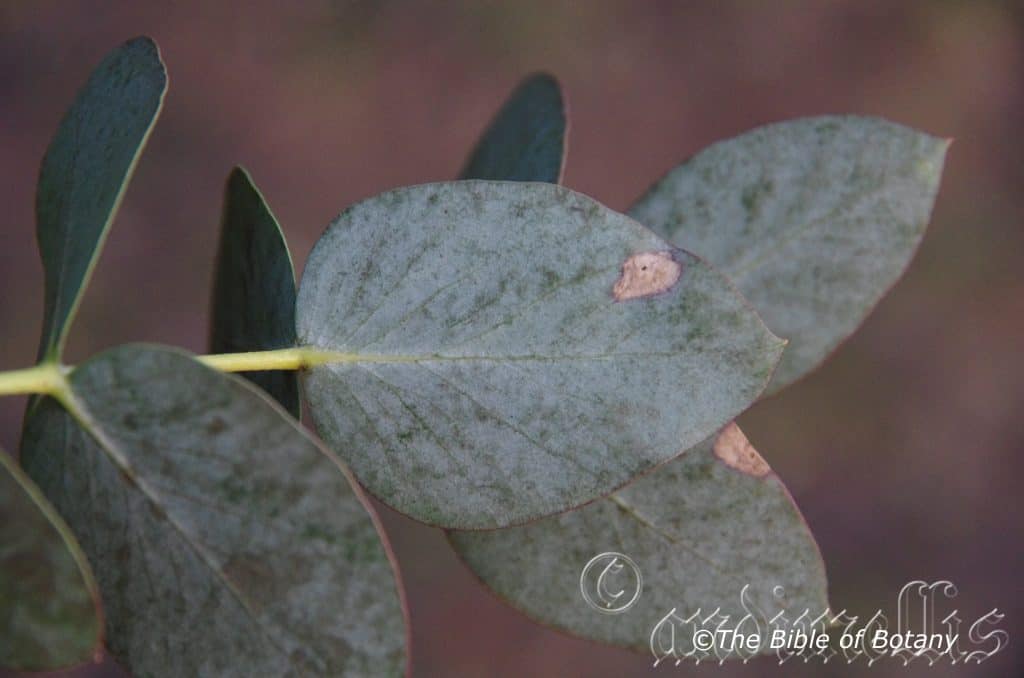
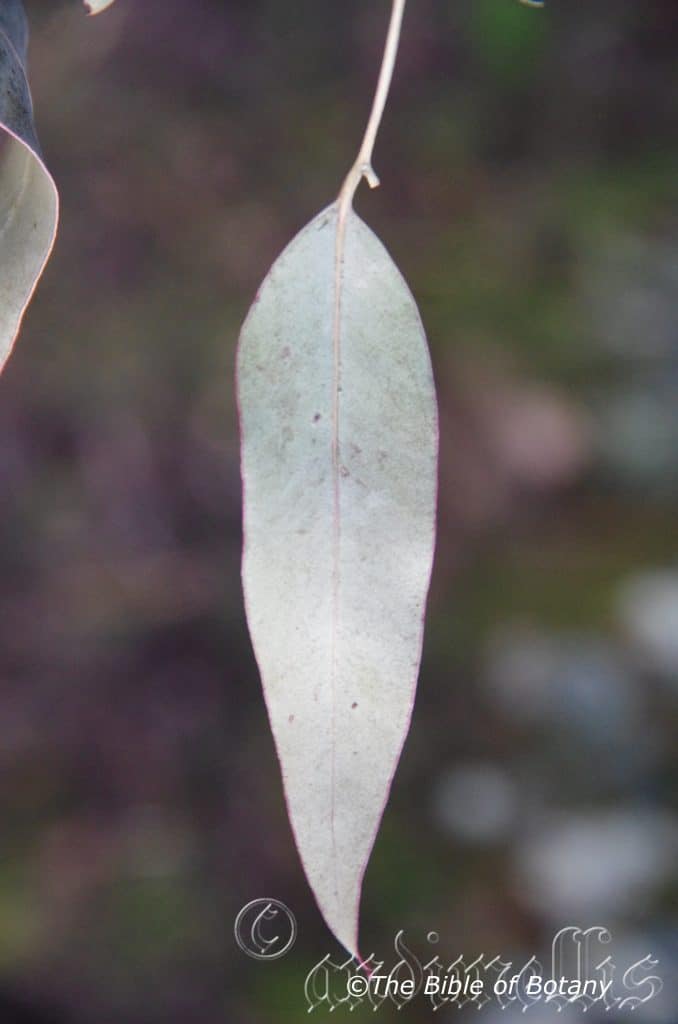
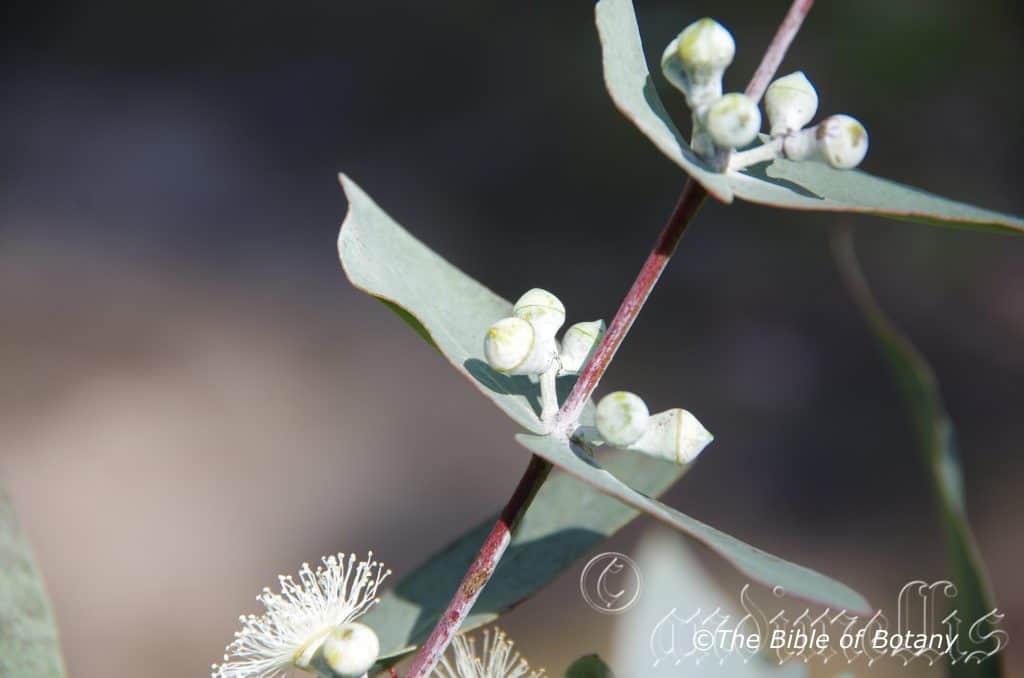
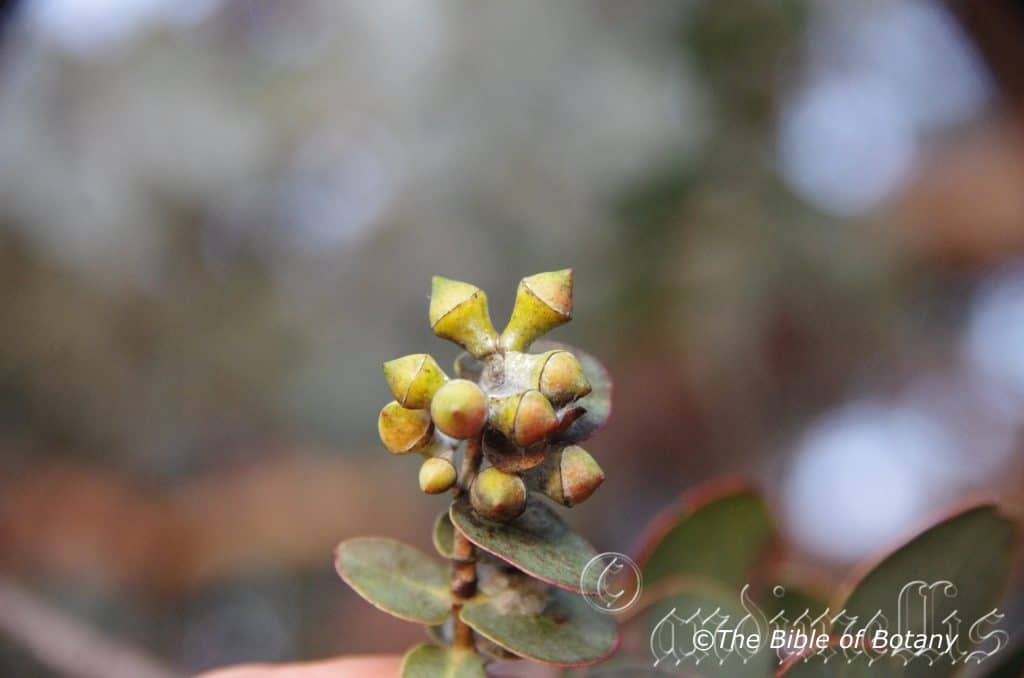
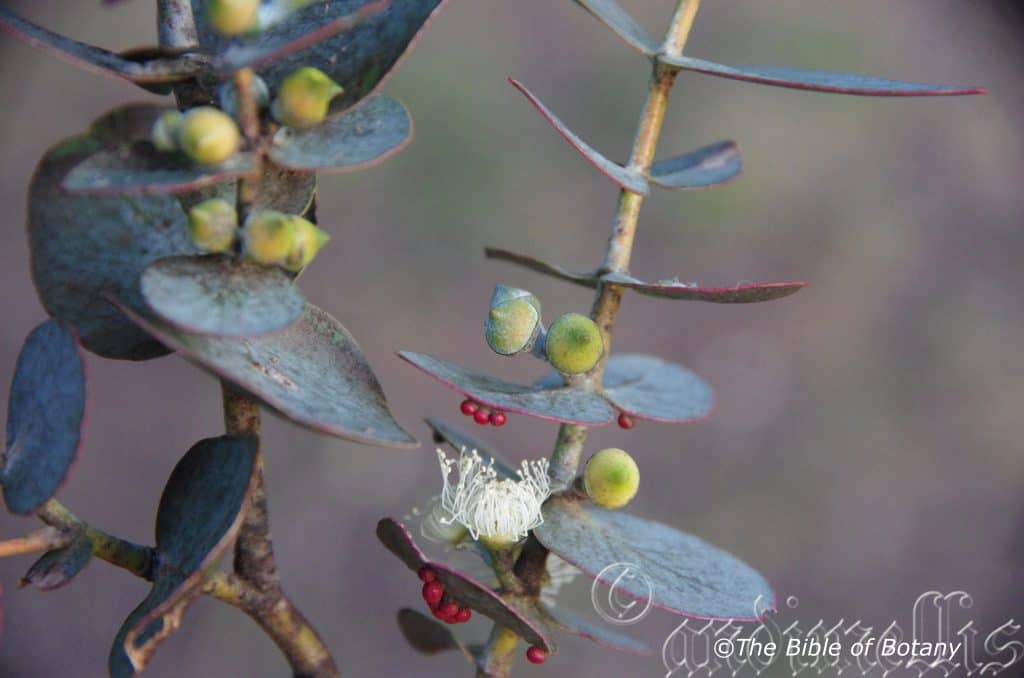


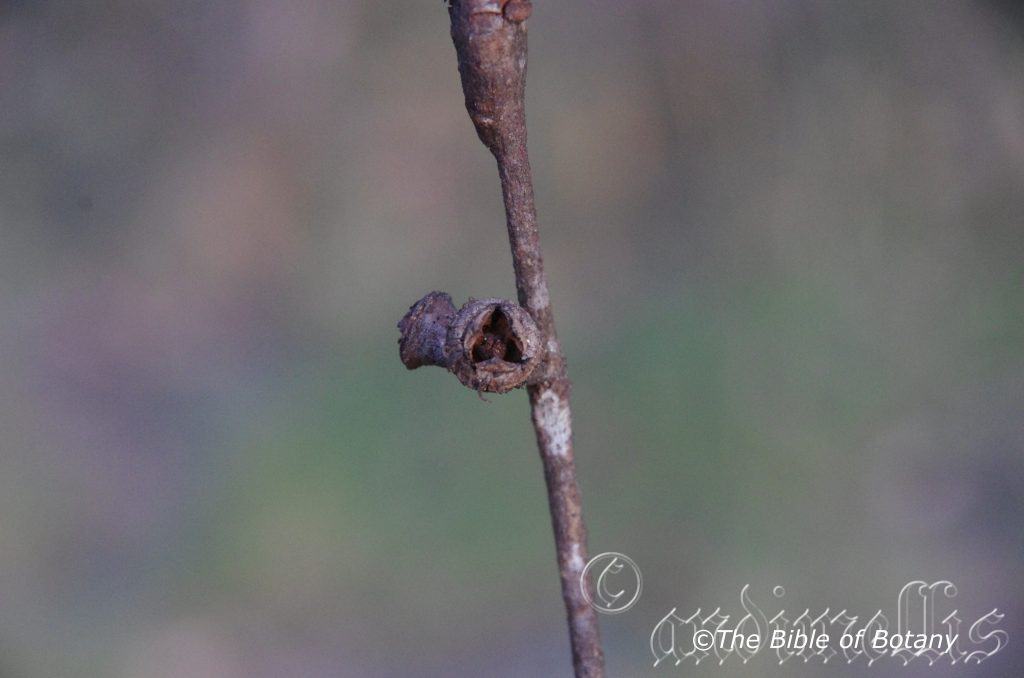


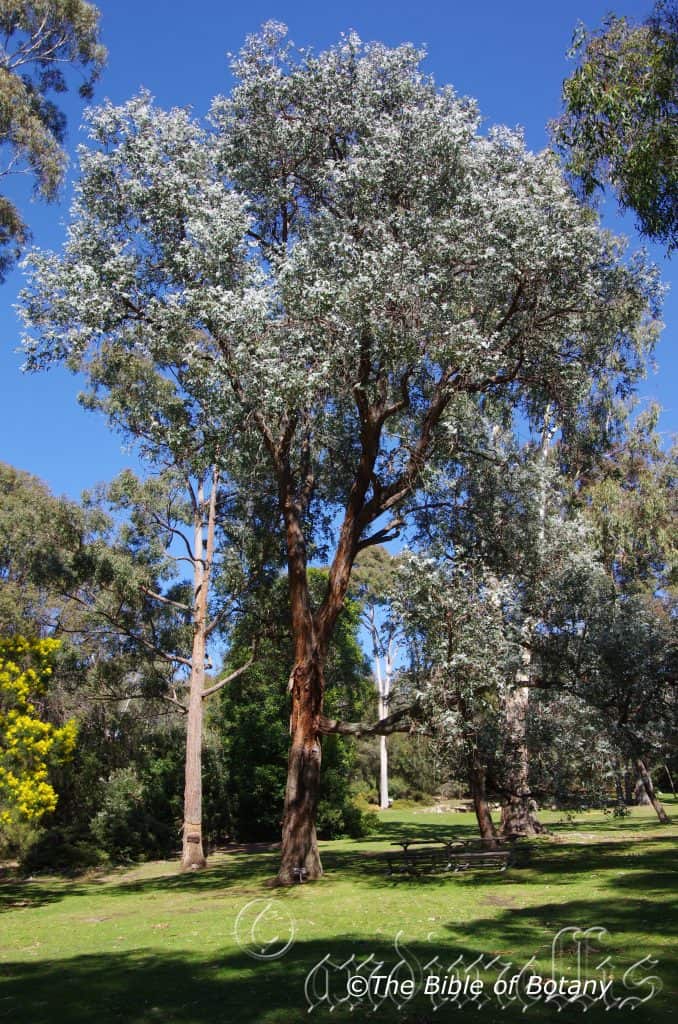
Eucalyptus cinerea
Classification:
Unranked: Eudicots
Clade: Rosids
Order: Myrtales
Family: Myrtaceae
Genus: From Eu, which is Greek a prefix for good or well and Kaluptos, which is Ancient Greek for to cover up. It refers to the stamens, which have a lid or cover over them in the bud stage prior to opening.
Specie: From Kónis, which is Ancient Greek, Cinis, which is Latin and later Cinerea, which is Latin for ash, ashen or ash colour. It refers to an organ or structure which is ash grey in colour. Here it is seen in the leaves, which are pale blueish-grey in colour.
Sub specie: Eucalyptus cinerea subsp. cinerea. From Kónis, which is Ancient Greek, Cinis, which is Latin and later Cinerea, which is Latin for ash, ashen or ash colour. It refers to an organ or structure which is ash grey in colour. Here it is seen in the leaves, which are pale blueish-grey in colour. From Kónis, which is Greek, Cinis, which is Latin and later Cinerea, which is Latin for ash, ashen or ash colour. It refers to an organ or structure which is ash grey in colour. Here it is seen in the leaves, which are pale blueish-grey in colour.
Eucalyptus cinerea subsp. triplex From Treîs, which is Ancient Greek, for 3 and Plicō, which is Latin for to fold or pleat. It refers to an organ or structure which is ash grey in colour. Here it is seen in the leaves, which are pale blueish-grey in colour. From Kónis, which is Greek, Cinis, which is Latin and later Cinerea, which is Latin for ash, ashen or ash colour. It refers to an organ or structure which is ash grey in colour. Here it is seen in the leaves, which are pale blueish-grey in colour.
Common Name: Mealy Stringybark.
Distribution:
Eucalyptus cinerea is found south from Wilpinjong in central eastern New South Wales to Hepburn in central Victoria.
There are several disjunct populations near Paroo in southern Queensland, Armidale in New South Wales, Belair National Park and Caroline Forest in southern South Australia.
https://avh.ala.org.au/occurrences/search?taxa=Eucalyptus+cinerea#tab_mapView
Habitat Aspect Climate:
Eucalyptus cinerea prefers full sun to light dappled shade. It grows in moist schlerophyll forests, moist mixed forests and in the transitional zones with open dry woodlands. The altitude ranges from 200 meters ASL to 1600 meters ASL.
The temperatures range from minus 6 degree in August to 35 degrees in January.
The rainfall ranges from lows of 650mm to an average of 1200mm annually.
Soil Requirements:
Eucalyptus cinerea prefers fertile loams to medium clays. The soils are usually derived from decomposed granites or sandstones. The soils pH ranges from 5.5pH to 7pH. It does not tolerate water logged soils.Non saline soils to moderately saline soils are tolerated.
Height & Spread:
Wild Plants: 10m to 15m by 3m to 6m.
Characteristics:
Eucalyptus cinerea has a rough thick, fibrous, furrowed longitudinally, grey over red-brown bark on the trunk and larger branches.
The juvenile stems are terete, dull ash blueish-grey and glaucous, while the opposite leaves are paired for many nodes and are sessile. It is orbicular to broadly ovate and measure 60mm to 780mm in length by 40mm to 55mm in width. The amplexicaul bases are lobed or rounded, while the apex are obtuse to obtuse-emarginate or pointed and glaucous. The intermediate opposite, ovate to lanceolate leaves’ petioles measure 4mm to 15mm in length while the laminas measure 48mm to 9 0mm in length by 20mm to 45mm in width. The alternate to sub alternate mature leaves’ petioles measure 4mm to 11mm in length. The lanceolate to slightly falcate concolourous leaves are dull grey-green to glaucous and measure 90mm to 140mm in length by 15 to 50m in width. The rounded or tapering to petiole bases, while the apexes are narrow acute or narrow acute with a small mucronate tip. The lateral veins are greater than 45° to midrib, which is slightly prominent on both laminas. The reticulation is feint and dense, while the intramarginal vein is distant from margin, with few to numerous island oil glands. Mature crowns are a mixture of juvenile, intermediate and mature leaves.
The inflorescences axillary unbranched has a peduncle to 2mm to 9mm in length while the 3 buds are sessile or sub sessile. The mature glaucous buds are rhomboidal and measure 6mm to 8mm in length by 3mm to 5mm in diameter. A scar is present and the conical operculum is discarded as the first white to creamy inflexed stamens emerge. They measure 4mm to 6mm in length. The cuneate, versatile anthers are dorsifixed and dehisce along longitudinal slits.
The creamy yellow style has a spreading base with 3 or 4 locules and measures 4mm to 6 mm in length.
The sessile or subsessile fruits are obconical to campanulate and measure 4mm to 7mm in length by 5mm to 9mm in diameter. The 3 or 4 valves are level with the rim or slightly exserted.
The grey-brown to blackish, ovoid or flattened-ovoid seeds are minutely pitted.
Subspecie Differences:
E. cinerea subsp. cinerea has a high proportion of opposite, sessile, orbicular to broadly ovate juvenile leaves in its mature crown.
E. cinerea subsp. triplex has a high proportion of opposite, petiolate, ovate intermediate leaves and alternate, petiolate, lanceolate adult leaves in the crown, but sessile leaves also may be present. It is restricted to granitic soils south-west of Canberra, Australian Capital Territory, a small population north-west of Captains Flat and in the Tinderry Nature Reserve in nearby New South Wales.
Wildlife:
The flowers Eucalyptus cinereaare average nectar and pollen producers but are very attractive to most honeyeaters, lorikeets and the many insects.
Cultivation:
Eucalyptus cinerea is a large gum tree which is only suitable for the largest gardens where a Eucalyptus is required. It is fast growing, growing up to 17 meters in 5 years once planted out. This can give the garden a quick established look with a great affect at an early age. In the garden good specimens may grow from 30 meters to 45 meters in height by 15 meters to 19 meters in diameter when grown in the open. Because of its size it should be planted well back from buildings.
Like all Eucalyptus spp. leaf drop, dropping of small branches means continual lawn maintenance but then this means good quantities of leaf litter mulch.
Eucalyptus cinerea can give quick protection, habitat and safe corridors for many birds. It is suitable for wind breaks especially when pruned to form multi trunk trees and for shelter trees on moist sandy pastures and sheep stations where soil compaction is not a problem.
Propagation:
Seeds: Sow into a seed raising mix. Cover the seeds with 2mm to 3mm of fine sand and place the trays in a warm sunny position. Keep the seeds moist but not wet. When the seedlings are 25mm to 50mm tall, prick them out and plant them into 50mm native tubes using a good organic mix.
Once the seedlings reach 200mm to 250mm in height plant them out into their permanent position. Mass plantings are best done in groups of 3 to 5 as a feature by planting them at 15 meter to 20 meter centers.
Fertilize using Seaweed, fish emulsion or organic chicken pellets soaked in water and apply the liquid on an alternate basis. Fertilize every two month until the trees are well established then every spring to ensure good growth and flowering.
Further Comments from Readers:
“Hi reader, it seems you use The Bible of Botany a lot. That’s great as we have great pleasure in bringing it to you! It’s a little awkward for us to ask, but our first aim is to purchase land approximately 1,600 hectares to link several parcels of N.P. into one at The Pinnacles NSW Australia, but we need your help. We’re not salespeople. We’re amateur botanists who have dedicated over 30 years to saving the environment in a practical way. We depend on donations to reach our goal. If you donate just $5, the price of your coffee this Sunday, We can help to keep the planet alive in a real way and continue to bring you regular updates and features on Australian plants all in one Botanical Bible. Any support is greatly appreciated. Thank you.”
In the spirit of reconciliation we acknowledge the Bundjalung, Gumbaynggirr and Yaegl and all aboriginal nations throughout Australia and their connections to land, sea and community. We pay our respect to their Elders past, present and future for the pleasures we have gained.
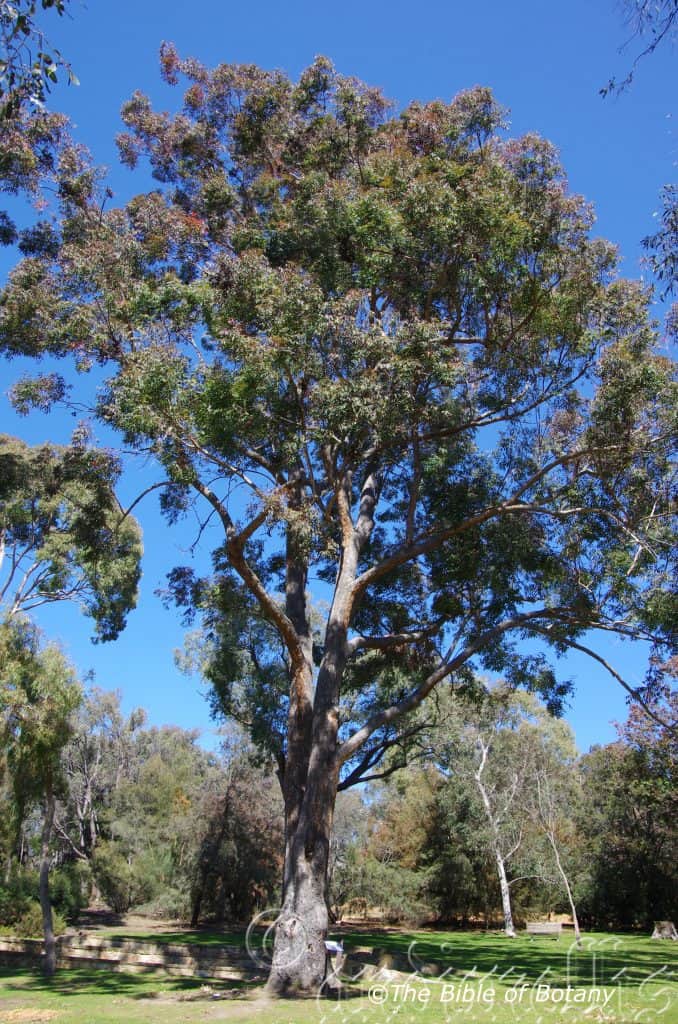
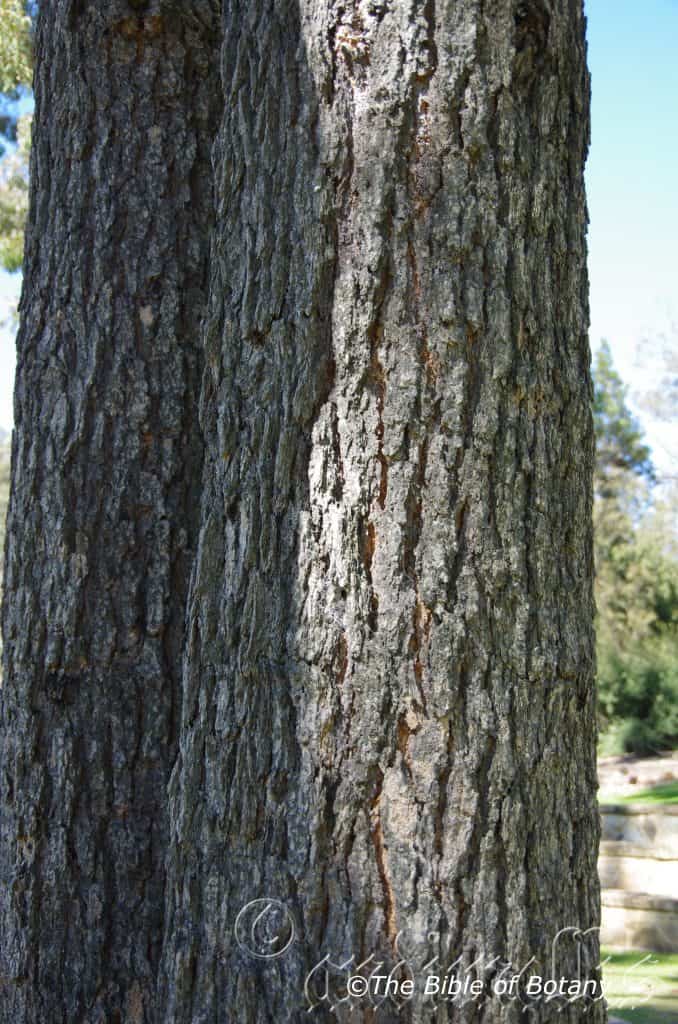
Eucalyptus cloeziana
Classification:
Unranked: Eudicots
Clade: Rosids
Order: Myrtales
Family: Myrtaceae
Genus: From Eu, which is Greek a prefix for good or well and Kaluptos, which is Ancient Greek for to cover up. It refers to the stamens, which have a lid or cover over them in the bud stage prior to opening.
Specie: Is probably named in honour of F. S. Cloez; 1817-1883, who was a French chemist but I have been unable to substantiate it 100mm.
Sub specie:
Common Name: Gympie Messmate.
Distribution:
Eucalyptus cloeziana is found in several disjunct populations south from the Dickson Range west of Cooktown in far north eastern Queensland to the base of Sugarloaf Mountain and eastward to the coast near Landsborough in south eastern Queensland.
https://avh.ala.org.au/occurrences/search?taxa=Eucalyptus+cloeziana#tab_mapView
Habitat Aspect Climate:
Eucalyptus cloeziana prefers full sun to light dappled shade. It grows in moist schlerophyll forests, moist mixed forests and in the transitional zones with rainforests. The altitude ranges from 10 meters ASL to 600 meters ASL.
The temperatures range from minus 3 degree in August to 35 degrees in January.
The rainfall ranges from lows of 750mm to an average of 1800mm annually.
Soil Requirements:
Eucalyptus cloeziana prefers fertile loams to medium clays. The soils are usually derived from decomposed black basalts. The soils pH ranges from 5.5pH to 7pH. It does not tolerate water logged soils.Non saline soils to moderately saline soils are tolerated.
Height & Spread:
Wild Plants: 40m to 55m by 20m to 25m.
Characteristics:
Eucalyptus cloeziana is a large tree which usually has a single trunk and in a forest situation may not branch for 80mm of its height. The bark is rough bark on most or the whole of the trunk and larger branches. The brown, grey or greyish-yellow bark is longitudinally fissured or with thick irregular tessellated scales. The smaller branches are orange-grey or yellowish-green and glabrous. The bark decorticates in large plates or flakes.
Eucalyptus cloeziana’s juvenile and coppice stems are terete and glaucous. The opposite disjunct, broad lanceolate leaves are concolourous, glossy, green and glabrous. The margins are entire.
The alternate, disjunct, lanceolate leaves of Eucalyptus cloeziana measure 80mm to 130mm in length by 10mm to 30mm in width. The terete petioles are channelled on the upper surface and measure 10mm to 15mm in length. The bases are tapering rounded while the apexes are acuminate. The discolourous laminas are dull to semi glossy, bluish-green to deep green and glabrous on the upper lamina while the lower lamina is paler. The margins are entire while the mid-vein is prominent on the lower lamina especially on the basal half. The lateral penniveins are visible on the both laminas while the intramarginal vein is well inside the margin.
The inflorescences of Eucalyptus cloezianaare born as auxiliary umbellasters along the stems. There are 4 to 7 individual white, cream or pale yellow flowers to an umbellaster. The new growth bearing the umbellasters is red, yellow or orange. The terete or angular peduncles are glabrous and measure 5mm to 10mm in length while the terete pedicels measure 1mm to 4mm in length. The ovoidal to globular buds are pale greenish-yellow to yellow, glabrous and measure 5mm to 8mm in length by 3mm to 4mm in diameter. The hemispherical or conical calyptra is as long as or slightly shorter than and as wide as the hypanthium. A bud scar is present.
The white stamens measure 4mm to 5mm in length while the creamy-yellow style measures 2mm to 3mm in length. The disc is creamy-yellow to yellow. The flowers appear from mid-September to November.
The fruits of Eucalyptus cloeziana are ribbed, hemispherical or globular capsules known as gum nuts. The deep green gum nuts measure 5mm to 10mm in length by 6mm to 12mm in diameter at the widest point. The disc is inserted with the 3 or usually 4 valves being level or exserted.
The cuboidal or elongated seeds are yellow-brown.
Wildlife:
The flowers Eucalyptus cloeziana are average nectar and pollen producers but are very attractive to most honeyeaters and lorikeets because of the sheer volume of flowers.
Cultivation:
Eucalyptus cloeziana is a large gum tree which is only suitable for the largest gardens where a Eucalyptus is required. It is fast growing, growing up to 17 meters in 5 years once planted out. This can give the garden a quick established look with a great affect at an early age. In the garden good specimens may grow from 30 meters to 45 meters in height by 15 meters to 19 meters in diameter when grown in the open. Because of its size it should be planted well back from buildings.
Like all Eucalyptus spp. leaf drop, dropping of small branches means continual lawn maintenance but then this means good quantities of leaf litter mulch.
Eucalyptus cloeziana can give quick protection, habitat and safe corridors for many birds. It is suitable for wind breaks especially when pruned to form multi trunk trees and for shelter trees on moist sandy pastures and sheep stations where soil compaction is not a problem.
Propagation:
Seeds: Sow into a seed raising mix. Cover the seeds with 2mm to 3mm of fine sand and place the trays in a warm sunny position. Keep the seeds moist but not wet. When the seedlings are 25mm to 50mm tall, prick them out and plant them into 50mm native tubes using a good organic mix.
Once the seedlings reach 200mm to 250mm in height plant them out into their permanent position. Mass plantings are best done in groups of 3 to 5 as a feature by planting them at 15 meter to 20 meter centers.
Fertilize using Seaweed, fish emulsion or organic chicken pellets soaked in water and apply the liquid on an alternate basis. Fertilize every two month until the trees are well established then every spring to ensure good growth and flowering.
Further Comments from Readers:
“Hi reader, it seems you use The Bible of Botany a lot. That’s great as we have great pleasure in bringing it to you! It’s a little awkward for us to ask, but our first aim is to purchase land approximately 1,600 hectares to link several parcels of N.P. into one at The Pinnacles NSW Australia, but we need your help. We’re not salespeople. We’re amateur botanists who have dedicated over 30 years to saving the environment in a practical way. We depend on donations to reach our goal. If you donate just $5, the price of your coffee this Sunday, We can help to keep the planet alive in a real way and continue to bring you regular updates and features on Australian plants all in one Botanical Bible. Any support is greatly appreciated. Thank you.”
In the spirit of reconciliation we acknowledge the Bundjalung, Gumbaynggirr and Yaegl and all aboriginal nations throughout Australia and their connections to land, sea and community. We pay our respect to their Elders past, present and future for the pleasures we have gained.
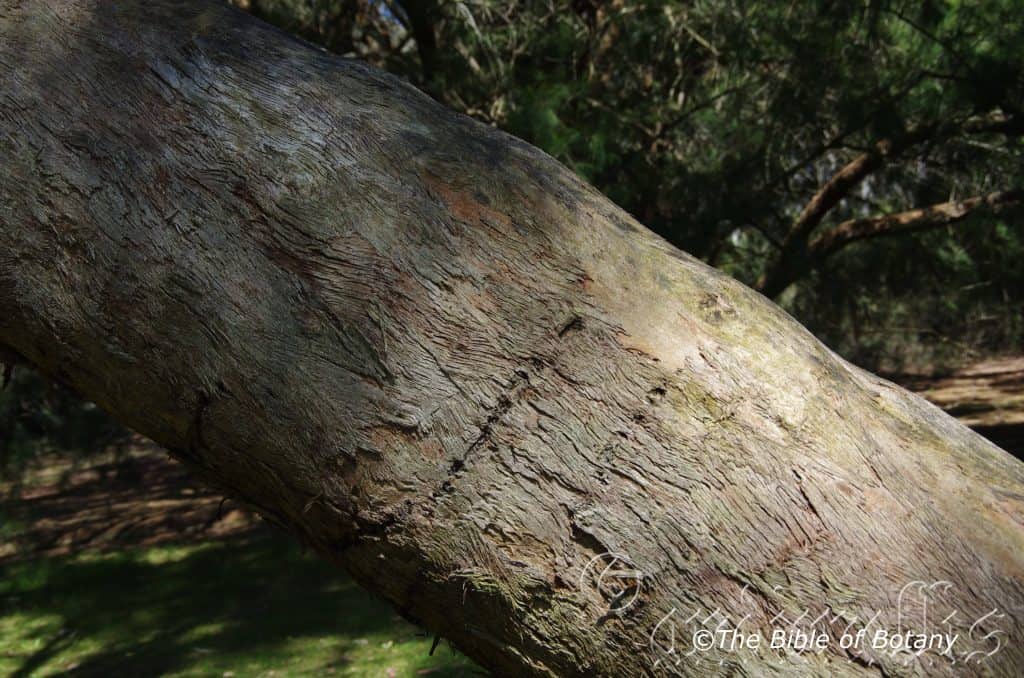
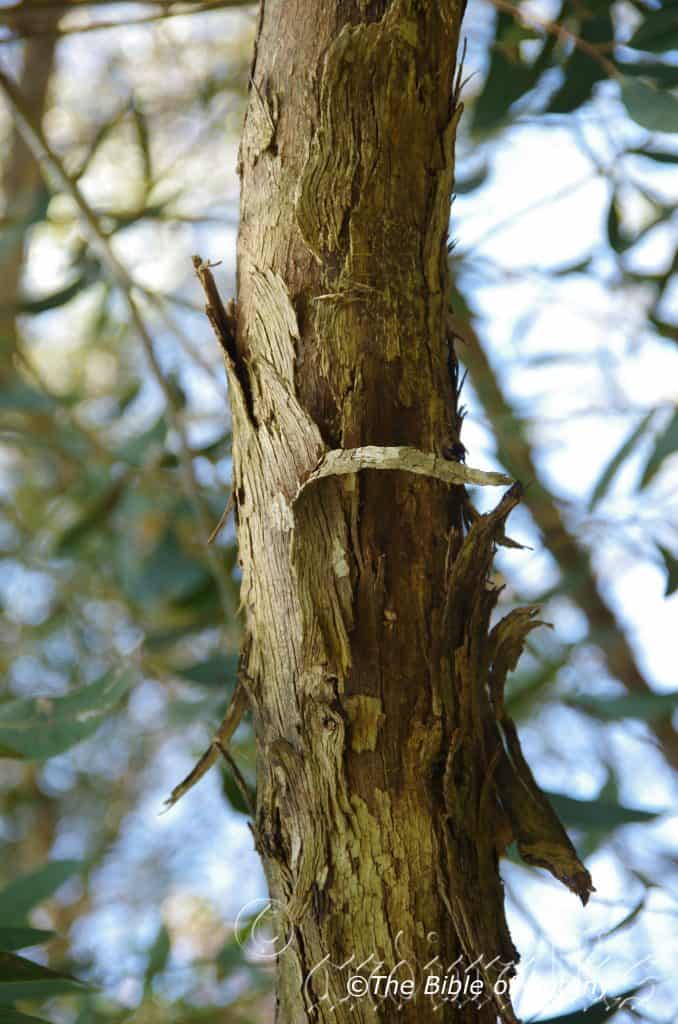
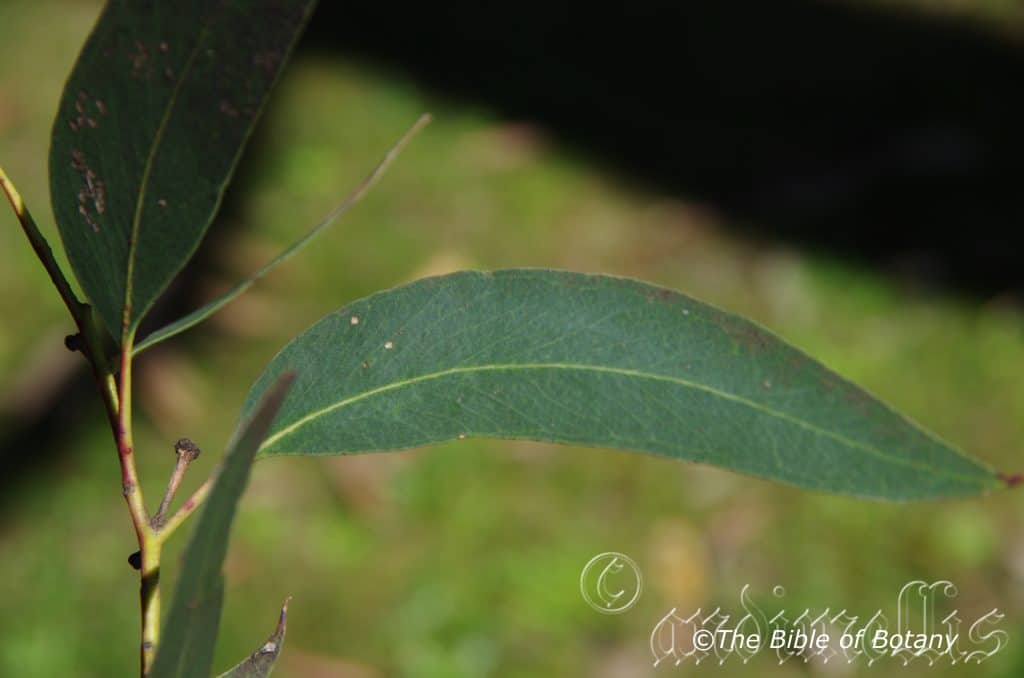
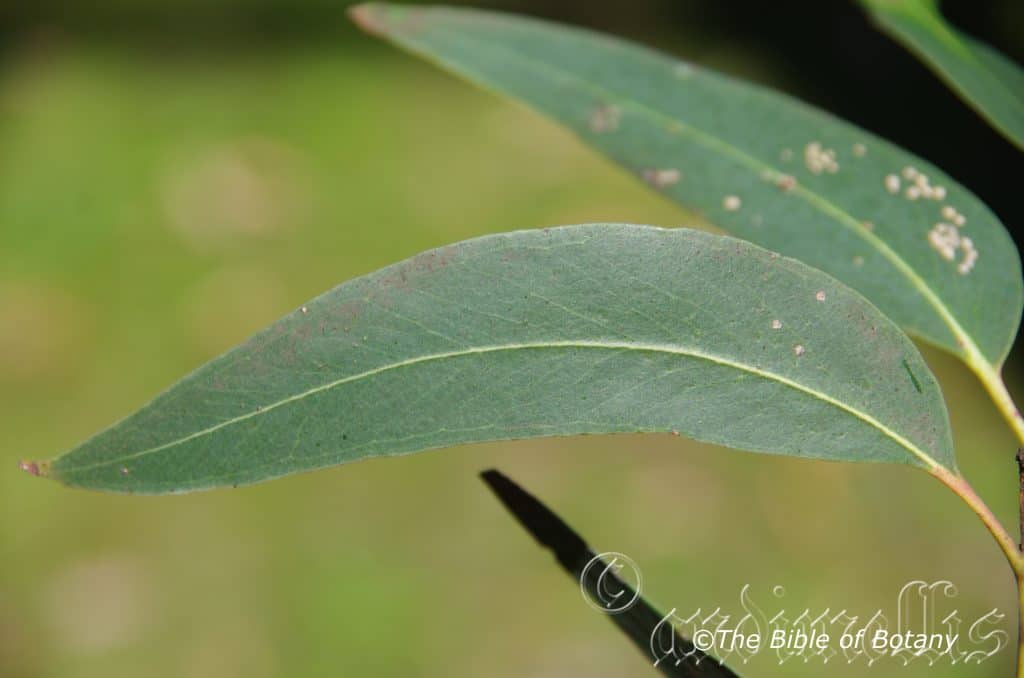



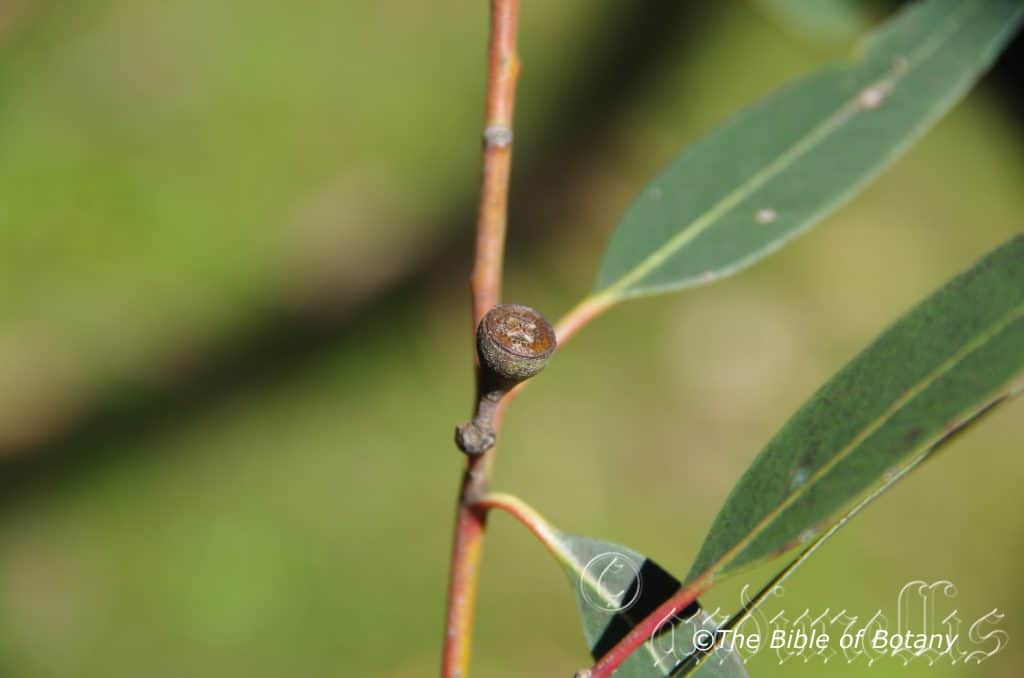
Eucalyptus consideniana
Classification:
Unranked: Eudicots
Clade: Rosids
Order: Myrtales
Family: Myrtaceae
Genus: From Eu, which is Greek a prefix for good or well and Kaluptos, which is Ancient Greek for to cover up. It refers to the stamens, which have a lid or cover over them in the bud stage prior to opening.
Specie: Is named in honour of Denis Considen, 1760 –1815, who was a British born Australian who came to Australia on the first fleet as an assistant surgeon on the Scarborough. Whilst in New South Wales he studied natural history and took a keen interest in the use of native plants to alleviate dysentery and scurvy. He was a founder of the Eucalyptus oil industry extracting oil from Eucalyptus piperita.
Sub specie:
Common Name: Prickly Stringybark or Yertchuk (The local aboriginal name for the tree).
Distribution:
Eucalyptus consideniana is found in a scattered distribution south and east of a line from Mt Coricudgy to Booral in central eastern New South Wales and Ottway in south eastern Victoria. There is a disjunct population near Dunkeld in the southern Grampians of Victoria. It is mainly found on and east of the Great Dividing Range except where it extends further west around Euroa in central Victoria.
https://avh.ala.org.au/occurrences/search?taxa=Eucalyptus+consideniana#tab_mapView
Habitat Aspect Climate:
Eucalyptus consideniana prefers full sun to light dappled shade. It grows in dry schlerophyll forests or woodlands on flat or undulating plains. The altitude ranges from 20 meters ASL to 1200 meters ASL.
The temperatures range from minus 3 degree in August to 35 degrees in January.
The rainfall ranges from lows of 600mm to an average of 1600mm annually.
Soil Requirements:
Eucalyptus consideniana prefers average fertility on skeletal sandy loams to light fatty clays or heavy clays. The soils are usually derived from decomposed sandstones or fractured shales. The soils pH ranges from 4.5pH to 7pH. It does not tolerate water logged soils.Non saline soils to moderately saline soils are tolerated.
Height & Spread:
Wild Plants: 20m to 30m by 15m to 20m.
Characteristics:
Eucalyptus consideniana is a medium tree which usually has a single trunk and in a forest situation may not branch for 80mm of its height. The bark is shortly fibrous on most or the whole of the trunk and larger branches. The bark is pale grey while the smaller branches are white and glabrous. The bark decorticates in short ribbons.
Eucalyptus consideniana’s juvenile and coppice stems are terete and glaucous. The opposite disjunct, ovate leaves are concolourous, dull, grey-green and glabrous. The margins are entire.
The alternate, disjunct, lanceolate leaves of Eucalyptus consideniana measure 80mm to 140mm in length by 12mm to 25mm in width. The terete petioles measure 10mm to 20mm in length. The bases are tapering while the apexes are narrow acute. The concolourous laminas are semi glossy to glossy, grey-green and glabrous. The margins are entire while the mid-vein is slightly prominent on the lower lamina especially on the basal half. The lateral penniveins are visible on the both laminas while the intramarginal vein loops well inside the margin.
The inflorescences of Eucalyptus considenianaare born as auxiliary umbellasters along the stems. There are 11 to15 individual white, flowers to an umbellaster. The new growth bearing the umbellasters is yellow or orange. The terete or angular peduncles are glabrous and measure 5mm to 14mm in length while the terete pedicels measure 4mm to 6mm in length. The clavate buds are pale greenish-yellow to yellow, glabrous and measure 4mm to 7mm in length by 3mm to 4mm in diameter. The hemispherical calyptra is usually minutely apiculate and is slightly shorter than and as wide as the hypanthium. A bud scar is absent.
The white stamens measure 5mm to 8mm in length. The outer stamens are usually infertile. The creamy-yellow style measures 3mm to 5mm in length. The disc is creamy-yellow to yellow. The flowers appear from mid-September to November.
The fruits of Eucalyptus consideniana are ribbed, conical, pyriform or clavate capsules known as gum nuts. The deep green gum nuts measure 5mm to 10mm in length by 6mm to 8mm in diameter at the widest point. The disc is flat or at times slightly exserted usually with 4 or at times 3 or 5 valves which are enclosed or level with the rim.
Wildlife:
The flowers Eucalyptus consideniana are average nectar and pollen producers but are very attractive to most honeyeaters, lorikeets, flying foxes, possums and many insects.
Cultivation:
Eucalyptus consideniana is a medium gum tree which is only suitable for large gardens where a Eucalyptus is required. This can give the garden a quick established look with a great affect at an early age. In the garden good specimens may grow from 15 meters to 20 meters in height by 15 meters to 20 meters in diameter when grown in the open. Because of its spread it should be planted well back from buildings.
Like all Eucalyptus spp. leaf drop, dropping of small branches means continual lawn maintenance but then this means good quantities of leaf litter mulch.
Eucalyptus consideniana can give quick protection, habitat and safe corridors for many birds. It is suitable for wind breaks especially when pruned to form multi trunk trees and for shelter trees on moist sandy pastures and sheep stations where soil compaction is not a problem.
Propagation:
Seeds: Sow into a seed raising mix. Cover the seeds with 2mm to 3mm of fine sand and place the trays in a warm sunny position. Keep the seeds moist but not wet. When the seedlings are 25mm to 50mm tall, prick them out and plant them into 50mm native tubes using a good organic mix.
Once the seedlings reach 200mm to 250mm in height plant them out into their permanent position. Mass plantings are best done in groups of 3 to 5 as a feature by planting them at 15 meter to 20 meter centers.
Fertilize using Seaweed, fish emulsion or organic chicken pellets soaked in water and apply the liquid on an alternate basis. Fertilize every two month until the trees are well established then every spring to ensure good growth and flowering.
Further Comments from Readers:
“Hi reader, it seems you use The Bible of Botany a lot. That’s great as we have great pleasure in bringing it to you! It’s a little awkward for us to ask, but our first aim is to purchase land approximately 1,600 hectares to link several parcels of N.P. into one at The Pinnacles NSW Australia, but we need your help. We’re not salespeople. We’re amateur botanists who have dedicated over 30 years to saving the environment in a practical way. We depend on donations to reach our goal. If you donate just $5, the price of your coffee this Sunday, We can help to keep the planet alive in a real way and continue to bring you regular updates and features on Australian plants all in one Botanical Bible. Any support is greatly appreciated. Thank you.”
In the spirit of reconciliation we acknowledge the Bundjalung, Gumbaynggirr and Yaegl and all aboriginal nations throughout Australia and their connections to land, sea and community. We pay our respect to their Elders past, present and future for the pleasures we have gained.
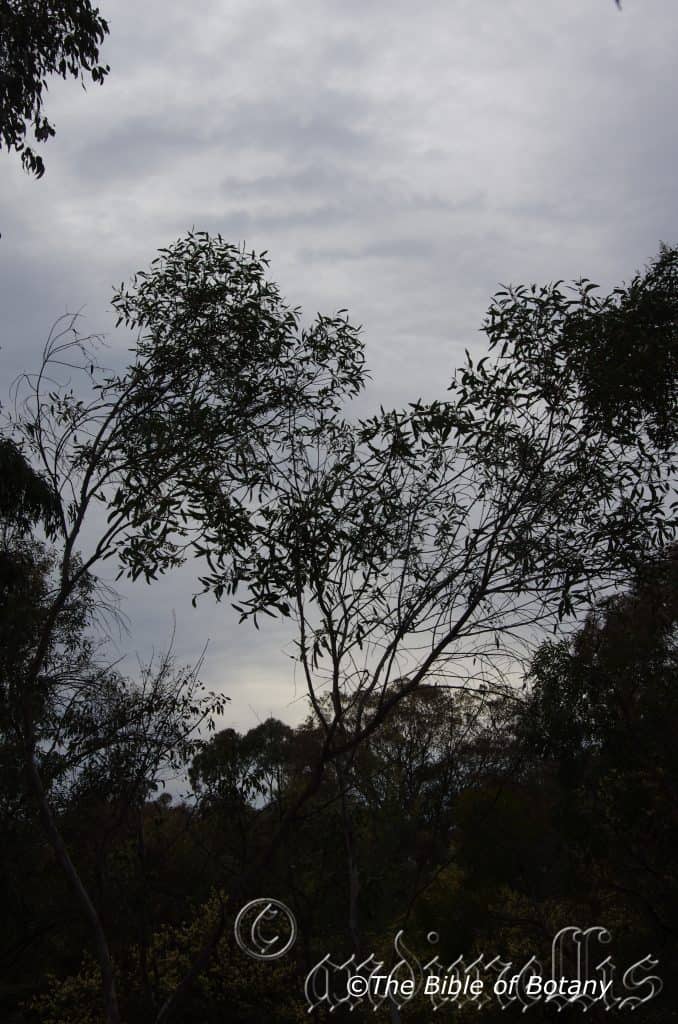



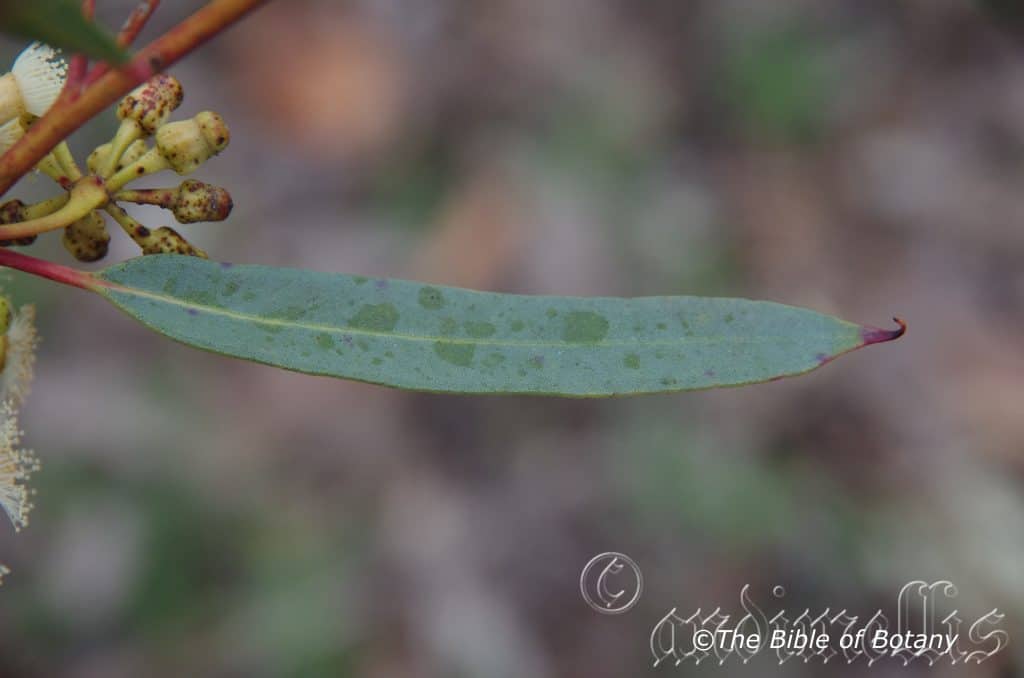








Eucalyptus cooperiana
Classification:
Unranked: Eudicots
Clade: Rosids
Order: Myrtales
Family: Myrtaceae
Genus: From Eu, which is Greek a prefix for good or well and Kaluptos, which is Ancient Greek for to cover up. It refers to the stamens, which have a lid or cover over them in the bud stage prior to opening.
Specie: Is named in honour of E. Cooper; 1829–1918, who was an American horticulturalist in California, responsible for introducing many species of Eucalyptus in that state.
Sub specie:
Common Name: Coopers Mallee or Many Flowered Mallee.
Distribution:
Eucalyptus cooperiana is found along the far south coast of Western Australia within 100 kilometres of the coast from Ravensthorpe Range in the east to the Eyre bird observatory in the west.
https://avh.ala.org.au/occurrences/search?taxa=Eucalyptus+cooperiana#tab_mapView
Habitat Aspect Climate:
Eucalyptus cooperiana prefers full sun. It grows in tall heaths. The altitude ranges from 10 meters ASL to 100 meters ASL.
The temperatures range from 3 degrees in August to 36 degrees in January.
The rainfall ranges from lows of 400mm to an average of 620mm annually.
Soil Requirements:
Eucalyptus cooperiana prefers to grow well back from the frontal dunes on the coastal plains. The soils are white, yellow or grey sands, light fatty clays usually over limestone. The soils are usually derived from old accumulated beach sands or windblown sands. The soils pH ranges from 6pH to 7pH. It does not tolerate water logged soils.Non saline soils to the high end of moderately saline soils are tolerated as are salt laden winds.
Height & Spread:
Wild Plants: 2m to 9m by 3m to 6m.
Characteristics:
Eucalyptus cooperiana is a large mallee which has several slanting or even gnarled trunks. The bark is smooth and white, yellowish or tan on the trunk and larger branches turning orange-brown, green or tan and glossy on the smaller branches and branchlets. The bark decorticates in small patches or short ribbons.
Eucalyptus cooperiana’s juvenile and coppice stems are terete and glaucous. The opposite disjunct, ovate leaves and measure 50mm to 100mm in length by 40mm to 90mm. The concolourous laminas are dull, grey-green and glabrous. The margins are entire.
The alternate, disjunct, broad lanceolate leaves to oblong-ovate of Eucalyptus cooperiana measure 60mm to 120mm in length by 10mm to 18mm in width. The terete peduncles measure 7mm to 13mm in length. The bases are tapering rounded while the apexes are acuminate to acute with a short to long apiculate tip. The concolourous laminas are dull to semi glossy, grey-green to mid blue-green, glabrous and glaucous. The margins are entire while the mid vein is moderately prominent on the lower lamina and slightly prominent on the upper lamina especially on the basal half. The lateral penniveins are not visible on either laminas.
The inflorescences of Eucalyptus cooperianaare born as auxiliary umbellasters along the stems. There are five to seven usually seven individual white or cream flowers to an umbellaster. The new growth bearing the umbellasters is pale creamy-yellow or pale greenish-yellow. The terete or angular peduncles are glabrous and measure 10mm to 15mm in length while the terete pedicels measure 3mm to 5mm in length. The cylindrical-urceolate to urceolate buds have an obtuse base and are pale creamy-yellow or pale greenish-yellow and glabrous. They measure 3.5mm to 6mm in length by 3mm to 4mm in diameter. The hemispherical calyptra is shorter than and is slightly narrower than or as wide as the hypanthium. A bud scar is absent.
The white stamens measure 3.5mm to 6mm in length while the cream anthers are orbicular and dorsifixed. The creamy-yellow style measures 2mm to 3mm in length. The disc is creamy-yellow to yellow. The flowers appear from October to December or January to March.
The fruits of Eucalyptus cooperiana are rough, urceolate capsules known as gum nuts. The deep green gum nuts measure 5mm to 7mm in length by 5mm to 8mm in diameter at the widest point. The disc is inserted with the 3 or 4 valves being inserted.
Wildlife:
The flowers Eucalyptus cooperiana are average nectar and pollen producers but are very attractive to most honeyeaters, lorikeets, and many insects because of the sheer volume of flowers.
Cultivation:
Eucalyptus cooperiana is a large mallee which is suitable for the small gardens where a Eucalyptus is required. It is fast growing which gives the garden a quick established look with a great affect at an early age. In the garden good specimens may grow from 5 meters to 7 meters in height by 5 meters to 7 meters in diameter when grown in the open.
Like all Eucalyptus spp. leaf drop, dropping of small branches means continual lawn maintenance but then this means good quantities of leaf litter mulch.
Eucalyptus cooperiana can give quick protection, habitat and safe corridors for many birds. It is ideally suitable for wind breaks especially when pruned to form multi trunk mallees.
Eucalyptus cooperiana can be used like many small Eucalyptus spp. to create that little bit of Australiana in the back yard.Often floral characteristics of a plant dictate our selection of plants for the garden. Remember that once a Eucalyptus spp.; or in fact any tree, reaches a reasonable size, its trunk or bark can are the most prominent features seen. Among the eucalypts there are many different types of barks which include some of our beautiful peppermint barks. Grouping, mallees as mallees or as single trunk trees can add immeasurably to the interest within a small space. Eucalyptus cooperiana is one of those species whose multi stems and bark contrasts well with single stem species.
Small shrubs can be used to emphasize the open spaces surrounding a mallee or a small tree especially when mass plantings are done.
Eucalyptus cooperiana can look great when placed in the corner against a fence to add privacy and remove the barrenness of the yard while giving extra depth.
Propagation:
Seeds: Sow into a seed raising mix. Cover the seeds with 2mm to 3mm of fine sand and place the trays in a warm sunny position. Keep the seeds moist but not wet. When the seedlings are 25mm to 50mm tall, prick them out and plant them into 50mm native tubes using a good organic mix.
Once the seedlings reach 200mm to 250mm in height plant them out into their permanent position. Mass plantings are best done in groups of 3 to 5 as a feature by planting them at 8 meter to 10 meter centers for a park like feature or at around 4 meters where a windbreak or wildlife corridor is required.
Fertilize using Seaweed, fish emulsion or organic chicken pellets soaked in water and apply the liquid on an alternate basis. Fertilize every two month until the trees are well established then every spring to ensure good growth and flowering.
Further Comments from Readers:
“Hi reader, it seems you use The Bible of Botany a lot. That’s great as we have great pleasure in bringing it to you! It’s a little awkward for us to ask, but our first aim is to purchase land approximately 1,600 hectares to link several parcels of N.P. into one at The Pinnacles NSW Australia, but we need your help. We’re not salespeople. We’re amateur botanists who have dedicated over 30 years to saving the environment in a practical way. We depend on donations to reach our goal. If you donate just $5, the price of your coffee this Sunday, We can help to keep the planet alive in a real way and continue to bring you regular updates and features on Australian plants all in one Botanical Bible. Any support is greatly appreciated. Thank you.”
In the spirit of reconciliation we acknowledge the Bundjalung, Gumbaynggirr and Yaegl and all aboriginal nations throughout Australia and their connections to land, sea and community. We pay our respect to their Elders past, present and future for the pleasures we have gained.




Eucalyptus cosmophylla
Classification:
Unranked: Eudicots
Clade: Rosids
Order: Myrtales
Family: Myrtaceae
Genus: From Eu, which is Greek a prefix for good or well and Kaluptos, which is Ancient Greek for to cover up. It refers to the stamens, which have a lid or cover over them in the bud stage prior to opening.
Specie: From Kósmos, which is Ancient Greek for orderly or an arrangement and Pullen/Phýllon, which is Ancient Greek for a leaf. It refers to leaves, which are arranged in a neat set order.
Sub specie:
Common Name:
Distribution:
Eucalyptus cosmophylla is found in southern South Australia on the eastern side of Vincent Gulf. It is found south from Horsnell Gully Conservation Park to Goolwa and across to the western Tip of Kangaroo Island. There are two disjunct populations one above the falls at Waterfall Gully west of Port Augusta and the other at Cherry Gardens in the Mount Lofty Ranges.
https://avh.ala.org.au/occurrences/search?taxa=Eucalyptus+cosmophylla#tab_mapView
Habitat Aspect Climate:
Eucalyptus cosmophylla prefers full sun. It grows in dry schlerophyll forests and heaths. The altitude ranges from 10 meters ASL to 520 meters ASL.
The temperatures range from minus 3 degree in August to 35 degrees in January.
The rainfall ranges from lows of 250mm to an average of 800mm annually.
Soil Requirements:
Eucalyptus cosmophylla prefers fertile loams to medium clays. The soils are usually derived from decomposed black basalts. The soils pH ranges from 5.5pH to 7pH. It does not tolerate water logged soils.Non saline soils to moderately saline soils are tolerated as are salt laden winds.
Height & Spread:
Wild Plants: 4m to 10m by 2m to 5m.
Characteristics:
Eucalyptus cosmophylla is a small mallee with a single trunk to 10 meters but frequently is found to grow as a multi stemmed mallee. The bark is almost entirely smooth with pale chalky grey, whitish and pinkish areas for the whole of the trunk and branches. The bark decorticates in small to large patches revealing a pinkish under bark.
Eucalyptus cosmophylla’s juvenile and coppice stems are terete and glaucous. The opposite disjunct leaves are at first opposite and narrow elliptical to broad elliptic before becoming ovate-orbicular. The concolourous laminas are mid blue-green and glabrous. The margins are entire.
The alternate, disjunct, lanceolate to broad lanceolate or rarely narrow lanceolate leaves of Eucalyptus cosmophylla measure 100mm to 150mm in length by 20mm to 40mm in width. The terete petioles measure 10mm to 30mm in length. The slightly oblique bases are tapering rounded while the apexes are acuminate. The coriaceous, concolourous laminas are dull, bluish-green to grey-green and glabrous. The margins are entire while the mid vein is prominent on the lower lamina. The lateral penniveins are faintly visible on the both laminas while the intramarginal vein is well inside the margin.
The inflorescences of Eucalyptus cosmophyllaare born as auxiliary umbellasters along the stems. There are 3 individual white flowers to an umbellaster. The new growth bearing the umbellasters is reddish-green, pinkish-green, pink or red. The terete peduncles are glabrous and measure 3mm to 6mm in length while the terete pedicels measure 0mm to 3mm in length. The ovoidal or ellipsoidal buds are reddish-green, pinkish-green, pink or red, are covered in very fine tuberculate lumps and measure 12mm to 16mm in length by 9mm to 11mm in diameter. The hemispherical or shortly conical calyptra has a rostrate apex and is much shorter than and is as wide as the hypanthium. A bud scar is absent.
The white stamens measure 8mm to 10mm in length. The cream, oblong anthers are dorsifixed and are all fertile. The creamy-yellow style measures 7mm to 8mm in length. The disc is pale crimson to yellow. The flowers appear from mid-July to November.
The fruits of Eucalyptus cosmophylla are 2 ribbed, cylindrical to hemispherical woody capsules known as gum nuts. The deep green gum nuts measure 10mm to 17mm in length by 12mm to 20mm in diameter at the widest point. The hypanthium has a thick rim while the disc is inserted with the 4 or usually 5 triangular valves are level or raised from the disc.
The brown seeds are polyhedral. There is a large convex surface along one side, with a narrow wing along the main edges.
Wildlife:
The flowers Eucalyptus cosmophylla are average nectar and pollen producers but are very attractive to most honeyeaters and lorikeets because of the sheer volume of flowers.
Cultivation:
Eucalyptus cosmophylla is a large mallee or small tree is ideally suitable for small gardens where a Eucalyptus is required. It is fast growing giving the garden an established look with a great affects at an early age. It looks very affective when planted with other mallees with contrasting foliage and growth habits. Another method is to grow one or two as trees and interplant with several plants that have been cut to induce the mallee growth. In the garden good specimens may grow from 8 meters to 12 meters in height by 3 meters to 5 meters in diameter when grown in the open as a single trunk tree or 4 meters to 5 meters in height by 4 meters to 6 meters as a mallee when grown in the open.
Like all Eucalyptus spp. leaf drop, dropping of small branches means continual lawn maintenance but then this means good quantities of leaf litter mulch.
Eucalyptus cosmophylla can give quick protection, habitat and safe corridors for many birds. It is ideally suitable for wind breaks especially when pruned to form multi trunk mallees.
Eucalyptus cosmophylla can be used like many small Eucalyptus spp. to create that little bit of Australiana in the back yard.Often floral characteristics of a plant dictate our selection of plants for the garden. Remember that once a Eucalyptus spp.; or in fact any tree, reaches a reasonable size, its trunk or bark can are the most prominent features seen. Among the eucalypts there are many different types of barks which include some of our beautiful peppermint barks. Grouping, mallees as mallees or as single trunk trees can add immeasurably to the interest within a small space. Eucalyptus cosmophylla is one of those species whose multi stems and bark contrasts well with single stem species.
Small shrubs can be used to emphasize the open spaces surrounding a mallee or a small tree especially when mass plantings are done.
Eucalyptus cosmophylla can look great when placed in the corner against a fence to add privacy and remove the barrenness of the yard while giving extra depth.
Propagation:
Seeds: Sow into a seed raising mix. Cover the seeds with 2mm to 3mm of fine sand and place the trays in a warm sunny position. Keep the seeds moist but not wet. When the seedlings are 25mm to 50mm tall, prick them out and plant them into 50mm native tubes using a good organic mix.
Once the seedlings reach 200mm to 250mm in height plant them out into their permanent position. Mass plantings are best done in groups of 3 to 5 as a feature by planting them at 4 meter to 5 meter centers as a tree or 5 meters to 6 meters as a mallee.
Fertilize using Seaweed, fish emulsion or organic chicken pellets soaked in water and apply the liquid on an alternate basis. Fertilize every two month until the trees are well established then every spring to ensure good growth and flowering.
Further Comments from Readers:
“Hi reader, it seems you use The Bible of Botany a lot. That’s great as we have great pleasure in bringing it to you! It’s a little awkward for us to ask, but our first aim is to purchase land approximately 1,600 hectares to link several parcels of N.P. into one at The Pinnacles NSW Australia, but we need your help. We’re not salespeople. We’re amateur botanists who have dedicated over 30 years to saving the environment in a practical way. We depend on donations to reach our goal. If you donate just $5, the price of your coffee this Sunday, We can help to keep the planet alive in a real way and continue to bring you regular updates and features on Australian plants all in one Botanical Bible. Any support is greatly appreciated. Thank you.”
In the spirit of reconciliation we acknowledge the Bundjalung, Gumbaynggirr and Yaegl and all aboriginal nations throughout Australia and their connections to land, sea and community. We pay our respect to their Elders past, present and future for the pleasures we have gained.
Eucalyptus crebra
Classification:
Unranked: Eudicots
Clade: Rosids
Order: Myrtales
Family: Myrtaceae
Genus: From Eu, which is Greek a prefix for good or well and Kaluptos, which is Ancient Greek for to cover up. It refers to the stamens, which have a lid or cover over them in the bud stage prior to opening.
Specie: From Crēberrimum, which is Latin for crowded or pressed together. It refers to the leaves in the crown, which are rather dense or the flowers being very prolific.
Sub specie:
Common Name: Grey Iron Bark or Narrow Leaf Iron Bark.
The aboriginal name for the tree is Muggago.
Distribution:
Eucalyptus crebra is found south from Moreton Telegraph Station east of Iron range on Cape York Peninsular in far north Queensland to Picton in central coastal New South Wales.
https://avh.ala.org.au/occurrences/search?taxa=Eucalyptus+crebra#tab_mapView
Habitat Aspect Climate:
Eucalyptus crebra prefers full sun to light dappled shade. It grows in grassy or dry schlerophyll woodlands or open forests usually on flats and plains. The altitude ranges from 10 meters ASL to 900 meters ASL.
The temperatures range from minus 2 degrees in July to 40 degrees in January.
The rainfall ranges from lows of 300mm to an average of 3000mm annually. In the drier parts of its range it is found along dry seasonal river beds, stream and river flats where permanent underground water is available through capillary action will keep the sub soil moist.
Soil Requirements:
Eucalyptus crebra prefers better quality red or grey sandy loams to light sandy clays. The soils are usually derived from sandstones. The soils pH ranges from 5pH to 6.5pH. It does not tolerate water logged soils. Non saline soils to moderately saline soils are tolerated.
Height & Spread:
Wild Plants: 25m to 35m by 15m to 20m.
Characteristics:
Eucalyptus crebra is a long thin trunked tree with a bole to over half its height. The pale dull grey to deep grey, thickly furrowed bark is glabrous and persistent. Branchlets are glabrous pale grey-brown turning to a yellow-brown and then to a green near the apexes.
Eucalyptus crebra’s juvenile leaves and epicormic shoots are disjunct, alternate and obreniform. The petioles measure 10mm to 14mm in length. The ovate to broad elliptical leaves, measure 60mm to 120mm in length by 45mm to 60mm in width. The leaves are coriaceous and dull grey-green.
The alternate adult leaves Eucalyptus crebra are lanceolate to narrow lanceolate, slightly falcate to falcate and measure 70mm to 150mm in length and 10mm to 18mm wide. The petioles are yellow-brown slightly flattened or channelled and measure 10mm to 15mm in length. The bases are tapering and slightly oblique while the apexes are narrow acute to long tapering acute. The concolourous laminas are green or grey-green, dull and glabrous. The margins are entire with an asymmetrical lamina. The mid vein is slightly prominent on both laminas. The intramarginal vein is very close to the margin.
Inflorescences of Eucalyptus crebra are born as pendulous umbellasters containing 7 to 11 flowers from near the terminal leaf axils. The terete or angular peduncules measure 4mm to 12mm in length while the terete pedicel measures 1mm to 5mm.
The ovoid, clavate or short fusiform buds are pale lemon yellow to pale yellow-green and glabrous. The buds measure 3mm to 6mm in length by 2mm to 4mm in diameter. The bud scar is not visible while the hypanthium is not pruinose. The calyptra measures 2mm to 4mm in length.
The stamens are pale creamy yellow to cream with pale creamy yellow anthers measure 4mm to 6mm in length while the pale creamy yellow to cream style measures 2mm to 3mm in length. The disc is pale yellow to pale yellow-green. The flowers appear from June to September however flowering can occur at other times and most trees will have some flowers throughout the year in favourable seasons.
The fruits are hemispherical, cylindrical or ovoid gum nuts. The gum nuts measure 3mm to 7mm in length by 3mm to 6mm in diameter at the hypanthium. The discs are enclosed while the valves are marginally inserted or level the hypanthium rim revealing the 4 valves. The cuboidal seeds are long ovoid and measure 1.5mm to 2.5mm in length and are distinctly deep brown-black.
Wildlife:
The flowers Eucalyptus crebra are light to medium nectar producers and are very attractive to most honeyeaters, lorikeets, native bees and beetles.
Cultivation:
Eucalyptus crebra is a medium size gum tree which is very suitable for gardeners looking for a Eucalyptus to create a medium size bush scene. It is ideal on sandy loams, sandy alluvial flats or light clays that are well drained. It is fast growing so give good effects at an early age. In the garden good specimens grow from 15 meters to 20 meters in height by 10 meters to 15 meters in diameter. It is drought resistant once established and can cope with moderate frosts.
This is not a popular cream flowering gum amongst home gardeners as most tend to favour the red flowering gum trees or those with a deep black furrowed bark. The bark contrasts well with other Eucalyptus specie and Corymbia specie when mixed planted to high light the trunks. Place it near the edge of such forests as it is a lot smaller and will allow more light to penetrate deeper into the forest. It is too often planted singularly with gardeners not prepared to let their hair down and experiment.
They would be ideally suited to a small park like scenes where they have the opportunity to spread out as they mature. With a little persistence this gum tree can be tip pruned so that it develops 3 trunks or can be butt planted Eucalyptus bancroftii to form a twin trunk of two entirely different forms. This is done by planting the 2 trees adjacent to each other and when it is 2 meters to 3 meters tall take a small slice on the adjacent sides, from the bark of each tree. Tape the sections together as if you were doing a graft. The 2 trees will develop simultaneously and after a few years will develop their mature barks and gives you a good talking point.
Like all Eucalyptus specie leaf drop, dropping of small branches means continual lawn maintenance but then this means good quantities of leaf litter mulch. If the trees are clumped or used in a bush garden this is not a problem. Flowering has been recorded in every month of the year except February.
Propagation:
Seeds: Sow Eucalyptus crebra’s seed directly into a seed raising mix. Cover the seeds with 2mm to 3mm of fine sand and place the trays in a warm sunny position. Keep moist but not wet. When the seedlings are 25mm to 50mm tall, prick them out and plant them into 50mm native tubes using a good organic mix.
Once the seedlings reach 200mm to 250mm in height plant them out into their permanent position. Mass plantings are best achieved by planting them at 4 meters to 5 meters where clumps are required or 6 meters to 7 meters where individuality is wanted in shape and the bark is used as a feature.
Fertilize using seaweed, fish emulsion or organic chicken pellets soaked in water on an alternate basis. Fertilize every two months until the plants are established then twice annually in early September or March to maintain health, vitality and better flowering.
Further Comments from Readers:
“Hi reader, it seems you use The Bible of Botany a lot. That’s great as we have great pleasure in bringing it to you! It’s a little awkward for us to ask, but our first aim is to purchase land approximately 1,600 hectares to link several parcels of N.P. into one at The Pinnacles NSW Australia, but we need your help. We’re not salespeople. We’re amateur botanists who have dedicated over 30 years to saving the environment in a practical way. We depend on donations to reach our goal. If you donate just $5, the price of your coffee this Sunday, We can help to keep the planet alive in a real way and continue to bring you regular updates and features on Australian plants all in one Botanical Bible. Any support is greatly appreciated. Thank you.”
In the spirit of reconciliation we acknowledge the Bundjalung, Gumbaynggirr and Yaegl and all aboriginal nations throughout Australia and their connections to land, sea and community. We pay our respect to their Elders past, present and future for the pleasures we have gained.


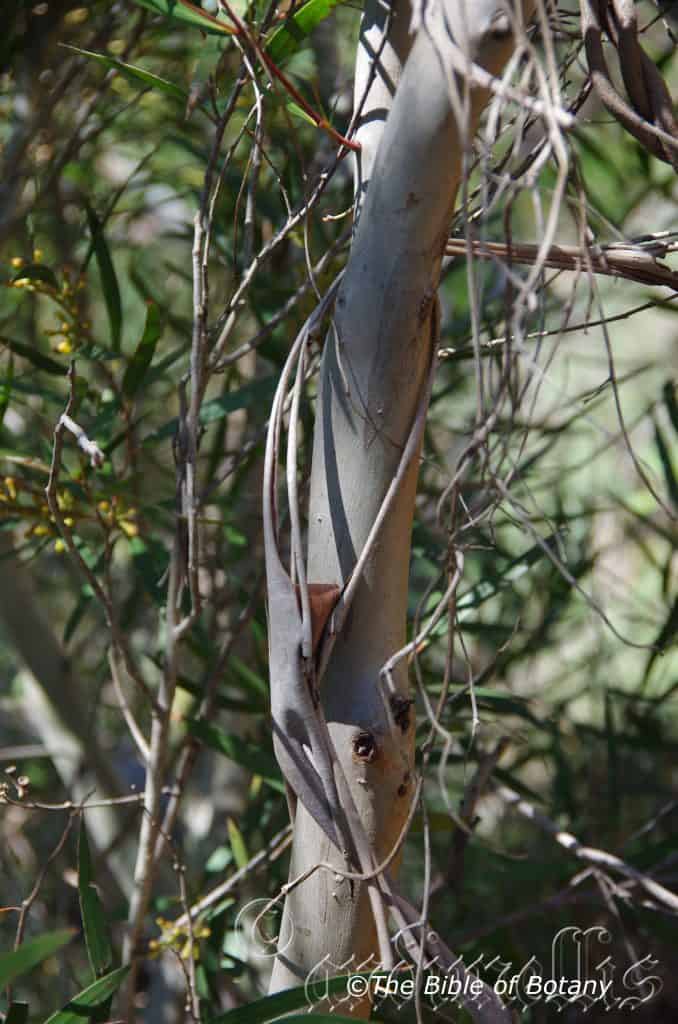

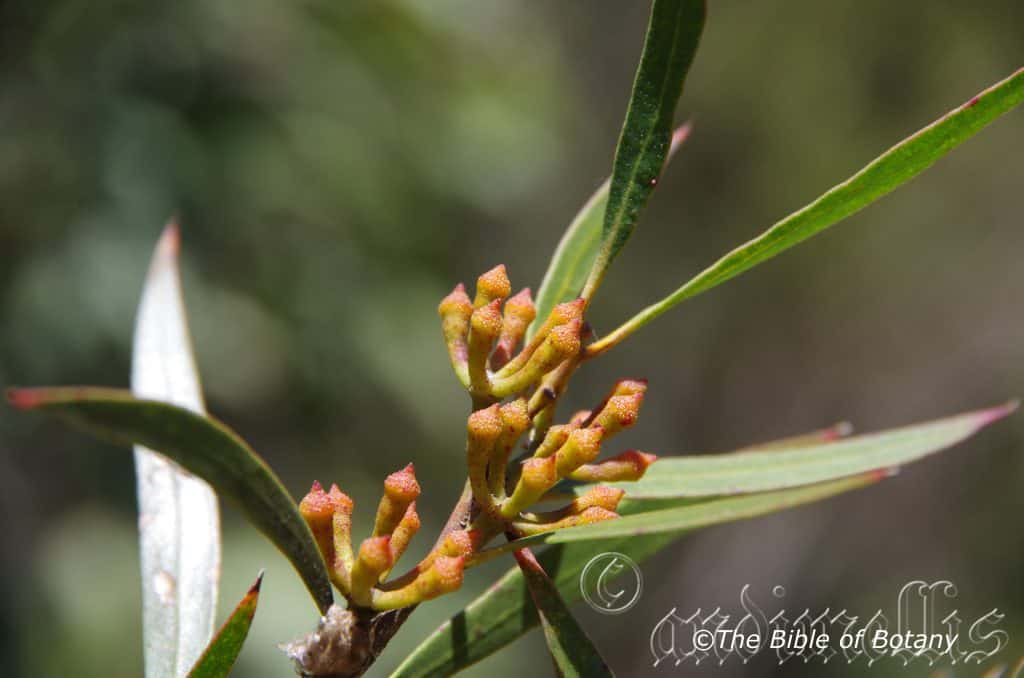


Eucalyptus cunninghamii
Classification:
Unranked: Eudicots
Unranked: Rosids
Order: Myrtales
Family: Myrtaceae
Genus: From Eu, which is Greek a prefix for good or well and Kaluptos, which is Ancient Greek for to cover up. It refers to the stamens, which have a lid or cover over them in the bud stage prior to opening.
Specie:Is named in honour Allan Cunningham; 1791–1839, who was a British explorer and a great early Australian botanists. He was appointed by Sir Joseph Banks in 1814 as a botanical collector arriving in Sydney in 1816. He accompanied John Oxley on his expedition in 1817 and later accompanied Phillip Parker King on his surveys of the Australian coast.
Sub specie:
Common Name:
Distribution:
The distribution of Eucalyptus cunninghamii is restrictedto a small area through the Blue Mountains from Richmond south to Wanganderry Plateau.
https://avh.ala.org.au/occurrences/search?taxa=Eucalyptus+cunninghamii#tab_mapView
Habitat Aspect Climate:
Eucalyptus cunninghamii grows naturally in full sun or as an understory tree in open woodland. The altitude ranges from 900 meters ASL to 1250 meters ASL.
The temperatures range from minus 4 degrees in July to 38 degrees in January.
The rainfall ranges from lows of 650mm to an average of 900mm annually.
Soil Requirements:
Eucalyptus cunninghamii grows naturally on decomposed sandstone often on shallow soils on the parent rock. It is fire tolerant and drought resistant once established. It does not tolerate water logged soils. Non saline soils to moderately saline soils are tolerated.
Height & Spread:
Wild Plants: 2m to 3m by 2m to 3m
Characteristics:
Eucalyptus cunninghamii has a smooth, grey bark often with scribbles. It forms a lignotuber.
The juvenile stems are terete in cross-section and are smooth or warty. The concolourous green, linear to narrowly lanceolate juvenile leaves are sessile and opposite for 5 or 6 nodes, then alternate becoming shortly petiolate and measuring 50mm to 100mm in length by 3mm to 5mm in width.
The alternate adult leaves have a petiole, which measures 4mm to 5mm in length. The linear to narrowly lanceolate leaves measure 30mm to 100mm in length by 3mm to 8mm in width. The base tapers to the petiole, while the apex is acute. The concolourous to slightly discolorous, glossy, green leaves’ mid vein is slightly prominent on the lower lamina, while the lateral veins are obscure. There are numerous oil glands. The new growth is pink.
The inflorescence is an axillary unbranched raceme with a 3mm to 8mm peduncle. There are 7 or 9 individual flowers in each umbel with pedicels that measure 2mmto 5mm in length. The mature obovoid or clavate, green or pinkish buds are warty and measure 4mm to 6mm in length by 2.5mm to 4mm in diameter. The scar is absent, while the conical to obtuse operculum is discarded as the first white, inflexed or irregularly flexed filaments appear and measure 3mm to 4.5mm in length. The white, reniform to cordate, versatile anthers are dorsifixed and dehisce with confluent slits.
The short stout style flares at the base onto the green or maroon disc and tapers to the stigma. There are 3 or 4 locules.
Fruit urceolate, barrel-shaped or truncate-globose capsules are sub sessile and measure 5mm to 8mm in length by 5mm to 7mm in diameter. The disc is descending, while the 3 or 4 valves are enclosed.
The brown, pyramidal or obliquely pyramidal seeds are smooth and measure 1mm to 1.5mm in length.
Wildlife:
Eucalyptus cunninghamii is often covered in native bees, and a myriad of other native insects and small honeyeaters when in flower.
Cultivation:
Eucalyptus cunninghamii is a magnificent bushy shrub or small tree for the small garden where a gum tree is required. It can be grown as a single trunk tree where it will reach 12 meters in cultivation or kept trimmed to 3 or 4 meters tall by 3 meters to 4 meters in diameter. At the pinnacles where it is growing on a very sandy loam I have problems with it growing to 4 meters to 6 meters every 2 years despite having numerous suckers from the lignotubers and annual trims. I trim my plants back to just above the lignotuber every two years. For smaller plants this can be done on an annual basis. After heavy pruning a good soaking with one of the recommended fertilizers is recommended.
Plants that have been trimmed back to the lignotubers after a few seasons and let grow can send out6 to 8 trunks with each one growing to 12 meters and with a total spread of 9 meters. Using it in this manner it makes a beautiful attractive feature in any small garden.
It is best used adjacent to small areas of bush close to paths or the house so their white flowers, multi stemmed mallee trunks can be viewed regularly. It is great in larger rockeries as the main feature plant. Here they can be planted in small groups of 2 or 3 as a standalone plant to create a harsh barren look with other arid plants. If it is surrounded by shorter plants with fine foliage and red flowers they will dominate at the center giving an expansive look to the bed especially when it is in flower.
This is one plant that benefits highly from being scattered throughout a large garden to create a natural Eucalyptus garden with towering trees. The clumps have the added advantage of being grown as a mallee or single trunk tree or both. There small size enables this to be achieved even in small and medium size gardens.
Six or more planted back from a bend will become a very strong focal point when in flower gain a lot of attention whether you are coming or going because of the fresh clean look of the foliage even in the driest of times. Place them in the mid ground with other large leaf ground covers and very small shrubs in the front to give them greater height or to make the garden appear larger than it is in reality.
Being a terminal flowering plant the more stems and branches that can be produced the better are the displays. One of the best gum trees for a small garden or parks in temperate and sub-tropical areas.
As a note it is Ipswich Councils floral emblem. It is a “Great choice Ipswich.”
Propagation:
Seeds: Sow fresh seeds of Eucalyptus cunninghamii into a seed raising mix. Place the trays in 30mm shade and keep moist not wet. When the seedlings are 50mm to 60mm tall, prick them out and plant them into 50mm native tubes using a good organic mix.
Once the seedlings reach 200mm to 250mm in height nip the tips out and plant them out into their permanent position. For mass plantings along borders plant them at 4 meter centers for single trunk displays or 8 meter centers for a multi trunk display. If it is planted any closer for mass displays Corymbia curtisii tends to select one or two leading shoots. The other shoots become weak and straggly.
Fertilize using Seaweed, fish emulsion or organic chicken pellets soaked in water on an alternate basis. Fertilize every two months until the plants are established then annually in early September or March to maintain health, vitality and better flowering.
Further Comments from Readers:
“Hi reader, it seems you use The Bible of Botany a lot. That’s great as we have great pleasure in bringing it to you! It’s a little awkward for us to ask, but our first aim is to purchase land approximately 1,600 hectares to link several parcels of N.P. into one at The Pinnacles NSW Australia, but we need your help. We’re not salespeople. We’re amateur botanists who have dedicated over 30 years to saving the environment in a practical way. We depend on donations to reach our goal. If you donate just $5, the price of your coffee this Sunday, We can help to keep the planet alive in a real way and continue to bring you regular updates and features on Australian plants all in one Botanical Bible. Any support is greatly appreciated. Thank you.”
In the spirit of reconciliation we acknowledge the Bundjalung, Gumbaynggirr and Yaegl and all aboriginal nations throughout Australia and their connections to land, sea and community. We pay our respect to their Elders past, present and future for the pleasures we have gained.


Eucalyptus cyphellocarpa
Classification:
Unranked: Eudicots
Clade: Rosids
Order: Myrtales
Family: Myrtaceae
Genus: From Eu, which is Greek a prefix for good or well and Kaluptos, which is Ancient Greek for to cover up. It refers to the stamens, which have a lid or cover over them in the bud stage prior to opening.
Specie: From Cypellum, which is Ancient Greek for a cup and Karpos, which is Ancient Greek for a fruit. It refers to the fruits, which resemble a cup.
Sub specie:
Common Name:
Distribution:
Eucalyptus cypellocarpa is found south from the Ironbark nature Reserve in central eastern New South Wales to Mount Byron on the Black Range in western central Victoria. It is mainly found on and east of the Great Dividing Range in the east.
https://avh.ala.org.au/occurrences/search?taxa=Eucalyptus+cyphellocarpa#tab_mapView
Habitat Aspect Climate:
Eucalyptus cypellocarpa prefers full sun. It grows in wet closed forests, rainforests and moist gullies. The altitude ranges from 50 meters ASL to 1500 meters ASL.
The temperatures range from minus 6 degree in August to 36 degrees in January.
The rainfall ranges from lows of 700mm to an average of 1200mm annually.
Soil Requirements:
Eucalyptus cypellocarpa prefers moderately fertile loams to medium fertile clays. The soils are derived from decomposed sandstone, granite black and brown basalts. The soils pH ranges from 6.5pH to 7.5pH. It does not tolerate water logged soils.Non saline soils to moderately saline soils are tolerated.
Height & Spread:
Wild Plants: 20m to 60m by 8m to 16m.
Characteristics:
Eucalyptus cypellocarpa smooth, yellowish, pale grey, cream, grey-brown or orange-brown, or with some persistent slabs of rough bark or thin rough bark on lower trunk. The decorticated bark falls in long ribbons. The juvenile stems are square in cross-section and prominently winged.
The juvenile opposite, lanceolate to cordate to ovate leaves are sessile for many nodes and measure 5mm to 150mm in length by 18mm to 70mm in width. The margins are entire or finely crenulate, while the bases are amplexicaul, lobed or rounded. The discolorous, glossy, green and glaucous near the acute apexes.
The alternate mature leaves have a short petiole that measures 12mm to 30mm in length. The lanceolate to falcate, concolourous or slightly discolorous are usually glossy green and measure 90mm to 300mm in length by 10mm to 48mm in width. The usually flat or at times undulating leaf bases taper to the petiole, while the apexes are acute, narrow acute or at times obtuse with a short mucronate point. The mid vein is prominent on both laminas near the base, while the feint lateral veins are usually at greater than 45° to the midrib and moderately to densely reticulate in between. The intramarginal vein runs parallel to and well removed from margin. The numerous small oil glands mostly between the reticulation.
The axillary unbranched inflorescence have a broad flattened peduncle that measures 8mm to 22mm in length while the 7 buds on the umbel are sessile or sub sessile. The mature oblong to ovoid, green to yellow, usually with slight angled buds measure 8mm to 11mm in length by 4mm to 6mm in width. The scar is present, while the conical operculum is discarded as the first irregularly white, flexed stamens appear and measure 9mm to 12mm in length. The cuboid to oblong anthers are versatile, dorsifixed and dehisce along longitudinal slits.
The style flares at the base on the yellowish-green disc and tapers or is blunt as it approaches the stigma.
The cylindrical or barrel-shaped, cupular or hemispherical, capsules are sessile or sub sessile and measure 5mm to 10mm in length by 5mm to 10mm in diameter. The disc is descending, while the 3 or 4 are enclosed or level with the rim or rarely slightly exserted.
The black, brown or grey, seeds are ovoid or flattened-ovoid, often pointed at one end, usually lacunose, with a smooth or shallowly pitted dorsal surface and measure 1mm to 2.5mm in length.
Wildlife:
The flowers Eucalyptus cypellocarpa are average nectar and pollen producers but are very attractive to most honeyeaters and lorikeets because of the sheer volume of flowers.
Cultivation:
Eucalyptus cypellocarpa is a medium tree which is ideally suitable for larger gardens where a Eucalyptus is required. It is relatively fast growing giving the garden an established look with a great affects at an early age. It looks rather attractive when planted with mallees with contrasting foliage and growth habits or other trees with different bark textures. In the garden good specimens may grow from 15 meters to 20 meters in height by 10 meters to 14 meters in diameter when grown in the open.
Like all Eucalyptus spp. leaf drop, dropping of small branches means continual lawn maintenance but then this means good quantities of leaf litter mulch.
Eucalyptus cypellocarpa can give quick protection, habitat and safe corridors for many birds. It is ideally suitable for the bases of a wind break especially when mallee type of Eucalyptus species like Eucalyptus cooperiana are used in between.
Propagation:
Seeds: Sow into a seed raising mix. Cover the seeds with 2mm to 3mm of fine sand and place the trays in a warm sunny position. Keep the seeds moist but not wet. When the seedlings are 25mm to 50mm tall, prick them out and plant them into 50mm native tubes using a good organic mix.
Once the seedlings reach 200mm to 250mm in height plant them out into their permanent position. Mass plantings are best done in groups of 3 to 5 as a feature by planting them at 4 meter to 5 meter centers as a tree or 5 meters to 6 meters as a mallee.
Fertilize using Seaweed, fish emulsion or organic chicken pellets soaked in water and apply the liquid on an alternate basis. Fertilize every two month until the trees are well established then every spring to ensure good growth and flowering.
Further Comments from Readers:
“Hi reader, it seems you use The Bible of Botany a lot. That’s great as we have great pleasure in bringing it to you! It’s a little awkward for us to ask, but our first aim is to purchase land approximately 1,600 hectares to link several parcels of N.P. into one at The Pinnacles NSW Australia, but we need your help. We’re not salespeople. We’re amateur botanists who have dedicated over 30 years to saving the environment in a practical way. We depend on donations to reach our goal. If you donate just $5, the price of your coffee this Sunday, We can help to keep the planet alive in a real way and continue to bring you regular updates and features on Australian plants all in one Botanical Bible. Any support is greatly appreciated. Thank you.”
In the spirit of reconciliation we acknowledge the Bundjalung, Gumbaynggirr and Yaegl and all aboriginal nations throughout Australia and their connections to land, sea and community. We pay our respect to their Elders past, present and future for the pleasures we have gained.
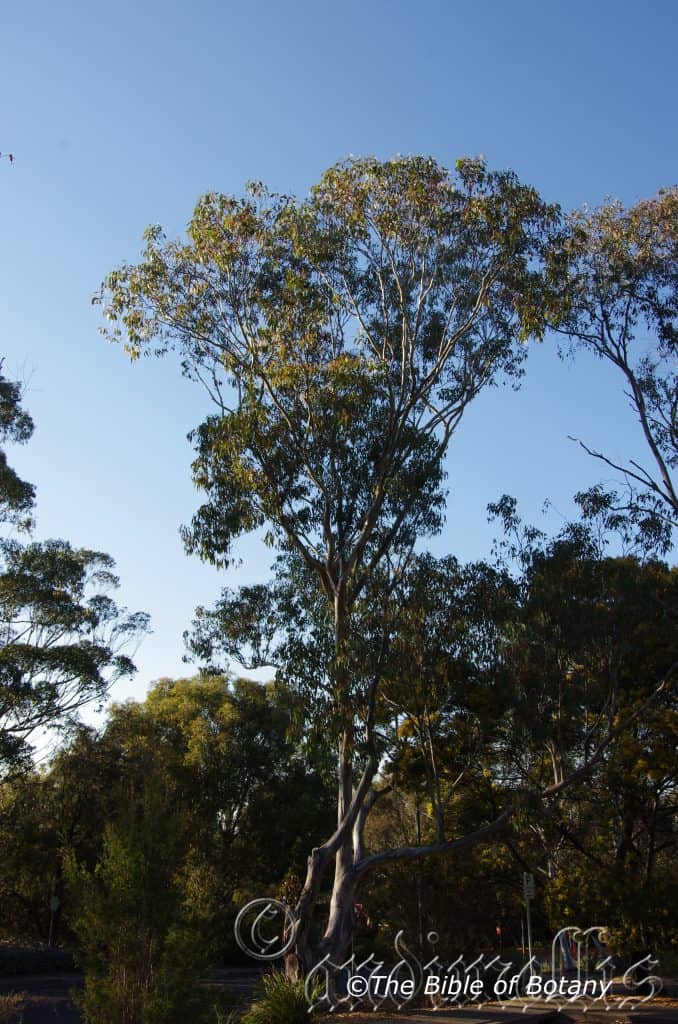

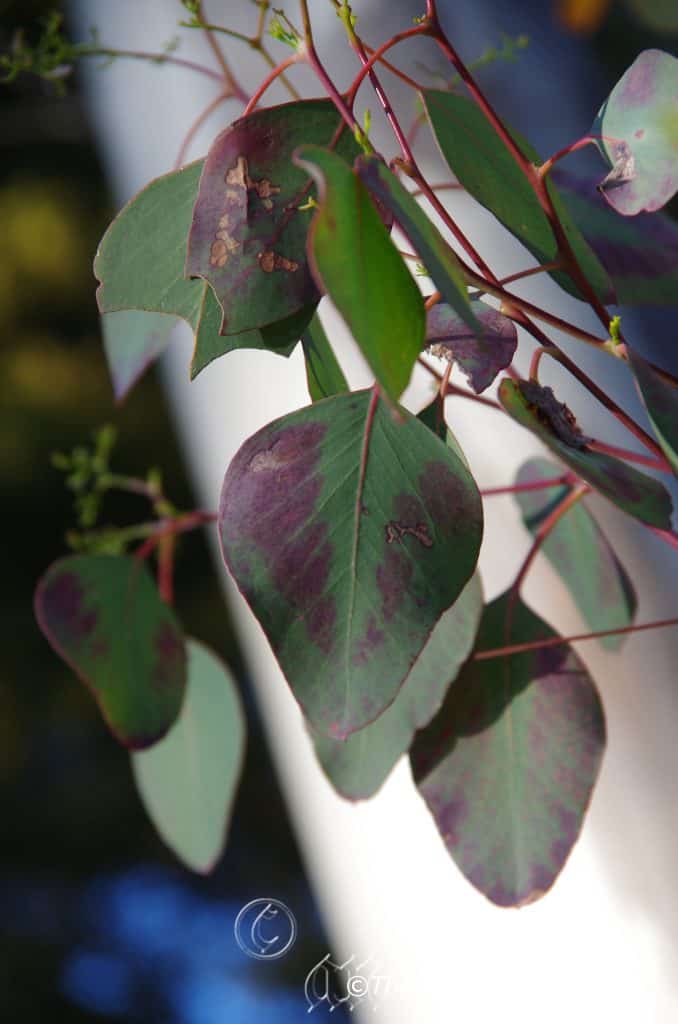

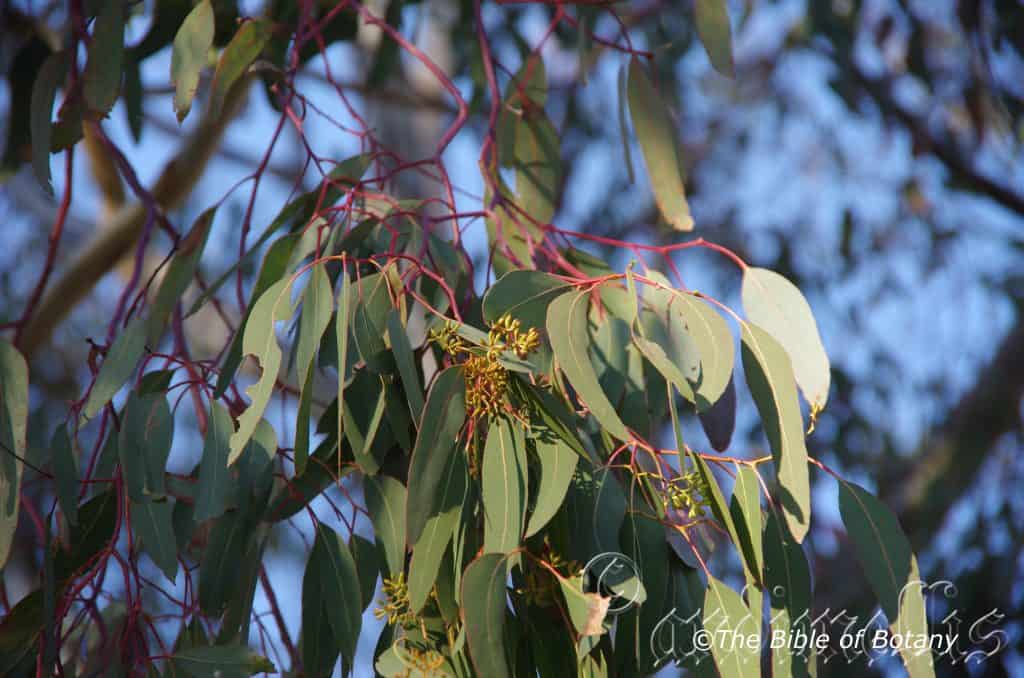
Eucalyptus dawsonii
Classification:
Unranked: Eudicots
Clade: Rosids
Order: Myrtales
Family: Myrtaceae
Genus: From Eu, which is Greek a prefix for good or well and Kaluptos, which is Ancient Greek for to cover up. It refers to the stamens, which have a lid or cover over them in the bud stage prior to opening.
Specie: Is named in honour of James Dawson; 1876–1899, who was an Australian licensed surveyor with a keen interest in the native flora. He lived and collected plants in the Rylstone district of New South.
Sub specie:
Common Name:
Distribution:
Eucalyptus dawsonii is locally abundant but quite restricted. It is found in an area bounded by Dunedoo, Cumnock-Larraghe, Bathurst, Singleton and Aberdeen in central eastern New South Wales. There are two disjunct populations one north at Muswellbrook and the other to the south along the Nattai River.
https://avh.ala.org.au/occurrences/search?taxa=Eucalyptus+dawsonii#tab_mapView
Habitat Aspect Climate:
Eucalyptus dawsonii prefers full sun. It grows in grassy or open sclerophyll woodlands to dry closed schlerophyll woodlands. The altitude ranges from 100 meters ASL to 500 meters ASL.
The temperatures range from 1 degree in August to 36 degrees in January.
The rainfall ranges from lows of 400mm to an average of 800mm annually.
Soil Requirements:
Eucalyptus dawsonii prefers moderately fertile sands to medium clays. The soils are usually derived from decomposed sandstone. The soils pH ranges from 5.5pH to 6.5pH. It does not tolerate water logged soils.Non saline soils to moderately saline soils are tolerated.
Height & Spread:
Wild Plants: 18m to 30m by 12m to 20m.
Characteristics:
Eucalyptus dawsonii is a medium size tree with a single trunk to about half its length. The smooth bark is white, grey, pinkish-grey or cream. The bark decorticates in irregular ribbons. The new stems are reddish to reddish-green and glabrous.
Eucalyptus dawsonii’s juvenile and coppice stems are terete and glaucous. The opposite disjunct leaves are rhomboid, orbiculate to ovate. The concolourous laminas are dull grey-green and glabrous. The margins are entire.
The alternate, disjunct, lanceolate or falcate-lanceolate leaves of Eucalyptus dawsonii measure 70mm to 150mm in length by 15mm to 25mm in width. The terete petioles measure 12mm to 20mm in length. The bases are tapering rounded while the apexes are acute with an apiculate tip. The coriaceous, concolourous laminas are dull, bluish-green to grey-green and glabrous. The margins are entire while the mid vein is prominent on both laminas. The lateral veins are clearly visible on the both laminas.
The inflorescences of Eucalyptus dawsoniiare compound conflorescence born as auxiliary umbellasters along the stems. There are 7 individual white flowers to an umbellaster. The new growth bearing the umbellasters is reddish-green, pinkish-green, pink or red. The terete peduncles are glabrous and measure 6mm to 10mm in length while the terete pedicels measure 2mm to 4mm in length. The ovoidal, fusiform or clavate buds are yellow-green often tinged pink or red on the upper surface. They measure 3mm to 6mm in length by 2mm to 3mm in diameter. The conical calyptra is much shorter than and is as wide as the hypanthium. A bud scar is present.
The white stamens measure 2mm to 4mm in length. The cream, anthers are dorsifixed and are all fertile. The creamy-yellow style measures 1mm to 2mm in length. The disc is creamy-yellow. The flowers appear from mid-October to mid-December.
The fruits of Eucalyptus dawsonii are conical woody capsules known as gum nuts. The deep green gum nuts measure 3mm to 5mm in length by 2mm to 4mm in diameter at the widest point. The disc is inserted with the 4 valves being enclosed or level with the disc.
Wildlife:
The flowers Eucalyptus dawsonii are average nectar and pollen producers but are very attractive to most honeyeaters and lorikeets because of the sheer volume of flowers.
Cultivation:
Eucalyptus dawsonii is a medium tree which is ideally suitable for larger gardens where a Eucalyptus is required. It is relatively fast growing giving the garden an established look with a great affects at an early age. It looks rather attractive when planted with mallees with contrasting foliage and growth habits or other trees with different bark textures. In the garden good specimens may grow from 15 meters to 20 meters in height by 10 meters to 14 meters in diameter when grown in the open.
Like all Eucalyptus spp. leaf drop, dropping of small branches means continual lawn maintenance but then this means good quantities of leaf litter mulch.
Eucalyptus dawsonii can give quick protection, habitat and safe corridors for many birds. It is ideally suitable for the bases of a wind break especially when mallee type of Eucalyptus species like Eucalyptus cooperiana are used in between.
Propagation:
Seeds: Sow into a seed raising mix. Cover the seeds with 2mm to 3mm of fine sand and place the trays in a warm sunny position. Keep the seeds moist but not wet. When the seedlings are 25mm to 50mm tall, prick them out and plant them into 50mm native tubes using a good organic mix.
Once the seedlings reach 200mm to 250mm in height plant them out into their permanent position. Mass plantings are best done in groups of 3 to 5 as a feature by planting them at 4 meter to 5 meter centers as a tree or 5 meters to 6 meters as a mallee.
Fertilize using Seaweed, fish emulsion or organic chicken pellets soaked in water and apply the liquid on an alternate basis. Fertilize every two month until the trees are well established then every spring to ensure good growth and flowering.
Further Comments from Readers:
“Hi reader, it seems you use The Bible of Botany a lot. That’s great as we have great pleasure in bringing it to you! It’s a little awkward for us to ask, but our first aim is to purchase land approximately 1,600 hectares to link several parcels of N.P. into one at The Pinnacles NSW Australia, but we need your help. We’re not salespeople. We’re amateur botanists who have dedicated over 30 years to saving the environment in a practical way. We depend on donations to reach our goal. If you donate just $5, the price of your coffee this Sunday, We can help to keep the planet alive in a real way and continue to bring you regular updates and features on Australian plants all in one Botanical Bible. Any support is greatly appreciated. Thank you.”
In the spirit of reconciliation we acknowledge the Bundjalung, Gumbaynggirr and Yaegl and all aboriginal nations throughout Australia and their connections to land, sea and community. We pay our respect to their Elders past, present and future for the pleasures we have gained.
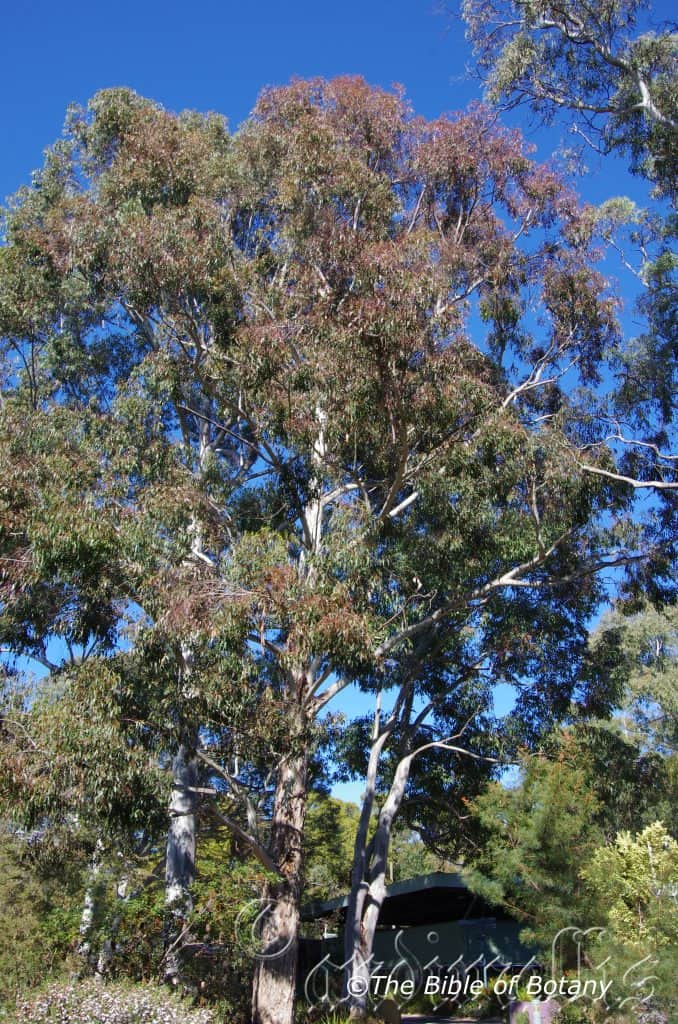


Eucalyptus deanei
Classification:
Unranked: Eudicots
Clade: Rosids
Order: Myrtales
Family: Myrtaceae
Genus: From Eu, which is Greek a prefix for good or well and Kaluptos, which is Ancient Greek for to cover up. It refers to the stamens, which have a lid or cover over them in the bud stage prior to opening.
Specie: Is named in Honour of Henry Dean; 1847-1924, who was a railway engineer and noted botanist in the field of Eucalyptus.
Sub specie:
Common Name:
Distribution:
Eucalyptus deanei is found in two main populations with scattered populations between. It is found south from Mt. Glorious and Joyner’s Ridge, in the D’Aguilar Range in south eastern Queensland to Diehard State Forest E of Glen Innes in north eastern New South Wales and from Gosford to Hill Top in the Wingecarribee Shire in central coastal New South Wales.
In the north it is mainly found on the western slopes close to and on the Great Dividing Range while in the south it crosses the range and is mainly found on the Great Dividing Range to the coast
https://avh.ala.org.au/occurrences/search?taxa=Eucalyptus+deanei#tab_mapView
Habitat Aspect Climate:
Eucalyptus deanei prefers full sun to part shade. It grows in tall wet forests particularly along rivers, streams and soaks in sheltered valleys and hills. The altitude ranges from 50 meters ASL to 850 meters ASL.
The temperatures range from minus 3 degree in August to 36 degrees in January.
The rainfall ranges from lows of 900mm to an average of 1600mm annually.
Soil Requirements:
Eucalyptus deanei prefers fertile loams, light to heavy silts or light clays. The soils are usually derived from alluvial deposits. The soils pH ranges from 5.5pH to 7pH. It does not tolerate water logged soils however grows in areas where continual ground moisture is available with many areas being subject to seasonal periodic flooding.Non saline soils to moderately saline soils are tolerated.
Height & Spread:
Wild Plants: 30m to 60m by 15m to 20m.
Characteristics:
Eucalyptus deanei is a large single trunk tree usually to 40 meters. Eucalyptus deanei is a typical half bark with a short or long deep grey to deep grey-brown, fibrous and flaky stocking covering one to several meters up the tree. The upper portion of the trunk and branches is entirely smooth with pale white, cream or pale creamy-grey patches. The bark decorticates in short ribbons and plates.
Eucalyptus deanei’s juvenile and coppice stems are terete and glaucous. The opposite, disjunct leaves are ovate to orbicular or at times are rhomboidal. The discolourous laminas are mid to deep green, glossy and glabrous on the upper lamina while the lower lamina is paler. The margins are entire.
The alternate, disjunct, lanceolate to broad lanceolate or rarely narrow lanceolate leaves of Eucalyptus deanei are straight to falcate and measure 80mm to 130mm in length by 20mm to 35mm in width. The terete petioles measure 10mm to 30mm in length. The bases are tapering rounded while the apexes are narrow acute. The discolourous laminas are dull, bluish-green to grey-green and glabrous. The margins are entire while the mid vein is more prominent on the lower lamina. The lateral penniveins are faintly visible on the both laminas while the intramarginal vein is close to the margin.
The inflorescences of Eucalyptus deaneiare born as auxiliary umbellasters along the stems. There are 7 to 11 individual white flowers to an umbellaster. The new growth bearing the umbellasters is reddish-green, pinkish-green, pink or red. The narrowly flattened or angular peduncles are glabrous and measure 7mm to 14mm in length. The clavate or pyriform buds are lime-green to mid-green and measure 4mm to 6mm in length by 3mm to 4mm in diameter. The hemispherical calyptra is hemispherical and is shorter than and as wide as hypanthium. A bud scar is present.
The white stamens measure 8mm to 10mm in length. The cream, oblong anthers are dorsifixed and are all fertile. The creamy-yellow style measures 7mm to 8mm in length. The disc is pale crimson to yellow. The flowers appear from mid-July to November.
The fruits of Eucalyptus deanei are cylindrical woody capsules known as gum nuts. The deep green gum nuts measure 4mm to 6mm in length by 4mm to 6mm in diameter at the widest point. The disc is inserted with the 4 valves are level with the disc or exserted.
Wildlife:
The flowers Eucalyptus deanei are average nectar and pollen producers but are very attractive to most honeyeaters and lorikeets because of the sheer volume of flowers.
Cultivation:
Eucalyptus deanei is a very large tree which is only suitable for the largest gardens where a Eucalyptus is required. It is fast growing giving the garden an established look with a great affects at an early age. It looks very affective when planted with other tall growing species with contrasting barks. In the garden good specimens may grow from 30 meters to 35 meters in height by 15 meters to 20 meters in diameter when grown in the open. Because of its size and liking for sheltered positions it may become unstable in exposed positions, skeletal soils and clays making it more susceptible to being blown over. Therefore it should be planted well away from any structures.
Like all Eucalyptus spp. leaf drop, dropping of small branches means continual lawn maintenance but then this means good quantities of leaf litter mulch.
Eucalyptus deanei can give quick protection, habitat and safe corridors for many birds and animals in sheltered positions away from strong winds.
Propagation:
Seeds: Sow into a seed raising mix. Cover the seeds with 2mm to 3mm of fine sand and place the trays in a warm sunny position. Keep the seeds moist but not wet. When the seedlings are 25mm to 50mm tall, prick them out and plant them into 50mm native tubes using a good organic mix.
Once the seedlings reach 200mm to 250mm in height plant them out into their permanent position. Mass plantings are best done in groups of 3 to 5 as a feature by planting them at 4 meter to 5 meter centers as a tree or 5 meters to 6 meters as a mallee.
Fertilize using Seaweed, fish emulsion or organic chicken pellets soaked in water and apply the liquid on an alternate basis. Fertilize every two month until the trees are well established then every spring to ensure good growth and flowering.
Further Comments from Readers:
“Hi reader, it seems you use The Bible of Botany a lot. That’s great as we have great pleasure in bringing it to you! It’s a little awkward for us to ask, but our first aim is to purchase land approximately 1,600 hectares to link several parcels of N.P. into one at The Pinnacles NSW Australia, but we need your help. We’re not salespeople. We’re amateur botanists who have dedicated over 30 years to saving the environment in a practical way. We depend on donations to reach our goal. If you donate just $5, the price of your coffee this Sunday, We can help to keep the planet alive in a real way and continue to bring you regular updates and features on Australian plants all in one Botanical Bible. Any support is greatly appreciated. Thank you.”
In the spirit of reconciliation we acknowledge the Bundjalung, Gumbaynggirr and Yaegl and all aboriginal nations throughout Australia and their connections to land, sea and community. We pay our respect to their Elders past, present and future for the pleasures we have gained.
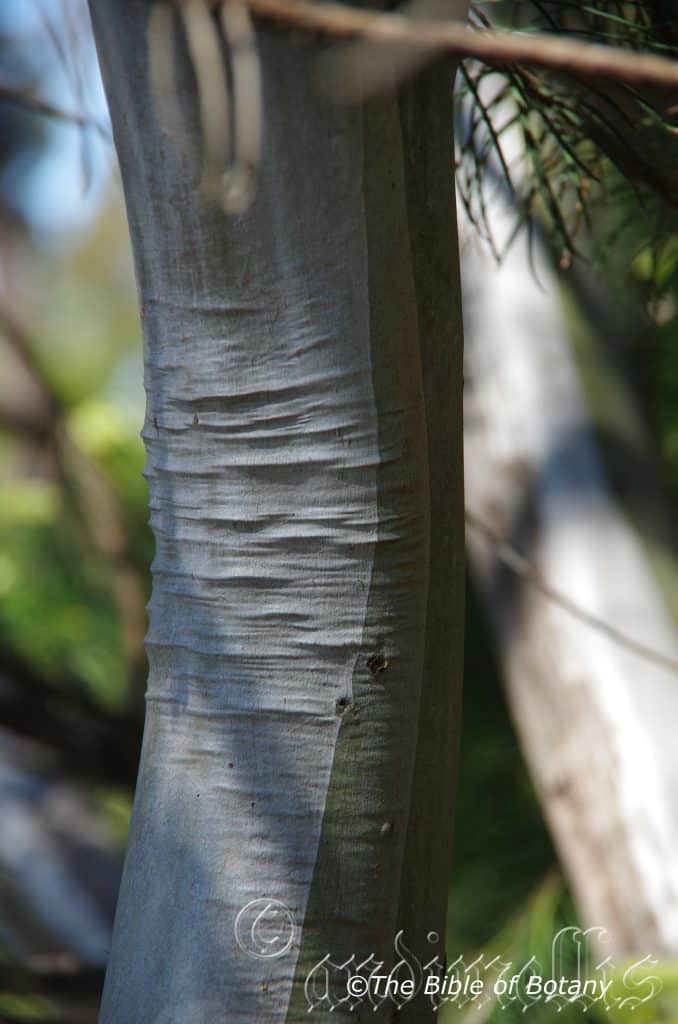

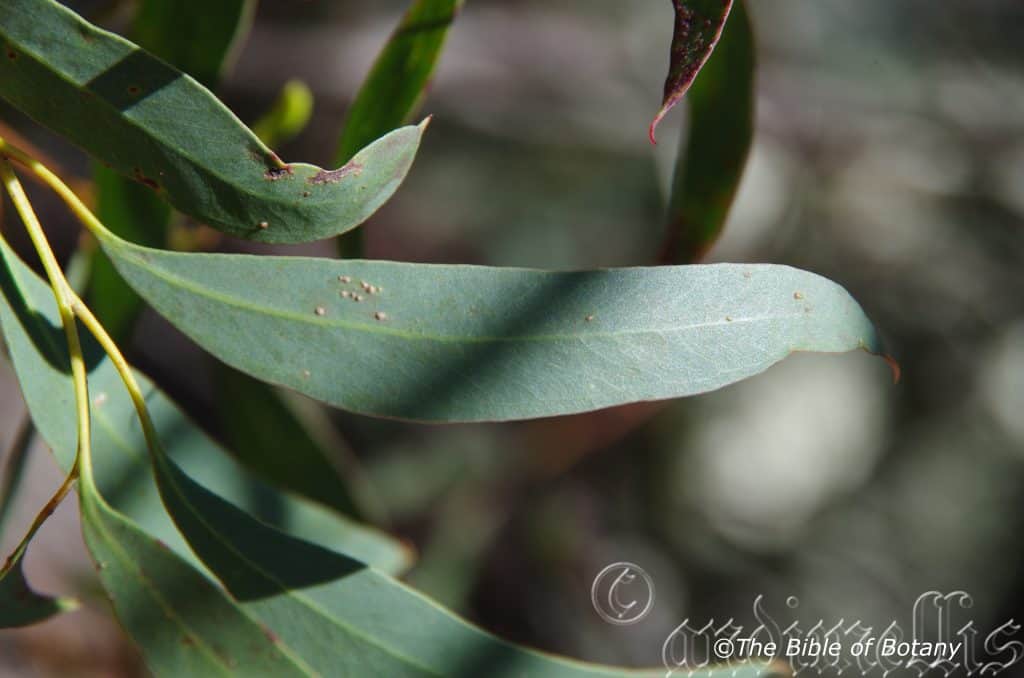

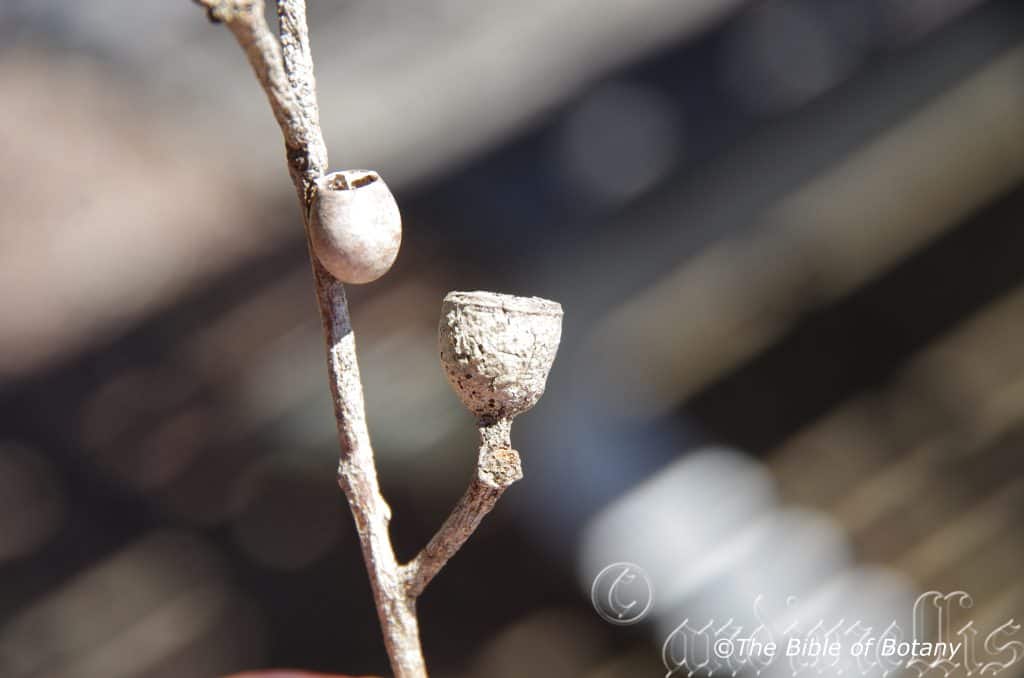
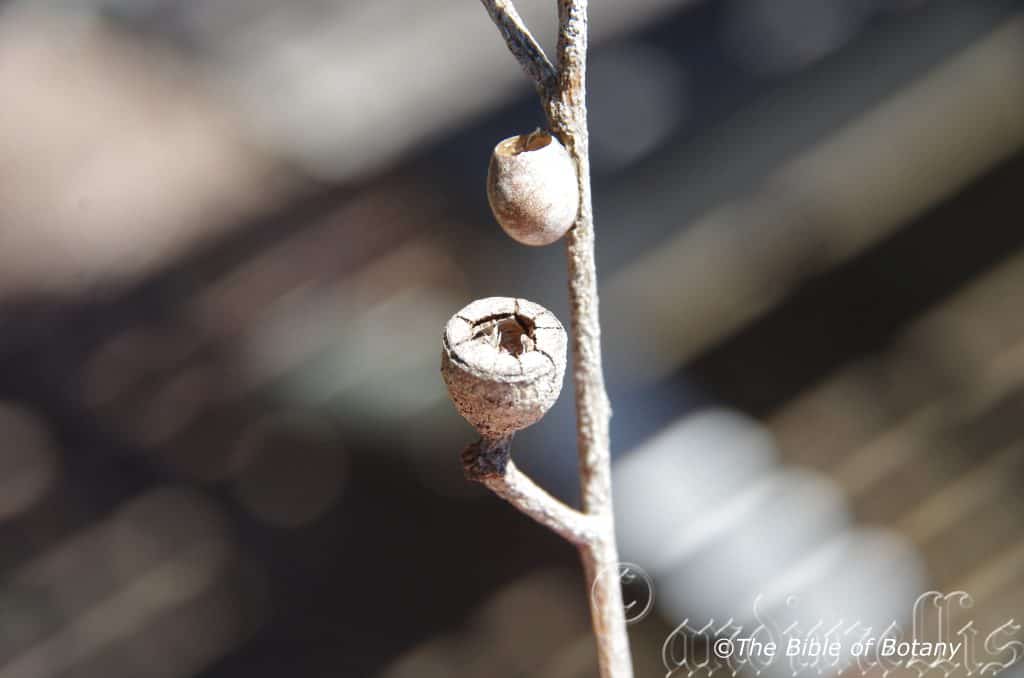
Eucalyptus diversifolia
Classification:
Unranked: Eudicots
Clade: Rosids
Order: Myrtales
Family: Myrtaceae
Genus: From Eu, which is Greek a prefix for good or well and Kaluptos, which is Ancient Greek for to cover up. It refers to the stamens, which have a lid or cover over them in the bud stage prior to opening.
Specie: From Dīversum, which is Latin for diverse in shape or form and Folium, which is Latin for foliage. It refers to the leaves, which have a greater variation than other species in the genus.
Sub specie: Eucalyptus diversifolia subsp. diversifolia. From Dīversum, which is Latin for diverse in shape or form and Folium, which is Latin for foliage. It refers to the leaves, which have a greater variation than other species in the genus.
Eucalyptus diversifolia subsp. hesperia. From Hespería, which is Ancient Greek for the western land. It refers to plants, which grow further west than other species in the genus or sub species with in the secies.
Common Name:
Distribution:
Eucalyptus diversifolia subsp. diversifolia is found east from Streaky Bay in southern coastal South Australia to Warnambool in southern Victoria. It is found further inland than the western subspecie.
Eucalyptus diversifolia subsp. hesperia is found east from Toolinna in coastal far central south, Western Australia to Eucla in coastal far south western South Australia.
Habitat Aspect Climate:
Eucalyptus diversifolia prefers full sun. It grows in protected and exposed situations in dry schlerophyll, open woodlands and dry exposed headlands and plains. The altitude ranges from 20 meters ASL to 300 meters ASL.
The temperatures range from minus 2 degrees in August to 44 degrees in January.
The rainfall ranges from lows of 600mm to an average of 900mm annually.
https://avh.ala.org.au/occurrences/search?taxa=Eucalyptus+diversifolia#tab_mapView
Soil Requirements:
Eucalyptus diversifolia prefers moderately fertile sandy loams to light fatty clays. The soils are usually derived from decomposed sandstone, decomposed limestones or accumulated sands. The soils pH ranges from 5pH to 6.5pH. It does not tolerate water logged soils.Non saline soils to moderately saline soils are tolerated.
Height & Spread:
Wild Plants: 1m to 6m by 2m to 4m.
Characteristics:
Eucalyptus diversifolia predominantly cream and grey over pink, yellow or fawn bark is smooth. The terete juvenile stems are yellowish to reddish and semi glossy.
The juvenile leaves are opposite for up to 12 to 15 nodes and are sessile being amplexicaul to rounded at the base. The elliptic to ovate or oblong leaves measure 40mm to 75mm in length by 10mm to 25mm in width.
The alternate, lanceolate to falcate mature leaves have a short petiole that measures 12mm to 18mm in length. The concolourous, glossy, deep green, laminas measure 55mm to 100mm in length by 10mm to 22mm in width. The bases taper to petiole, while the apexes are acute. The mid vein is prominent on the lower lamina, while the lateral veins are faintly visible and moderately reticulate, and the intramarginal vein runs parallel to and away from the from margin. The oil glands are mostly island and obscure.
The axillary unbranched inflorescence has peduncles that measure 5mm to 15mm in length, while the usually 7, 9 or at times 11 buds per umbel’s pedicels measure 1mm to 6mm in length. The mature green to yellowish, smooth, scurfy or slightly warty rhomboidal buds measure 5mm to 12mm in length by 4mm to 7mm in diameter. The scar is absent, while the conical to beaked operculum is discarded prior to the irregularly flexed filaments are exposed. The white filaments measure 9mm to 10mm in length. The oblong or spherical, versatile, dorsifixed anthers dehisce along longitudinal slits. The pale green to deep green tapers to the stigma.
The cupular capsules are sessile to sub sessile and measure 6mm to 11mm in length by 8mm to 11mm in diameter. The convex disc is level or slightly raised with the 3 to 4 valves being at the level of the rim.
The brown to reddish brown seeds are pyramidal to D-shaped with a smooth dorsal surface and measure 2mm to 3mm in length.
Sub specie differences:
Eucalyptus diversifolia subsp. diversifolia occurs east of the Nullarbor Plain. Coastal forms may be shrubby while inland, like in central Eyre Peninsula, it is distinctive in its erect smooth stems. It is a smooth-barked mallee with rhomboid buds and cupular fruit 12mm to 16mm in diameter.
Eucalyptus diversifolia subsp. hesperia occurs west of the Nullarbor Plain on the limestone escarpment. Plants found on exposed coastal sites are often shrubby to prostrate but always with a hint of rough bark at the base of the stems. Further inland they become tall mallees and have rough fibrous bark over at least the trunks, often extending to smaller branches. The capsules are usually smaller and measure 7mm to 10m in diameter.
Wildlife:
The flowers of Eucalyptus diversifolia are heavy yielders of good quantities of good quality nectar and pollen. This makes them attractive to honeyeaters, lorikeets and apiarists along the east coast. They also attract many insects and insectivorous birds when in flower.
Cultivation:
Eucalyptus diversifolia will grow as a small prostrate mallee on very exposed situations along the coast, multi trunked mallees in more protected areas or as a single trunk small tree in sheltered positions, which makes it ideally suitable for smaller gardens where a Eucalyptus is required. It is slower growing than most eucalyptus but is still a very attractive garden specimens once established. It looks great and makes a good affect from an early age. It looks very affective when planted with other mallees or small Eucalyptus trees with contrasting foliage and flower colours. Another method is to grow one or two as trees and interplant with several plants that have been cut to induce the growth of several trunks. In the garden good specimens may grow from 2 meters to 7 meters in height by 1 meter to 5 meters in diameter when grown in the open.
Like all Eucalyptus spp. leaf drop, dropping of small branches means continual lawn maintenance but then this means good quantities of leaf litter mulch.
Eucalyptus diversifolia can be used like many small Eucalyptus spp. to create that little bit of Australiana in the back yard.Often floral characteristics of a plant dictate our selection of plants for the garden. Remember that once a Eucalyptus spp.; or in fact any tree, reaches a reasonable size, its trunk or bark can are the most prominent features seen. Among the Eucalypts there are many different types of barks which include some of our beautiful peppermint barks. Grouping, mallees as mallees or as single trunk trees can add immeasurably to the interest within a small space. Eucalyptus dives is one of those species whose multi stems and bark contrasts well with single stem species.
Small shrubs can be used to emphasize the open spaces surrounding a mallee or a small tree especially when mass plantings are done.
Eucalyptus diversifolia can look great when placed in the corner against a fence to add privacy and remove the barrenness of the yard while giving extra depth.
Propagation:
Seeds: Sow Eucalyptus diversifolia seeds into a seed raising mix. Cover the seeds with 2mm to 3mm of fine sand and place the trays in a warm sunny position. Keep the seeds moist but not wet. When the seedlings are 25mm to 50mm tall, prick them out and plant them into 50mm native tubes using a good organic mix.
Once the seedlings reach 200mm to 250mm in height plant them out into their permanent position. Mass plantings are best done in groups of 3 to 5 as a feature by planting them at 4 meter to 5 meter centers as a tree or 5 meters to 6 meters as a mallee.
Fertilize using Seaweed, fish emulsion or organic chicken pellets soaked in water and apply the liquid on an alternate basis. Fertilize every two month until the trees are well established then every spring to ensure good growth and flowering.
Further Comments from Readers:
“Hi reader, it seems you use The Bible of Botany a lot. That’s great as we have great pleasure in bringing it to you! It’s a little awkward for us to ask, but our first aim is to purchase land approximately 1,600 hectares to link several parcels of N.P. into one at The Pinnacles NSW Australia, but we need your help. We’re not salespeople. We’re amateur botanists who have dedicated over 30 years to saving the environment in a practical way. We depend on donations to reach our goal. If you donate just $5, the price of your coffee this Sunday, We can help to keep the planet alive in a real way and continue to bring you regular updates and features on Australian plants all in one Botanical Bible. Any support is greatly appreciated. Thank you.”
In the spirit of reconciliation we acknowledge the Bundjalung, Gumbaynggirr and Yaegl and all aboriginal nations throughout Australia and their connections to land, sea and community. We pay our respect to their Elders past, present and future for the pleasures we have gained.
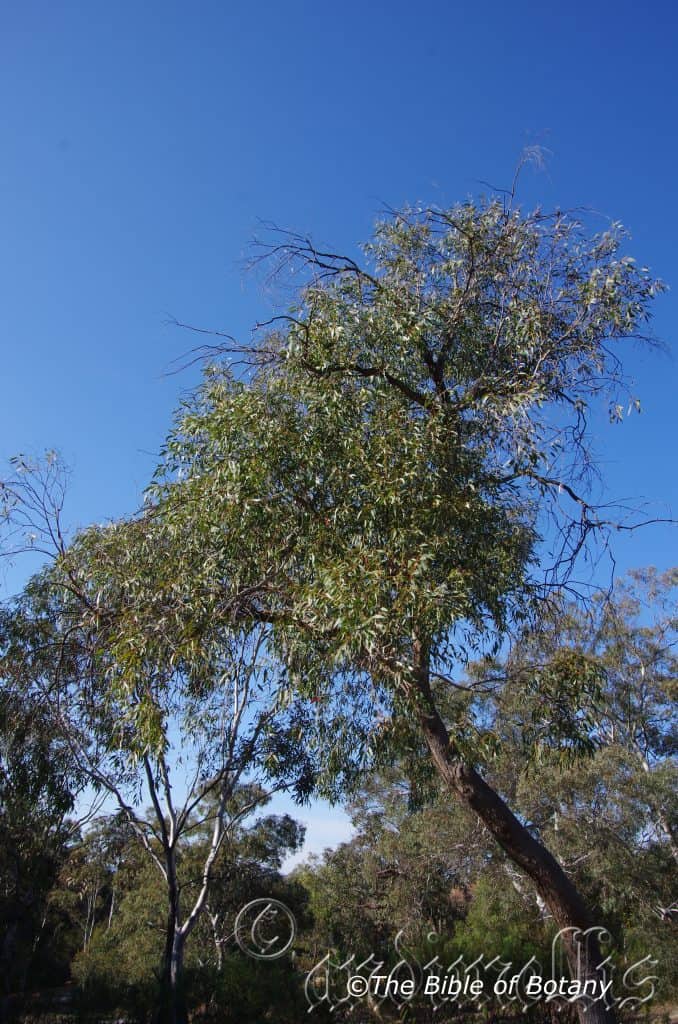

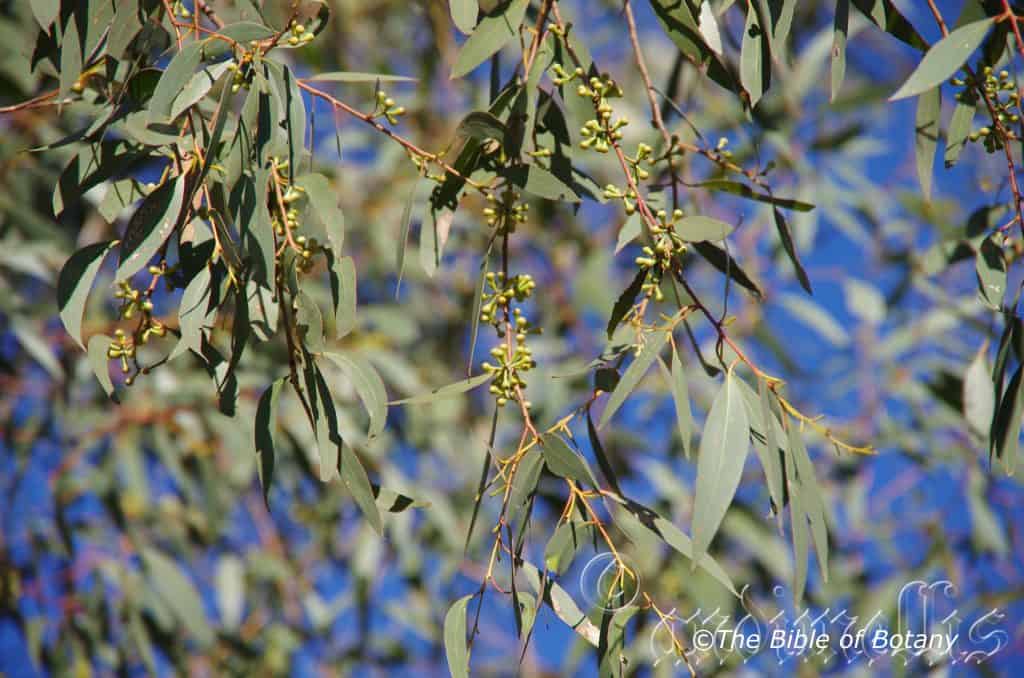
Eucalyptus dives
Classification:
Unranked: Eudicots
Clade: Rosids
Order: Myrtales
Family: Myrtaceae
Genus: From Eu, which is Greek a prefix for good or well and Kaluptos, which is Ancient Greek for to cover up. It refers to the stamens, which have a lid or cover over them in the bud stage prior to opening.
Specie: From Dives/Dīvitum, which is Latin for rich and plentiful or coming from the gods. It refers to a plant’s organ/s, which are plentiful and very beautiful.
Sub specie:
Common Name: Broad Leaf Peppermint.
Distribution:
Eucalyptus dives is found mainly close to the Great Dividing Range on the western slopes to the coast especially in its southern part of its range and on the highlands in the northern parts. It is found south from the Snowy Range near Ebor in New South Wales to the north eastern edge of the Grampians east to Rosebud in southern Victoria then north again to Wolumla in the Bega Valley in coastal southern New South Wales.
https://avh.ala.org.au/occurrences/search?taxa=Eucalyptus+dives#tab_mapView
Habitat Aspect Climate:
Eucalyptus dives prefers full sun. It grows in protected and exposed situations in dry schlerophyll woodlands and highland heaths on flats ad gentle slopes. The altitude ranges from 20 meters ASL to 1500 meters ASL.
The temperatures range from minus 7 degree in August to 36 degrees in January.
The rainfall ranges from lows of 600mm to an average of 1600mm annually.
Soil Requirements:
Eucalyptus dives prefers moderately fertile sandy loams to light fatty clays. The soils are usually derived from decomposed granites. The soils pH ranges from 5pH to 6.5pH. It does not tolerate water logged soils.Non saline soils to moderately saline soils are tolerated.
Height & Spread:
Wild Plants: 8m to 20m by 5m to 10m.
Characteristics:
Eucalyptus dives is a small mallee with a single to 20 meters but frequently grows as a multi stemmed small tree in the vicinity of 10 meters to 12 meters. The typically peppermint bark is persistent on the trunk to the larger branches. It is shortly fibrous and grey to grey-brown and is grey and smooth above to the smallest branchlets. The bark decorticates in long ribbons. The new flushes are smooth, and glaucous pink turning red as they age.
Eucalyptus dives’s juvenile and coppice stems are terete and glaucous. The opposite disjunct leaves are ovate. The concolourous laminas are a beautiful pale to mid-blue to blue-green, glabrous and glaucous. The margins are entire.
The alternate, disjunct, lanceolate to broad lanceolate falcate leaves of Eucalyptus dives measure 70mm to 150mm in length by 16mm to 33mm in width. The terete petioles measure 10mm to 30mm in length. The slightly oblique bases are tapering rounded while the apexes are acuminate. The concolourous laminas are semi glossy to glossy, bluish-green to grey-green and glabrous. The margins are entire while the mid-vein is slightly prominent on both laminas. The lateral penniveins are faintly visible on the both laminas while the intramarginal veins are close to the margin.
The inflorescences of Eucalyptus dives are umbellasters born auxiliary along the stems. There are 11 individual white flowers to an umbellaster. The new growth bearing the umbellasters is purplish, reddish-green, pinkish-green, pink, orange or red. The terete or angular peduncles are glabrous and measure 5mm to 13mm in length while the terete pedicels measure 2mm to 5mm in length. The clavate buds are yellowish, glabrous and measure 4mm to 6mm in length by 2mm to 4mm in diameter. The hemispherical calyptra at times rostrate and is shorter than and as wide is as the hypanthium. A bud scar is absent.
The white stamens measure 5mm to 8mm in length. The cream, orbicular anthers are dorsifixed and are all fertile. The creamy-yellow to red style measures 2mm to 4mm in length. The disc is pale yellow. The flowers appear from mid-September to November.
The fruits of Eucalyptus dives are quite variable and include hemispherical, conical, pyriform or ovoidal woody capsules known as gum nuts. The deep green gum nuts measure 5mm to 7mm in length by 5mm to 7mm in diameter at the widest point. The disc is flat or exserted with the 4 triangular valves that are level with the disc.
Wildlife:
The flowers of Eucalyptus dives are heavy yielders of good quantities of good quality nectar and pollen. This makes them attractive to honeyeaters, lorikeets and apiarists along the east coast. They also attract many insects and insectivorous birds when in flower.
Cultivation:
Eucalyptus dives is a small to medium tree which is ideally suitable for smaller gardens where a Eucalyptus is required. It is slower growing than most eucalyptus but make attractive garden specimens once established. They still look great and make good affect from an early age. It looks very affective when planted with other mallees or small Eucalyptus trees with contrasting foliage and growth habits. Another method is to grow one or two as trees and interplant with several plants that have been cut to induce the growth of several trunks. In the garden good specimens may grow from 12 meters to 15 meters in height by 3 meters to 5 meters in diameter when grown in the open as a single trunk tree or 6 meters to 12 meters in height by 6 meters to 7 meters as a multi trunk tree when grown in the open.
Like all Eucalyptus spp. leaf drop, dropping of small branches means continual lawn maintenance but then this means good quantities of leaf litter mulch.
Eucalyptus dives can be used like many small Eucalyptus spp. to create that little bit of Australiana in the back yard.Often floral characteristics of a plant dictate our selection of plants for the garden. Remember that once a Eucalyptus spp.; or in fact any tree, reaches a reasonable size, its trunk or bark can are the most prominent features seen. Among the eucalypts there are many different types of barks which include some of our beautiful peppermint barks. Grouping, mallees as mallees or as single trunk trees can add immeasurably to the interest within a small space. Eucalyptus dives is one of those species whose multi stems and bark contrasts well with single stem species.
Small shrubs can be used to emphasize the open spaces surrounding a mallee or a small tree especially when mass plantings are done.
Eucalyptus dives can look great when placed in the corner against a fence to add privacy and remove the barrenness of the yard while giving extra depth.
Propagation:
Seeds: Sow into a seed raising mix. Cover the seeds with 2mm to 3mm of fine sand and place the trays in a warm sunny position. Keep the seeds moist but not wet. When the seedlings are 25mm to 50mm tall, prick them out and plant them into 50mm native tubes using a good organic mix.
Once the seedlings reach 200mm to 250mm in height plant them out into their permanent position. Mass plantings are best done in groups of 3 to 5 as a feature by planting them at 4 meter to 5 meter centers as a tree or 5 meters to 6 meters as a mallee.
Fertilize using Seaweed, fish emulsion or organic chicken pellets soaked in water and apply the liquid on an alternate basis. Fertilize every two month until the trees are well established then every spring to ensure good growth and flowering.
Further Comments from Readers:
“Hi reader, it seems you use The Bible of Botany a lot. That’s great as we have great pleasure in bringing it to you! It’s a little awkward for us to ask, but our first aim is to purchase land approximately 1,600 hectares to link several parcels of N.P. into one at The Pinnacles NSW Australia, but we need your help. We’re not salespeople. We’re amateur botanists who have dedicated over 30 years to saving the environment in a practical way. We depend on donations to reach our goal. If you donate just $5, the price of your coffee this Sunday, We can help to keep the planet alive in a real way and continue to bring you regular updates and features on Australian plants all in one Botanical Bible. Any support is greatly appreciated. Thank you.”
In the spirit of reconciliation we acknowledge the Bundjalung, Gumbaynggirr and Yaegl and all aboriginal nations throughout Australia and their connections to land, sea and community. We pay our respect to their Elders past, present and future for the pleasures we have gained.

Eucalyptus dorrigoensis
Classification:
Unranked: Eudicots
Clade: Rosids
Order: Myrtales
Family: Myrtaceae
Genus: From Eu, which is Greek a prefix for good or well and Kaluptos, which is Ancient Greek for to cover up. It refers to the stamens, which have a lid or cover over them in the bud stage prior to opening.
Specie: From Dorrigo, which is Latinized for the district of Dorrigo west of Coffs Harbour and Anum/Ensis, which is Latin for to originate from. It refers to plants which originate or are restricted to the Dorrigo district.
Sub specie:
Common Name: Dorrigo White Gum.
Distribution:
Eucalyptus dorrigoensis is found in 2 restricted populations from Bald Rock National Park to east of Tenterfield and between the Mann River National Park and the Guy Fawkes River National Park to Dorrigo national Park in north eastern New South Wales. It is found on the Great Dividing Range.
https://avh.ala.org.au/occurrences/search?taxa=Eucalyptus+dorrigoensis#tab_mapView
Habitat Aspect Climate:
Eucalyptus dorrigoensis prefers full sun to light dappled shade. It grows in moist schlerophyll forest verging on warm temperate rainforest. The altitude ranges from 121 meters ASL to 960 meters ASL.
The temperatures range from minus 5 degrees in August to 39 degrees in January.
The rainfall ranges from lows of 800mm to an average of 1600mm annually but this is complimented by orographic precipitation.
Soil Requirements:
Eucalyptus dorrigoensis prefers average quality sandy soils to medium clays. The soils are usually derived from brown basalts, black basalts, shale or at times granite fatty sandstone, metamorphic rocks, brown basalt or black basalt. The soils pH ranges from 5pH to 6pH. It does not tolerate water logged soils. Non saline soils to moderately saline soils are tolerated.
Height & Spread:
Wild Plants: 20m to 30m by 8m to 14m.
Characteristics:
Eucalyptus dorrigoensis has a long thick bole with the first branches appearing at 45mm to 55mm of the trees height on mature trees. There is a short brown persistent stocking at the base while the trunk’s bark is glabrous and white and extends to the smaller branches. The smaller branches are smooth pale grey or grey-brown and glabrous. The small stems are mid olive-green tinged reddish-brown to yellow and glabrous. The decorticating bark is shed in short ribbons or flakes.
Eucalyptus dorrigoensis’s opposite leaves are ovate to narrow elliptical. The leaves measure 60mm to 140mm in length by 16mm to 35mm in width. The bases are asymmetrical and cuneate-rounded while the apexes are tapering acute. The concolourous laminas are dull green to grey-green tinged purple and glabrous. The margins are entire. The mid vein is slightly prominent on both laminas. The dull green to grey-green, purple tinged petioles measure 10mm to 20mm in length.
The alternate, disjunct adult leaves are lanceolate, broad lanceolate or narrow elliptical are straight to falcate and measure 80mm to 160mm in length and 15mm to 30mm in width. The olive–green to olive–yellow terete petioles are straight and measure 9mm to 20mm in length. The bases are cuneate while the apexes are tapering acute. The concolourous laminas are mid green to grey-green, dull and glabrous. The margins are entire. The mid vein is slightly prominent on both laminas. The lateral veins are penniveined while the intramarginal veins are parallel to and run close to margin. The oil glands are islands between the lateral veins and secondary veins.
Inflorescences of Eucalyptus dorrigoensisare born as umbellasters containing 7 flowers from the leaf axils. The deep green tinged red peduncules are flattened terete or angular and glabrous while the deep green tinged deep red pedicels are terete and glabrous. The peduncules measure 4mm to 6mm in length while the pedicels measure 1mm to 2mm in length.
The ovoidal buds are deep green. The hypanthium measure 2.5mm to 3.5mm in length by 2mm to 3mm in diameter. The deep green conical calyptras have an acute apex and measure 1.6mm to 2.6mm in length. The bud scar is present.
The divaricate filaments are white and measure 2mm to 3mm in length. The cream anthers are reniform to oblong, versatile, dorsifixed and dehisce through transversal slits. The short, stocky, creamy green style measures 2.5mm to 3mm in length. The disc is pale lime-green.
The pale creamy yellow to lemon-yellow style measures 2mm to 2.5mm in length. The flowers appear from December or January to March.
The fruits of Eucalyptus dorrigoensisare hemispherical or conical gum nuts. The deep green glabrous gum nuts turn brown and are glabrous when ripe. The gum nuts measure 4mm to 5mm in length by 4mm to 5mm in diameter at the hypanthium. The discs are level or slightly raised while the 3 valves are exserted. The linear to cuboidal seeds measure 1.5mm to 2.5mm in length and are distinctly deep brown-black.
Wildlife:
The flowers of Eucalyptus dorrigoensis are good nectar producers and are very attractive to most honeyeaters and lorikeets, native bees and beetles.
Cultivation:
Eucalyptus Eucalyptus dorrigoensis is a medium gum tree which is very suitable for small gardeners looking for a Eucalyptus to create a small bush scene. It is ideal on sandy loams, sandy alluvial flats or light clays that are well drained. It is fast growing so give good effects at an early age. In the garden good specimens grow from 15 to 20 meters in height by 8 meters to 12 meters in diameter when grown in the open. It is drought tolerant and can cope with moderate frosts.
This is not a popular cream flowering gum amongst home gardeners as most tend to favour the red flowering gum trees or those with a deep black furrowed bark. The bark contrasts well with other Eucalyptus specie, Corymbia specie, or rainforest specie with dissimilar trunks to high light the trunks and barks. Place it in the center of a forest as it is a lot taller, have a light canopy and will allow more light to penetrate deeper into the forest. It is too often planted singularly with gardeners not prepared to let their hair down and experiment with the pure whit trunk.
They would be ideally suited to a medium or large park like scenes where they have the opportunity to spread out as they mature.
Like all Eucalyptus specie leaf drop, dropping of small branches means continual lawn maintenance but then this means good quantities of leaf litter mulch. If the trees are clumped or used in a bush garden this is not a problem.
Propagation:
Seeds: Sow Eucalyptus dorrigoensis’s seed directly into a seed raising mix. Cover the seeds with 2mm to 3mm of fine sand and place the trays in a warm sunny position. Keep moist but not wet. When the seedlings are 25mm to 50mm tall, prick them out and plant them into 50mm native tubes using a good organic mix.
Fertilize using Seaweed, fish emulsion or organic chicken pellets soaked in water and apply the liquid on an alternate basis. Fertilize every two months.
Once the seedlings reach 200mm to 250mm in height plant them out into their permanent position. Mass plantings are best achieved by planting them at 4 meters to 5 meters where clumps are required or 6 meters to 7 meters where individuality is wanted in shape and the bark is used as a feature.
Further Comments from Readers:
“Hi reader, it seems you use The Bible of Botany a lot. That’s great as we have great pleasure in bringing it to you! It’s a little awkward for us to ask, but our first aim is to purchase land approximately 1,600 hectares to link several parcels of N.P. into one at The Pinnacles NSW Australia, but we need your help. We’re not salespeople. We’re amateur botanists who have dedicated over 30 years to saving the environment in a practical way. We depend on donations to reach our goal. If you donate just $5, the price of your coffee this Sunday, We can help to keep the planet alive in a real way and continue to bring you regular updates and features on Australian plants all in one Botanical Bible. Any support is greatly appreciated. Thank you.”
In the spirit of reconciliation we acknowledge the Bundjalung, Gumbaynggirr and Yaegl and all aboriginal nations throughout Australia and their connections to land, sea and community. We pay our respect to their Elders past, present and future for the pleasures we have gained.
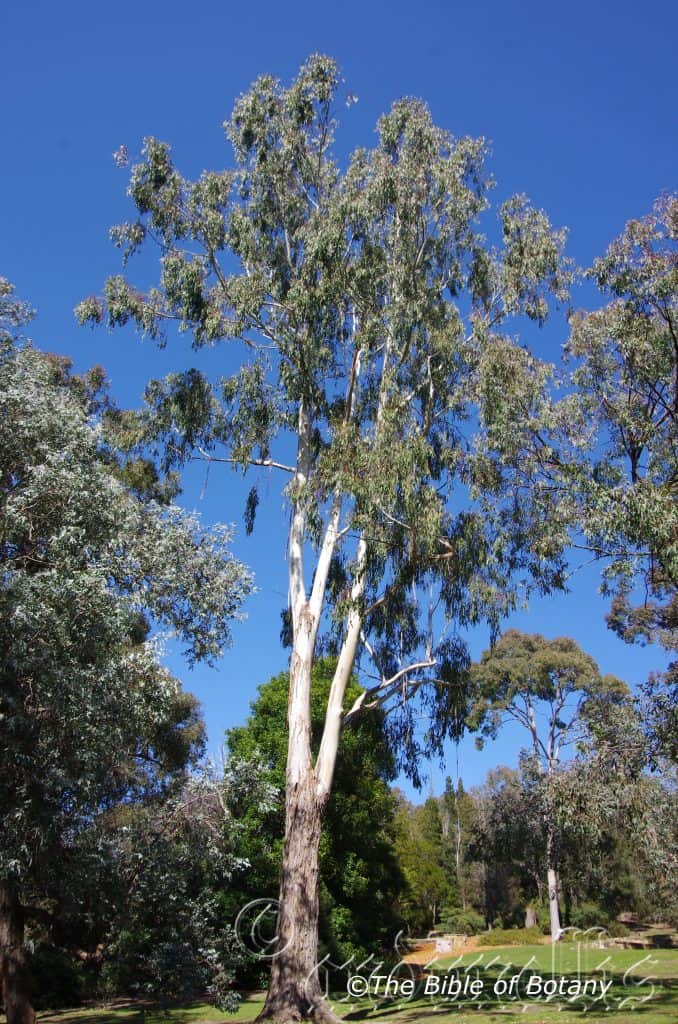

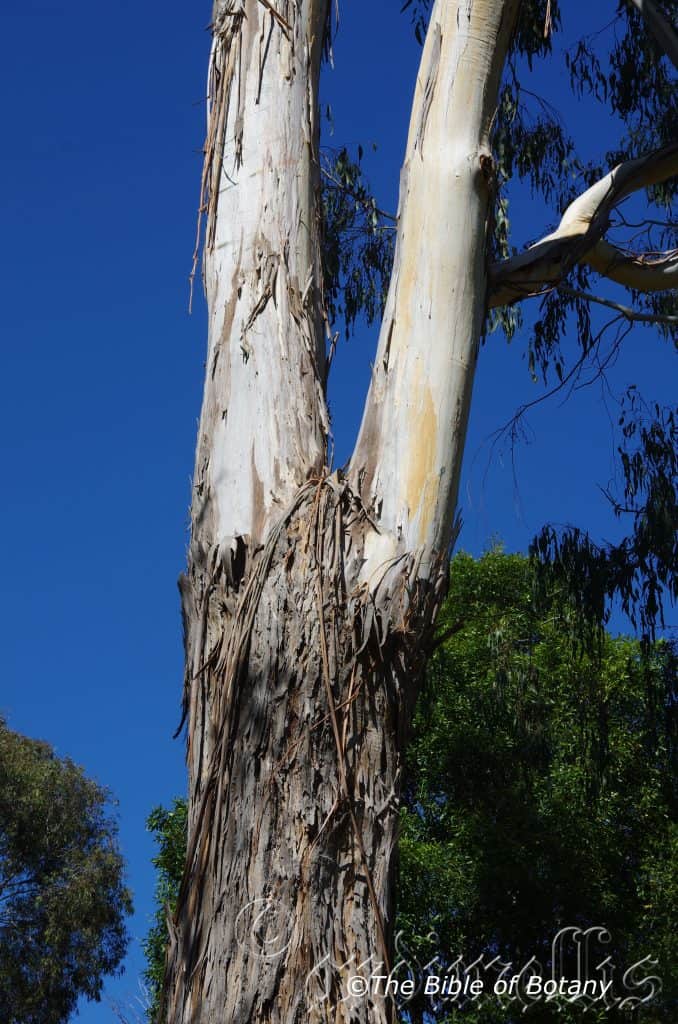
Eucalyptus dunnii
Classification:
Unranked: Eudicots
Clade: Rosids
Order: Myrtales
Family: Myrtaceae
Genus: From Eu, which is Greek a prefix for good or well and Kaluptos, which is Ancient Greek for to cover up. It refers to the stamens, which have a lid or cover over them in the bud stage prior to opening.
Specie: Is named in honour of Edward John Dunn; 1774-1851, who was a professor of Greek at the Edinburgh University.
Sub specie:
Common Name: White Gum.
Distribution:
Eucalyptus dunnii is found in 2 restricted populations south from Main Range National Park in far south east Queensland to the western section of the Richmond River National Park with the second population being found from the Nymboida Binderay National Park to Coramba in north eastern New South Wales. There is small population found between the 2 main populations in the middle reaches of the Clarence Valley. It is found on and east of the Great Dividing Range.
https://avh.ala.org.au/occurrences/search?taxa=Eucalyptus+dunni#tab_mapView
Habitat Aspect Climate:
Eucalyptus dunnii prefers full sun to light dappled shade. It grows in moist schlerophyll forest verging on warm temperate rainforest and cool subtropical rainforests from the altitude ranges from 300 meters ASL to 850 meters ASL.
The temperatures range from minus 3 degrees in August to 39 degrees in January.
The rainfall ranges from lows of 750mm to an average of 1300mm annually however additional moisture is received with orographic precipitation.
Soil Requirements:
Eucalyptus dunnii prefer better quality light clays to medium clays. The soils are usually derived from brown basalt or black basalt. The soils pH ranges from 5pH to 6.5pH. It does not tolerate water logged soils. Non saline soils to moderately saline soils are tolerated.
Height & Spread:
Wild Plants: 35m to 50m by 10m to 15m.
Characteristics:
Eucalyptus dunnii has a long thick bole with the first branches appearing at 55mm to 70mm of the trees height on mature trees. There is a grey to grey-brown, fibrous to flaky persistent stocking on the basal 3 meters of the trunk where it merges into the glabrous, white to pale grey twisted, mottled bark above. The smaller branches are smooth pale grey or grey-brown and glabrous. The small stems are mid olive-green tinged pinkish-purple and glabrous. The decorticating bark is shed in short ribbons.
Eucalyptus dunnii’s juvenile opposite leaves are orbicular to ovate and measure 40mm to 70mm in length by 20mm to 40mm in width. The bases are rounded to truncate while the apexes are acute. The concolourous laminas are bluish green semi glossy and glabrous. The margins are entire and undulating. The mid vein is slightly prominent on both laminas. The dull grey-green, purple tinged petioles measure 10mm to 15mm in length.
The alternate, disjunct adult leaves are narrow lanceolate to lanceolate are straight to slightly falcate and measure 130mm to 200mm in length and 13mm to 25mm in width. The olive–green to olive terete petioles are straight and measure 13mm to 25mm in length. The bases are cuneate while the apexes are tapering acute. The concolourous or discolourous laminas are deep green to grey-green, dull, semi glossy and glabrous on the upper laminas while the lower laminas are slightly paler and dull. The margins are entire and undulating. The mid vein is prominent on both laminas but more prominent below. The lateral veins are penniveined while the intramarginal veins are parallel to and run close to far from the margin. The oil glands are islands between the lateral veins and secondary veins.
The inflorescences of Eucalyptus dunnii are born as umbellasters containing 7 flowers from the leaf axils. The deep green tinged red peduncules are flattened terete or angular and glabrous while the deep green tinged deep red pedicels are terete and glabrous. The peduncules measure 7mm to 15mm in length while the terete pedicels measure 1mm to 5mm in length.
The ovoidal buds are deep green. The hypanthium measure 4mm to 4.5mm in length by 3mm to 4mm in diameter. The lime-green conical calyptras have a blunt acute to blunt rostrate apex. The calyptras measure 3mm to 3.5mm in length. The bud scar is present.
The erect to divaricate filaments are white and measure 4mm to 5mm in length. The fawn to pale brown anthers are oblong, versatile, dorsifixed and dehisce through longitudinal slits.
The short, stocky, pastel green style is erect and undulated. It measures 1.5mm to 2mm in length. The disc is lime-green. The flowers appear from December to March.
The fruits of Eucalyptus dunnii are hemispherical, conical or campanulate gum nuts. The glabrous gum nuts turn brown as they ripen. They measure 4mm to 5mm in length by 5mm to 8mm in diameter at the hypanthia. The discs are level or slightly raised while the 3 to 5 valves are exserted. The linear to cuboidal seeds measure 1.5mm to 2.5mm in length and are distinctly deep brown-black.
Wildlife:
The flowers of Eucalyptus dunnii are light nectar producers but are still very attractive to most honeyeaters, lorikeets, fruit bats and native bees.
Cultivation:
Eucalyptus dunnii is a medium to large gum tree which is very suitable for medium to large gardeners looking for a Eucalyptus to create a large bush scene. It is ideal on sandy loams, alluvial flats or medium clays that are well drained. It is fast growing so give good effects at an early age. In the garden good specimens grow from 25 to 30 meters in height by 15 meters to 20 meters in diameter when grown in the open. It is drought tolerant and can cope with moderate frosts.
This is not a popular cream flowering gum amongst home gardeners as most tend to favour the red flowering gum trees or those with a deep black furrowed bark. The bark contrasts well with other Eucalyptus specie, Corymbia specie, or rainforest specie with dissimilar trunks to high light the trunks and barks. Place it in the center of a forest as it is a lot taller, have a light canopy and will allow more light to penetrate deeper into the forest. It is too often planted singularly with gardeners not prepared to let their hair down and experiment with the pure whit trunk.
They would be ideally suited to a medium or large park like scenes where they have the opportunity to spread out as they mature.
Like all Eucalyptus specie leaf drop, dropping of small branches means continual lawn maintenance but then this means good quantities of leaf litter mulch. If the trees are clumped or used in a bush garden this is not a problem.
Propagation:
Seeds: Sow Eucalyptus dunnii’s seed directly into a seed raising mix. Cover the seeds with 2mm to 3mm of fine sand and place the trays in a warm sunny position. Keep moist but not wet. When the seedlings are 25mm to 50mm tall, prick them out and plant them into 50mm native tubes using a good organic mix.
Once the seedlings reach 200mm to 250mm in height plant them out into their permanent position. Mass plantings are best achieved by planting them at 4 meters to 5 meters where clumps are required or 6 meters to 7 meters where individuality is wanted in shape and the bark is used as a feature.
Fertilize using seaweed, fish emulsion or organic chicken pellets soaked in water on an alternate basis. Fertilize every two months until the plants are established then twice annually in early September or March to maintain health, vitality and better flowering.
Further Comments from Readers:
“Hi reader, it seems you use The Bible of Botany a lot. That’s great as we have great pleasure in bringing it to you! It’s a little awkward for us to ask, but our first aim is to purchase land approximately 1,600 hectares to link several parcels of N.P. into one at The Pinnacles NSW Australia, but we need your help. We’re not salespeople. We’re amateur botanists who have dedicated over 30 years to saving the environment in a practical way. We depend on donations to reach our goal. If you donate just $5, the price of your coffee this Sunday, We can help to keep the planet alive in a real way and continue to bring you regular updates and features on Australian plants all in one Botanical Bible. Any support is greatly appreciated. Thank you.”
In the spirit of reconciliation we acknowledge the Bundjalung, Gumbaynggirr and Yaegl and all aboriginal nations throughout Australia and their connections to land, sea and community. We pay our respect to their Elders past, present and future for the pleasures we have gained.
Eucalyptus elaeophloia
Classification:
Unranked: Eudicots
Clade: Rosids
Order: Myrtales
Family: Myrtaceae
Genus: From Eu, which is Greek a prefix for good or well and Kaluptos, which is Ancient Greek for to cover up. It refers to the stamens, which have a lid or cover over them in the bud stage prior to opening.
Specie: From Elaia, which is Ancient Greek for an olive and Phloios, which is Ancient Greek for bark. It refers to barks, which very closely resemble the bark of the European Olive trees.
Sub specie:
Common Name: Olive Mallee or Nunniong Gum (From the local Aboriginal word for the tree).
Distribution:
Eucalyptus elaeophloia is restricted to a very small area in central northern Victoria. It is found in the Victorian Alps on Nunniong Plateau with a disjunct population on the Cobberas Mountains.
https://avh.ala.org.au/occurrences/search?taxa=Eucalyptus+elaeophloia#tab_mapView
Habitat Aspect Climate:
Eucalyptus elaeophloia prefers full sun. It grows in exposed situations in mountainous country on a few ridges on the upper southern and northern slopes of knolls. The altitude ranges from 1420 meters ASL to 1500 meters ASL.
The temperatures range from minus 7 degree in August to 28 degrees in January.
The rainfall ranges from lows of 1000mm to an average of 1600mm annually of which most falls as snow.
Soil Requirements:
Eucalyptus elaeophloia prefers moderately fertile skeletal light clays. The soils are usually derived from decomposed metamorphic rocks. The soils pH most likely ranges from 6pH to 6.5pH. It does not tolerate water logged soils.Non saline soils to slightly saline soils are tolerated.
Height & Spread:
Wild Plants: 5m to 12m by 4.5m to 7m.
Characteristics:
Eucalyptus elaeophloia is a small mallee, with a single trunk to 12 meters but more often grows as a multi stemmed mallee tree in the vicinity of 5 meters to 8 meters. The bark is mostly smooth, red-brown and grey over greenish to coppery-orange. The bark decorticates in irregular patches. The stems, new flushes are smooth, slightly glaucous pink turning deep orange-red to red as they age.
Eucalyptus elaeophloia’s juvenile and coppice stems are terete and glaucous. The opposite, disjunct, sessile leaves are initially orbicular before becoming alternate and elliptic to ovate-elliptical and measure 30mm to 40mm in length by 20mm to 30mm in width. The concolourous laminas are a dull green to blue-green, glabrous and slightly glaucous. The margins are entire.
The alternate, disjunct, lanceolate to broad lanceolate leaves of Eucalyptus elaeophloia measure 60mm to 115mm in length by 15mm to 25mm in width. The compressed petioles measure 12mm to 25mm in length. The bases taper to the petiole while the apexes are acute with an apiculate tip. The concolourous laminas are dull to semi glossy bluish-green to green and glabrous. The margins are entire while the mid-vein is slightly prominent on both laminas. The lateral reticulation is dense while the minute oil glands are sparsely located between the reticulations.
The inflorescences of Eucalyptus elaeophloiaare umbellasters born auxiliary along the stems. There are 3 individual white flowers to the unbranched umbellaster. The stout, terete peduncles are glabrous, slightly glaucous and pink turning deep orange-red to red as they age. They measure 2mm to 4mm in length while the pedicels are sessile to 0.5mm in length. The ellipsoidal buds are reddish, glabrous, and slightly glaucous and measure 5mm to 7mm in length by 2mm to 3mm in diameter. The conical calyptra is shorter than and as wide as the hypanthium. A bud scar is present.
The white stamens are inflexed and measure 3mm to 4mm in length. The cream, orbicular anthers are dorsifixed and are all fertile. The creamy-yellow to red style measures 1mm to 2mm in length. The disc is pale yellow. The flowers appear during March.
The fruits of Eucalyptus elaeophloia are hemispherical woody capsules known as gum nuts. The deep green gum nuts turn deep brown when ripe and measure 4mm to 5.5mm in length by 7mm to 9mm in diameter at the widest point. The disc is ascending with the 3 triangular valves are exserted.
Confusing Subspecies Varieties:
Eucalyptus elaeophloia’s flowers have 3 buds on the umbellasters. It is restricted to Victoria.
Eucalyptus dalrympleana bark is greenish, with smaller sessile buds.
Eucalyptus glaucescens’s buds and adult leaves are not glaucous.
Eucalyptus imlayensis is the most closely related specie. It has a sparser crown and is a more slender tree or mallee which is restricted to the Mount Imlay district in New South Wales.
Eucalyptus. Perriniana’s juvenile leaves are not connate.
Eucalyptus stellulata’s flowers have 3 buds on the umbellasters while the leaves have a single main vein and have a densely reticulate venation.
Wildlife:
Eucalyptus elaeophloia wildlife is unknown to the author.
Cultivation:
Eucalyptus elaeophloia is a small tree or medium mallee which is ideally suitable for smaller gardens where a Eucalyptus is required. It is slower growing than most eucalyptus but make attractive garden specimens once established. They still look great and make a good affect from an early age. It looks very affective when planted with other mallees or small Eucalyptus trees with contrasting foliage and growth habits. Another method is to grow one or two as trees and interplant with several plants that have been cut to induce the growth of several trunks. In the garden good specimens may grow from 12 meters to 15 meters in height by 3 meters to 5 meters in diameter when grown in the open as a single trunk tree or 6 meters to 12 meters in height by 6 meters to 7 meters as a multi trunk tree when grown in the open.
Like all Eucalyptus spp. leaf drop, dropping of small branches means continual lawn maintenance but then this means good quantities of leaf litter mulch.
Eucalyptus elaeophloia can be used like many small Eucalyptus spp. to create that little bit of Australiana in the back yard.Often floral characteristics of a plant dictate our selection of plants for the garden. Remember that once a Eucalyptus spp.; or in fact any tree, reaches a reasonable size, its trunk or bark can are the most prominent features seen. Among the eucalyptus spp. there are many different types of barks which include some of our beautiful red smooth barks. Grouping, mallees as mallees or as single trunk trees can add immeasurably to the interest within a small space. Eucalyptus elaeophloia is one of those species whose multi stems and reddish bark contrasts well with single stem species which have white barks.
Small shrubs can be used to emphasize the open spaces surrounding a mallee or a small tree especially when mass plantings are done.
Eucalyptus elaeophloia can look great when placed in the corner against a fence to add privacy and remove the barrenness of the yard while giving extra depth.
Propagation:
Seeds: Sow into a seed raising mix. Cover the seeds with 2mm to 3mm of fine sand and place the trays in a warm sunny position. Keep the seeds moist but not wet. When the seedlings are 25mm to 50mm tall, prick them out and plant them into 50mm native tubes using a good organic mix.
Once the seedlings reach 200mm to 250mm in height plant them out into their permanent position. Mass plantings are best done in groups of 3 to 5 as a feature by planting them at 4 meter to 5 meter centers as a tree or 5 meters to 6 meters as a mallee.
Fertilize using Seaweed, fish emulsion or organic chicken pellets soaked in water and apply the liquid on an alternate basis. Fertilize every two month until the trees are well established then every spring to ensure good growth and flowering.
Further Comments from Readers:
“Hi reader, it seems you use The Bible of Botany a lot. That’s great as we have great pleasure in bringing it to you! It’s a little awkward for us to ask, but our first aim is to purchase land approximately 1,600 hectares to link several parcels of N.P. into one at The Pinnacles NSW Australia, but we need your help. We’re not salespeople. We’re amateur botanists who have dedicated over 30 years to saving the environment in a practical way. We depend on donations to reach our goal. If you donate just $5, the price of your coffee this Sunday, We can help to keep the planet alive in a real way and continue to bring you regular updates and features on Australian plants all in one Botanical Bible. Any support is greatly appreciated. Thank you.”
In the spirit of reconciliation we acknowledge the Bundjalung, Gumbaynggirr and Yaegl and all aboriginal nations throughout Australia and their connections to land, sea and community. We pay our respect to their Elders past, present and future for the pleasures we have gained.


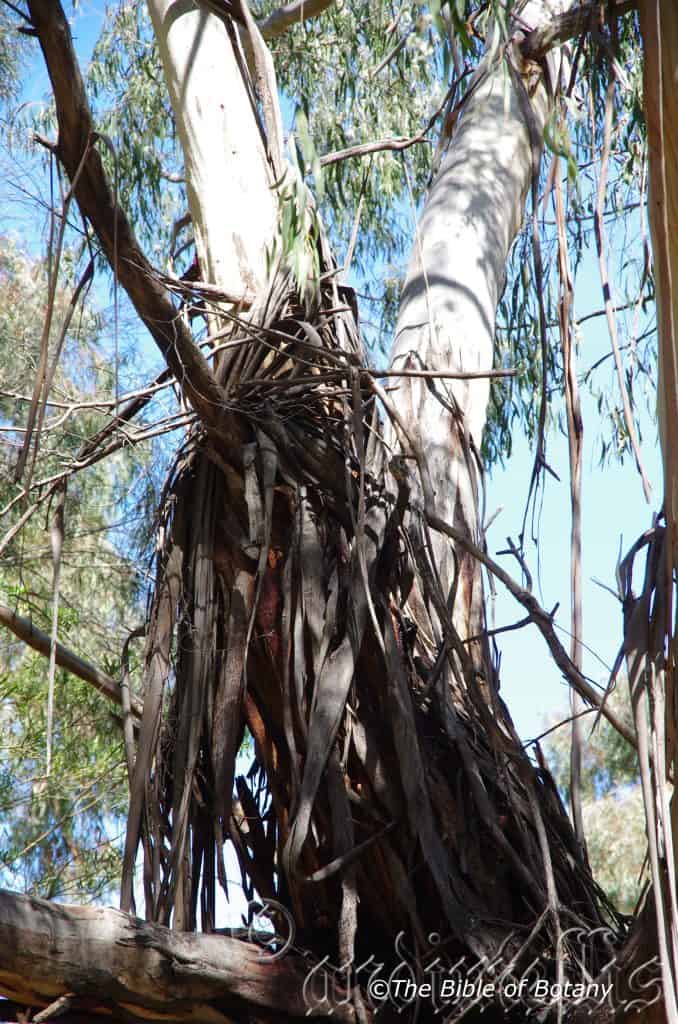
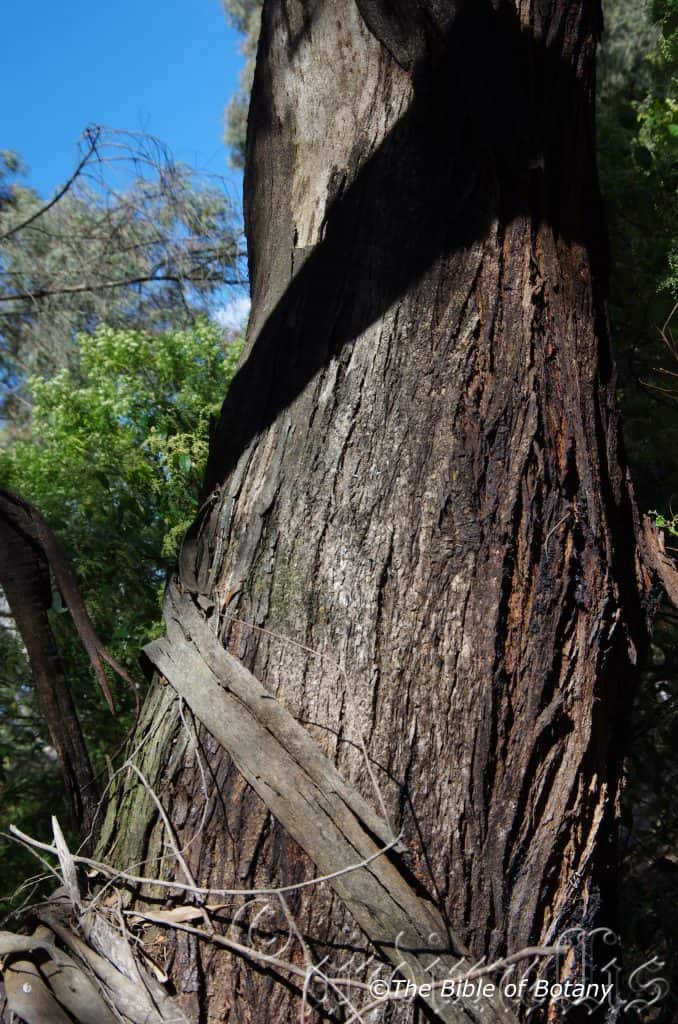


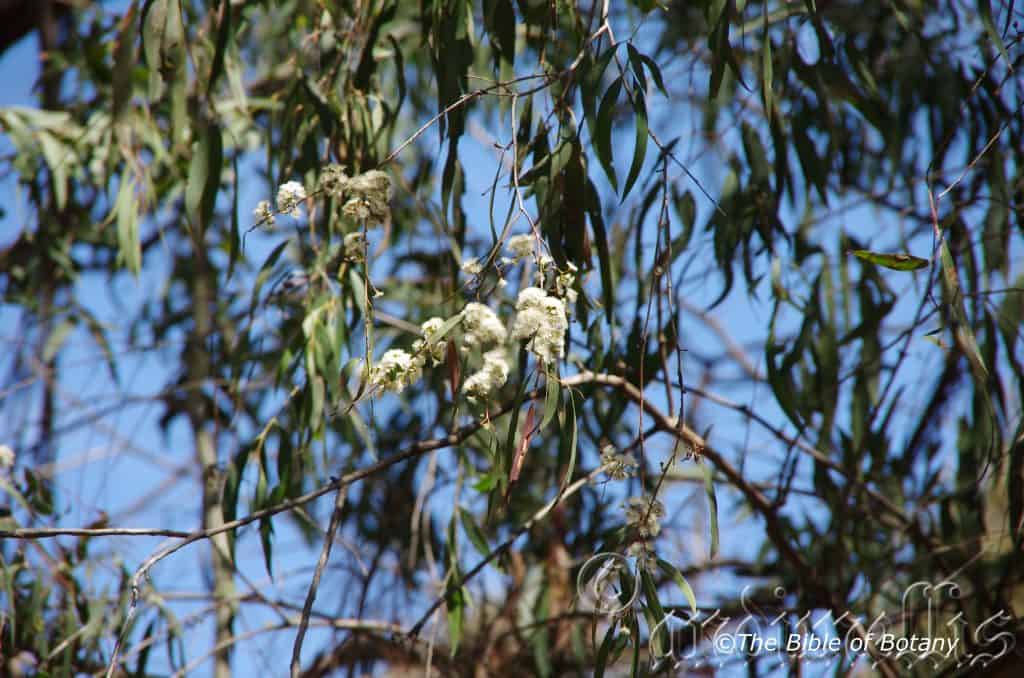
Eucalyptus elata
Classification:
Unranked: Eudicots
Clade: Rosids
Order: Myrtales
Family: Myrtaceae
Genus: From Eu, which is Greek a prefix for good or well and Kaluptos, which is Ancient Greek for to cover up. It refers to the stamens, which have a lid or cover over them in the bud stage prior to opening.
Specie: From ēlāta, which is Latin for lifted up, elevated, raised, lofty, high, having been elevated. It refers to plants, which have an elite status amongst its peers.
Sub specie:
Common Name:
Distribution:
Eucalyptus elata is found south from Singleton in central coastal New South Wales to central Victoria. It is mainly found on and east of the Great Dividing Range.
https://avh.ala.org.au/occurrences/search?taxa=Eucalyptus+eugenioides#tab_mapView
Habitat Aspect Climate:
Eucalyptus elata prefers full sun to light dappled shade. It is mainly found in dry schlerophyll, dry open Eucalyptus forests or grassy woodlands on stepper hills and mountains. The altitude ranges from 5 meters ASL to 1000 meters ASL.
The temperatures range from minus 4 degrees in August to 39 degrees in January.
The rainfall ranges from lows of 700mm to an average of 1200mm. Lower rainfall areas receive additional moisture through orographic precipitation.
Soil Requirements:
Eucalyptus elata prefers better quality, deep, medium silty clays. The soils are usually alluvial deposits associated with creeks and riparian zones along the coastal ranges. The soils pH ranges from 5pH to 6.5pH. It does not tolerate water logged soils though seasonal short term inundations are tolerated. Non saline soils to moderately saline soils are tolerated.
Height & Spread:
Wild Plants: 6m to 40m by 6m to 14m.
Characteristics:
Eucalyptus elata the trees bark on the lower trunk is rough, compacted, deep grey to black and smooth above, white or cream, pale brown and decorticate in ribbons. Small branches or stems are green or pale grey. In mallee forms the bark is smooth throughout. The juvenile stems are terete and glabrous or at times tuberculate.
The lanceolate to falcate, opposite juvenile leaves are sessile for many pairs and measure 33mm to 105mm in length by 6mm to 16mm in width. The bases are amplexicaul, while the apexes are narrow acute. The discolourous leaves are mid blueish-green on the upper lamina, while the lower lamina is glaucous.
The alternate mature leaves’ petioles measure 6mm to 20mm in length. The lanceolate to falcate leaves measure 60mm to 220mm in length by 6mm to 20mm in width. The base tapers to the petiole, while the apex is narrow acute. The discolourous, semi glossy leaves are mid green on the upper lamina, while the lower lamina is paler and dull. The mid vein is slightly prominent on the basal half of the lower lamina, while the lateral veins are sub parallel and sparsely reticulated. The intramarginal vein is parallel to and well removed from margin. There are numerous oil glands.
The axillary unbranched inflorescenses’ peduncles measure 4 mm to 12mm in length. There are 11 to 30 buds on each umbel. The pedicels measure 3mm to 5mm in length. The green to yellow, clavate mature buds measure 2mm to 4mm in length by 1.5mm to 3mm in diameter. The scar is absent, while the conical to obtuse or at times apiculate operculum is fully discarded after the white, inflexed or irregularly flexed stamens have bloomed. The reniform to cordate, versatile, dorsifixed anthers dehisce along confluent slits. The short style flares at its base and tapers or is blunt at the stigma.
The pedicellate pedicels on the capsules measure 1mm to 6mm in length. The hemispherical or truncate-globose capsules measure 3mm to 6mm in length by 3mm to 7mm in diameter. The disc is level with the rim or is descending, while the 3 or 4 valves are fully enclosed.
The black, brown or reddish-brown, pyramidal or obliquely pyramidal seeds has a smooth dorsal surface or are shallowly pitted and measure 1.5mm to 2.2mm in length.
Wildlife:
The flowers Eucalyptus elata are good nectar producers and are very attractive to most honeyeaters, lorikeets, flying foxes, possums and many insects.
Cultivation:
Eucalyptus elata is a medium to large gum tree which is suitable for medium to large gardeners looking for a Eucalyptus to create a large bush scene. It is ideal on sandy loams, alluvial flats or medium clays that are well drained. It is fast growing so give good effects at an early age. In the garden good specimens grow from 15 to 20 or possibly 30 meters in height by 12 meters to 16 meters in diameter when grown in the open. It is drought tolerant and can cope with moderate frosts. This gum tree has horizontal branches with a fairly dense canopy so may not be suitable for exposed windy conditions.
This is not a popular cream flowering gum amongst home gardeners as most tend to favour the red flowering gum trees or those with a deep black furrowed bark and much shorter trees. The bark contrasts well with other Eucalyptus specie, Corymbia specie, or rainforest specie with dissimilar trunks to high light the trunks and barks. Place it in the center of a forest and give them room to reach their full potential as it is a lot taller and wider than most gum trees. It is too often planted singularly with gardeners not prepared to let their hair down and experiment with stringy bark trunked trees.
They would be ideally suited to a medium or large park like scenes where they have the opportunity to spread out as they mature.
Like all Eucalyptus elata leaf drop, dropping of small branches means continual lawn maintenance but then this means good quantities of leaf litter mulch. If the trees are clumped or used in a bush garden this is not a problem.
Propagation:
Seeds: Sow Eucalyptus elata’s seed directly into a seed raising mix. Cover the seeds with 2mm to 3mm of fine sand and place the trays in a warm sunny position. Keep moist but not wet. When the seedlings are 25mm to 50mm tall, prick them out and plant them into 50mm native tubes using a good organic mix.
Once the seedlings reach 200mm to 250mm in height plant them out into their permanent position. Mass plantings are best achieved by planting them at 10 meters to 12 meters where clumps are required or 15 meters to 20 meters where individuality is wanted in shape and the bark is used as a feature.
Fertilize using seaweed, fish emulsion or organic chicken pellets soaked in water on an alternate basis. Fertilize every two months until the plants are established then twice annually in early September or March to maintain health, vitality and better flowering.
Further Comments from Readers:
“Hi reader, it seems you use The Bible of Botany a lot. That’s great as we have great pleasure in bringing it to you! It’s a little awkward for us to ask, but our first aim is to purchase land approximately 1,600 hectares to link several parcels of N.P. into one at The Pinnacles NSW Australia, but we need your help. We’re not salespeople. We’re amateur botanists who have dedicated over 30 years to saving the environment in a practical way. We depend on donations to reach our goal. If you donate just $5, the price of your coffee this Sunday, We can help to keep the planet alive in a real way and continue to bring you regular updates and features on Australian plants all in one Botanical Bible. Any support is greatly appreciated. Thank you.”
In the spirit of reconciliation we acknowledge the Bundjalung, Gumbaynggirr and Yaegl and all aboriginal nations throughout Australia and their connections to land, sea and community. We pay our respect to their Elders past, present and future for the pleasures we have gained.
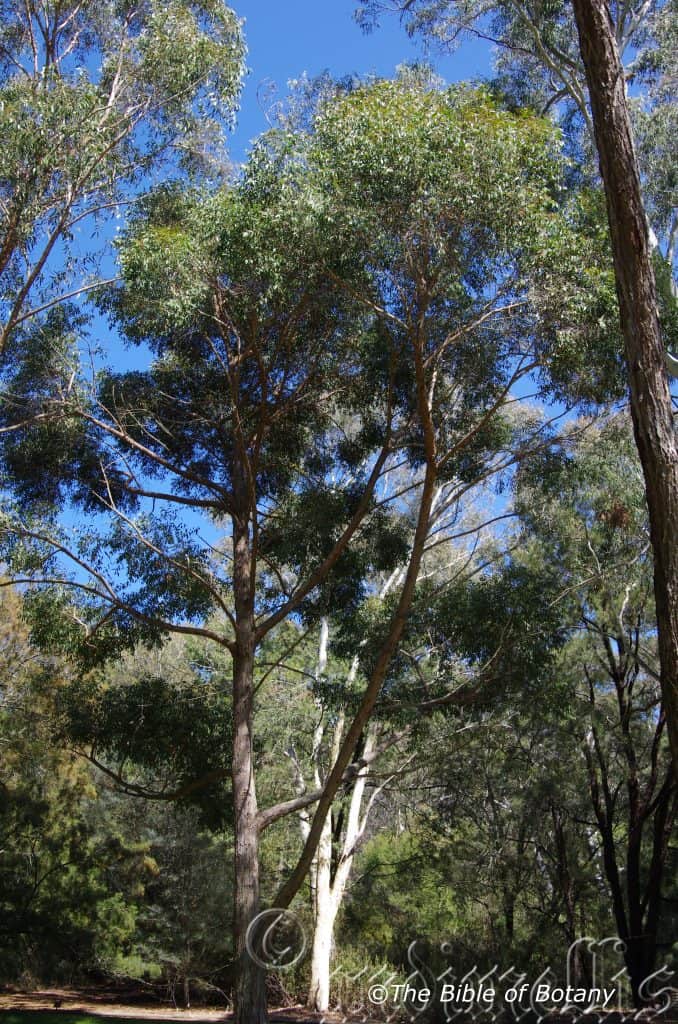
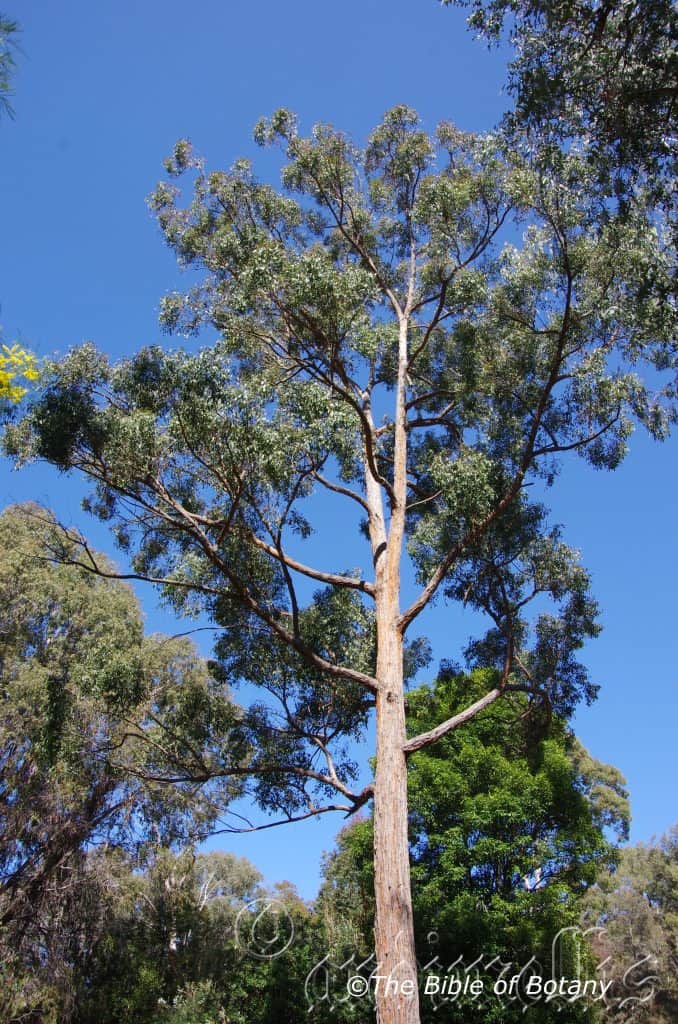


ZZ
Classification:
Unranked: Eudicots
Clade: Rosids
Order: Myrtales
Family: Myrtaceae
Genus: From Eu, which is Greek a prefix for good or well and Kaluptos, which is Ancient Greek for to cover up. It refers to the stamens, which have a lid or cover over them in the bud stage prior to opening.
Specie: Is named in honour of Prince Francois Eugene de Savoi-Carigan; 1663-1736, who developed a Botanical Garden near Venice and was a patron of biology and Eîdos/Oides, which is Ancient Greek for alike or similar to. It refers to the leaves being similar to those of the Eugenea genus in that they are opposite instead of being alternate.
Sub specie:
Common Name: Thin Leaf Stringybark.
Distribution:
Eucalyptus eugenioides
https://avh.ala.org.au/occurrences/search?taxa=Eucalyptus+eugenioides#tab_mapView
Habitat Aspect Climate:
Eucalyptus eugenioides prefers full sun to light dappled shade. It is mainly found in dry schlerophyll, dry open Eucalyptus forests or grassy woodlands on stepper hills and mountains. The altitude ranges from 8 meters ASL to 950 meters ASL.
The temperatures range from minus 4 degrees in August to 39 degrees in January.
The rainfall ranges from lows of 700mm to an average of 3000mm. Lower rainfall areas receive additional moisture through orographic precipitation.
Soil Requirements:
Eucalyptus eugenioides prefers better quality, deep, medium clays to heavy silty clays. The soils are usually derived from shale, granites fatty sandstone, metamorphic rocks, brown basalt or black basalt. The soils pH ranges from 4.5pH to 6pH. It does not tolerate water logged soils. Non saline soils to moderately saline soils are tolerated.
Height & Spread:
Wild Plants: 20m to 30m by 8m to 14m.
Characteristics:
Eucalyptus eugenioides has a long thick bole with the first branches appearing at 40mm to 70mm of the trees height on mature trees. The trunk has grey to grey-brown thick, spongy stringy bark to the smaller branches. The smaller branches are smooth pale grey or grey-brown and glabrous. The small stems are mid olive-green tinged pinkish-purple and glabrous. The bark is persistent.
Eucalyptus eugenioides’s juvenile sub opposite leaves are broad lanceolate and measure 40mm to 70mm in length by 15mm to 25mm in width. The oblique bases are rounded to truncate while the apexes are tapering acute. The concolourous laminas are mid to deep green, semi glossy and covered in reddish-brown hispid hairs. The margins are entire and slightly undulating. The mid vein is slightly prominent on both laminas. The dull grey-green, purple tinged petioles measure 8mm to 12mm in length.
The alternate, disjunct to wide sub opposite adult leaves are lanceolate, straight to slightly falcate and measure 100mm to 140mm in length and 20mm to 33mm in width. The olive–green to olive terete petioles are straight and measure 12mm to 18mm in length. The slightly oblique bases are cuneate while the apexes are tapering acute. The discolourous laminas are deep green and dull to semi glossy and glabrous on the upper laminas while the lower laminas are slightly paler and dull. The margins are entire. The laminas are flat and slightly undulating. The mid vein is prominent on both laminas but more prominent below. The lateral veins are penniveined while the intramarginal veins are parallel to and far from the margin. The oil glands are islands between the lateral veins and secondary veins.
The inflorescences of Eucalyptus eugenioides are born as umbellasters usually contain 9 to 11 flowers but 7 and 8 are not uncommon from the leaf axils. The flowers are white to cream born on flattened terete to angular peduncules while the pedicels are terete. The peduncules measure 6mm to 16mm in length while the pedicels measure 1mm to 4mm in length.
The cupular buds are mid green. The hypanthium measure 3mm to 3.5mm in length by 3mm to 4mm in diameter. The lime-green conical calyptras have a blunt acute to blunt rostrate apex. The calyptras measure 3mm to 4mm in length. The bud scar is absent.
The inflexed or irregularly flexed stamens are cream and measure 4mm to 4.5mm in length. The creamy yellow anthers are oblong, dorsifixed and dehisce through longitudinal slits.
The short, stocky, pastel green style is erect. It measures 1.5mm to 2mm in length. The disc is honey amber. The flowers appear from June to August depending on local weather conditions.
The fruits of Eucalyptus eugenioides are hemispherical gum nuts. They measure 4mm to 8mm in length by 5mm to 9mm in diameter. The disc is flat or slightly raised usually with 4 or rarely 5 exserted valves.
Wildlife:
The flowers Eucalyptus eugenioides are good nectar producers and are very attractive to most honeyeaters, lorikeets, flying foxes, possums and many insects. The Longhorn Beetle probably Adrium artifex has been observed exiting branches of ucalyptus eugenioides in the Nana Glen area.
Cultivation:
Eucalyptus eugenioides is a medium to large gum tree which is suitable for medium to large gardens, where a Eucalyptus is required to create a large bush scene. It is ideal on sandy loams, alluvial flats or medium clays that are well drained. It is fast growing so give good effects at an early age. In the garden good specimens grow from 15 to 20 meters in height by 12 meters to 16 meters in diameter when grown in the open. It is drought tolerant and can cope with moderate frosts. This gum tree has horizontal branches with a fairly dense canopy so may not be suitable for exposed windy conditions.
This is not a popular cream flowering gum amongst home gardeners as most tend to favour the red flowering gum trees or those with a deep black furrowed bark. The bark contrasts well with other Eucalyptus specie, Corymbia specie, or rainforest specie with dissimilar trunks to high light the trunks and barks. Place it in the center of a forest and give them room to reach their full potential as it is a lot taller and wider than most gum trees. It is too often planted singularly with gardeners not prepared to let their hair down and experiment with stringy bark trunked trees.
It would be ideally suited to a medium or large park like scenes where they have the opportunity to spread out as they mature.
Like all Eucalyptus specie leaf drop, dropping of small branches means continual lawn maintenance but then this means good quantities of leaf litter mulch. If the trees are clumped or used in a bush garden this is not a problem.
Propagation:
Seeds: Sow Eucalyptus eugenioides’s seed directly into a seed raising mix. Cover the seeds with 2mm to 3mm of fine sand and place the trays in a warm sunny position. Keep moist but not wet. When the seedlings are 25mm to 50mm tall, prick them out and plant them into 50mm native tubes using a good organic mix.
Once the seedlings reach 200mm to 250mm in height plant them out into their permanent position. Mass plantings are best achieved by planting them at 10 meters to 12 meters where clumps are required or 15 meters to 20 meters where individuality is wanted in shape and the bark is used as a feature.
Fertilize using seaweed, fish emulsion or organic chicken pellets soaked in water on an alternate basis. Fertilize every two months until the plants are established then twice annually in early September or March to maintain health, vitality and better flowering.
Further Comments from Readers:
“Hi reader, it seems you use The Bible of Botany a lot. That’s great as we have great pleasure in bringing it to you! It’s a little awkward for us to ask, but our first aim is to purchase land approximately 1,600 hectares to link several parcels of N.P. into one at The Pinnacles NSW Australia, but we need your help. We’re not salespeople. We’re amateur botanists who have dedicated over 30 years to saving the environment in a practical way. We depend on donations to reach our goal. If you donate just $5, the price of your coffee this Sunday, We can help to keep the planet alive in a real way and continue to bring you regular updates and features on Australian plants all in one Botanical Bible. Any support is greatly appreciated. Thank you.”
In the spirit of reconciliation we acknowledge the Bundjalung, Gumbaynggirr and Yaegl and all aboriginal nations throughout Australia and their connections to land, sea and community. We pay our respect to their Elders past, present and future for the pleasures we have gained.

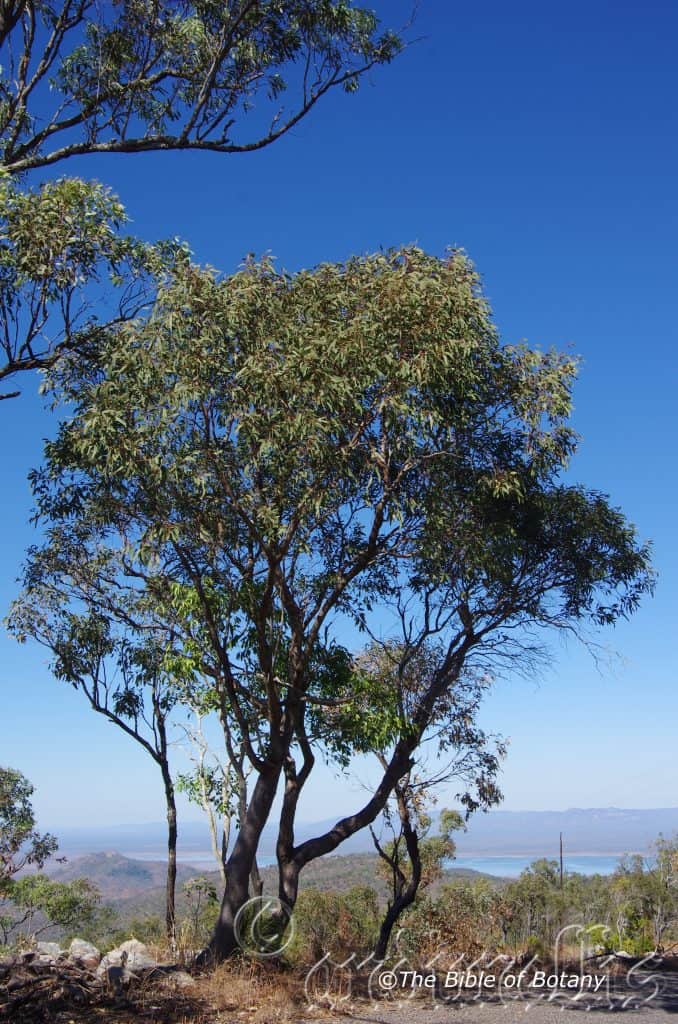
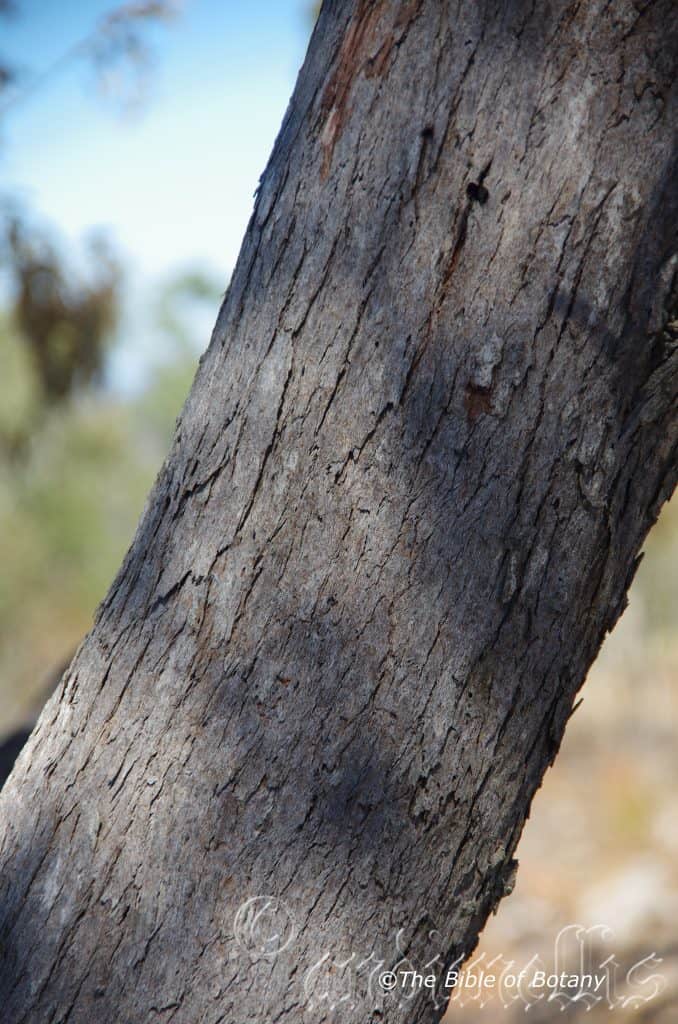




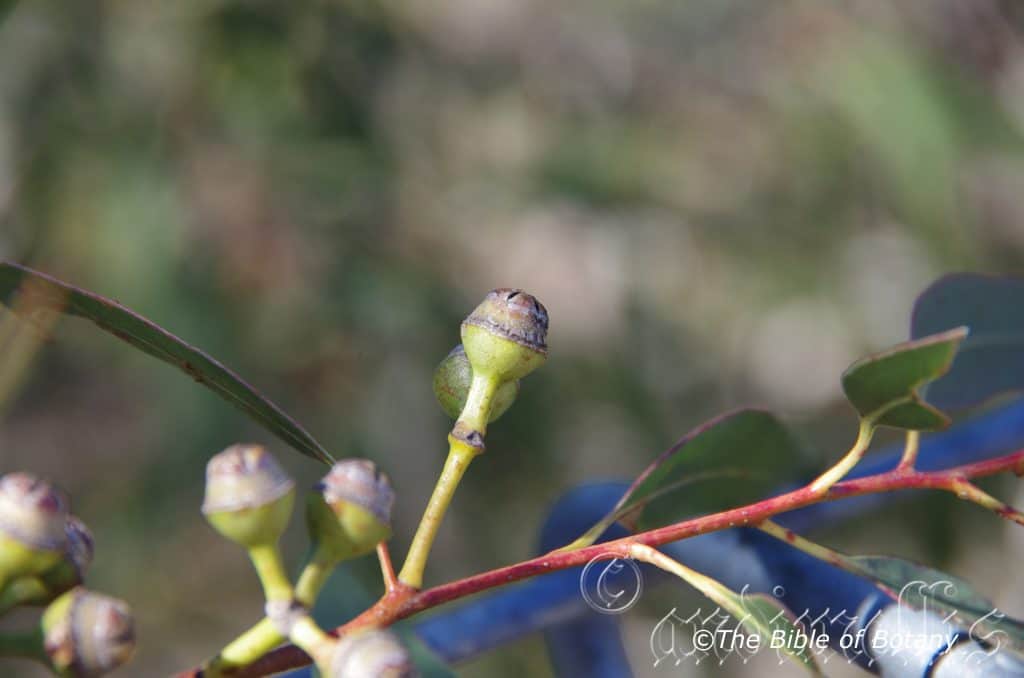
Eucalyptus exserta
Classification:
Unranked: Eudicots
Clade: Rosids
Order: Myrtales
Family: Myrtaceae
Genus: From Eu, which is Greek a prefix for good or well and Kaluptos, which is Ancient Greek for to cover up. It refers to the stamens, which have a lid or cover over them in the bud stage prior to opening.
Specie: From Exsertus, which is Latin for to be held outside or protruding. It refers to an organ, which protrudes beyond the other organs or structure.
Sub specie:
Common Name:
Distribution:
Eucalyptus exserta is widespread from far northeast Queensland south to far north eastern New South Wales and east to the coast.
It is found from the Melville Range south to south of Mount Garnet, west to the Gilbert River, south west to Barcaldine and south Lancewood Gully near Quilpe, south easterly to Pindara Dam then north east to Pine River in Moreton Bay.
https://avh.ala.org.au/occurrences/search?taxa=Eucalyptus+exserta#tab_mapView
Habitat Aspect Climate:
Eucalyptus exserta prefers full sun. It grows in exposed situations in dry schlerophyll woodlands on gentle to steep slopes, mountainous country on ridges and knolls. The altitude ranges from 30 meters ASL to 850 meters ASL.
The temperatures range from minus 3 degree in August to 38 degrees in January.
The rainfall ranges from lows of 300mm to an average of 2000mm.
Soil Requirements:
Eucalyptus exserta prefers poorer skeletal to deep light sandy loams to light fatty clays. The soils are usually derived from decomposed granites or at times sandstone. The soils pH ranges from 4.5pH to 7pH. It does not tolerate water logged soils.Non saline soils to the higher end of moderately saline soils and probably the low end of extremely saline soils are tolerated as are salt laden winds.
Height & Spread:
Wild Plants: 5m to 25m by 3m to 15m.
Characteristics:
Eucalyptus exserta is a small single trunk small tree. The typically peppermint bark is persistent on trunk and larger branches being grey to yellow-brown, shortly and fibrous from the base to the smaller branches. The branchlets are smooth grey, or lime green and reddish-brown at the extremes. The bark is shed in short ribbons on the smaller branches and branchlets.
Eucalyptus exserta’s juvenile and coppice stems are terete and glabrous. The opposite disjunct leaves are linear. The concolourous laminas are dull grey-green to dull green and glabrous. The margins are entire.
The alternate, disjunct, narrow-lanceolate or lanceolate falcate leaves of Eucalyptus exserta measure 80mm to 180mm in length by 6mm to 18mm in width. The terete petioles measure 12mm to 26mm in length. The bases are taper to the petiole and are shortly attenuate while the apexes are narrow acute. The concolourous laminas are semi glossy deep green to deep grey-green and glabrous. The margins are entire and often yellowish or paler while the mid-vein is barely prominent on both laminas. The lateral penniveins are visible on the both laminas while the intramarginal veins are well away from the margin. Oil dots are islands between the reticulations.
The inflorescences of Eucalyptus exsertaare umbellasters born auxiliary along the stems. There are 7 individual white flowers to an umbellaster. The new growth bearing the umbellasters is lime green and reddish-brown. The terete or angular peduncles are glabrous and measure 4mm to 20mm in length while the terete pedicels measure 0mm to 5mm in length. The ovoid or fusiform buds are yellowish to lime green, glabrous and measure 8mm to 13mm in length by 4mm to 5.5mm in diameter. The conical calyptra is longer than and as wide as the hypanthium. A bud scar is present.
The white stamens measure 12mm to 14mm in length. The cream, orbicular anthers are dorsifixed and are all fertile. The creamy-yellow style measures 2mm to 4mm in length. The disc is pale yellow to lemon-yellow. The flowers appear from mid-March to July.
The fruits of Eucalyptus exserta are globose or ovoidal woody capsules known as gum nuts. The deep green gum nuts turn grey-brown when ripe and measure 5mm to 8mm in length by 4.5mm to 9mm in diameter at the widest point. The disc is strongly raised with the 4 broad triangular valves being strongly exserted.
Wildlife:
The flowers of Eucalyptus exserta are heavy yielders of good quantities of high grade nectar and pollen. This makes them attractive to honeyeaters, lorikeets and apiarists along the east coast. They also attract many insects and insectivorous birds when in flower.
Cultivation:
Eucalyptus exserta is a small to medium tree which is ideally suitable for smaller gardens where a Eucalyptus is required. It can be slower growing than most eucalyptus because of the poor soils that it is associated with. Despite this it makes an attractive garden specimen once established. It still looks great and makes a good affect from an early age. It looks very affective when planted with other mallees or small Eucalyptus trees with contrasting foliage and growth habits. Another method is to grow one or two as trees and interplant with several plants that have been cut to induce the growth of several trunks. In the garden good specimens may grow from 15 meters to 20 meters in height by 5 meters to 8 meters in diameter when grown in the open as a single trunk tree or 6 meters to 10 meters in height by 6 meters to 8 meters as a multi trunk tree when grown in the open.
The beauty of Eucalyptus exserta is that it can be established on very poor rugged sites where water is a limiting factor and once established looks at home in such conditions. Like all Eucalyptus spp. though some leaf drop and dropping of small branchlets means continual lawn maintenance but then this means good quantities of leaf litter mulch in a native garden.
Eucalyptus exserta can be used like many small Eucalyptus spp. to create that little bit of Australiana in the suburban back yard or the outback garden to give shade from a relentless hot sun.
Often floral characteristics of a plant dictate our selection of plants for the garden. Remember that once a Eucalyptus spp.; or in fact any tree, reaches a reasonable size, its trunk or bark can are the most prominent features seen. Among the eucalypts there are many different types of barks which include some of our beautiful peppermint barks. Grouping, mallees as mallees or as single trunk trees can add immeasurably to the interest within a small space. Eucalyptus exserta is one of those species whose multi stems and bark contrasts well with single stem species.
Small shrubs can be used to emphasize the open spaces surrounding a mallee or a small tree especially when mass plantings are done.
Eucalyptus exserta can look great when placed in the corner against a fence to add privacy and remove the barrenness of the yard while giving extra depth.
Propagation:
Seeds: Sow into a seed raising mix. Cover the seeds with 2mm to 3mm of fine sand and place the trays in a warm sunny position. Keep the seeds moist but not wet. When the seedlings are 25mm to 50mm tall, prick them out and plant them into 50mm native tubes using a good organic mix.
Once the seedlings reach 200mm to 250mm in height plant them out into their permanent position. Mass plantings are best done in groups of 3 to 5 as a feature by planting them at 4 meter to 5 meter centers as a tree or 5 meters to 6 meters as a mallee.
Fertilize using Seaweed, fish emulsion or organic chicken pellets soaked in water and apply the liquid on an alternate basis. Fertilize every two month until the trees are well established then every spring to ensure good growth and flowering.
Further Comments from Readers:
“Hi reader, it seems you use The Bible of Botany a lot. That’s great as we have great pleasure in bringing it to you! It’s a little awkward for us to ask, but our first aim is to purchase land approximately 1,600 hectares to link several parcels of N.P. into one at The Pinnacles NSW Australia, but we need your help. We’re not salespeople. We’re amateur botanists who have dedicated over 30 years to saving the environment in a practical way. We depend on donations to reach our goal. If you donate just $5, the price of your coffee this Sunday, We can help to keep the planet alive in a real way and continue to bring you regular updates and features on Australian plants all in one Botanical Bible. Any support is greatly appreciated. Thank you.”
In the spirit of reconciliation we acknowledge the Bundjalung, Gumbaynggirr and Yaegl and all aboriginal nations throughout Australia and their connections to land, sea and community. We pay our respect to their Elders past, present and future for the pleasures we have gained.
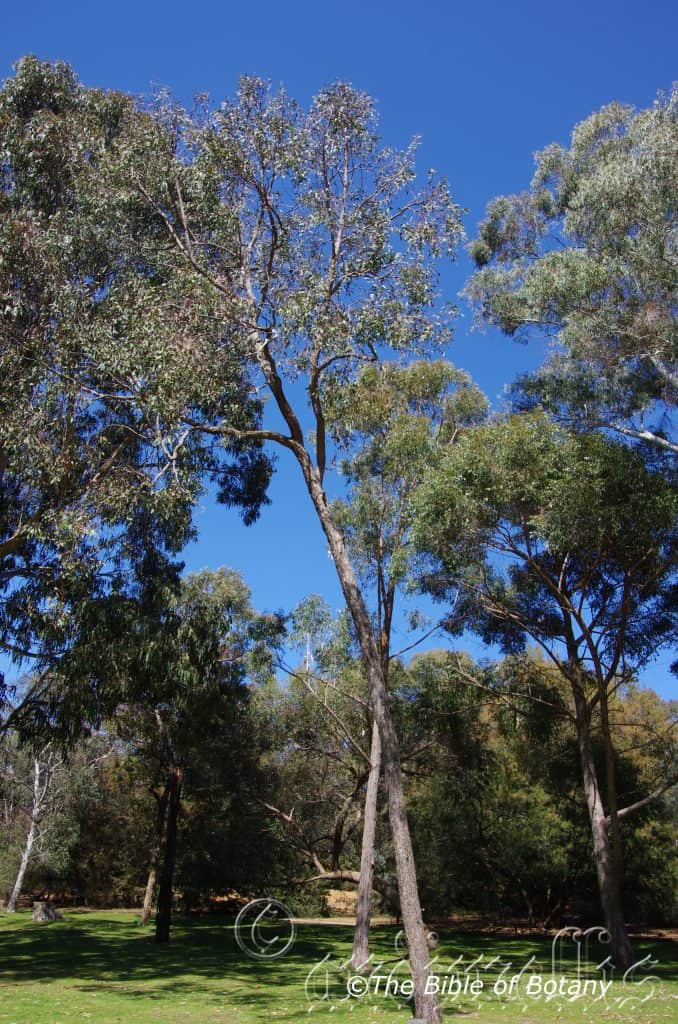
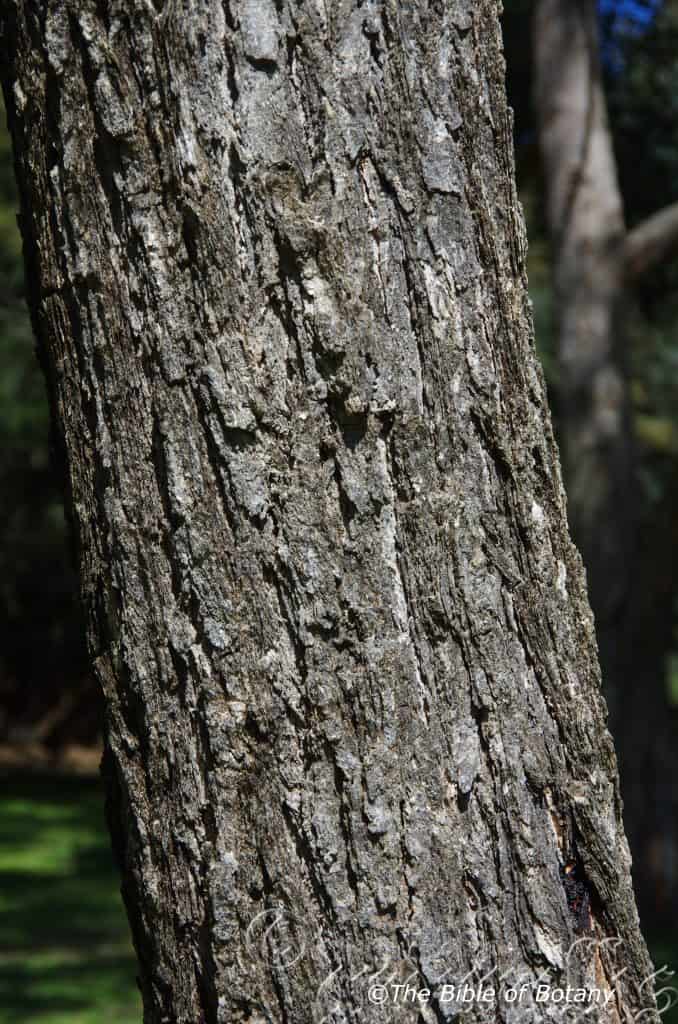
Eucalyptus fibrosa
Classification:
Unranked: Eudicots
Clade: Rosids
Order: Myrtales
Family: Myrtaceae
Genus: From Eu, which is Greek a prefix for good or well and Kaluptos, which is Ancient Greek for to cover up. It refers to the stamens, which have a lid or cover over them in the bud stage prior to opening.
Specie: From Fibratus, which is Latin for hair like streaks. It refers to the fibrous trunks of trees especially those in the Eucalyptus genus.
Sub specie:
Common Name: Red Ironbark.
Distribution:
Eucalyptus fibrosa is found south from North East Island in Shoalwater Bay and Alpha in central Queensland to near Parkes west of the Great Dividing Range and Moruya on the coast in south eastern New South Wales. There is also disjunct population south west of Wagga Wagga and an isolated population in far north Queensland in Girringun National Park. It is found on the Western Slopes, on and east of the Great Dividing Range.
https://avh.ala.org.au/occurrences/search?taxa=Eucalyptus+fibrosa#tab_mapView
Habitat Aspect Climate:
Eucalyptus fibrosa prefers full sun to light dappled shade. It grows in moist schlerophyll forest, moist Eucalyptus forests or woodlands. The altitude ranges from 10 meters ASL to 750 meters ASL.
The temperatures range from minus 3 degrees in August to 39 degrees in January.
The rainfall ranges from lows of 800mm to an average of 3000mm annually but this is complimented by orographic precipitation.
Soil Requirements:
Eucalyptus fibrosa prefers average to better quality fatty sandy loams to medium clays and heavy silt clays. The soils are derived from extremes in decomposed black basalt, brown basalt, sandstone, shale or accumulated coral sands. The soils pH ranges from 5pH to 6.5pH. It does not tolerate water logged soils. Non saline soils to moderately saline soils are tolerated as are salt laden winds.
Height & Spread:
Wild Plants: 20m to 35m by 7m to 14m.
Characteristics:
Eucalyptus fibrosa has a long thick bole with the first branches appearing at 40mm to 50mm of the trees height on mature trees. The trunk is a typical iron bark and has deep grey, deep grey-brown to almost black outer bark with a deep red-brown under bark. The thick, hard deeply longitudinally furrowed bark extends to the smaller branches. The smaller branches are smooth mid grey-green to mid grass-green often tinged orange-brown or red-brown and glabrous. The bark is persistent throughout.
Eucalyptus fibrosa’s juvenile, sub opposite to disjunct leaves are elliptical to ovate or orbicular and measure 80mm to 120mm in length by 25mm to 40mm in width. The dull yellow-green petioles are flattened terete and are straight or twisted and measure 9mm to 13mm in length. The slightly oblique, almost symmetrical bases are rounded-cuneate while the apexes are tapering acute. The concolourous laminas are mid blue-green, dull and glabrous. The margins are entire and maybe slightly thickened. The mid vein is prominent on both laminas on the basal two thirds and is not prominent on the apex third.
The disjunct alternate adult leaves are lanceolate to broad lanceolate, straight to slightly falcate and measure 120mm to 180mm in length and 25mm to 50mm in width. The slightly oblique bases are cuneate while the apexes are narrow acute. The concolourous to slightly discolourous laminas are deep green and dull and glabrous on the upper laminas while the lower laminas are slightly paler. The margins are entire and flat. The mid vein is prominent on both laminas on the basal two thirds and is not prominent on the apex third. The lateral veins are penniveined while the intramarginal veins are parallel to and far from the margin. The oil glands are islands between the lateral veins and secondary veins. The dull yellow-green petioles are flattened terete and are straight or twisted and measure 9mm to 13mm in length.
The inflorescences of Eucalyptus fibrosa are born as compound umbellasters with 5 to 8 umbellasters which each contain 7 to 11 flowers from near the terminals. The flowers are white to cream born on terete to angular peduncules while the pedicels are terete. The peduncules measure 6mm to 20mm in length while the pedicels measure 2mm to 7mm in length.
The fusiform buds are mid yellow-green to lime green and maybe tinged red. The hypanthium measure 6mm to 9mm in length by 4mm to 5mm in diameter. The mid yellow-green to lime green and maybe tinged red elongated conical calyptras have an obtuse apex. The calyptras measure 6mm to 9mm in length by 3.5mm to 4mm in diameter at the base. The bud scar is present.
The regularly flexed stamens are cream or white and measure 7mm to 11mm in length. The anthers are creamy yellow.
The thick cream style is erect. It measures 4.5mm to 7mm in length. The disc is pale lime-green. The flowers appear erratically from December to February.
The fruits of Eucalyptus fibrosa are conical to pyriform gum nuts. The gum nuts measure 6mm to 12mm in length by 5mm to 10mm in diameter. The disc is raised usually with 4 or 5 exserted valves. The flattened seeds are long ovoid and measure 1mm to 2mm in length.
Wildlife:
The flowers Eucalyptus fibrosa are very prolific nectar producers but flowering can be very erratic. They support all small to large honeyeaters and lorikeets as well as fruit bats and myriads of insects.
Cultivation:
Eucalyptus fibrosa is a medium gum tree which is suitable for medium to large gardens where a Eucalyptus is required to create a large bush scene or a spreading tree in the park scene. It is an ideal tree for growing on skeletal sandy loams, alluvial flats or medium clays that are well drained. It is fast growing so give good effects at an early age. In the garden good specimens grow from 10 to 15 meters in height by 12 meters to 15 meters in diameter when grown in the open. It is drought tolerant and can cope with moderate frosts. This gum tree has a dense wide canopy when grown in the open however exposed positions that receive a lot of wind should be avoided.
This is not a popular cream flowering gum amongst home gardeners but really should be grown more in larger gardens. Most gardeners tend to favour the red flowering gum trees. The bark contrasts well with other Eucalyptus specie, Corymbia specie, or rainforest specie with dissimilar trunks to high light the trunks and barks. Place it near the edge of a forest and give them room to reach their full potential as it is a not as tall and their wider spread is a feature worth showing off. Trees planted in full view make good bird watching trees for the nectar eating birds and insect eating birds alike. It is rather messy when the lorikeets clamber over the outer foliage.
It would be ideally suited to a medium or large park like scenes where they have the opportunity to spread out as they mature.
Like all Eucalyptus specie leaf drop, dropping of small branches means continual lawn maintenance but then this means good quantities of leaf litter mulch. If the trees are clumped or used in a bush garden this is not a problem.
Propagation:
Seeds: Sow into a seed raising mix. Cover the seeds with 2 to 3mm of fine sand and place the trays in a warm sunny position. Keep moist but not wet. When the seedlings are 25mm to 50mm tall, prick them out and plant them into 50mm native tubes using a good organic mix.
Once the seedlings reach 200mm to 250mm in height plant them out into their permanent position. Mass plantings are best done in groups of 3 to 5 as a feature by planting them at 4 meter centers. For hedge rows or wind breaks they can be planted at 3 meter centers.
Fertilize using Seaweed, fish emulsion or organic chicken pellets soaked in water and apply the liquid on an alternate basis. Fertilize every two month until the trees are well established then every spring to ensure good growth and flowering.
Further Comments from Readers:
“Hi reader, it seems you use The Bible of Botany a lot. That’s great as we have great pleasure in bringing it to you! It’s a little awkward for us to ask, but our first aim is to purchase land approximately 1,600 hectares to link several parcels of N.P. into one at The Pinnacles NSW Australia, but we need your help. We’re not salespeople. We’re amateur botanists who have dedicated over 30 years to saving the environment in a practical way. We depend on donations to reach our goal. If you donate just $5, the price of your coffee this Sunday, We can help to keep the planet alive in a real way and continue to bring you regular updates and features on Australian plants all in one Botanical Bible. Any support is greatly appreciated. Thank you.”
In the spirit of reconciliation we acknowledge the Bundjalung, Gumbaynggirr and Yaegl and all aboriginal nations throughout Australia and their connections to land, sea and community. We pay our respect to their Elders past, present and future for the pleasures we have gained.


Eucalyptus fusiformis
Classification:
Unranked: Eudicots
Clade: Rosids
Order: Myrtales
Family: Myrtaceae
Genus: From Eu, which is Greek a prefix for good or well and Kaluptos, which is Ancient Greek for to cover up. It refers to the stamens, which have a lid or cover over them in the bud stage prior to opening.
Specie: From Fusus, which is Latin for a spindle and Forme, which is Latin for to take the shape or form of. It refers to the shape of capsules or at times buds or other organs, which are swollen in the middle and taper at each end like a spindle.
Sub specie:
Common Name: Grey Ironbark.
Distribution:
Eucalyptus fusiformis is found in several disjunct populations south from south Brisbane to Wang Waulk State Forest west of Forster in central coastal New South Wales. It is found on the Great Dividing Range.
https://avh.ala.org.au/occurrences/search?taxa=Eucalyptus+fusiformis#tab_mapView
Habitat Aspect Climate:
Eucalyptus fusiformis prefers full sun to light dappled shade. It grows in moist riparian forests, gallery forests or river flat plain forests. The altitude ranges from 22 meters ASL to 1020 meters ASL.
The temperatures range from minus 2 degrees in August to 39 degrees in January.
The rainfall ranges from lows of 800mm to an average of 1600mm annually.
Soil Requirements:
Eucalyptus fusiformis prefers average quality sandy loams to silty medium clays. The soils are usually derived from sandstone, brown basalt or black basalt. The soils pH ranges from 4.5pH to 6pH. It does not tolerate water logged soils. Non saline soils to moderately saline soils are tolerated as are salt laden winds.
Height & Spread:
Wild Plants: 20m to 30m by 8m to 14m.
Characteristics:
Eucalyptus fusiformis has a long thick bole with the first branches appearing at 60mm to 70mm of the trees height on mature trees. The trunk is a typical iron bark and has deep grey, deep grey-brown to almost black outer bark with a deep grey-brown under bark. The thick, hard deeply longitudinally furrowed bark extends to the intermediate branches. The intermediate branches are rough and flaky while the smaller branches are mid grass-green often at first appearing as deep maroon-purple, glabrous and glossy. The bark is persistent throughout. The stems are angulated on juvenile and coppice growth.
Eucalyptus fusiformis’s juvenile leaves are opposite and shortly petiolate for the first 4 to 7 nodes where they quickly become alternate and disjunct. The ovate to broad elliptical leaves measure 40mm to 100mm in length by 25mm to 35mm in width. The concolourous mid green leaves are semi glossy to dull and glabrous. The margins are entire and maybe slightly thickened. The mid vein is prominent on both laminas. The dull yellow-green or maroon-purple petioles are terete straight and measure 2mm to 5mm in length.
The disjunct alternate adult leaves are lanceolate to broad lanceolate, straight to falcate and measure 80mm to 150mm in length and 15mm to 48mm in width. The dull yellow-green to maroon-purple petioles are terete and are straight or slightly twist to 45 degrees and measure 9mm to 13mm in length. The slightly oblique to oblique bases are cuneate or narrow cuneate on one side and broad cuneate on the other while the apexes are acuminate. The slightly discolourous or rarely concolourous laminas are deep green to mid blue-green, dull and glabrous on the upper laminas while the lower laminas are slightly paler. The margins are entire and flat. The mid vein is prominent on both laminas. The lateral veins are penniveined and are greater than 45° to midrib. The intramarginal veins are parallel to and close to the margin or well removed from it. The few oil glands are mostly intersectional.
The inflorescences of Eucalyptus fusiformis are born as compound terminal panicles which contain 7 individual flowers from near the terminals. The flowers peduncules are flattened to angular while the pedicels are terete or angular. The peduncules measure 12mm to 15mm in length while the pedicels measure 3mm to 7mm in length.
The ovoid to shortly fusiform buds are mid yellow-green to lime green and turn creamy pink tinged red prior to opening. The hypanthium measure 4mm to 6mm in length by 3.5mm to 5mm in diameter. The mid yellow-green to lime green and turn creamy pink tinged red prior to opening elongated, narrow, conical calyptras have a narrow obtuse or rostrate apex. The calyptras measure 3mm to 4.5mm in length by 2.5mm to 4mm in diameter at the base. The bud scar is present.
Most of the white to cream stamens are inflexed with a few irregularly flexed. The inner stamens are fertile while the outer stamens are sterile. The cream cuboidal, adnate anthers are positioned obliquely at filament tip and dehisce through terminal pores. The filaments measure 8mm to 11mm in length
The cream to white style is erect and has a lime-green to deep green stigma. It measures 4mm to 5mm in length. The disc is lime-green to deep green. The flowers appear erratically from December to February.
The fruits of Eucalyptus fusiformis are conical to pyriform or ovoid gum nuts. The gum nuts measure 7mm to 12mm in length by 4mm to 7mm in diameter. The disc is depressed with 3 or 4 enclosed valves.
The flattened to ovoidal brown seeds are pointed at one end and measure 1.4mm to 2mm in length. The dorsal surface is shallowly reticulate with the hilum being ventral.
Wildlife:
The flowers Eucalyptus fusiformisare moderate nectar producers but are still are very attractive to most honeyeaters, lorikeets, flying foxes, possums and many insects.
Cultivation:
Eucalyptus fusiformis is a medium gum tree which is suitable for medium to large gardens where a Eucalyptus specie is required to create a large bush scene or a spreading tree in the park scene. It is an ideal tree for growing on skeletal sandy loams, alluvial flats or medium clays that are well drained. It is fast growing and look particularly handsome in the early years with branches forming and being retained to almost ground level. In the garden good specimens grow from 12 to 16 meters in height by 10 meters to 15 meters in diameter when grown in the open. It can be pruned to maintain this habit and responds very well to pruning.
It is drought tolerant and can cope with moderate frosts. This gum tree has dense wide canopy when grown in the open. Because of this exposed positions that receive a lot of wind should be avoided.
The bark contrasts well with other Eucalyptus specie, Corymbia specie, or rainforest specie with dissimilar trunks to high light the trunks and barks. Place it near the edge of a forest and give them room to reach their full potential as it is a not as tall and their wider spread is a feature worth showing off. Trees planted in full view make good bird watching trees for the nectar eating birds and insect eating birds alike. It is rather messy when the lorikeets clamber over the outer foliage.
It would be ideally suited to a medium or large park like scenes where they have the opportunity to spread out as they mature.
Like all Eucalyptus specie leaf drop, dropping of small branches means continual lawn maintenance but then this means good quantities of leaf litter mulch. If the trees are clumped or used in a bush garden this is not a problem.
Propagation:
Seeds: Sow Eucalyptus fusiformis seeds into a seed raising mix. Cover the seeds with 2 to 3mm of fine sand and place the trays in a warm sunny position. Keep moist but not wet. When the seedlings are 25mm to 50mm tall, prick them out and plant them into 50mm native tubes using a good organic mix.
Once the seedlings reach 200mm to 250mm in height plant them out into their permanent position. Mass plantings are best done in groups of 3 to 5 as a feature by planting them at 4 meter centers. For hedge rows or wind breaks they can be planted at 3 meter centers.
Fertilize using Seaweed, fish emulsion or organic chicken pellets soaked in water and apply the liquid on an alternate basis. Fertilize every two month until the trees are well established then every spring to ensure good growth and flowering.
Further Comments from Readers:
“Hi reader, it seems you use The Bible of Botany a lot. That’s great as we have great pleasure in bringing it to you! It’s a little awkward for us to ask, but our first aim is to purchase land approximately 1,600 hectares to link several parcels of N.P. into one at The Pinnacles NSW Australia, but we need your help. We’re not salespeople. We’re amateur botanists who have dedicated over 30 years to saving the environment in a practical way. We depend on donations to reach our goal. If you donate just $5, the price of your coffee this Sunday, We can help to keep the planet alive in a real way and continue to bring you regular updates and features on Australian plants all in one Botanical Bible. Any support is greatly appreciated. Thank you.”
In the spirit of reconciliation we acknowledge the Bundjalung, Gumbaynggirr and Yaegl and all aboriginal nations throughout Australia and their connections to land, sea and community. We pay our respect to their Elders past, present and future for the pleasures we have gained.
Eucalyptus glaucina
Classification:
Unranked: Eudicots
Unranked: Rosids
Order: Myrtales
Family: Myrtaceae
Genus: From Eu, which is Greek a prefix for good or well and Kaluptos, which is Ancient Greek for to cover up. It refers to the stamens, which have a lid or cover over them in the bud stage prior to opening.
Specie: From Glaucous, which is Latin for a filmy blueish or greyish white powdery covering
Sub specie:
Common Name: Slaty Red Gum.
Distribution:
Eucalyptus glaucina prefer full sun. It grows in grassy woodlands and open Eucalyptus forests on flats and plains close to the coast. The altitude ranges from 25 meters ASL to 300 meters ASL.
glaucina is located in 2 disjunct populations in north eastern New South Wales, south from Casino near Dryaaba to south Grafton and from Taree, Gloucester, Musslebrooke and WoyWoy.
https://avh.ala.org.au/occurrences/search?taxa=Eucalyptus+glaucina#tab_mapView
Habitat Aspect Climate:
Eucalyptus glaucina prefer full sun. It grows in grassy woodlands and open Eucalyptus forests on flats and plains close to the coast. The altitude ranges from 25 meters ASL to 300 meters ASL.
The temperatures range from minus 3 degrees in August to 40 degrees in January.
Rainfall ranges from lows of 850mm to an average of 1250mm annually.
Soil Requirements:
Eucalyptus glaucina prefer deep grey sandy loams to medium clays. The soils are mainly sedimentary deposits derived from better quality decomposed sandstone mixed brown basalts or shale. It does not tolerate water logged soils however the soils are usually damp throughout the year and can have seasonal flooding or high water tables. The soils pH ranges from 4.5pH to 6pH. It does not tolerate water logged soils. Non saline soils to moderately saline soils are tolerated.
Height & Spread:
Wild Plants: 20m to 34m by 14m to 18m.
Characteristics:
Eucalyptus glaucina has a short thick bole with the first branches appearing at 15mm to 30mm of the trees height on mature trees. The trunk is a typical smooth gum with off white, creamy grey or pale grey-blue, mottled, glabrous and extends to the smallest branchlets. The branchlets are mid grass-green often at first appearing as deep maroon-red, glabrous and glossy. The decorticating bark sheds in large plates or flakes to reveal a creamy salmon inner bark. The stems are terete on juvenile and coppice growth.
Eucalyptus glaucina’s Juvenile leaves are opposite and shortly petiolate for the first 6 to 9 nodes where they quickly become alternate and disjunct. The ovate leaves measure 40mm to 80mm in length by 25mm to 35mm in width. The concolourous mid grey-green leaves are dull and glabrous. The margins are entire and maybe slightly thickened. The mid vein is prominent on both laminas. The dull yellow-green or maroon-purple petioles are terete straight and measure 2mm to 5mm in length.
The disjunct alternate adult leaves are lanceolate, straight or falcate on the apex half and measure 120mm to 180mm in length and 20mm to 32mm in width. The dull yellow-green to maroon-purple petioles are terete and are straight and measure 12mm to 26mm in length. The slightly oblique to oblique, asymmetrical bases are cuneate while the apexes are narrow acute. The concolourous laminas are green to mid grey-green, dull and glabrous. The margins are entire and flat. The mid vein is slightly prominent on both laminas becoming almost level near the apexes. The lateral veins are penniveined and are greater than 45° to the midrib. The intramarginal veins are parallel to and close to the margin or well removed from it. The few oil glands are islands between the lateral veins.
The inflorescences of Eucalyptus glaucina are born as umbellasters which contain 7 individual flowers from the upper leaf axils. The flowers peduncules are terete to strongly 4 angular while the pedicels are terete. The peduncules measure 12mm to 20mm in length while the pedicels measure 2mm to 5mm in length.
The fusiform buds are grey-green, blue-green or mid yellow-green, glabrous and glaucous. The hypanthium measure 4mm to 6.5mm in length by 5mm to 6mm in diameter. The mid lime-green often tipped tinged pink or orange especially near the apex prior to opening elongated; narrow, conical calyptras have an obtuse apex. The calyptras measure 5mm to 8.5mm in length by 5mm to 6mm in diameter at the base. The bud scar is present.
Most of the white to cream stamens are inflexed with a few irregularly flexed. The anthers are cream, cuboid and adnate. The filaments measure 8mm to 12mm in length
The cream to white style is erect and has a lime-green to deep green stigma. It measures 4mm to 5mm in length. The disc is lime-green to deep green. The flowers appear erratically from August to December.
The fruits of Eucalyptus glaucinaare globose or ovoid gum nuts. The gum nuts measure 7mm to 10mm in length by 7mm to 10mm in diameter. The disc is raised with 3 to 5 exserted valves. The flattened to ovoidal brown seeds are pointed at one end and measure 1.4mm to 2mm in length. The dorsal surface is shallowly reticulate with the hilum being ventral.
Wildlife:
The flowers Eucalyptus glaucina are light nectar producers but are still are very attractive to most honeyeaters, lorikeets, flying foxes, possums and many insects.
Cultivation:
Eucalyptus glaucina is a medium gum tree which is suitable for medium to large gardens where a Eucalyptus specie is required to create a large bush scene or a spreading tree in the park scene. It is ideal on deep sandy loams, alluvial flats or medium clays that are well drained. It is relatively fast growing and look particularly handsome in the early years with branches forming and being retained to almost ground level. In the garden good specimens grow from 12 to 18 meters in height by 8 meters to 12 meters in diameter when grown in the open.
It is drought tolerant and can cope with moderate frosts. This gum tree has dense wide canopy when grown in the open. Because of this exposed positions that receive a lot of wind should be avoided.
This is not a popular cream flowering gum amongst home gardeners but really should be grown more in larger gardens. Most gardeners tend to favour the red flowering gum trees. The bark contrasts well with other Eucalyptus specie, Corymbia specie, or rainforest specie with dissimilar trunks to high light the trunks and barks. Place it near the edge of a forest and give them room to reach their full potential as it is a not as tall and their wider spread is a feature worth showing off. Trees planted in full view make good bird watching trees for the nectar eating birds and insect eating birds alike. It is rather messy when the lorikeets clamber over the outer foliage.
It would be ideally suited to a medium or large park like scenes where they have the opportunity to spread out as they mature.
Like all Eucalyptus specie leaf drop, dropping of small branches means continual lawn maintenance but then this means good quantities of leaf litter mulch. If the trees are clumped or used in a bush garden this is not a problem.
Propagation:
Seeds: Sow Eucalyptus glaucina seeds into a seed raising mix. Cover the seeds with 2mm to 3mm of fine sand and place the trays in a warm sunny position. Keep moist but not wet. When the seedlings are 25mm to 50mm tall, prick them out and plant them into 50mm native tubes using a good organic mix.
Once the seedlings reach 200mm to 250mm in height plant them out into their permanent position. Mass plantings are best done in groups of 3 to 5 as a feature by planting them at 12 meter to 18 meter centers.
Fertilize using Seaweed, fish emulsion or organic chicken pellets soaked in water and apply the liquid on an alternate basis. Fertilize every two month until the trees are well established then every spring to ensure good growth and flowering.
Further Comments from Readers:
“Hi reader, it seems you use The Bible of Botany a lot. That’s great as we have great pleasure in bringing it to you! It’s a little awkward for us to ask, but our first aim is to purchase land approximately 1,600 hectares to link several parcels of N.P. into one at The Pinnacles NSW Australia, but we need your help. We’re not salespeople. We’re amateur botanists who have dedicated over 30 years to saving the environment in a practical way. We depend on donations to reach our goal. If you donate just $5, the price of your coffee this Sunday, We can help to keep the planet alive in a real way and continue to bring you regular updates and features on Australian plants all in one Botanical Bible. Any support is greatly appreciated. Thank you.”
In the spirit of reconciliation we acknowledge the Bundjalung, Gumbaynggirr and Yaegl and all aboriginal nations throughout Australia and their connections to land, sea and community. We pay our respect to their Elders past, present and future for the pleasures we have gained.

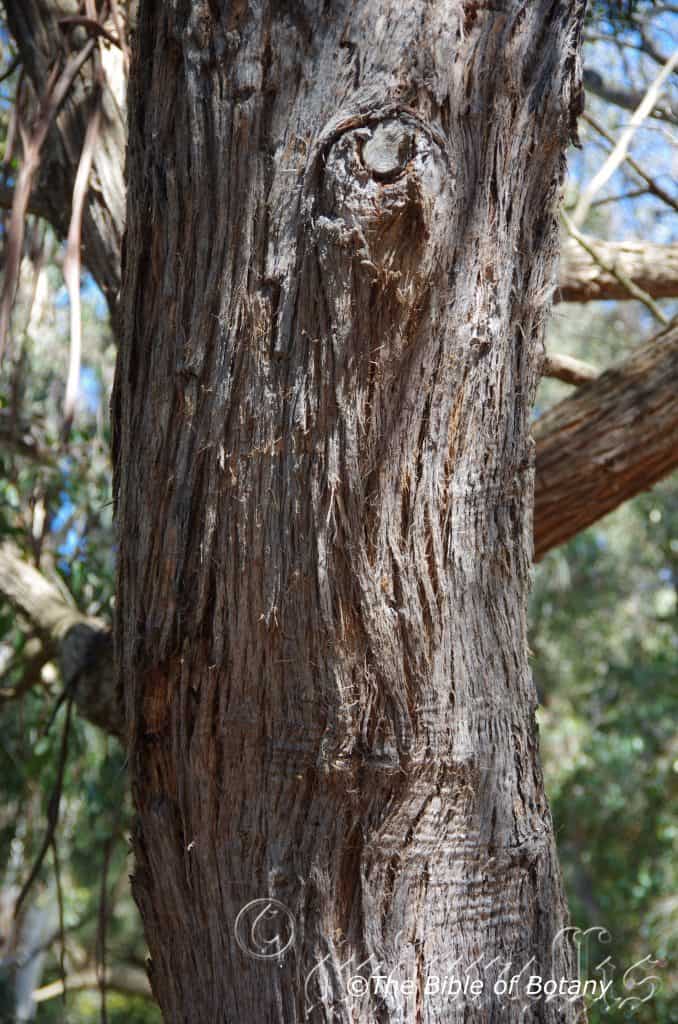
Eucalyptus globoidea
Classification:
Unranked: Eudicots
Unranked: Rosids
Order: Myrtales
Family: Myrtaceae
Genus: From Eu, which is Greek a prefix for good or well and Kaluptos, which is Ancient Greek for to cover up. It refers to the stamens, which have a lid or cover over them in the bud stage prior to opening.
Specie: From Globoideus/Globulus, which is Latin for a globe. It refers to plants, which bear a structure or organ, which takes the shape or form of an old style light globe.
Sub specie:
Common Name: White Stringy Bark.
Distribution:
Eucalyptus globoidea is found south from Shannon Creek, south of Grafton in north eastern New South Wales to east of Melbourne in Victoria. It is mainly found on and east of the Great Dividing Range with a few isolated populations further westward near, Booroorban on the Murrumbidgee River and Upper Sandy Creek near Kiewa. There is a disjunct population further north in the Macpherson Ranges on the Queensland, New South Wales border.
https://avh.ala.org.au/occurrences/search?taxa=Eucalyptus+globoidea#tab_mapView
Habitat Aspect Climate:
Eucalyptus globoidea prefers full sun. It grows in dry schlerophyll forest or grassy woodlands on flats and plains especially near the coast at lower altitudes at the base of the ranges. The altitude ranges from 5 meters ASL to 650 meters ASL.
The temperature range from minus 3 degrees in August to 40 degrees in January.
The rainfall ranges from lows of 600mm to an average of 1500mm annually.
Soil Requirements:
Eucalyptus globoidea prefers deep white, red, orange or grey sandy loams and alluvial deposits close to the coast. The soils are derived from decomposed sandstones, shale, metamorphic rocks, black basalt, brown basalt and granites. The soils pH ranges from 4.5pH to 6pH. It does not tolerate water logged soils however the soils are usually damp throughout the year. Non saline soils to moderately saline soils are tolerated as are salt laden winds.
Height & Spread:
Wild Plants: 6m to 30m by 6m to 9m.
Characteristics:
Eucalyptus globoidea has a long thin bole with the first branches appearing from 30mm to 50mm of the trees height on mature trees. The trunk is a typical stringy bark with pale grey to pale brown or red-brown bark that extends to the smallest branchlets. The branchlets are mid grass-green often at first appearing as deep maroon-red, glabrous and glossy. The decorticating bark sheds in large plates or flakes to reveal a creamy salmon inner bark. The stems are terete on juvenile and coppice growth.
Eucalyptus glaucina’s disjunct juvenile and coppice leaves are shortly petiolate for the first 6 to 9 nodes where they quickly become alternate and disjunct. The broad lanceolate leaves measure 65mm to 105mm in length by 30mm to 60mm in width. The dull yellow-green often tinged pink or purple petioles are ovate straight and measure 2mm to 5mm in length. The discolourous mid green leaves are glossy and covered in fawn hispid hairs becoming rough with age. The margins are entire. The mid vein is prominent on lower lamina and is slightly prominent on the upper especially near the bases and less prominent near the apex.
The disjunct alternate adult leaves are lanceolate broad lanceolate are straight and measure 75mm to 125mm in length and 12mm to 25mm in width. The dull yellow-green tinged pink petioles are terete, straight and measure 8mm to 14mm in length. The oblique, asymmetrical bases are rounded on one side and cuneate on the other side while the apexes are tapering acute. The concolourous to slightly discolourous laminas are green to mid grey-green, dull and glabrous. The margins are entire. The mid vein is prominent on lower lamina and is slightly prominent on the upper especially near the bases and less prominent near the apex. The lateral veins are penniveined and are greater than 60° to the midrib. The intramarginal veins are parallel to and close to the margin. The few oil glands are islands between the lateral veins.
The inflorescences of Eucalyptus globoidea are born as umbellasters containing 9 to 11 flowers from the leaf axils close to the apexes. The flowers are born on narrowly flattened terete or angular peduncules and terete pedicels. The peduncules measure 4mm to 10mm in length while the pedicles measure 0.2mm to 2mm in length. The disc is pale green.
The short, fusiform buds are yellow-green and glabrous. The hypanthium measure 2.5mm to 3.5mm in length by 3mm to 4mm in diameter. The yellow-green and glabrous conical calyptras have an acute apex. The calyptras measure 2.5mm to 4mm in length by 3mm to 4mm in diameter at the base. The bud scar is absent.
Most of the white stamens are irregularly flexed. The filaments measure 4mm to 8mm in length. The white, ovoidal, dorsifixed anthers dehisce through longitudinal pores.
The cream to white style is erect and has a lime-green to deep green stigma. It measures 4mm to 5mm in length. The disc is lime-green to deep green. The flowers appear erratically from September to January.
The fruits of Eucalyptus globoidea are flattened globose gum nuts. The gum nuts measure 4mm to 7mm in length by 6mm to 9mm in diameter at the widest point. The disc is flat or depressed concealing the 3 chambers and revealing the 4 valves that are level with or slightly exserted from the hypanthia.
The flattened rusty brown seeds are long ovoid and measure 1mm to 2mm in length.
Wildlife:
The flowers Eucalyptus globoidea are light nectar producers but are still are very attractive to most honeyeaters, lorikeets, flying foxes, possums and many insects.
Cultivation:
Eucalyptus globoidea is a medium gum tree which is suitable for medium to large gardens where a Eucalyptus specie is required to create a large bush scene or a spreading tree in the park scene. It is ideal on skeletal sandy loams, alluvial flats or medium clays that are well drained. It is fast growing and look particularly handsome in the early years with branches forming are retained to almost ground level. In the garden good specimens grow from 12 to 18 meters in height by 8 meters to 12 meters in diameter when grown in the open.
It is drought tolerant and can cope with moderate frosts. This gum tree has dense wide canopy when grown in the open. Because of this exposed positions that receive a lot of wind should be avoided.
This is not a popular cream flowering gum amongst home gardeners but really should be grown more in larger gardens. Most gardeners tend to favour the red flowering gum trees. The bark contrasts well with other Eucalyptus specie, Corymbia specie, or rainforest specie with dissimilar trunks to high light the trunks and barks. Place it near the edge of a forest and give them room to reach their full potential as it is a not as tall and their wider spread is a feature worth showing off. Trees planted in full view make good bird watching trees for the nectar eating birds and insect eating birds alike. It is rather messy when the lorikeets clamber over the outer foliage.
They would be ideally suited to a medium or large park like scenes where they have the opportunity to spread out as they mature.
Like all Eucalyptus leaf drop, dropping of small branches means continual lawn maintenance but then this means good quantities of leaf litter mulch. If the trees are clumped or used in a bush garden this is not a problem.
Propagation:
Seeds: Sow Eucalyptus globoidea seeds into a seed raising mix. Cover the seeds with 2mm to 3mm of fine sand and place the trays in a warm sunny position. Keep moist but not wet. When the seedlings are 25mm to 50mm tall, prick them out and plant them into 50mm native tubes using a good organic mix.
Once the seedlings reach 200mm to 250mm in height plant them out into their permanent position. Mass plantings are best done in groups of 3 to 5 as a feature by planting them at 15meter to 20 meter centers.
Fertilize using Seaweed, fish emulsion or organic chicken pellets soaked in water and apply the liquid on an alternate basis. Fertilize every two month until the trees are well established then every spring to ensure good growth and flowering.
Further Comments from Readers:
“Hi reader, it seems you use The Bible of Botany a lot. That’s great as we have great pleasure in bringing it to you! It’s a little awkward for us to ask, but our first aim is to purchase land approximately 1,600 hectares to link several parcels of N.P. into one at The Pinnacles NSW Australia, but we need your help. We’re not salespeople. We’re amateur botanists who have dedicated over 30 years to saving the environment in a practical way. We depend on donations to reach our goal. If you donate just $5, the price of your coffee this Sunday, We can help to keep the planet alive in a real way and continue to bring you regular updates and features on Australian plants all in one Botanical Bible. Any support is greatly appreciated. Thank you.”
In the spirit of reconciliation we acknowledge the Bundjalung, Gumbaynggirr and Yaegl and all aboriginal nations throughout Australia and their connections to land, sea and community. We pay our respect to their Elders past, present and future for the pleasures we have gained.
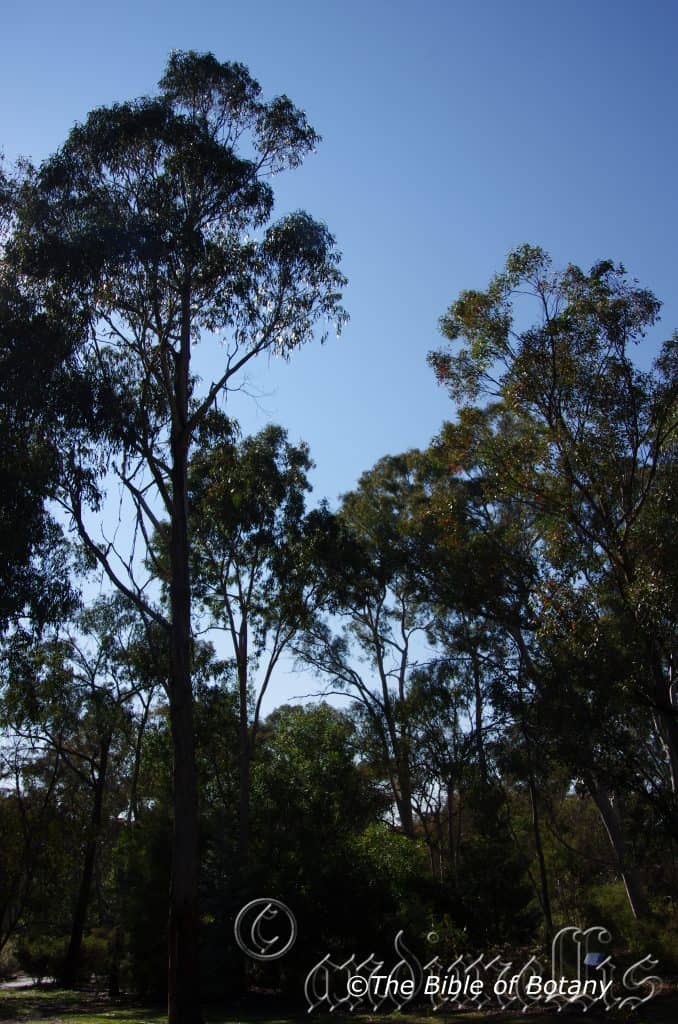
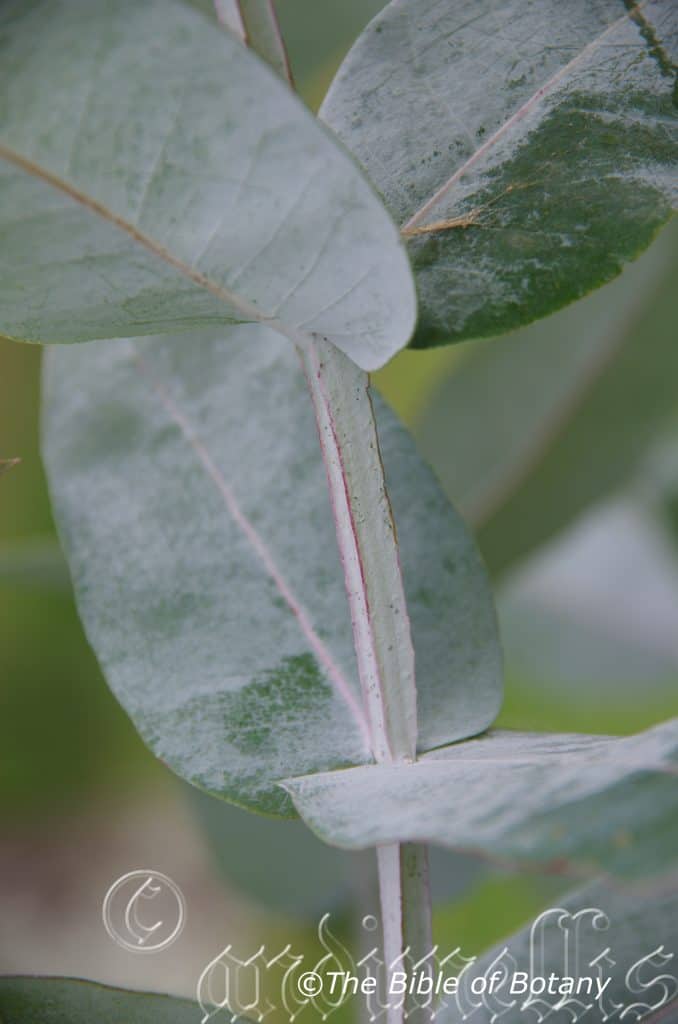
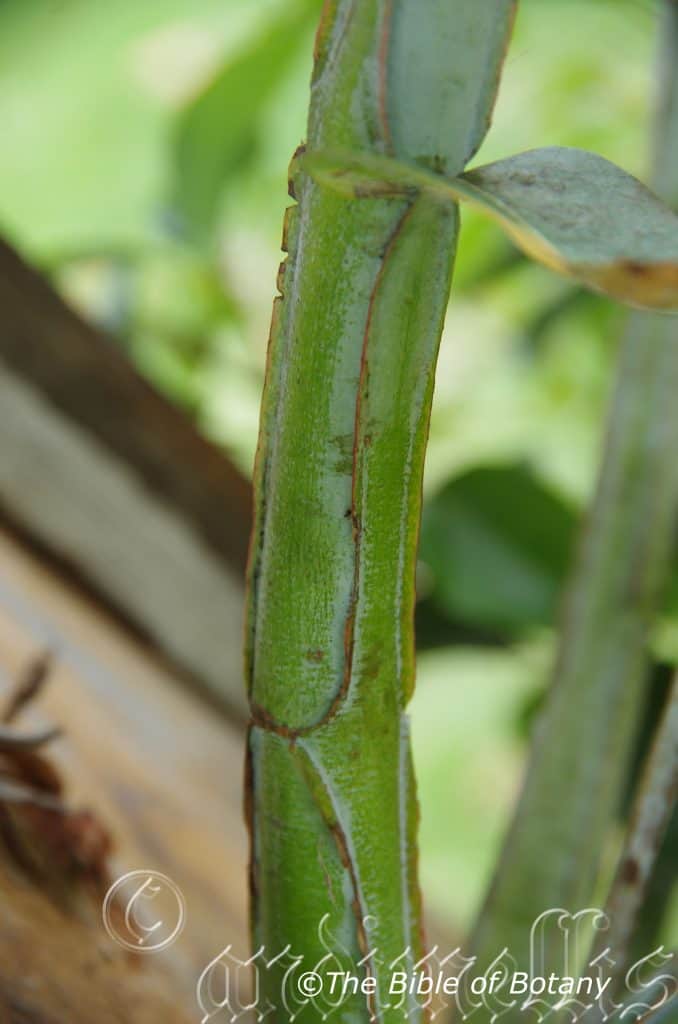






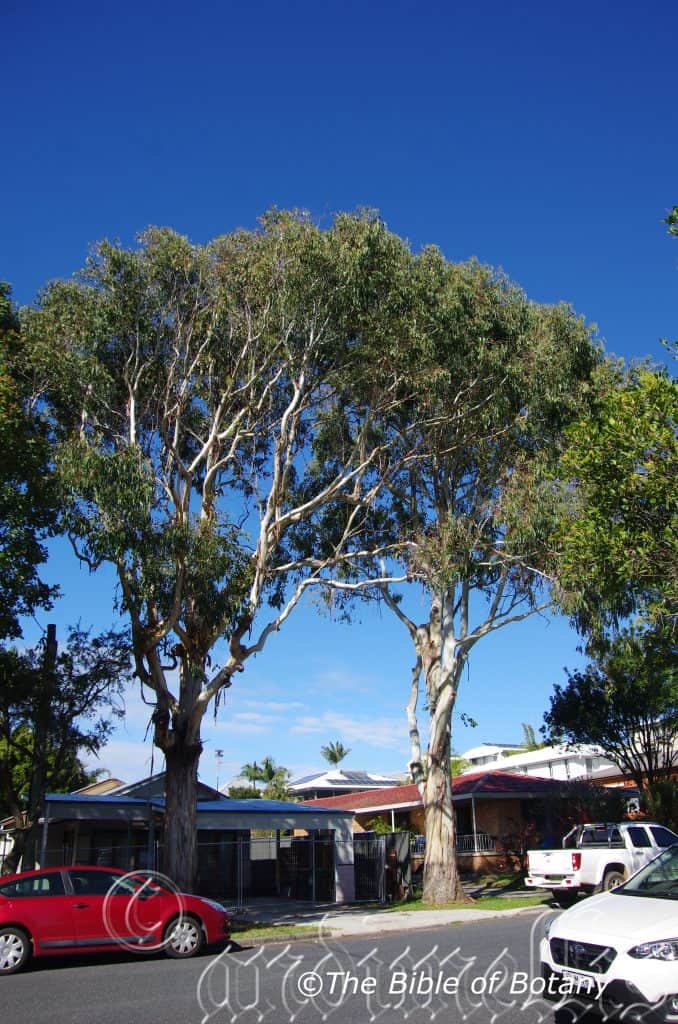
Eucalyptus globulus
Tasmania’s floral emblem
Classification:
Unranked: Eudicots
Unranked: Rosids
Order: Myrtales
Family: Myrtaceae
Genus: From Eu, which is Greek a prefix for good or well and Kaluptos, which is Ancient Greek for to cover up. It refers to the stamens, which have a lid or cover over them in the bud stage prior to opening.
Specie: From Globoideus/Globulus, which is Latin for a globe. It refers to plants, which bear a structure or organ that takes the shape or form of an old style light globe.
Sub specie: Eucalyptus globulus subsp. bicostata. From Bi/Bis, which is Latin for two and Costātum, which is Latin for a rib or ribs. It refers to structures usually organs, which have two longitudinal ribs.
Sub specie: Eucalyptus globulus subsp. globulus. From Globoideus/Globulus, which is Latin for a globe. It refers to plants, which bear a structure or organ that takes the shape or form of an old style light globe.
Sub specie: Eucalyptus globulus subsp. maidenii. Is named in honour of Joseph Henry Maiden; 1859-1925, who was a British born Australian botanist who established the Sydney Herbarium and advised botanists in the agricultural industry. He was a prodigious worker on the Australian flora.
Sub specie: Eucalyptus globulus subsp. pseudoglobulus. From Pseudos, which is Ancient Greek for false and Globus, which is Latin for a poor spherical or orb shape, more like a light globe. It refers to fruits which have a shape similar to the old light globes.
Common Name: Tasmanian Blue Gum.
Distribution:
Eucalyptus globulus is found south from the Cape Otway National Park to Wilson’s Promontory in Victoria.
It is also found on the Bass Straight Islands including both Flinders Island and King Island and most of the eastern two thirds of the Tasmanian mainland.
Eucalyptus globulus sub specie bicostata is found south from near Armidale along the Great Dividing Range in New South Wales to Wilson’s Promontory in Victoria and on Flinders Island.
Eucalyptus globulus subsp. globulus is found in a small area south east of Melbourne in Victoria.
Eucalyptus globulus subsp. maidenii is found south from west of Sydney on and east of the Great Dividing Range in New South Wales to Taralgon in Victoria.
Eucalyptus globulus subsp. pseudoglobulus is found south and west from the New South Wales Victorian border on the coast mainly on and east of the Great Dividing Range to west of Melbourne with a disjunct population in the Grampians.
https://avh.ala.org.au/occurrences/search?taxa=Eucalyptus+globulus#tab_mapView
Habitat Aspect Climate:
Eucalyptus globulus prefers full sun to partial shade. It grows high in the mountains, valleys and gallery forests to protected undulating coastal hills adjacent to cool temperate rainforests or moist Eucalyptus forests. The altitude ranges from 250 meters ASL to 1350 meters ASL.
The temperatures range from minus 5 degrees in July to 36 degrees in January.
The rainfall ranges from lows of 700mm to an average of 2800mm annually.
Soil Requirements:
Eucalyptus globulus prefer white or grey deep sandy loams close to the coast to heavy clays. The soils are derived from most types of rock formations laid down as alluviums. The soils pH ranges from 6pH to 7.5pH. It does not tolerate water logged soils. Eucalyptus globulus subsp. bicostata prefer non saline soils to moderately saline soils are tolerated as are salt laden winds while Eucalyptus globulus subsp. globulus prefer non saline soils to slightly saline soils are tolerated.
Height & Spread:
Wild Plants:
Eucalyptus globulus subsp. globulus 40m to 90m by 15m to 25m.
Eucalyptus globulus subsp. bicostata 15m to 30m by 10m to 15m.
Eucalyptus globulus subsp. maidenii 30m to 50m by 12m to 20m.
Eucalyptus globulus subsp. pseudoglobulus 35m to 45m by 12m to 16m.
Characteristics:
Eucalyptus globulus has a long thin bole with the branches appearing at around 50mm to 60mm of the trees height on mature trees. The bark is persistent in a short stocking at the base of the trunk which is deep grey to deep grey-brown. The upper part of the trunk is smooth white, cream, grey or yellowish to the smaller branchlets often with ribbons of decorticated bark in the upper branches. The decorticating bark is shed in large ribbons or plates from the trunk and larger branches. The juvenile and coppice growth is angular with short prominent wings, glabrous and glaucous.
Eucalyptus globulus’s opposite juvenile and coppice leaves are sessile and amplexicaul for the first 6 to 10 nodes where they quickly become alternate and disjunct. The oblong, to elliptical then ovate to broadly lanceolate leaves measure 40mm to 105mm in length by 20mm to 30mm in width. The discolourous laminas are mid green or slightly glaucous upper laminas while the lower laminas are strongly glaucous. The mid vein is prominent on lower lamina and is slightly prominent on the upper especially near the bases and less prominent near the apex. The margins are usually entire or at times crenulate. The dull blue-green glaucous petioles are ovate straight and measure 2mm to 5mm in length.
The disjunct alternate adult leaves are usually lanceolate or at times broad lanceolate, falcate and measure 140mm to 350mm in length and 20mm to 60mm in width. The oblique, asymmetrical bases are cuneate to rounded on one side and cuneate on the other side or tapering to the petiole while the apexes are tapering acute. The concolourous laminas are green to mid blue-green, semi glossy and glabrous. The margins are entire. The mid vein is prominent on lower lamina and is slightly prominent on the upper especially near the bases and less prominent near the apex. The lateral veins are penniveined and are greater than 45° to the midrib. The intramarginal veins are parallel to and well removed from the margin. The oil glands are islands between the lateral veins and intersectional. The dull blue-green petioles are terete straight, glabrous, glaucous and measure 30mm to 60mm in length.
The inflorescences of Eucalyptus globulus are usually born singularly or at times 2 or rarely 3 from the leaf axils. The flowers are born on a short, terete pedicel measuring 1mm to 3mm in length.
The short, fusiform buds are pale blue-green and glaucous. The obconical hypanthium is lepidote with faint to moderate longitudinal ribs and measure 13mm to 16mm in length by 16mm to 21mm in diameter. The pale blue-green, glaucous and lepidote flattened, umbonate calyptras measure 4mm to 7mm in length by 15mm to 20mm in diameter at the base. The bud scar is present.
The inflexed filaments are white, cream to pastel yellow. The filaments measure 14mm to 20mm in length. The cream to pastel yellow cuboidal to oblong versatile, dorsifixed anthers dehisce through longitudinal pores.
The long, white, cream to white style is erect and has a blunt or tapered pastel yellow stigma. The style measures 8mm to 12mm in length. The disc is pale green to pale pinkish yellow. The flowers appear from September to December.
The fruits of Eucalyptus globulus are obconical to hemispherical gum nuts. The longitudinally ribbed gum nuts measure 13mm to 16mm in length by 12mm to 21mm in diameter at the widest point. The glaucous blue gum nuts turn deep grey brown and wood when ripe and are covered in lepidote lumps. The gum nuts have 4 or 5 placental chambers while the disc is raised revealing the 4 or 5 valves which are usually level with the hypanthia but can be slightly inserted or slightly exserted.
The ovoid to flattened or slightly cuboidal seeds are lacunose with the dorsal surface shallowly pitted and measure 1mm to 2.5mm in length. The seeds are deep brown, black or deep grey-brown with a ventrally positioned hilum.
Wildlife:
The flowers Eucalyptus globulus are heavy nectar producers producing a strong amber honey which is much sought after by all honey eaters lorikeets and possums.
Cultivation:
Eucalyptus globulus is a large gum tree which is only suitable for large gardens where Eucalyptus specie is required to create a large bush scene or a spreading tree in the park scene. It is better suited to deep sandy loams, alluvial flats or medium clays that are well drained yet moisture retentive. It is fast growing and look particularly handsome in the early years with branches forming are retained to almost ground level for several years.
It makes a stately figure when grown in the open in a sheltered position. The trees can be grown for their flowers that produce a good quality honey with good production rates as well as good quality pollen for apiculture. The coppice leaves can be used indoors as a fresh cut line or dried for dried arrangements.
The trees are grown along some railway corridors in south western China where the leaves are harvested for cineole oil and the timber is later harvested for railway sleepers or more recently for pulpwood and flooring.
It also makes an excellent plantation tree in areas where a cool wet winter prevails. In cultivation good specimens grow from 16 to 50 meters in height depending upon the gene pool the seeds were collected from by 8 meters to 12 meters in diameter when grown in the open.
It is drought tolerant once established and can cope with moderate frosts and light snow falls.
This is not a popular cream flowering gum amongst home gardeners because of its size but should be considered where the smaller size trees gene pool of seeds is known for its beautiful foliage. The bark contrasts well with other Eucalyptus specie, Corymbia specie, or rainforest specie with dissimilar trunks to high light the trunks and barks. Place it near the edge of a forest and give them room to reach their full potential as it is a not as tall and their wider spread is a feature worth showing off. Trees planted in full view make good bird watching trees for the nectar eating birds and insect eating birds alike. It is rather messy when the lorikeets clamber over the outer foliage.
It would be suited to a medium or large park like scenes where it has the opportunity to spread out as it matures.
Like all Eucalyptus leaf drop, dropping of small branches means continual lawn maintenance but then this means good quantities of leaf litter mulch. If the trees are clumped or used in a bush garden this is not a problem.
Propagation:
Seeds: Sow Eucalyptus globulus seeds into a seed raising mix. Cover the seeds with 2mm to 3mm of fine sand and place the trays in a warm sunny position. Keep moist but not wet. When the seedlings are 25mm to 50mm tall, prick them out and plant them into 50mm native tubes using a good organic mix.
Once the seedlings reach 200mm to 250mm in height plant them out into their permanent position. Mass plantings are best done in groups of 3 to 5 as a feature by planting them at 10 meter to 20 meter centers. For wind rows they can be planted at 6 meter to 8 meter centers.
Fertilize using Seaweed, fish emulsion or organic chicken pellets soaked in water and apply the liquid on an alternate basis. Fertilize every two month until the trees are well established then every spring to ensure good growth and flowering.
Further Comments from Readers:
“Hi reader, it seems you use The Bible of Botany a lot. That’s great as we have great pleasure in bringing it to you! It’s a little awkward for us to ask, but our first aim is to purchase land approximately 1,600 hectares to link several parcels of N.P. into one at The Pinnacles NSW Australia, but we need your help. We’re not salespeople. We’re amateur botanists who have dedicated over 30 years to saving the environment in a practical way. We depend on donations to reach our goal. If you donate just $5, the price of your coffee this Sunday, We can help to keep the planet alive in a real way and continue to bring you regular updates and features on Australian plants all in one Botanical Bible. Any support is greatly appreciated. Thank you.”
In the spirit of reconciliation we acknowledge the Bundjalung, Gumbaynggirr and Yaegl and all aboriginal nations throughout Australia and their connections to land, sea and community. We pay our respect to their Elders past, present and future for the pleasures we have gained.
Eucalyptus goniantha
Classification:
Unranked: Eudicots
Unranked: Rosids
Order: Myrtales
Family: Myrtaceae
Genus: From Eu, which is Greek a prefix for good or well and Kaluptos, which is Ancient Greek for to cover up. It refers to the stamens, which have a lid or cover over them in the bud stage prior to opening.
Specie: From Gōnía, which is Ancient Greek for an angle and ántha/ánthos, which are Ancient Greek for the male reproductive organs in a flower or the flower. It refers to the hypanthium which has many longitudinal, broad, rounded ribs.
Sub specie:
Common Name: Yellow Fruited Mallee.
Distribution:
Eucalyptus goniantha is a rare species located along the coast and nearby plains in south west of Western Australia, east from Esperence to Denmark in the west and north to Cranbrook.
https://avh.ala.org.au/occurrences/search?taxa=Eucalyptus+goniantha#tab_mapView
Habitat Aspect Climate:
Eucalyptus goniantha prefers full sun. It grows in open woodlands or woodland heaths near coastal estuaries and sandy loam plains behind the frontal dunes. The altitude ranges from 250 meters ASL to 200 meters ASL.
The temperatures range from minus 2 degrees in early August to 37 degrees in January.
The rainfall ranges from lows of 320mm to an average of 1000mm annually.
Soil Requirements:
Eucalyptus goniantha prefers sandy soils to better quality sandy loams to light sandy clays. The soils are derived from decomposed sandstone, laterites or granite. The soils pH ranges from 5pH to 7pH. It does not tolerant water logged soils. Non saline soils to very saline soils are tolerated as are salt laden winds.
Height & Spread:
Wild Plants: 2m to 12m by 4m to 8m.
Characteristics:
Eucalyptus goniantha has a short slender trunk or is multi stemmed small tree with the branches appearing at around 20mm to 30mm of the trees height on mature trees. The bark is smooth pale grey-brown to deep reddish-brown to the larger branches. The smaller branchlets are reddish-brown often with thin ribbons of decorticated bark in the upper branches. The decorticating bark is shed in short ribbons from the trunk and larger branches while the branchlets are flaky. The branchlets are pale green to blue-green and glabrous. The trees form a lignotuber just beneath the ground.
Eucalyptus goniantha’s opposite juvenile leaves and coppice leaves are sessile for the first 4 to 10 nodes where they gradually become disjunct. The ovate leaves measure 20mm to 40mm in length by 15mm to 23mm in width. The dull blue-green glaucous petioles are ovate straight and measure 2mm to 5mm in length. The concolourous laminas are mid blue-green and glabrous. The margins are entire. The mid vein is prominent on lower lamina and is slightly prominent on the upper especially near the bases and less prominent near the apex.
The disjunct alternate adult leaves are usually broad lanceolate, or at time falcate and measure 40mm to 60mm in length and 16mm to 23mm in width. The dull olive to pale olive orange petioles are terete straight, glabrous, glaucous and measure 9mm to 15mm in length.
The bases are rounded-cuneate while the apexes are tapering acute. The concolourous laminas are green to mid blue-green, semi glossy and glabrous. The margins are entire. The mid vein is prominent on lower lamina and is slightly prominent on the upper especially near the bases and less prominent near the apex. The lateral veins are penniveined are less than 45° to the midrib. The intramarginal veins are parallel to and close to the margin. The oil glands are islands between the lateral veins and intersectional.
Inflorescences of Eucalyptus goniantha are born as pendulous umbellasters containing 5 to 8 flowers from near the terminal leaf axils. The flower’s peduncules are flattened while the pedicels are angular. The peduncules measure 13mm to 17mm in length while the pedicels measure 0mm to 1mm in length.
The fusiform buds are pale yellow to golden yellow and glabrous. The hypanthium is flattened at the base and angular at the rim, have several fine longitudinal ribs, finely resinous and measure 13mm to 16mm in length by 8mm to 11mm in diameter. The pale yellow to golden yellow and glabrous calyptras are finely resinous and measure 6mm to 8mm in length by 7mm to 10mm in diameter at the base. The bud scar is present.
The cream to golden yellow filaments are flexed. The filaments measure 9mm to 02mm in length. The golden yellow cuboidal versatile, dorsifixed anthers dehisce through longitudinal pores.
The long, golden yellow to yellow-orange style is erect and has a blunt stigma. The style measures 4mm to 6mm in length. The disc is deep green. The flowers appear from September to December or January to February but may have a secondary and smaller flowering in May if conditions are favourable.
The fruits are flattened hemispherical gum nuts. The gum nuts measure 7mm to 12mm in diameter at the hypanthia by 5mm to 6mm in diameter. The valve forms an exserted ring on the edge of the depressed disc.
Wildlife:
The flowers Eucalyptus goniantha are good nectar producers and are very attractive to most honeyeaters and lorikeets, native bees and beetles.
Cultivation:
Eucalyptus goniantha is a smaller gum tree which is very suitable for small gardeners looking for a Eucalyptus specie to create a small bush scene, large rockery or a semi-arid scene in temperate areas of Australia. It is well suited to sandy loams, sandy alluvial flats or light to medium clays that are well drained. It is fast growing so give good effects at an early age. In the garden good specimens grow from 6 meters to 8 meters with a width of 5 meters to 8 meters. They have a bushy crown and are drought resistant and can cope with moderate frosts. The flowers are very beautiful and contrast strongly against the foliage.
Eucalyptus goniantha should be more popular because of its creamy yellow flowering gum amongst home gardeners as most tend to favour the red flowering gum mallees. When it is used it is too often planted singularly with gardeners not prepared to experiment with it. They have a naturally dense wide spreading crown which makes them an ideal small tree in designing that small park atmosphere. Mass plantings would create a cool dense shaded area below where native annuals could be planted near the margins and semi-arid loving ferns could be planted below to form swathes of green for an added cooling effect.
It has a lignotuber so this opens up a wide field for landscapers. Try mass planting them as features of 2 or 3 or even 5 in a group using curves. Another method would be to plant 8 to 10 close together and after a few years leave 2 or 3 of them and prune the others in the clump back hard so it is forced to re shoot from the lignotuber. This will create an effect of various heights and greater flowering in the following season. They can also be used very successfully with Eucalyptus caesia as the plants that need to be cut back and used as the mallee shrub.
It is suited to a small patch using it as the shrub by cutting them back hard every 2 years with Eucalyptus caesia as the tree. The carmine and pale yellow flowers would make a strong statement with the red and cream flowers appearing and intermingling at the same time. This can easily be done in a mass planting by leaving one of each as the tree at each end. Mix the others together when planting; so when the time comes for pruning, they will grow together, intertwining their branchlets and flowers.
This Eucalyptus specie would be ideally suited as a large hedgerow along borders making a dense impenetrable border and safe wildlife corridor.
Like all Eucalyptus leaf drop, dropping of small branches means continual lawn maintenance but then this means good quantities of leaf litter mulch. If the trees are clumped or used in a bush garden this is not a problem.
Propagation:
Seeds: Sow Eucalyptus goniantha’s seed directly into a seed raising mix. Cover the seeds with 2 to 3mm of fine sand and place the trays in a warm sunny position. Keep moist but not wet. When the seedlings are 25mm to 50mm tall, prick them out and plant them into 50mm native tubes using a good organic mix.
Once the seedlings reach 200mm to 250mm in height plant them out into their permanent position. Mass plantings are best achieved with spacing ranging from 4 meters to 5 meters where clumps are required or 7 meters to 9 meters where individuality in shape and the bark is wanted as the feature.
Fertilize using Seaweed, fish emulsion or organic chicken pellets soaked in water and apply the liquid on an alternate basis. Fertilize every two months until the trees are established then a good soaking once a year thereafter.
Further Comments from Readers:
“Hi reader, it seems you use The Bible of Botany a lot. That’s great as we have great pleasure in bringing it to you! It’s a little awkward for us to ask, but our first aim is to purchase land approximately 1,600 hectares to link several parcels of N.P. into one at The Pinnacles NSW Australia, but we need your help. We’re not salespeople. We’re amateur botanists who have dedicated over 30 years to saving the environment in a practical way. We depend on donations to reach our goal. If you donate just $5, the price of your coffee this Sunday, We can help to keep the planet alive in a real way and continue to bring you regular updates and features on Australian plants all in one Botanical Bible. Any support is greatly appreciated. Thank you.”
In the spirit of reconciliation we acknowledge the Bundjalung, Gumbaynggirr and Yaegl and all aboriginal nations throughout Australia and their connections to land, sea and community. We pay our respect to their Elders past, present and future for the pleasures we have gained.
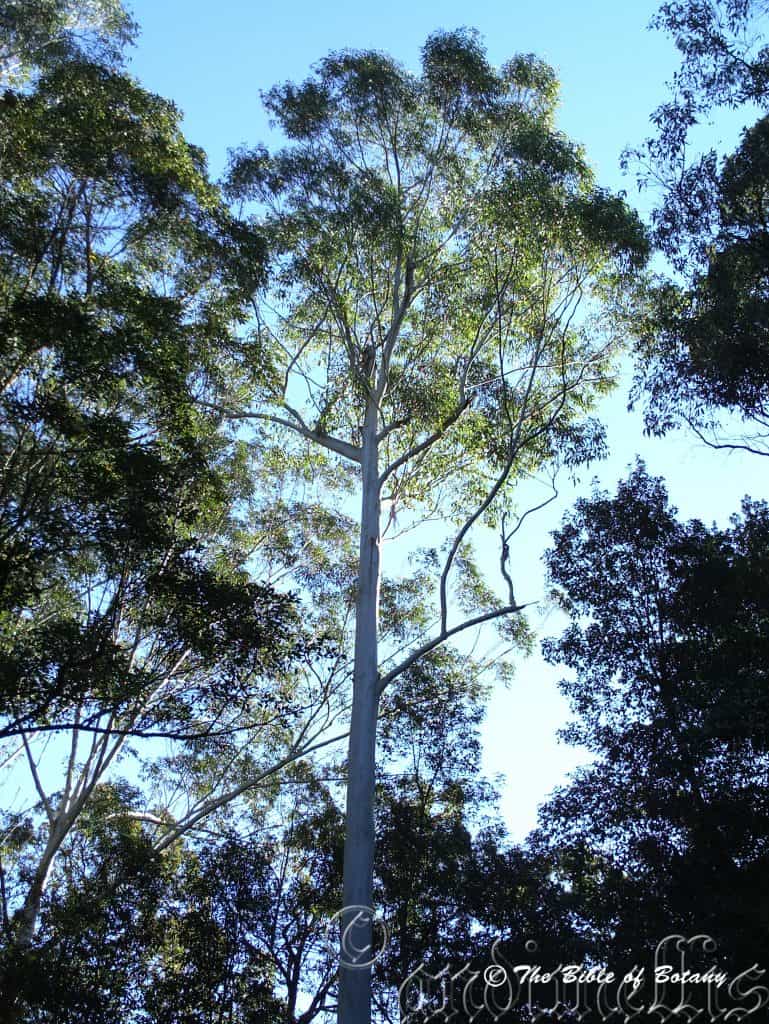

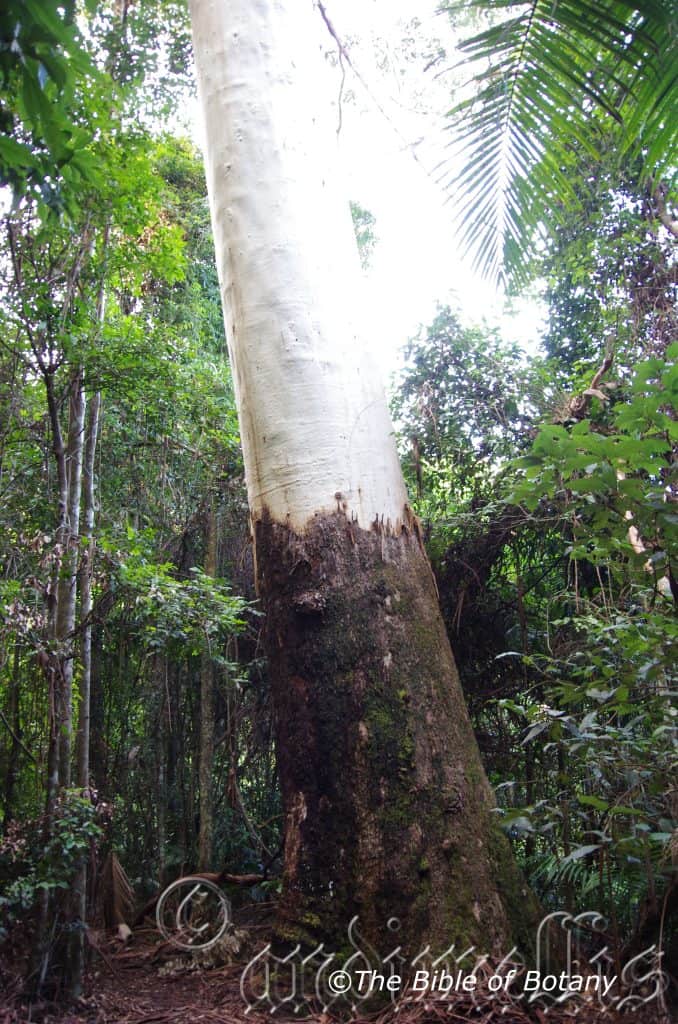
Eucalyptus grandis
Classification:
Unranked: Eudicots
Unranked: Rosids
Order: Myrtales
Family: Myrtaceae
Genus: From Eu, which is Greek a prefix for good or well and Kaluptos, which is Ancient Greek for to cover up. It refers to the stamens, which have a lid or cover over them in the bud stage prior to opening.
Specie: From Grandis which is Latin for large and spectacular. It refers to plants, which are rather larger and more spectacular than other species in the genus.
Sub specie:
Common Name: Flooded Gum or Rose Gum.
Some aboriginal names for the tree are Pooragri in and around Brisbane and Redland Bay and Coolooli further north in Wide Bay.
Distribution:
Eucalyptus grandis is located east of the Great Dividing Range south from the Daintree River National Park in North Queensland to Newcastle in central eastern New South Wales. It is found in 4 disjunct populations on and east of the Great Dividing Range to the coast.
https://avh.ala.org.au/occurrences/search?taxa=Eucalyptus+grandis#tab_mapView
Habitat Aspect Climate:
Eucalyptus grandis prefers full sun to light dappled shade. It grows on slopes or on alluvial flats adjacent to rainforests, in wet Eucalyptus forests or moist gallery forests. The altitude ranges from 15 meters ASL to 1110 meters ASL.
The temperatures range 0 degrees in July to 38 degrees in January.
The rainfall ranges from lows of 780mm to an average of 3000mm annually.
Soil Requirements:
Eucalyptus grandis prefers sandy loams, clay loams to medium clays which are moisture retentive. The soils are derived from decomposed brown basalt, black basalt and shale. The soils pH ranges from 5.5pH to 6.5pH. It does not tolerate water logged soils though the soils always have good moisture retention and available moisture. Non saline soils to moderately saline soils are tolerated.
Height & Spread:
Wild Plants: 40m to 70m by 12m to 15m.
Characteristics:
Eucalyptus grandis has long thick trunk with the branches being retained at around 50mm to 60mm of the trees height on mature trees. The trunk has a rough, grey to deep grey-black persistent stocking of fibrous to flaky bark at the base. The trunk above the stocking is smooth, white, cream or pale green to mid emerald-green branches. The smaller branchlets are powdery white. The decorticating bark is shed in short ribbons from the trunk and larger branches while the branchlets are shed in flakes.
The juvenile leaves of Eucalyptus grandis are disjunct ovate, concolourous and deep glossy green on both surfaces. The leaves measure 25mm t0 35mm in length by 15mm to 25mm in width.
The alternate adult leaves are lanceolate to broad lanceolate and measure 110mm to 160mm in length and 20mm to 30mm in width. The petioles are slightly compressed, channelled on the upper surface and measure 15mm to 20mm in length. The bases are rounded-cuneate to rounded while the apexes are broad acute. The discolourous laminas are deep green to deep sea green, glabrous and semi glossy on the upper lamina while the lower lamina is paler with a bluish or purplish tinge and dull. The laminas are flat while the margins are entire. The lateral veins are penniveined and are about 75 degrees to the midvein.
The inflorescences of Eucalyptus grandis are born as umbellasters containing 7 to 11 flowers from near the terminal leaf axis. The slightly flattened to angular peduncules measure 8mm to 18mm in length while the terete pedicels measure 0mm to 3mm in length.
The ovoidal buds are pale grass-green to mid grass-green, glabrous and measure 3.5mm to 4.5mm in length by 4mm to 5mm in diameter. The conical calyptras are pale grass-green to mid grass-green and measure 4.5mm to 6mm in length. The bud scar is present.
The flexed stamens are white and measure 7mm to 9mm in length. The white anthers are cuboidal. The disc is deep grass-green to pale creamy green. The flowers of Eucalyptus grandis appear mainly in mid-April to the end of May.
The fruits of Eucalyptus grandis are conical to pyriform gum nuts. The gum nuts measure 5mm to 8mm in length by 4mm to 7mm in diameter. The disc is enclosed while the 4 or 5 triangular valves are exserted.
Wildlife:
The flowers of Eucalyptus grandis are light nectar producers but are still are very attractive to most honeyeaters, lorikeets, flying foxes, possums and many insects. The trees are a host to the leaf fungi from the Teratosphaeria genus. These fungi distort the leaves and cause necrosis in the leaves. (Loss of colour and pigmentation.) Leaves eventually die and fall off. It can completely defoliate young trees and thus inhibits healthy growth. Bellbirds can always be seen on the tree so they must support a large variety of thrips, lerps and other sap sucking insects. Another advantage of this gum tree is that it is a staple food tree for koalas.
Cultivation:
Eucalyptus grandis makes an excellent windbreak, shelterbelt or shade for cattle and native animals in rural areas provided the soils are deep. The trees can be grown for their flowers that produce good quality honey with good production rates as well as good quality pollen for apiculture. The coppice leaves can be used indoors as a fresh cut line or dried for dried arrangements.
The trees are grown in south western China where the timber is used for railway sleepers or more recently for pulpwood and flooring.
It also makes an excellent plantation trees in areas where a cool to warm wet winters prevail. In the cultivation good specimens grow from 25 to 30 meters in height by 8 meters to 12 meters in diameter when grown in the open.
It is moderately drought tolerant once established and can cope with light frosts.
The bark contrasts well with other Eucalyptus specie, Corymbia specie, or rainforest specie with dissimilar trunks to high light the trunks and barks. Place it near the edge of a forest and give them room to reach their full potential as it is a not as tall and their wider spread is a feature worth showing off. Trees planted in full view make good bird watching trees for the nectar eating birds and insect eating birds alike. It is rather messy when the lorikeets clamber over the outer foliage.
It would be ideally suited to a medium or large park like scenes where it has the opportunity to spread out as it mature.
Like all Eucalyptus specie leaf drop, dropping of small branches means continual lawn maintenance but then this means good quantities of leaf litter mulch. If the trees are clumped or used in a bush garden this is not a problem.
Propagation:
Seeds: Sow Eucalyptus grandis seeds into a seed raising mix. Cover the seeds with 2mm to 3mm of fine sand and place the trays in a warm sunny position. Keep moist but not wet. When the seedlings are 25mm to 50mm tall, prick them out and plant them into 50mm native tubes using a good organic mix.
Once the seedlings reach 200mm to 250mm in height plant them out into their permanent position. Mass plantings are best done in groups of 3 to 5 as a feature by planting them at 10 meter to 20 meter centers. For wind rows they can be planted at 6 meter to 8 meter centers.
Fertilize using Seaweed, fish emulsion or organic chicken pellets soaked in water and apply the liquid on an alternate basis. Fertilize every two month until the trees are well established then every spring to ensure good growth and flowering.
Further Comments from Readers:
“Hi reader, it seems you use The Bible of Botany a lot. That’s great as we have great pleasure in bringing it to you! It’s a little awkward for us to ask, but our first aim is to purchase land approximately 1,600 hectares to link several parcels of N.P. into one at The Pinnacles NSW Australia, but we need your help. We’re not salespeople. We’re amateur botanists who have dedicated over 30 years to saving the environment in a practical way. We depend on donations to reach our goal. If you donate just $5, the price of your coffee this Sunday, We can help to keep the planet alive in a real way and continue to bring you regular updates and features on Australian plants all in one Botanical Bible. Any support is greatly appreciated. Thank you.”
In the spirit of reconciliation we acknowledge the Bundjalung, Gumbaynggirr and Yaegl and all aboriginal nations throughout Australia and their connections to land, sea and community. We pay our respect to their Elders past, present and future for the pleasures we have gained.

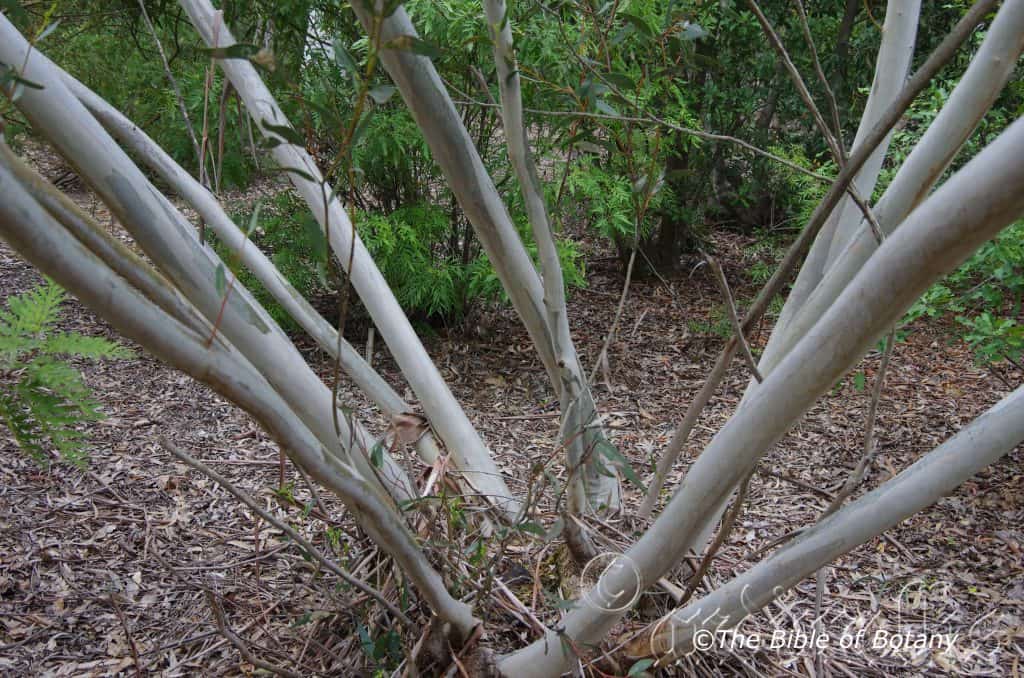
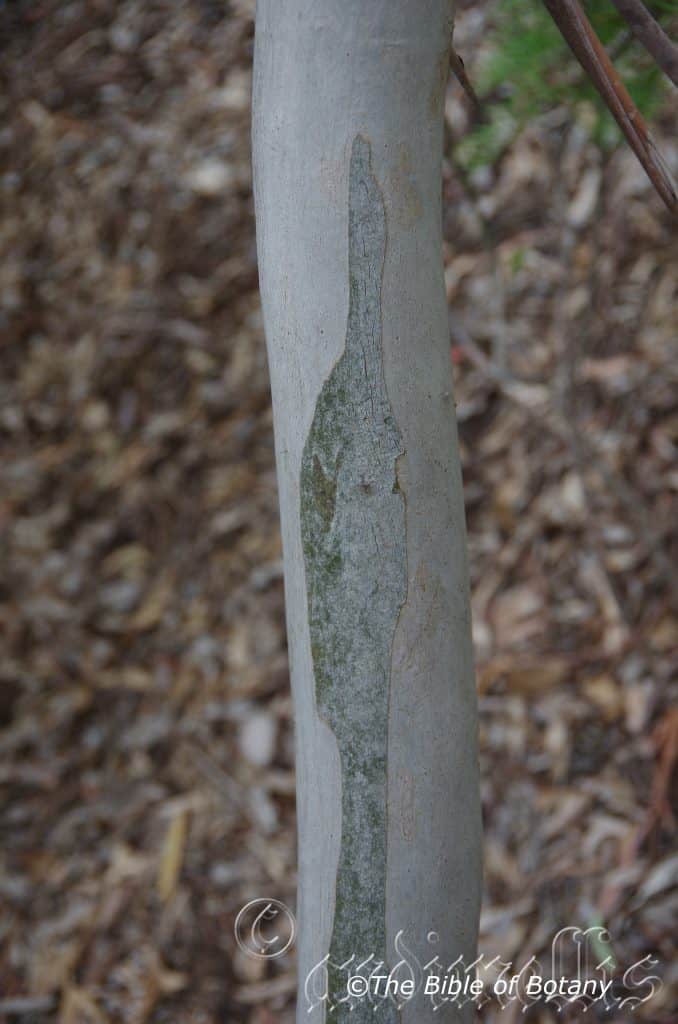



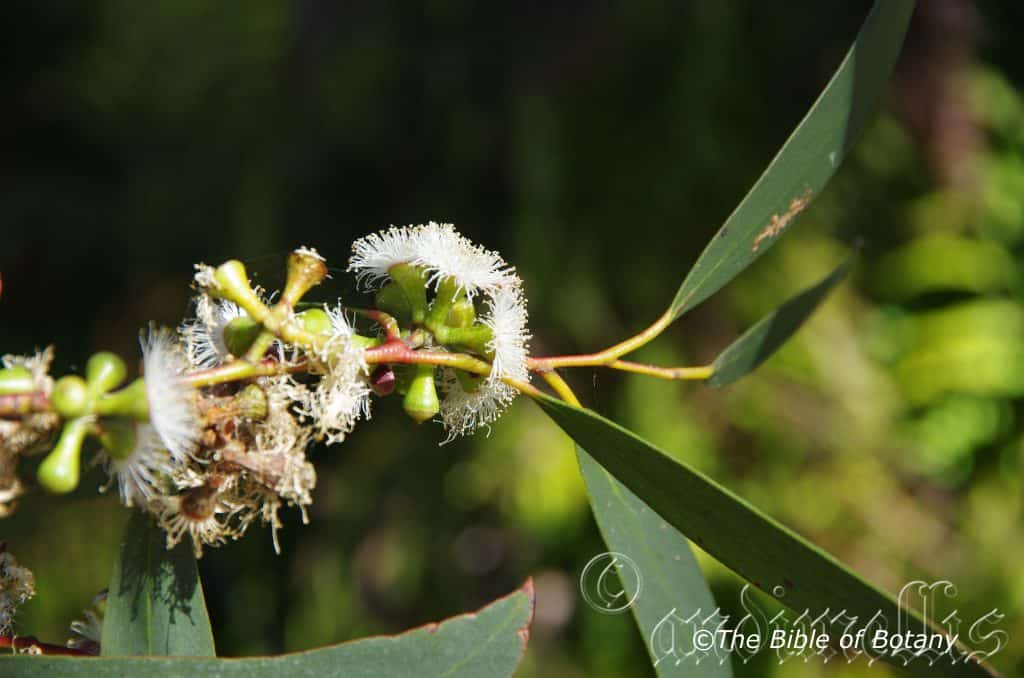

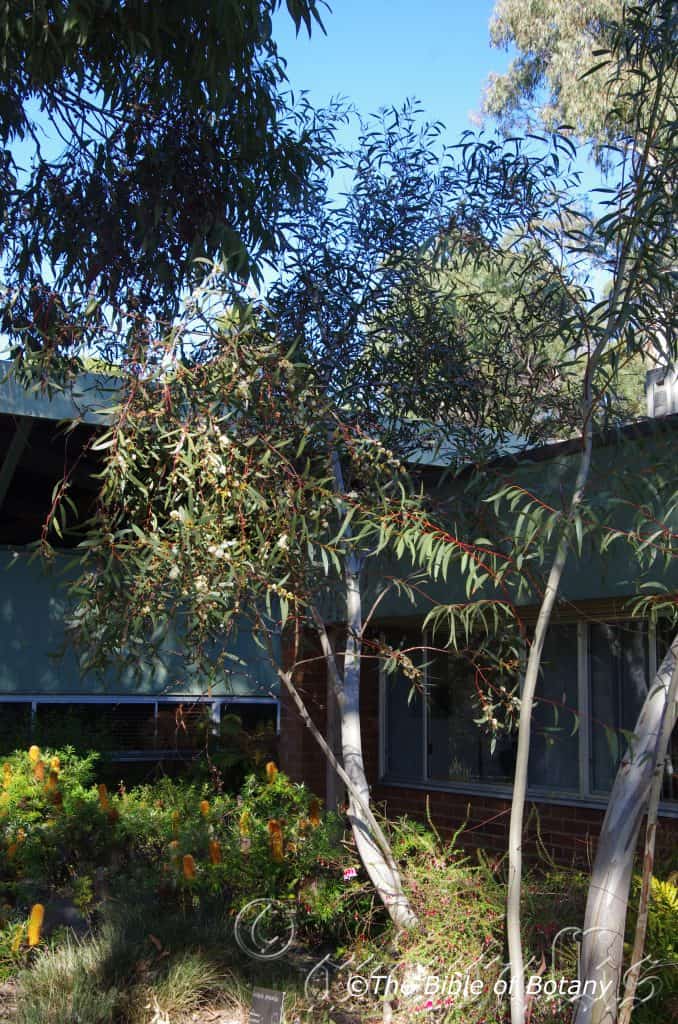
Eucalyptus gregsoniana
Classification:
Unranked: Eudicots
Unranked: Rosids
Order: Myrtales
Family: Myrtaceae
Genus: From Eu, which is Greek a prefix for good or well and Kaluptos, which is Ancient Greek for to cover up. It refers to the stamens, which have a lid or cover over them in the bud stage prior to opening.
Specie: Is probably named in honour of Edward Jesse Gregson; 1837-1919, who was an English born Australian Agricultural Superintendent and keen plant collector.
Sub specie:
Common Name: Mallee Snow Gum or Wolgan (A local Aboriginal name for the tree.)
Distribution:
Eucalyptus gregsoniana is restricted to three small scattered populations in central to southern New South Wales along the coastal ranges. It is found in the Blue Mountains, the Budawang Range and the Braidwood area in the south.
https://avh.ala.org.au/occurrences/search?taxa=Eucalyptus+gregsoniana#tab_mapView
Habitat Aspect Climate:
Eucalyptus gregsoniana prefers full sun. It grows at higher altitudes amongst other alpine mallee shrubs and heaths. It can be seen along ridges, hills and undulating well drained soils. The altitude ranges from 800 meters ASL to 1500 meters ASL.
The temperatures range from minus 5 degree in August to 32 degrees in January.
The rainfall ranges from lows of 1000mm to an average of 1600mm annually of which some falls as snow.
Soil Requirements:
Eucalyptus gregsoniana prefers moderately fertile deep or skeletal sands and light fatty clays. The soils are usually derived from decomposed sandstones or granites. The soils pH most likely ranges from 5pH to 6.5pH. It does not tolerate water logged soils.Non saline soils to slightly saline soils are tolerated.
Height & Spread:
Wild Plants: 4m to 6m by 4m to 6m.
Characteristics:
Eucalyptus gregsoniana is a small mallee with a single or multi stemmed small mallee. The bark is persistent, smooth, brilliant white with pale grey patches on the trunk through to the smaller branches. The bark decorticates in long ribbons to expose a pale green bark. The new flushes are smooth, and green. It forms a well-developed lignotuber below the surface.
Eucalyptus gregsoniana’s juvenile and coppice stems are terete, bright red and glaucous. The opposite disjunct leaves are lanceolate to broad-lanceolate. The concolourous dull grey-green laminas are, glabrous. The margins are entire while the mid vein is prominent on the lower lamina and the lateral veins have a parallel venation.
The alternate, disjunct, lanceolate falcate leaves of Eucalyptus gregsoniana measure 70mm to 110mm in length by 12mm to 25mm in width. The terete petioles are yellowish and measure 10mm to 15mm in length. The bases taper to the petiole while the apexes are acute. The concolourous laminas are semi glossy to glossy, bluish-green to grey-green and glabrous. The margins are entire while the mid vein is prominent on the lower lamina and prominent near the base on the upper lamina. The lateral veins are sub parallel and faintly visible on the both laminas.
The inflorescences of Eucalyptus gregsonianaare umbellasters born auxiliary along the stems. There are 7 to11 individual white flowers to an umbellaster. The new growth bearing the umbellasters is bright red. The terete peduncles are glabrous and measure 0mm to 8mm in length while the terete pedicels measure 0mm to 2mm in length. The clavate buds are yellowish, glabrous and measure 7mm to 9mm in length by 3mm to 4mm in diameter. The hemispherical calyptra is shorter than and narrower than the hypanthium. A bud scar is absent.
The white stamens measure 5mm to 8mm in length. The cream, orbicular anthers are dorsifixed and are all fertile. The creamy-yellow to red style measures 2mm to 4mm in length. The disc is pale yellow. The flowers appear from mid-September to November.
The fruits of Eucalyptus gregsoniana are pyriform ovoidal woody capsules known as gum nuts. The lime-green gum nuts measure 6mm to 8mm in length by 6mm to 8mm in diameter at the widest point. The pale green disc is flat or slightly raised while the 4 triangular valves are level or enclosed with the disc.
Wildlife:
The flowers of Eucalyptus gregsoniana are reasonable yielders of good quality nectar and pollen. This makes it attractive to honeyeaters, lorikeets and apiarists along the east coast. It also attracts many insects and insectivorous birds when in flower.
Cultivation:
Eucalyptus gregsoniana is a small tree which is ideally suitable for smaller gardens where a Eucalyptus is required. It is slower growing than most eucalyptus due to the more prolonged, cold winters where it prefers to grow but still makes an attractive garden specimen once established below the snow line. It still looks great from an early age. It looks very affective when planted with other mallees or small Eucalyptus trees with contrasting foliage, barks and growth habits.
Another method is to grow one or two as trees and interplant with several plants that have been cut to induce the growth of several trunks. In the garden good specimens may grow from 4 meters to 6 meters in height by 3 meters to 4 meters in diameter when grown in the open as a single trunk tree or 3 meters to 4 meters in height by 4 meters to 5 meters as a multi trunk tree when grown in the open.
Like all Eucalyptus spp. leaf drop, dropping of small branches means continual lawn maintenance or a natural look when grown a native garden with mulches which adds to the leaf litter and mulch.
Eucalyptus gregsoniana can be used like many small Eucalyptus spp. to create that little bit of Australiana in the back yard.Often floral characteristics of a plant dictate our selection of plants for the garden. Remember that once a Eucalyptus spp.; or in fact any tree, reaches a reasonable size, its trunk and bark are the most prominent features seen. Among the eucalypts there are many different types of barks which include some of our beautiful peppermint barks and ghost gums. Grouping, mallees as mallees or as single trunk trees can add immeasurably to the interest within a small space. Eucalyptus gregsoniana is one of those species whose multi stems and beautiful white bark contrasts well with mallee species.
Small shrubs can be used to emphasize the open spaces surrounding a mallee or a small tree especially when mass plantings are done.
Eucalyptus gregsoniana can look great when placed in the corner against a fence to add privacy and remove the barrenness of the yard while giving extra depth. Try it where against a deep red brick fence or a black painted solid fence to give two examples of contrasts for the foliage and trunks.
Propagation:
Seeds: Sow into a seed raising mix. Cover the seeds with 2mm to 3mm of fine sand and place the trays in a warm sunny position. Keep the seeds moist but not wet. When the seedlings are 25mm to 50mm tall, prick them out and plant them into 50mm native tubes using a good organic mix.
Once the seedlings reach 200mm to 250mm in height plant them out into their permanent position. Mass plantings are best done in groups of 3 to 5 as a feature by planting them at 4 meter to 5 meter centers as a tree or 5 meters to 6 meters as a mallee.
Fertilize using Seaweed, fish emulsion or organic chicken pellets soaked in water and apply the liquid on an alternate basis. Fertilize every two month until the trees are well established then every spring to ensure good growth and flowering.
Further Comments from Readers:
“Hi reader, it seems you use The Bible of Botany a lot. That’s great as we have great pleasure in bringing it to you! It’s a little awkward for us to ask, but our first aim is to purchase land approximately 1,600 hectares to link several parcels of N.P. into one at The Pinnacles NSW Australia, but we need your help. We’re not salespeople. We’re amateur botanists who have dedicated over 30 years to saving the environment in a practical way. We depend on donations to reach our goal. If you donate just $5, the price of your coffee this Sunday, We can help to keep the planet alive in a real way and continue to bring you regular updates and features on Australian plants all in one Botanical Bible. Any support is greatly appreciated. Thank you.”
In the spirit of reconciliation we acknowledge the Bundjalung, Gumbaynggirr and Yaegl and all aboriginal nations throughout Australia and their connections to land, sea and community. We pay our respect to their Elders past, present and future for the pleasures we have gained.

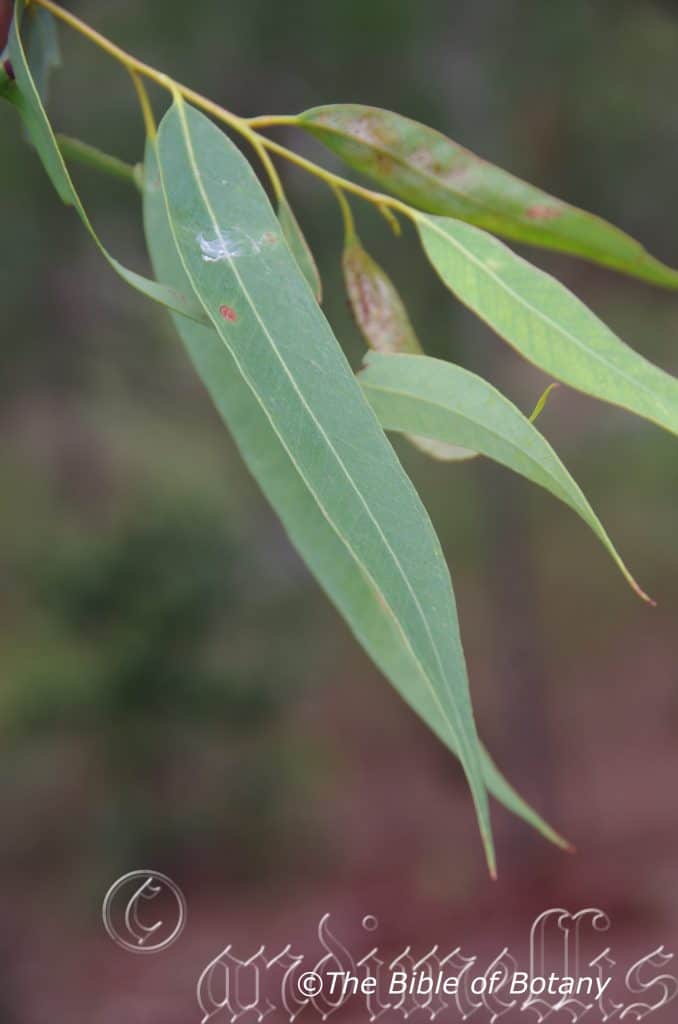
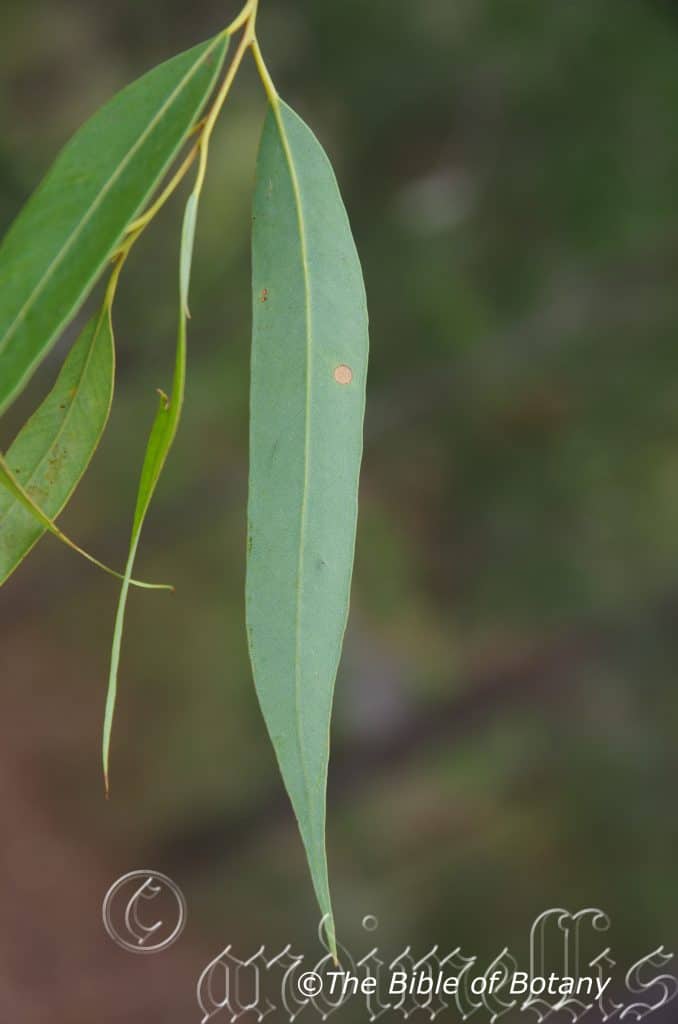
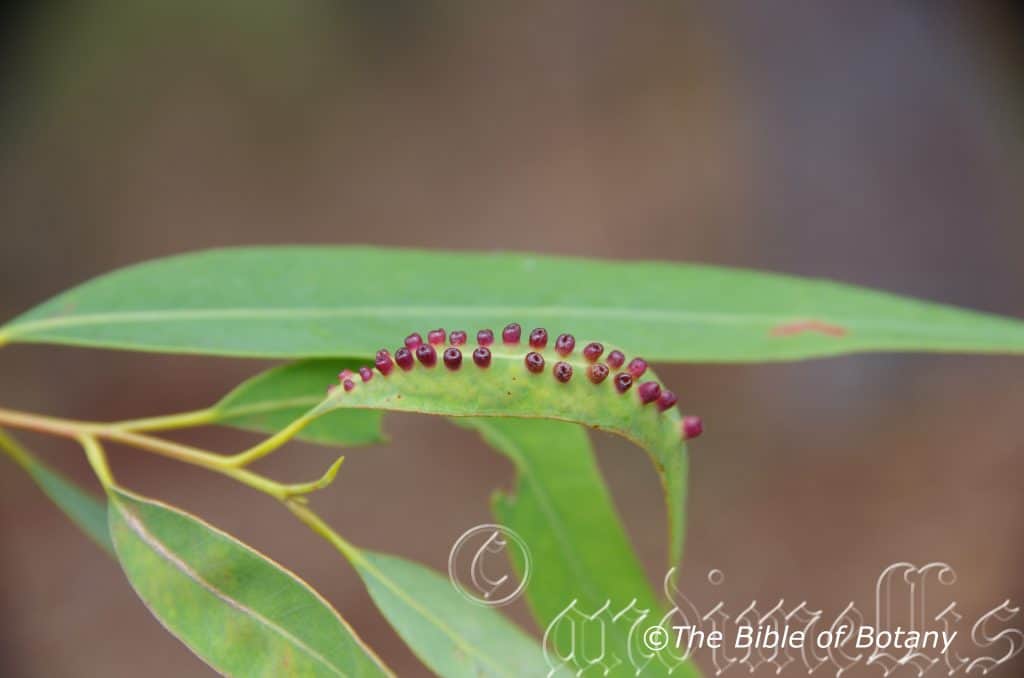
Eucalyptus helidonica
Classification:
Unranked: Eudicots
Unranked: Rosids
Order: Myrtales
Family: Myrtaceae
Genus: From Eu, which is Greek a prefix for good or well and Kaluptos, which is Ancient Greek for to cover up. It refers to the stamens, which have a lid or cover over them in the bud stage prior to opening.
Specie: From Helidon, which is Latinized for the Helidon district in south eastern Queensland where it was first discovered.
Sub specie:
Common Name: Helidon Stringy Bark.
Distribution:
Eucalyptus helidonica is restricted to a small area between Milford Rocks and Mount maroon in far south eastern Queensland.
https://avh.ala.org.au/occurrences/search?taxa=Eucalyptus+helidonica#tab_mapView
Habitat Aspect Climate:
Eucalyptus helidonica prefers full sun. It grows on gentle slopes, along ridges, hills and undulating well drained soils. The altitude ranges from 130 meters ASL to 750 meters ASL.
The temperatures range from 0 degree in August to 38 degrees in January.
The rainfall ranges from lows of 700mm to an average of 1200mm annually.
Soil Requirements:
Eucalyptus helidonica prefers poor to moderately fertile deep skeletal sands. The soils are usually derived from decomposed sandstones over sandstone. The soils pH most likely ranges from 5pH to 7pH. It does not tolerate water logged soils.Non saline soils to slightly saline soils are tolerated.
Height & Spread:
Wild Plants: 15m to 22m by 6m to 10m.
Characteristics:
Eucalyptus helidonica is a medium single trunk tree. The pale grey to grey-brown fine fibrous bark is persistent to the smaller branches. The juvenile and small branches are smooth, and brown turning green then yellow-green on the new shoots.
Juvenile plants and coppice regrowth have opposite sessile, linear to narrow lanceolate leaves that measure 60mm to 135mm in length by 8mm to 20mm in width. The alternate, disjunct, lanceolate to slightly falcate leaves measure 60mm to 140mm in length by 10mm to 25mm in width. The terete, yellow-green, glabrous petioles measures 9mm to 20mm in length. The bases taper to the petiole while the apexes are narrow acute. The slightly discolourous laminas are dull, pale blue-green and glabrous. The margins are entire while the mid vein is prominent on both laminas. The lateral veins are clearly visible on both laminas as is the intra marginal veins which are well away from the margin. The reticulated veins are obvious on the lower lamina.
The inflorescences are umbellasters born auxiliary along the stems. There are 11 or more individual flowers to an umbellaster, which is an unbranched peduncle. The yellow-green, terete peduncle measures 10mm to 25mm in length, while the terete pedicels measure 3mm to 5mm in length. The terete peduncles are glabrous and measure 0mm to 8mm in length while the terete pedicels measure 0mm to 2mm in length. The mature spindle shape buds measure 4mm to 5mm in length by 2mm to 2.5mm in diameter. A bud scar is absent.
The white stamens measure 4mm to 5mm in length. The flowers appear from mid-September to November.
The fruits are slightly flattened, woody spherical capsules, which measure 4mm to 6mm in length by 4mm to 7mm in diameter at the widest point. The pale green disc is flat or slightly raised while the 3 triangular valves are enclosed with the disc.
Wildlife:
The flowers of Eucalyptus helidonica are reasonable yielders of good quality nectar and pollen. This makes it attractive to honeyeaters, lorikeets and apiarists along the east coast. It also attracts many insects and insectivorous birds when in flower.
Cultivation:
Eucalyptus helidonica is a small tree which is ideally suitable for larger gardens where a Eucalyptus is required. It is fast growing especially where the soils have good mulch and even moisture. It looks good from an early age. It is affective when planted with other mallees or small Eucalyptus trees with contrasting foliage, barks and growth habits.
Another method is to grow one or two as trees and interplant with clusters of small to medium shrubs. Greviilea hybrids like ned kelly and robin gordon are suitable as would be Grevillea juniperina both prostrate and shrub forms. Myoporum boninense would also look good mixed with the Grevillea species where the soil is drier or tank water is in use. In the garden good specimens may grow from 10 meters to 15 meters in height by 6 meters to 8 meters in diameter when grown in the open as a single trunk.
Like all Eucalyptus spp. leaf drop, dropping of small branches means continual lawn maintenance or a natural look when grown a native garden with mulches which adds to the leaf litter and mulch.
Propagation:
Seeds: Sow into a seed raising mix. Cover the seeds with 2mm to 3mm of fine sand and place the trays in a warm sunny position. Keep the seeds moist but not wet. When the seedlings are 25mm to 50mm tall, prick them out and plant them into 50mm native tubes using a good organic mix.
Once the seedlings reach 200mm to 250mm in height plant them out into their permanent position. Mass plantings are best done in groups of 3 to 5 as a feature by planting them at 4 meter to 5 meter centers as a tree or 5 meters to 6 meters as a mallee.
Fertilize using Seaweed, fish emulsion or organic chicken pellets soaked in water and apply the liquid on an alternate basis. Fertilize every two month until the trees are well established then every spring to ensure good growth and flowering.
Further Comments from Readers:
“Hi reader, it seems you use The Bible of Botany a lot. That’s great as we have great pleasure in bringing it to you! It’s a little awkward for us to ask, but our first aim is to purchase land approximately 1,600 hectares to link several parcels of N.P. into one at The Pinnacles NSW Australia, but we need your help. We’re not salespeople. We’re amateur botanists who have dedicated over 30 years to saving the environment in a practical way. We depend on donations to reach our goal. If you donate just $5, the price of your coffee this Sunday, We can help to keep the planet alive in a real way and continue to bring you regular updates and features on Australian plants all in one Botanical Bible. Any support is greatly appreciated. Thank you.”
In the spirit of reconciliation we acknowledge the Bundjalung, Gumbaynggirr and Yaegl and all aboriginal nations throughout Australia and their connections to land, sea and community. We pay our respect to their Elders past, present and future for the pleasures we have gained.
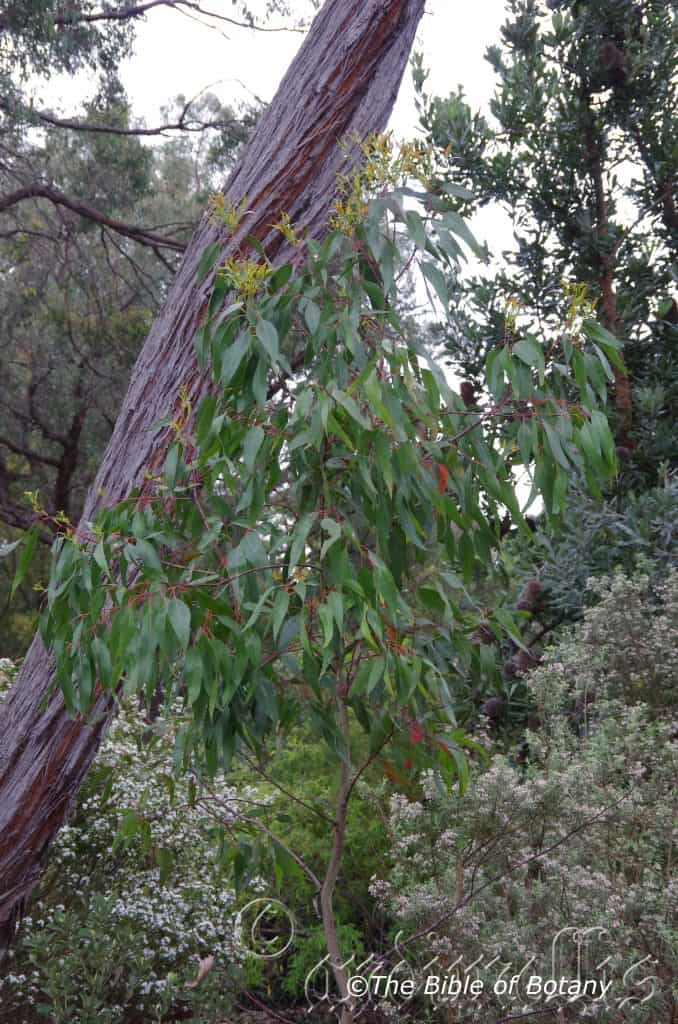


Eucalyptus imlayensis
Classification:
Unranked: Eudicots
Unranked: Rosids
Order: Myrtales
Family: Myrtaceae
Genus: From Eu, which is Greek a prefix for good or well and Kaluptos, which is Ancient Greek for to cover up. It refers to the stamens, which have a lid or cover over them in the bud stage prior to opening.
Specie: From Imlay, which is Latinized for Mount Imlay and Anum/Ensis, which is Latin for to originate from. It refers to plants which originate or are restricted to the Mount Imlay district.
Sub specie:
Common Name: Mount Imlay Mallee.
Distribution:
Eucalyptus imlayensis is an endangered species found on Mount Imlay National park in far south eastern New South Wales.
https://avh.ala.org.au/occurrences/search?taxa=Eucalyptus+kruseana#tab_mapView
Habitat Aspect Climate:
Eucalyptus imlayensis prefers full sun. The trees grow in open woodlands, on steep rocky slopes and rocky hills and ridges. The altitude ranges from 50 meters ASL to 350 meters ASL.
The temperatures range from minus 4 degrees in July to 36 degrees in January.
The rainfall ranges from lows of 500mm to an average of 750mm annually.
Soil Requirements:
Eucalyptus imlayensis prefer sandy loams on granitic outcrops or shallow soils. The soils are derived from decomposed granites. The soils pH ranges from 5.5pH to 6.5pH. It does not tolerate water logged soils. Non saline soils to moderately saline soils are tolerated.
Height & Spread:
Wild Plants: 5m to 7m by 3m to 5m.
Characteristics:
Eucalyptus imlayensis is a typical gum tree with a smooth bark, with some thin persistent strips at the base of the trunks. The predominantly green, with orange, brown or grey patches, sheds in ribbons from the stems and branches. The juvenile stems are square in cross-section, sometimes winged, slightly tuberculate.
The green, juvenile leaves are opposite and sessile for at least 20 pairs of nodes before becoming alternate. The elliptic to ovate leaves measure 40mm to 75mm in length by 15mm to 30mm in width. The margins are entire or finely crenulate, while the base is rounded to tapering and have an acute apex. The alternate mature leaves have petioles that measure 10mm to 16mm in length. The lanceolate to falcate leaves measure 75mm to 150mm in length by 15mm to 30mm in width. The base tapers to the petiole, while the apex is acute. The concolorous, glossy, green leaves mid vein is slightly prominent on the upper lamina on the basal half, while the lateral veins are less than 40 degrees are densely reticulate, with the intramarginal vein parallel to and well away from the margin. The numerous oil glands are obscure.
The axillary unbranched, umbels’ peduncles measure 2mm to 5mm in length, while the 3 buds on each umbel are sessile. The mature green, ovoid buds measure 5mm to 6mm in length by 3mm to 5mm in diameter. The scar is present, while the operculum is conical to slightly beaked. The white filaments are inflexed, while the pale cream, cuboid to cuneate, versatile anthers are dorsifixed and dehisce along longitudinal slits. The white style is flared at the base and tapers to the stigma.
The cupular, campanulate or hemispherical, capsules are sessile and measure 4mm to 5mm in length by 6mm to 7mm in diameter. The disc is obliquely raised while the 3 or 4 valves are exserted.
The brown to grey, ovoid or flattened-ovoid seeds measure1.5mm to 2.5mm in length and are usually lacunose with the dorsal surface being glabrous or shallowly reticulate.
Wildlife:
The flowers Eucalyptus imlayensis is a good nectar producers and are very attractive to most honeyeaters, native bees and beetles.
Cultivation:
Eucalyptus imlayensis is a smaller mallee which is very suitable for gardeners looking for a small Eucalyptus specie to create a small bush scene for arid type gardens. It is ideal on sandy loams, sandy alluvial flats or light clays that are well drained. It is fast growing so give good effects at an early age. In the garden trees grow to 2meters to 4 meters by 3 to 4meters in diameter. It is drought resistant once established and can cope with moderate frosts.
The book leaf mallee should be a more popular ornamental in drier parts of southern Western Australia to southern South Australia and in central Australia because of its small size, flower colour and unusual leaves.
They have an open canopy so the flowers can be viewed to full affect.
This yellow flowering gum is too often planted singularly when it is grown, with gardeners not prepared to let their hair down and experiment. It has a lignotuber so it should be used. Try mass planting them as features or 2 or 3 or even 5 in a group using curves with other mallees. Another method would be to plant 8 to 10 close together and after a few years leave 2 or 3 of them to grow as single trunk small trees and prune the others in the clump back hard so it is forced to reshoot from the lignotuber. This will create an effect of various heights and better flowering in the following season. The trees left will take on a pendulous look while the others will grow rapidly upwards. Seed grown plants would also offer plants planted in mass a great variation in colour of the flowers to add to more interest. Try mixing them with other small Eucalyptus or Corymbia in semi-arid areas like Corymbia curtisii or Eucalyptus leucoxylon for an even stronger contrast in flowering and trunks.
Like all Eucalyptus specie leaf drop, dropping of small branches means continual lawn maintenance but then this means good quantities of leaf litter mulch in the garden bed. If the trees are clumped or used in a bush garden this is not a problem.
They can also be planted among a natural bush garden in temperate arid and semi-arid zones to add colour between or treated as a tall shrub mixed between smaller shrubs with green foliage.
The flower buds and leaves can be harvested for dried arrangements or used for cut flowers.
Propagation:
Seeds: Sow the seeds of Eucalyptus imlayensis directly into a seed raising mix. Cover the seeds with 2mm to 3mm of fine sand and place the trays in a warm sunny position. Keep moist but not wet. When the seedlings are 25mm to 50mm tall, prick them out and plant them into 50mm native tubes using a good organic mix.
Once the seedlings reach 200mm to 250mm in height plant them out into their permanent position. Mass plantings are best achieved by planting them at 1 meter to 3 meters where clumps are required or 3 meters to 5 meters where individuality is wanted in shape and the bark is used as a feature.
Fertilize using seaweed, fish emulsion or organic chicken pellets soaked in water on an alternate basis. Fertilize every two months until the plants are established then twice annually in early September or March to maintain health, vitality and better flowering.
Further Comments from Readers:
“Hi reader, it seems you use The Bible of Botany a lot. That’s great as we have great pleasure in bringing it to you! It’s a little awkward for us to ask, but our first aim is to purchase land approximately 1,600 hectares to link several parcels of N.P. into one at The Pinnacles NSW Australia, but we need your help. We’re not salespeople. We’re amateur botanists who have dedicated over 30 years to saving the environment in a practical way. We depend on donations to reach our goal. If you donate just $5, the price of your coffee this Sunday, We can help to keep the planet alive in a real way and continue to bring you regular updates and features on Australian plants all in one Botanical Bible. Any support is greatly appreciated. Thank you.”
In the spirit of reconciliation we acknowledge the Bundjalung, Gumbaynggirr and Yaegl and all aboriginal nations throughout Australia and their connections to land, sea and community. We pay our respect to their Elders past, present and future for the pleasures we have gained.
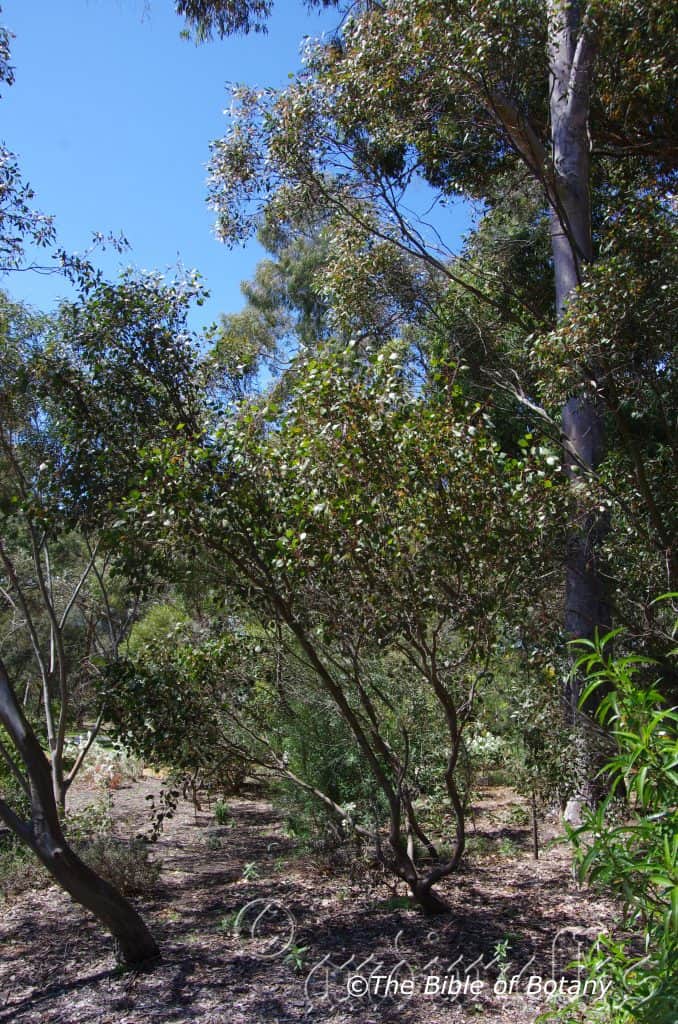






Eucalyptus infera
Classification:
Unranked: Eudicots
Unranked: Rosids
Order: Myrtales
Family: Myrtaceae
Genus: From Eu, which is Greek a prefix for good or well and Kaluptos, which is Ancient Greek for to cover up. It refers to the stamens, which have a lid or cover over them in the bud stage prior to opening.
Specie: From infera, which is Latin for low or lowly. It refers to plants, which can be described as less attractive than other plants in the genus or other trees in its habitat.
Sub specie:
Common Name: Durikai Mallee.
Distribution:
Eucalyptus infera is another vulnerable mallee or small gum tree. It is found in a restricted area of south east Queensland between Inglewood and Warick.
https://avh.ala.org.au/occurrences/search?taxa=Eucalyptus+infera#tab_mapView
Habitat Aspect Climate:
Eucalyptus infera prefers full sun to light dappled shade. The trees grow in open woodlands, on flats and gentle. The altitude ranges from 350 meters to 450 meters ASL.
The temperatures range from minus 3 degrees in July to 40 degrees in January.
The rainfall ranges from lows of 400mm to an average of 600mm annually.
Soil Requirements:
Eucalyptus infera prefer very deep, flat, somewhat excessively drained soil developed in alluvial deposits often in layers of sand, gravel, subrounded channers, and flagstones. The soils are derived from decomposed acidic dark phyllite, shale, or slate. The soils pH ranges from 4.5pH to 5.5pH. It does not tolerate water logged soils. Non saline soils to moderately saline soils are tolerated.
Height & Spread:
Wild Plants: 4m to 8m by 2m to 4m.
Characteristics:
Eucalyptus infera has smooth, shiny, grey to coppery or olive-green bark. The juvenile stems are terete to square in cross-section.
The juvenile petiolate, alternate, glossy green, ovate to orbicular leaves measure 40mm to 70mm in length by 40mm to 70mm in width. The base tapers to the petiole, while the apex is emarginate. The margins are entire or have very shallow crenulations.
The alternate, broadly lanceolate to elliptical to ovate, mature leaves measure 60mm to 130mm in length by 17mm to 45mm in width. The petiole measures 12mm to 30mm in length. The base tapers to the petiole, while the apex is acute. The margins are entire or have very shallow crenulations. The concolorous, glossy green leaves mid vein is slightly prominent on both laminas on the basal third, while the lateral veins are greater than 45 degrees and very faintly visible. The leaves are moderately reticulated, while the intramarginal veins run parallel to and well away from the margin.
The axillary unbranched inflorescence have peduncles that measure 80mm to 100mm in length. There are 9 to 18 buds on each umbel. The pedicels measure 3mm to 5mm in length. The elongated, yellow or creamy, glabrous ovoid to fusiform mature buds, operculum is much longer than the hypanthium and measure 10mm to 13mm in length by 3mm to 5mm in diameter. The scar is present, while the horn-shaped operculum is discarded before the white, erect filaments lengthen and measure 8mm to 10mm in length. The cuboid to oblong, versatile, cream anthers are dorsifixed and dehisce along longitudinal slits. The creamy, long style flares at the base and tapers to the stigma It measures 8mm to 9mm in length.
The hemispherical, capsules are pedicellate and measure 1mm to 4mm in length by 4mm to 8mm in diameter. The raised disc is convex to concave, while the 3 or 4 valves are strongly exserted.
The deep brown, pyramidal to cuboid seeds are glabrous and measure 0.8mm to 1mm in length.
Wildlife:
The flowers Eucalyptus infera are good nectar producers and are very attractive to most honeyeaters, native bees and beetles.
Cultivation:
Eucalyptus infera is a smaller mallee which is very suitable for gardeners looking for a small Eucalyptus specie to create a small bush scene for arid type gardens. It is well suited to sandy loams, sandy alluvial flats or light clays that are well drained. It is fast growing so give good effects at an early age. In the garden trees grow between 5 meters to 8 meters by 3 meters to 4 meters in diameter when grown in the open as a single trunk small tree or much smaller if grown as a multi trunk mallee. It is drought resistant once established and can cope with light frosts.
The book leaf mallee should be a more popular ornamental in drier parts of southern Western Australia to southern South Australia and in central Australia because of its small size, flower colour and unusual leaves.
They have an open canopy so the flowers can be viewed to full affect.
This yellow flowering gum is too often planted singularly when it is grown, with gardeners not prepared to let their hair down and experiment. It has a lignotuber so it should be used. Try mass planting them as features or 2 or 3 or even 5 in a group using curves with other mallees. Another method would be to plant 8 to 10 close together and after a few years leave 2 or 3 of them to grow as single trunk small trees and prune the others in the clump back hard so it is forced to reshoot from the lignotuber. This will create an effect of various heights and better flowering in the following season. The trees left will take on a pendulous look while the others will grow rapidly upwards. Seed grown plants would also offer plants planted in mass a great variation in colour of the flowers to add to more interest. Try mixing them with other small Eucalyptus or Corymbia in semi-arid areas like Corymbia curtisii or Eucalyptus leucoxylon for an even stronger contrast in flowering and trunks.
Like all Eucalyptus specie leaf drop, dropping of small branches means continual lawn maintenance but then this means good quantities of leaf litter mulch in the garden bed. If the trees are clumped or used in a bush garden this is not a problem.
They can also be planted among a natural bush garden in temperate arid and semi-arid zones to add colour between or treated as a tall shrub mixed between smaller shrubs with green foliage.
The flower buds and leaves can be harvested for dried arrangements or used for cut flowers.
Propagation:
Seeds: Sow the seeds of Eucalyptus infera directly into a seed raising mix. Cover the seeds with 2mm to 3mm of fine sand and place the trays in a warm sunny position. Keep moist but not wet. When the seedlings are 25mm to 50mm tall, prick them out and plant them into 50mm native tubes using a good organic mix.
Once the seedlings reach 200mm to 250mm in height plant them out into their permanent position. Mass plantings are best achieved by planting them at 1 meter to 3 meters where clumps are required or 3 meters to 5 meters where individuality is wanted in shape and the bark is used as a feature.
Fertilize using seaweed, fish emulsion or organic chicken pellets soaked in water on an alternate basis. Fertilize every two months until the plants are established then twice annually in early September or March to maintain health, vitality and better flowering.
Further Comments from Readers:
“Hi reader, it seems you use The Bible of Botany a lot. That’s great as we have great pleasure in bringing it to you! It’s a little awkward for us to ask, but our first aim is to purchase land approximately 1,600 hectares to link several parcels of N.P. into one at The Pinnacles NSW Australia, but we need your help. We’re not salespeople. We’re amateur botanists who have dedicated over 30 years to saving the environment in a practical way. We depend on donations to reach our goal. If you donate just $5, the price of your coffee this Sunday, We can help to keep the planet alive in a real way and continue to bring you regular updates and features on Australian plants all in one Botanical Bible. Any support is greatly appreciated. Thank you.”
In the spirit of reconciliation we acknowledge the Bundjalung, Gumbaynggirr and Yaegl and all aboriginal nations throughout Australia and their connections to land, sea and community. We pay our respect to their Elders past, present and future for the pleasures we have gained.



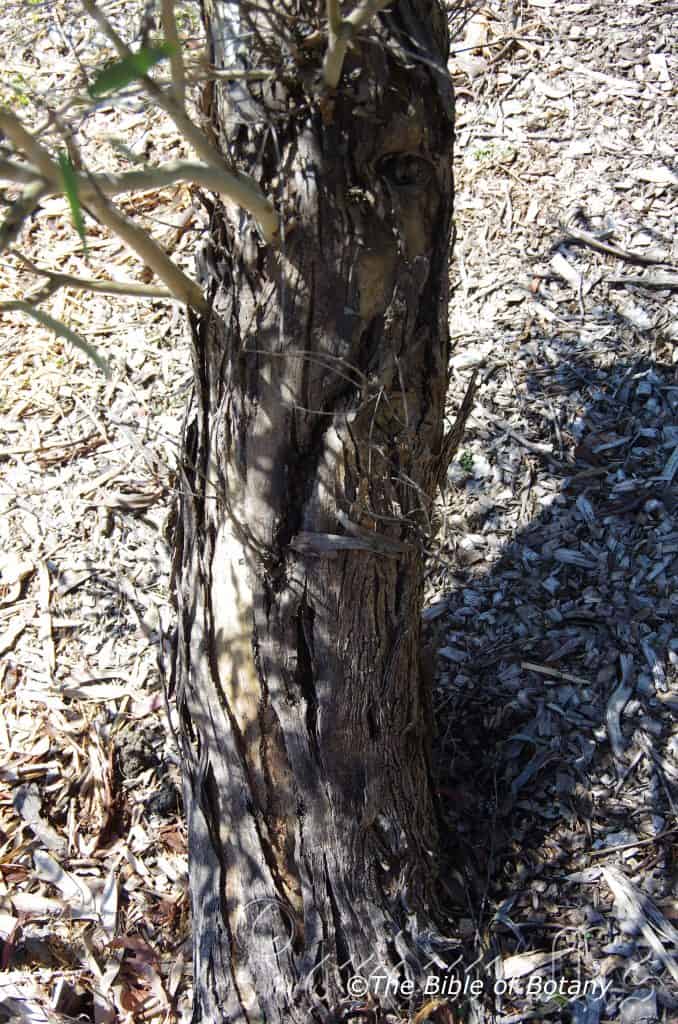


Eucalyptus intertexta
Classification:
Unranked: Eudicots
Unranked: Rosids
Order: Myrtales
Family: Myrtaceae
Genus: From Eu, which is Greek a prefix for good or well and Kaluptos, which is Ancient Greek for to cover up. It refers to the stamens, which have a lid or cover over them in the bud stage prior to opening.
Specie: From Inter, which is Latin for among or between and Texō, which is Latin for to weave. It refers to organs or structures, which are inter woven. Here it refers to the fibres on the bark being inter woven.
Sub specie:
Common Name: Inland Red Box, Gum coolibah, Smooth-barked Coolabah or Western Red Box.
Distribution:
Eucalyptus intertexta is a widespread species found in basically three broad locations. One in central Australia, spanning eastern Western Australia to north east of Alice Springs, the second is from the salt lakes in northern South Australia through to the Murray Darling basin in western New South Wales and the third is the St George to Dirranbandi region in southern Queensland.
https://avh.ala.org.au/occurrences/search?taxa=Eucalyptus+intertexta#tab_mapView
Habitat Aspect Climate:
Eucalyptus intertexta prefers full sun. The trees grow in open woodlands, on flat plains more arid habitats. The altitude ranges from 0 meters ASL around Lake Ayre to 450 meters ASL.
The temperatures range from minus 3 degrees in July to 44 degrees in January.
The rainfall ranges from lows of 150mm to an average of 600mm annually.
Soil Requirements:
Eucalyptus intertexta prefer fine sandy loams to course sands, very deep, flat, somewhat excessively drained soil developed in alluvial deposits often in layers of sand, gravel, subrounded channers, and flagstones. The soils are derived from decomposed acidic dark phyllite, shale, slate or sandstone. The soils pH ranges from 4.5pH to 5.5pH. It does not tolerate water logged soils. Non saline soils to moderately saline soils are tolerated.
Height & Spread:
Wild Plants: 10m to 20m by 6m to 8m.
Characteristics:
Eucalyptus intertextagrey to red-brown bark is rough, thick, fibrous and often somewhat tessellated on lower the trunk sometimes to the lower branches and smooth and predominantly white with grey or brown patches above. The tree decorticates its bark in flakes. The juvenile stems are terete or square in cross-section, usually glabrous and at times glaucous;
The opposite juvenile, lanceolate leaves are always petiolate before becoming alternate and measure 30mm to 120mm in length by 10mm to 35mm in width. The leaves are dull, grey-green to blue-green or glaucous. The base tapers to the petiole, while the apex is acute.
The alternate mature leaves have petioles that measure 5mm to 15mm in length. The lanceolate, concolorous, dull, blue-green, grey-green or subglaucous leaves measure 50mm to 160mm in length by 8mm to 25mm in width. The base tapers to the petiole, while the apex is broad obtuse to narrow obtuse. The mid vein is very slightly prominent on both laminas on the basal half, while the lateral veins are obscure and densely reticulated. The intramarginal vein is parallel to and just within margin to somewhat remote from it. The oil glands are intersectional or obscure.
The inflorescences are terminal compound, or at times with a few axillary umbels. The peduncles measure 5mm to 17mm in length. There are 7 individual flowers to an umbel with angular pedicels that measure 2mm to 8mm in length. The green or sometimes glaucous, mature obovoidal to ovoid, buds measure 5mm to 8mm in length by 2mm to 5mm in diameter. The hypanthium has very faint ribs. The scar is present. The creamy-yellow conical operculum is discarded prior to the inflexed or irregularly flexed, white filaments fully develop and measure 6mm to 8mm in length. The subversatile or adnately, basifixed, cuboid anthers dehisce along longitudinal slits. The style flares at the base and has a noticeably blunt stigma.
The cupular to hemispherical, capsules have short pedicels that measure 1mm to 8mm in length. The capsule measure 3mm to 9mm in length by 4mm to 8mm in width. The creamy-yellow disc is descending, while the 4 or 5 valves are enclosed.
The brown, ovoid or flattened ovoidal, seeds dorsal surface are pitted and measure 1mm to 1.7mm in length.
Wildlife:
The flowers Eucalyptus intertexta are good nectar producers and are very attractive to most honeyeaters, native bees and beetles.
Cultivation:
Eucalyptus intertexta is a smaller tree or rarely a medium size mallee which is very suitable for gardeners looking for a small Eucalyptus specie to create a small bush scene for arid type gardens and in arid areas. It is ideal on sandy loams, sandy dry alluvial flats or light clays that are well drained. It is fast growing if given a little extra water so will give a good effect at an early age. In the garden trees grow between 12 meters to 20 meters by 4 meters to 8 meters in diameter. It is very drought resistant once established and can cope with light frosts.
It would make an ideal tree for around homesteads.
It has quite a good canopy for an arid tree, which increases the number of flowers each year.
It has a lignotuber so it should be used. Try mass planting them as features or 2 or 3 or even 5 in a group using curves with other mallees or dotted around home to help provide shade and coolness throughout the year.
Like all Eucalyptus specie leaf drop, dropping of small branches means continual lawn maintenance closer to the coast but in arid areas means a little more leaf litter mulch in the garden bed. If the trees are clumped they will provide good shaded rest areas to put the feet up crack an ice cold stubbie or lemonade and relax.
It can also be planted among a natural bush garden in temperate or semi-arid zones to start an open bush garden with other semi-arid shrubs below.
Propagation:
Seeds: Sow the seeds of Eucalyptus intertexta directly into a seed raising mix. Cover the seeds with 2mm to 3mm of fine sand and place the trays in a warm sunny position. Keep moist but not wet. When the seedlings are 25mm to 50mm tall, prick them out and plant them into 50mm native tubes using a good organic mix.
Once the seedlings reach 200mm to 250mm in height plant them out into their permanent position. Mass plantings are best achieved by planting them at 1 meter to 3 meters where clumps are required or 3 meters to 5 meters where individuality is wanted in shape and the bark is used as a feature.
Fertilize using seaweed, fish emulsion or organic chicken pellets soaked in water on an alternate basis. Fertilize every two months until the plants are established then twice annually in early September or March to maintain health, vitality and better flowering.
Further Comments from Readers:
“Hi reader, it seems you use The Bible of Botany a lot. That’s great as we have great pleasure in bringing it to you! It’s a little awkward for us to ask, but our first aim is to purchase land approximately 1,600 hectares to link several parcels of N.P. into one at The Pinnacles NSW Australia, but we need your help. We’re not salespeople. We’re amateur botanists who have dedicated over 30 years to saving the environment in a practical way. We depend on donations to reach our goal. If you donate just $5, the price of your coffee this Sunday, We can help to keep the planet alive in a real way and continue to bring you regular updates and features on Australian plants all in one Botanical Bible. Any support is greatly appreciated. Thank you.”
In the spirit of reconciliation we acknowledge the Bundjalung, Gumbaynggirr and Yaegl and all aboriginal nations throughout Australia and their connections to land, sea and community. We pay our respect to their Elders past, present and future for the pleasures we have gained.